Ancient history of Kazakhstan
2,6 m – 800k years BC – Olduwan culture is on the territory of Kazakhstan
.jpg)
Paleolith - the first historical era - the time of formation of the human and society. The first social formation is formed in the Paleolith - the primitive communal system. Scientists divide Paleolith on the lower Paleolith (early) and the upper (late). In the lower (early) Paleolith several eras are identified: Olduwan, Acheulean and Mousterian eras. The name of Olduwan culture is given due to a part of the East African rift system - Olduwan Gorge in the Serengeti, Tanzania, near the Ngorongoro Crater. Here Louis Leakey and his wife Mary found the remains of multilayer Paleolithic settlements. The lower, earlier layers gave the name to Olduwan culture. So the time of culture development was called, when for the first time the most primitive ways of stone carving were born. Through numerous trials primitive people split the stone (pebble) in half, thus obtaining the sharp edges of stones. Such stones in the future were used as tools, without further treatment. Australopithecines could create the first stone (pebble) tools. They were the last members of the species "Homo erectus". Originally Olduwan culture originated in Africa about 2.7 million years ago, and then it began to spread to other continents, and disappeared around 1 million years ago. A bright example of the Olduwan culture in Kazakhstan is Arystandy sites on the southwestern slopes of the Karatau.
800k – 140k years BC – Acheulean culture is on the territory of Kazakhstan
Acheulean culture is the second culture of the Lower Paleolith. It was named after the first finds in St. Ashely, a suburb of Amiens in France. Acheulean culture is based on Olduwan culture. Gradually using primitive stone tools, a human begins to use them as striking tools for the treatment of plant and animal food. A set of tools appeared that performs cutting and chopping functions, tools were made of stone, wood and bone. Among the tools chippers can be identified - tools, carved with both surfaces of stone, scrapers, intended for the treatment of animal skins and wood, as well as many cores were found - cores from which flakes and plates were cleaved, which were then used as tools. All these tools have allowed a human to supply themselves with animal and plant food. It is assumed that representatives of Acheulian culture used fire 700,000 years ago, and they were engaged in hunting and gathering already. The start of Acheulian era is marked by the appearance of new types of weapons - hand axe and a cleaver that are larger than Olduwan era’s tools. Such tools are becoming universal and used for excavation of land plants, dividing plant and animal food, and even for the treatment of other tools of wood and bone. In the middle period of Acheulian culture processing technology of tools becomes more sophisticated, instruments themselves become thinner and more cutting. Tools of Acheulian period in Kazakhstan were made from flint rocks of black and gray-green colors. Acheulean sites are represented as hunting camps - a powerful cultural layer of large animals’ bones. The most studied Acheulian culture sites in Kazakhstan are sites Kudaikol (North-eastern edge of Sary-Arka), Zhaman-Aibat (150 km from Zhezkazgan), Obalysay (Zhezdin district of Karaganda region) in central Kazakhstan. The oldest monument of the Acheulean period in East Kazakhstan is Kozybai (near the Karatogay village of Kurchemskiy district in East Kazakhstan region).
140k – 40k years BC – Mousterian culture is on the territory of Kazakhstan

Cultural and technological complex associated with late Neanderthals and Denisovans (second and third kind of human that existed in parallel with the modern human), and the corresponding prehistoric era. Geologically it falls on the upper Pleistocene, the end of Riss-Wurm interglacial period and the first half of the last (Wurm) glaciations of Europe. Mousterian culture was first indentified by G.Mortile in the late 60th of the XIX century and named after the cave the cave of Le Moustier (Le Moustier) in south-west of France (Dordogne department). Mousterian culture bearers were Neanderthals. At the beginning of the Wurm glacial period slowly moving ice strata radically changed the climate and topography. As a result, vegetation and wildlife changed. Neanderthals were in many ways were much progressive than representatives of Acheulian culture. The distribution area of the Mousterian culture corresponds to the areas of the Neanderthals in their cultural explosion about 100 thousand years ago: Europe (north to 54 ° latitude), North Africa, the Middle East and Central Asia. In lands of contact with the Cro-Magnon ancestors (Middle East and North Africa) about 100 thousand years ago there are lot of Cro-Magnon sites with tools of the Mousterian type. So probably in these areas acculturation occurred (acculturation – mutual penetration of cultures), Cro-Magnons by Neanderthals. There are many varieties of Mousterian culture, which were often extended to the same territories. Mousterian era tools got new and improved forms; edge tools became sharper and stronger. Platforms of Mousterian tools were more carefully flattened. One of the most important tools became steel triangular little-enders used to make spears and dart, handles of which were probably made of wood. Such composite tools gave the opportunity to hunt in the distance. Mousterian technology for stone carving are characterized by discoid single-squared cores (cores), which were broken into the rather broad flakes, converted with upholstery on the edges in various tools (scrapers, little-enders, drills, knives, etc.). Treatment of bone is underdeveloped. Neanderthals lived in caves and under the open sky, sometimes in dwellings that were built of large mammoth bones and skins. They were engaged in hunting mammoths, cave bears and other animals, as well as gathering. Neanderthal burials show originated religious ideas. Mousterian era includes appearance of art rudiments: on individual subjects rhythmic holes and crosses, an allusion to the ornament, were found. On some monuments ocher residues are present, sometimes in the form of spots, sometimes sharpened when using a piece (like a pencil). Mousterian types of human remains were discovered in 1856 in Germany in the Neandertal valley, therefore representatives of the Mousterian culture were called Neanderthals. New findings were later discovered - in Spain, Belgium, the former Yugoslavia, France and Italy. On the territory of the former Soviet Union Neanderthals’ remains were found in the cave Kiik-Koba in Crimea and in the cave Teshik-Tash in Uzbekistan. Similar findings were made in South Africa, Palestine and Iraq.
50-45k years BC – The time of modern humans’ appearance on the territory of Kazakhstan
At this time, first modern humans (Cro-Magnons) appeared on the territory of Kazakhstan. The name comes from the rock Cro-Magnon in France (Les Eyzies-de-tayak-Sireuil city in Dordogne department), where in 1868 the French paleontologist Louis Lartey discovered and described several skeletons of people with late Paleolithic tools. According to genetic studies, Cro-Magnon ancestors appeared about 100,000 years ago in Africa and later they began their expansion outside of Africa. The Cro-Magnons are early representatives of modern humans in Europe and partly outside of it. They lived after Neanderthals and were very similar to modern human (40-12 thousand years ago). Number of achievements, changes in the social organization of the Cro-Magnon life was so great that several times outnumbered advances of Australopithecus, Pithecanthropus and Neanderthal combined. Cro-Magnons inherited large brain and rather practical technology from their ancestors, so that in a relatively short period of time they made an unprecedented step forward. This was reflected in the aesthetics, the development of communication systems and symbols, tool making technology and active adaptation to the external environment, as well as new forms of social organization and a more sophisticated approach to their fellows. Numerous Cro-Magnons’ sites are found in Shulbinka (Eastern Kazakhstan), on the banks of the river Arystandy (Southern Kazakhstan), various tools scrapers, cutters, curved stone knives were also found on the site Semizbugu in Central Kazakhstan.
40-10k years BC – Late Paleolithic era is on the territory of Kazakhstan
The most severe phase of the last Wurm glaciations was when modern humans settled throughout the world. After the appearance of the first modern humans in Europe (Cro-Magnons) relatively rapid growth of their cultures took place. Numerous changes in s human’s lifestyle are associated with climatic changes of this era, which is characterized by the beginning of a new ice age. Its coldest phase lasted from 25 to 17 - 18 millennia BC. Northern and Southern America were colonized by people through Bering isthmus existed in ancient times, which later due to an increase in global sea level was flooded and turned into the Bering Strait. Ancient people of America, Paleo-Indians were probably formed in independent culture about 13.5 thousand years ago. In general, communities of hunter-gatherers who used different types of stone tools depending on the region began to dominate on the planet. Common tools were: composite spears, darts, harpoons, and piercings. The names of the late Paleolithic cultures were: Aurignacian, Solutrean, Madeleines. In the late Paleolithic era races begin to form - Mongoloid, Caucasian, Negroid. There is a further development of the art, as evidenced by the small stone figurines, bone carving, petroglyphs. Petroglyphs are paintings of ancient people on the rocks, which often portrayed animals, hunting scenes on them, as well as the kind of character ancestress - female. Sculptures of women were found, as the evidence of the ancient people’s worship to Mother earth and Mother Nature. The most typical monuments of Late Paleolithic era in Kazakhstan are sites Kanai, Svinchatka, Novo-Nikolskoye in East Kazakhstan, near the site Karatau Ridge, Achisai (Southern Kazakhstan) and Batpak (Central Kazakhstan).
10-5k years BC – Mesolithic era is on the territory of Kazakhstan

Middle Stone Age is the period between the Paleolithic and Neolithic eras. Beginning of the Mesolithic era is described with the end of the last glaciation in Europe and the disappearance of megafauna (mammoths and other large animals), which caused a food crisis and affected most of the cultures of the European region. The end of the Ice Age on Earth established habitual for us climate, flora and fauna. Typical artifacts of Mesolithic cultures are microliths, small stone tools, thin plates 1-2 cm long, served as little-enders and loose blades in bone, wood or horn tools. Thus the bow and arrow were invented, bow allowed to hunt small wild game. In some places fishing nets, stone adzes and wooden objects such as canoes and rafts were preserved. This era is characterized by small composite flint tools with the usage of microthread techniques. Hunting has become the main occupation of the ancient people. In the Mesolithic era large animals disappeared - mammoth, woolly rhinoceros, as well as large herd animals. Following migrating animals, humans have changed habitats and settled far north, they opened up territories of Scotland, Baltic, part of the coast of the Arctic Ocean. Mesolithic hunters lived on the banks of the Irtysh, Ishim (Ishim), Tobol, Torgau, Zhaiyk (Urals). Around 10,000 years ago, people began to engage in farming. With the origin and development of primitive agriculture hoe, sickle and graters made of stone appeared. In the 8th century BC throughout the territory of modern Kazakhstan a favorable climate established. At the end of the Mesolithic period the process of domestication of wild animals began. Pig, sheep, goat, cow, horse, and dog were domesticated. Dogs were used for hunting and protection of the home. The most typical Mesolithic sites in Kazakhstan are sites Michurinskaya, Yavlenka in Northern Kazakhstan, and Akimbek, Karaganda 15 in Central Kazakhstan.
5-4k BC – Neolith is on the territory of Kazakhstan
New Stone Age is the last stage of the Stone Age. A period highlighted by Lubbock in the XIX century as opposition to the Paleolithic era inside of Stone Age. Characteristic features of the Neolithic era are polished and drilled stone tools, which mean the highest level of stone processing. Different cultures came into this period of development at different times. In the Middle East Neolithic era began about 9500 years BC. Stepping into the Neolithic era is described by culture changing from foraging type (hunter-gatherers) to producing type (farming and/or cattle breeding) of the household. And the end of the Neolithic era dates back to the time of appearance of metal tools and weapons, it is the beginning of Copper, Bronze and Iron Ages. Unlike the Paleolithic era, when there were several types of human, all of them except the last one became extinct before the onset of the Neolithic era. Historical change that occurred during the transition to the Neolithic Age, is described as the Neolithic Revolution (the transition from foraging to food producing households). In the New Stone Age people began to engage in weaving, sewing clothes, covering ceramic tableware with ornament. Weaver’s loom was then invented. A shift towards producing household - agriculture and cattle breeding, the people themselves produced all the necessary products for themselves. They began to develop ores and their dependence on nature decreased. On the territory of modern Kazakhstan has been found more than five hundred Neolithic sites. In the Aral Sea region spearheads, flat knives, and arrowheads were found. In Zhezkazgan region more than 150 sites, cemeteries, whose walls were reinforced with stone slabs, were found. The most famous Neolithic sites in Kazakhstan are Karaungur (Southern Kazakhstan), Shatpakol, Kulsari (Atyrau), Vinogradovka, Karlugi, Bogoljubovo (Atbasar culture in Akmola region), Mahandzhar, Bestamak, Amangeldy (Mahandzhar culture in Kostanai region), Karaganda, Zelenaya Balka in Central Kazakhstan, Penki in Northern Kazakhstan.
4-3k years BC – Eneolithic era (Copper Stone Age) is on the territory of Kazakhstan
Epoch in the development of mankind, the transitional period from the Neolithic era (Stone Age) to the Bronze Age. Hungarian archaeologist F. Pula proposed the term in 1876 at the international archaeological congress to refine the initial classification of Thompsen, where the Bronze Age immediately followed the Stone Age. The Copper Age approximately covers the period of IV-III millennium BC, but in some areas it existed longer, and in some areas it did not exist at all. In times of Eneolithic era copper tools were common, but stone tools still prevailed. First acquaintance of human and the copper occurred through nuggets, which were taken up as stones and tried to be treated the usual way, by hitting them with other stones. Pieces of nuggets did not split off, but they were deformed and could give the necessary form (cold forging). Thus, almost 5000 years ago humans first learned to smelt copper. Eneolithic was the time the first metal products made of copper, but as copper is a very soft metal, stone tools along with copper tools continued to be used. Copper was the first metal used by humans. In Eneolithic era there were two major changes in the social life of ancient people: there was a division of labor to agriculture and cattle breeding, and patriarchal clan became a dominant type. In Kazakhstan there were a lot of Eneolithic cultures differing among themselves. Botayskaya culture in northern Kazakhstan, Khvalynskaya culture in the Southern Urals, Afanasyevskaya culture in the Altai, Ust- Narymskaya culture in East Kazakhstan. In Mangistau area Shebir archaeologists have found tools made of stone and copper, egg-shaped dishes baked clay, covered with ornaments resembling a comb, and skillfully processed and drilled decorations of marine mollusks. In northern Kazakhstan near the village Zhelezinka Neolithic burial with burning (cremation) corpse was found. In Central Kazakhstan Karaganda region pottery decorated with wavy geometric designs was found.
3700-3100 years BC – Botay culture
Eneolithic archaeological culture that existed in 3700-3100 years BC in the north-west of Kazakhstan, in 1.5 km from the village Nikolskoe, in Aiyrtau district of North Kazakhstan region. About 20 settlements along the steppe rivers were discovered. The main materials were stone, bone and clay. The main occupation was horse breeding, hunting and fishing. Anthropologically Botay people are represented as the result of blending Mediterranean and Ural race. Archaeological Expedition of the North Kazakhstan University, organized during 1981-1983 under the direction of Professor Victor Seibert discovered remains of Botay settlement with total area of 15 hectares, and consisting of 158 structures. During the whole period of Botay settlement existence, which lasted for several centuries, about 250 households were built. Digging tools, woodworking tools, needles, weaving tools which were found, indicate the presence of agricultural skills and developed system of domestic crafts. But especially noteworthy Botay findings are a huge amount of bone remains. They were in the ground and on the surface of the earth, and filling the walls and floors of dwellings and middens. But only a hundredth part of these bones are the remains of a bear, bison, foxes, elk, deer, saiga, groundhog, rabbit, and wild boar. Prevailing bone mass remains belonged to a horse that is a sign of its domestication. Originally domesticated horse was used as a source of meat, but after a few centuries, the horse began to be used for other purposes (as a pack-horse and a transport animal). After years of archaeological excavations of researcher V. Zaybert Botay culture phenomenon involved scientists from different countries. Study on the problem of Botay settlements study held several international symposia. World's leading scientists admired magnificent buildings of tabernacular-domical architecture. The most famous settlement: Botay, Krasny Yar, Vasyl'kovskaya 4.
1800-900 years BC – The Bronze Age is on the territory of Kazakhstan
Andronian culture is the general name of a group of close archaeological cultures of the Bronze Age covering in XVII-IX centuries BC Western Siberia, the territory of Kazakhstan, the western part of Central Asia, and the South Urals. The name comes from the village of Andronovo near Achinsk where in 1914 A. Ya. Tugarinov discovered first burials. Andronian culture was highlighted by the Soviet archaeologist S. A. Teploukhov in 1927. Studies were also conducted by archeologist K. V. Salnikov, who in 1948 proposed the first classification of Andronian culture monuments. He identified three chronological stages: Fedorian (18-16 century), Alakul (15-12 century), and zamaraevsky (12-8 century). During the Andronian culture along with agriculture, cattle breeding arose. Human mastered both simultaneously seeing complex house holding. Most settlements were located on the banks of steppe rivers or streams. The soil was fertile, moist, which served as a good tool for growing grain and vegetables. High herbage steppes were a perfect pasture, which contributed to the development of animal husbandry. Pets have been a source of milk, meat, wool, leather, and bone for crafts. Milk has been a main food; it was also used to produce cheese and curd. Representatives of the Andronian culture bred horses, cows, and sheeps. Presumably, at the same time they bred goats and camel was domesticated. Cattle breeding gave not only food and nutrition, but also was a source of raw materials for the manufacture of clothing and shoes. Hunting, fishing and gathering began to play a much smaller role. Bones of wild animals in Andronian sites do not exceed 4 % of all animal bones. Also in Andronian era mining and metals begin to play a greater role. At the turn of the first-second quarter of the II millennium BC an important event happened. Technology for producing bronze was invented. Bows, arrows, spears with bronze spearheads, bronze axes and daggers were used. Women wore bronze jewelry - earrings, bracelets, rings. Mining and smelting of ore in the Bronze Age had a huge volume. In Zhezkazgan area the volume of the copper smelt was 100 thousand tons. In Uspenskiy copper mine 200,000 tons of ore were produced. In Imantau deposit 48,000 of copper ore was produced. The ore was smelted using ore smelters of horn type. Copper and tin was melted separately, and then they were combined for getting bronze.
The period of Scythians
70s of 7th century – beg. of 6th century BC - domination of the Scythians (Sakas) in Asia Minor

605-545 years BC - lifetime of Anacharsis, the Scythian king's son and one of the seven sages of antiquity
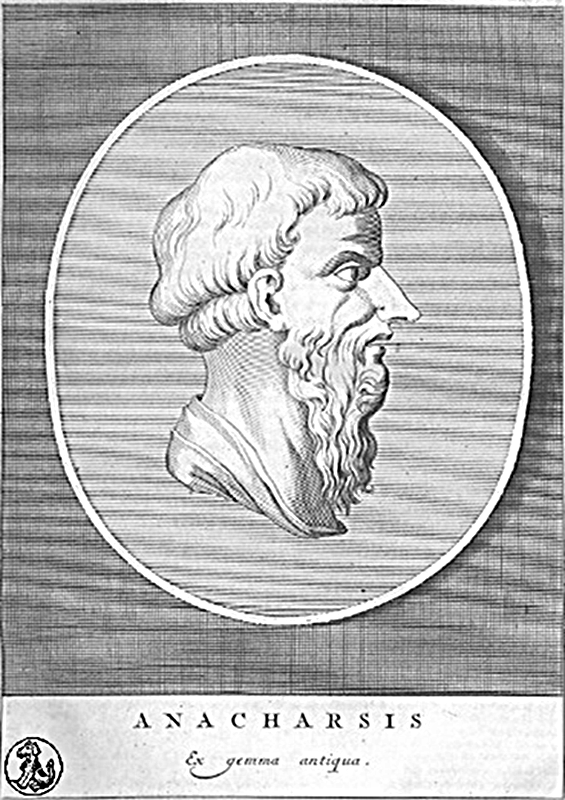
Anacharsis – son of Gnur, the son of Lika, and the son of Spargapif. He arrived at the times of Solon in Athens, where he met with Solon. Anacharsis was famous as a sage, philosopher and proponent of moderation in everything, he was referred to the seven sages and he attributed many intelligent sayings and inventions. There are over 50 Anacharsis sayings on various topics: "Reflections on the behavior of the people", "On the relationships between people", "On Protection of self-esteem", "About envy", "On the significance of language", "About seafaring", "On the gymnastics", "On the politics and social structure", "On the wine and the dangers of drinking," etc. Ten "Cynic" letters of Anacharsis are known: to Lydian king Croesus (two), the Athenians, Solon, tyrant Hipparchus, Medoc, Hanun, the king's son, Tereus - cruel ruler of Thrace, Fraziloh. According to legend, Anaharsis invented anchor improved potter's wheel and the sail. After returning to Scythia he was killed for committing the foreign Greek religious ritual. His killer was his brother - Scythian king Saul, who shot him with an arrow.
530 year BC - defeat of the Persian king Cyrus by Massaget queen Tomiris

Saks tribes lived in the vast expanse of the mysterious transcaspian steppe; they roamed with their countless herds along rivers, and ate meat and fish. On the flat lands they sown grain and yield from their fertile black lands abundant harvests. Against these dangerous warlike tribes who owned the endless expanse of the land, the Persian king Cyrus conceived his new campaign. Nomadic Saka tribes lived quite divided, and gathered in one terrible nation only in situation of a common danger. In such cases, the leaders of all the tribes elected a leader and at the time of war or natural disasters fully obeyed him. Tomiris – widow of Massaget tribe leader - was elected to this position instead of her dead husband. Tomiris - queen of Massaget Saka tribe. Cyrus gathered troops and went on a campaign against Massagets. After crossing the river Arax, he arranged an unusual trap to Massagets. Persians, left the camp with a stock of wine, which was defended by unfit for combat part, and the main forces withdrew back to the river. Massagets "... seeing prepared feast ... once defeated enemy, sat down and began to feast, and satiated with food and wine, fell asleep. Persians when came back, killed many of them, and even more were captured, among others, the son of Queen Tomiris, Massagets commander, whose name was Spargapif." Heard about this Tomiris sent a message to Cyrus: "Blood-hungry Cyrus... Give me my son back and go out of this country with impunity... If you do not do this, then I swear by the sun, the lord of Massagets, I will give thee blood, even though you are insatiable." According to Herodotus, captivated Spargapif persuades Cyrus to remove the shackles, and "when he has been released and as he could hold hands, he deprives himself of life." "Tomiris, when Cyrus did not listen to her, gathered all her army, and entered into battle with Cyrus... Most of the Persian army was destroyed on the spot, and Cyrus himself was killed." Tomiris shoved Cyrus’ head into a wineskin filled with human blood, and added the following: "You got me, live and after gaining victory in battle, destroyed me, taking my son with a trick. I thee as threatened, will satiate with blood"
519 year BC - Persian king’s Darius campaign against Central Asian Saks
In 519 year BC Darius took a big campaign against the Saka living in the steppes of Central Asia. Darius wrote on this subject as follows: "... I moved to the lands of Saka... crossed ... killed, another one was captured and brought to me bound, I killed him... named Skunha, which was captured... Another one became a ruler, as was my will. The country has become mine. "Thus, as a result of the campaign of Darius part of Central Asian Saks obeyed.
512 year BC – Persian king’s Darius campaign against Black Sea Scythians (Saka-paradraya)
Around 512 year BC Darius decided to launch a campaign against the Black Sea Scythians. Prior to this, the satrap of Cappadocia Ariaramnes with a small fleet of 30 ships crossed the Black Sea and captured prisoners to get them the necessary information for the upcoming campaign. Darius troops passed through the Bosphorus, heading north. Approaching the Danube, they, using the Greeks ships, moved and entered the lands of the Scythians. Scythians did not dare to start a decisive battle with the huge army of the enemy, and resorted to their favorite tactic of "scorched earth". They began to retreat, taking the cattle with them, destroying the grass and destroying the sources. In the mean time Scythian horsemen constantly attacked separate detachments of Persian infantry and destroyed them. Scythians, realizing that they alone are not able to repel the hordes of Darius in open battle, sent messengers to the neighboring tribes to call for help. At the last intertribal meeting intertribal kings of Tauri, Agathyrsi, Neuritis, Androthags, Melanchlens, Gelons, Budins and Savromats attended. Kings of Gelons, Budins, and Savromats agreed and promised to help the Scythians. Kings of Agathyrsi, Neuritis, Androthags, Melanchlens, and Tauri refused. Long pursuit of the Scythians to the deep lands within their territory exhausted army of Darius. Then the Persian king sent ambassadors to the Scythians, who appealed to the Scythian chieftain Idanfirsu: - Why are you running away from us, the Scythians? If you consider yourself stronger - join us in the battle. And if you are weaker - send our lord 'earth and water', and submit. - We do not run away from you, the Persians. We just roam on our steppes, we are used to for a long time - smiled mockingly Idanfirsu. Not having sufficient food stocks and the possibility to enter into an open battle with the Scythians, Darius decided to retreat. Shamefully leaving the sick and wounded soldiers and part of the convoy, and leaving their camp with lit bonfires to hide the sudden retreat from the Scythians, Persians secretly moved back at night.
6-5 centuries BC - burial time of "Golden Man", belonging to Saks Tigrahauda ("wearing pointed hats")
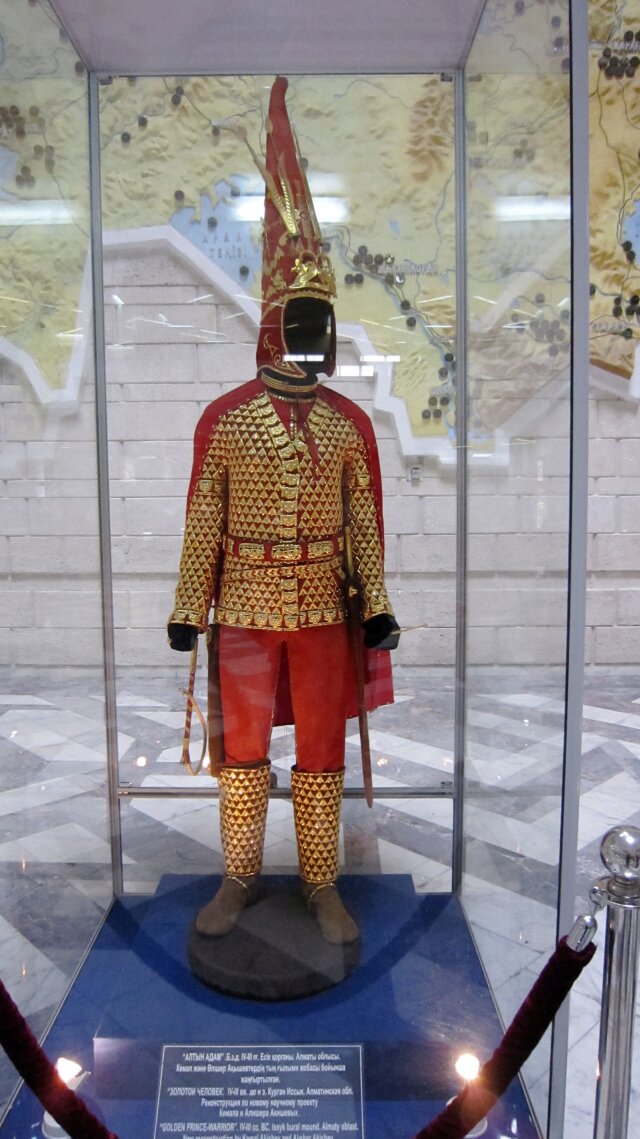
In 1969, Kazakhstan archaeological expedition led by K. A. Akishev started digging huge mound, located in 50 kilometers east of Alma-Ata. Issyk mound was deprived of the attention of folk tales, because a grand burial mound complex stood next to him - 45 earthen pyramids, up to 15 meters, strung out over a distance of 3 km. The height of Issyk mound was 6.5 m Like other mounds, Issyk has been robbed in antiquity, but the robbers left unattended a side burial, which contained human remains, now entered the world of science as " Issyk Golden Man." This was burial remains of Saka warrior in gold dress. Approximate age of ancient man buried there - 18 years. Sex is not confirmed. Judging by the headdress, buried human belonged to Saks-Tigrahauda. In the tomb more than four thousand ornaments made of gold leaf, once sewn on clothing, footwear and headgear, as well as gold rings, statues, bronze and golden weapons, various vessels were discovered. In the burial a silver bowl with 26 written characters was found. The content of this letter is still undeciphered. "Golden Man" can rightly be attributed to the genuine masterpieces of world art. The image of the "Golden Man" on a snow leopard has become a national symbol of Kazakhstan. Copies of the Saka warrior installed in many cities of Kazakhstan, one of them crowned the Independence Monument on the main square of Alma-Ata. On Standard of the President of Kazakhstan is also a figure of the young leader of the Saka era on a snow leopard. "The Golden Man" was so named because of his clothing consisted of 4000 gold plaques and plates, many of which are made in the Saka-Scythian animal style. Issyk mound is on the southern edge of a large burial ground, which consists of 45 mounds. Mound diameter is 60 meters, height is 6.5 meters. Mound is without a clear structure, but multilayer (3-4 layers). Pebble layer alternates with rubble and clay. The burial chamber built of processed logs of Tien-Shan spruce.
4th century BC – 4th century AD - The existence of Sarmatian tribes Union
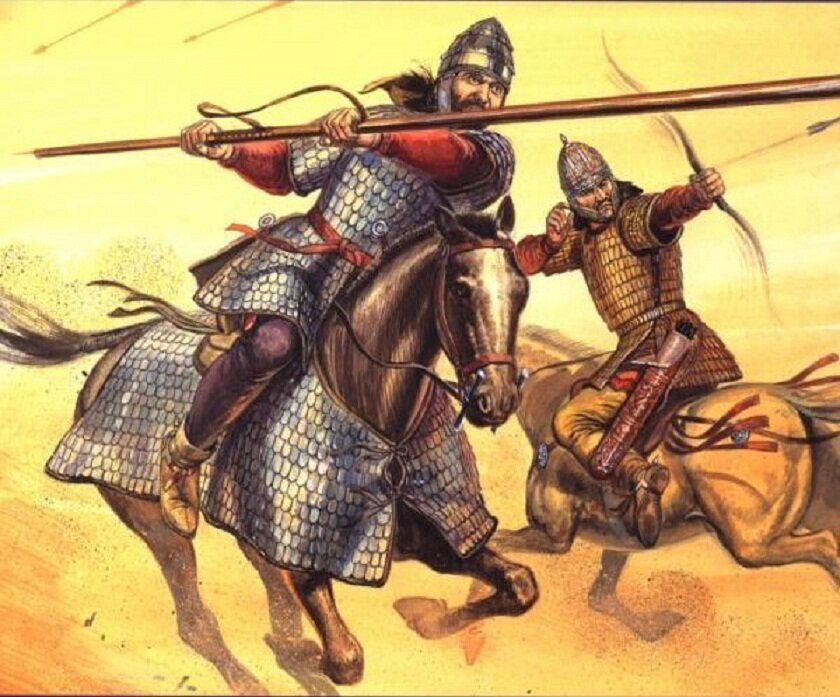
Sarmatians - the general name of nomadic cattle Iranian tribes that inhabited the steppe regions of the Southern Urals and Western Kazakhstan to the Danube. Ancient authors described different Sarmatian groups with their own names and which occupied at different times, leading position in the nomadic world: Aorsy, Sirak, Rhoxolani, Yazygs, and Alans. Anthropologically Sarmatians related to brahikranny Europoids (broad and round head), except for the tribe of the Alans, who belonged to dolichocranial Europoids (narrow skull). Late Sarmatians had typical Mongoloid admixture. Ancient authors, particularly Herodotus, reported that the Sarmatians are descended from the Amazons, who married Scythian youths. But steppe beauties could not learn the language of their husbands completely. "Because Sarmatians speak Scythian language, but from the beginning distorted" - concludes the historian. Apparently, Sarmatians separated from the bulk of the Scythians quite early: back in Avesta Sarmatians are mentioned under the name of "Sayrima" and called nomads, "who do not know the power of the supreme rulers." Indeed, Sarmatians lagged behind neighboring Scythians in social development; they still did not have the state. In VII-V century BC Sarmatians were undergoing expansion of the tribal system. Property and social inequality deepened. At the head of the tribes were leaders, relying on teams from the military aristocracy. In the III century BC friendship was replaced with enmity and the military attack of Sarmatians against the Scythians. Constant raids and gradual capture of Scythian territory by Sarmatians ended the mass resettlement of Sarmatian tribes in European Scythia - on the Black Sea and the North Caucasus.
The period of Huns
209-174 years BC - rule of Hun shanyu Modu
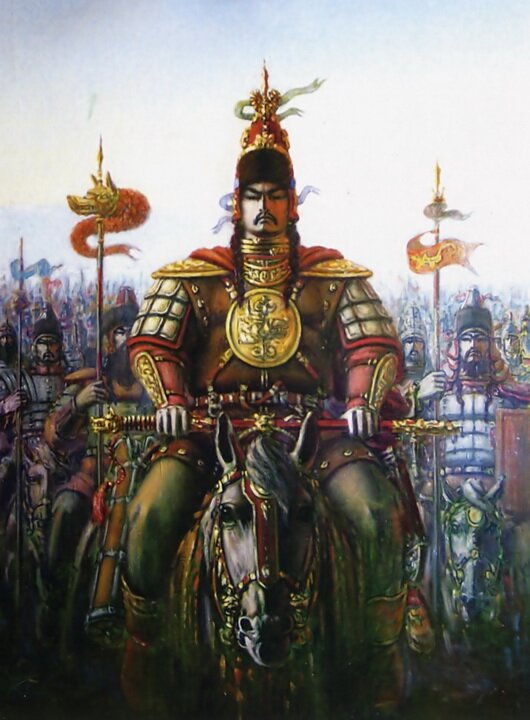
Modu was the eldest and unloved son of shanyu Tuman, who sent Modu to Yueh-chih, who demanded a hostage. Tuman influenced by Modu’s stepmother and the mother of his second son was planning to raid the Yueh-chih so that Yueh-chih killed Modu, and his successor was the youngest son. But Modu anticipated the intentions of father and at the beginning of raid killed his guard and fled. Modu so impressed the Huns, that Tuman was forced to put him in charge of one of the domains of the state, giving the management of 10,000 families. Modu began to teach soldiers. He coined the whistling arrow and ordered the soldiers to shoot in the direction where he shot an arrow. Failure to comply with the order was punishable by death. One day, suddenly, he shot an arrow into his favorite horse, and for those who did not fire, he ordered to cut off the head. Then he shot at his beloved wife, and those who did not shot – he beheaded. In the end, Modu shot at his father, nobody dared not to follow his example. So he became the ruler of the Huns in 209 year BC. Thereafter Modu went on a campaign against the eastern neighbors dunhu and conquered them. Returning from a trip, Modu started the war with the Yueh-chih (western neighbors, the ancestors of Kushan) and defeated them. In 200 year BC Modu was able to surround the Chinese army led by the emperor and 7 days kept them in the ring. Chinese emperor managed to bribe a wife of Modu with gifts, which persuaded her husband to let the emperor go. Xiongnu and China have signed a peace treaty and the relationship under which the equal status of the two powers was recognized. In 179 and 177 years the peace and treaty relationship was confirmed. In 174 year BC Modu died.
174-161 years BC - rule of Hun shanyu Laoshan
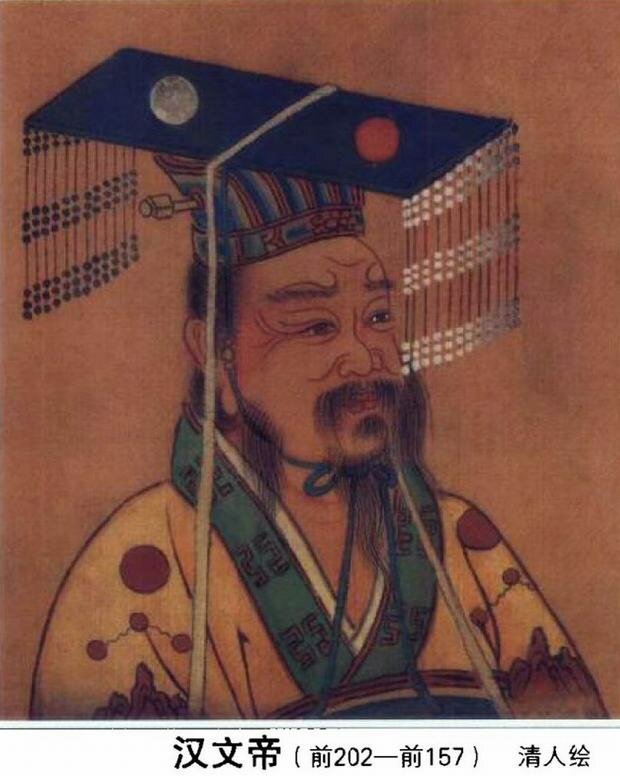
Laoshan, son of Modu, defeated Yueh-chih, strengthened borders and created a bureaucracy of runaway Chinese dignitaries. Wanting to get access to the free trade he unleashed the second Hunno-Chinese war and achieved favorable peace in 162 year BC. Ascended the throne, Laoshan under the contract of peace and kinship was obliged to marry Chinese princess. Han Wen-di sent the princess along with the eunuch Yue Chung Hsing, who arrived to the Hun, befriended Laoshan. Yue helped Shanyu to establish a regular taxation, started the book of accounts in Chinese and helped to compose the messages to the emperor. Yue even told Laoshan that unpretentiousness of the Huns in the home can benefit since Hunnu have enough time for military exercises, and Chinese peasants were always busy with household works. Hunnu emboldened by victory and began to attack the border, troops of 10 000 people attacked the Liaodong and Yunzhong and city of Daytszyun in Zhili. In 162 year BC Emperor began negotiations. In a letter to the Shanyu it was said about brotherhood of Han and Hun, the senselessness of war, gifts for the Hunnu (millet, rice, brocade, silk, cotton). The Emperor did not require the issuance of defectors - Chinese, but established the death penalty for the unauthorized crossing of the border. Shanyu accepted these conditions. In the year 161 BC Laoshan died.
161-126 years BC – rule of Hun shanyu Tszyunchen
Laoshan’s son. Laoshan-shanyu died in the year of 161, leaving his son Tszyunchen unresolved issue of trade with China. Tszyunchen kept the peace for four years, but did not reach anything, in the 158 year he resumed the war. Two Hun squad of 30,000 each, invaded China on the north and west, and after robbery they left. Border fire alarm promptly notified about this raid, but, the Chinese government has failed to quickly mobilize the army, and when its troops reached the border, the Huns were far away in the steppe. The following years promised Huns successes. In 157 year, the Wen-di died, and in 156 year, Jing Di stepped on the throne. Interregnum was accompanied by a sharp struggle click. Losers expected violence, and they rebelled, turned for help to the Huns. However, the new government coped with internal difficulties. In 154 year, the rebellion was suppressed, as it was not supported by the Huns. For this they got something that sought: under the 152 year contract the frontier markets were opened for the free exchange and, moreover, Chinese princess with a great tribute was sent to Shanyu as a wife. 152 year was the culmination of Hun power. During the rule of Junchen Huns have made the greatest gain, but in the end they began to decline. In the years of 158-152 BC he made small raids into China, in 152 year BC he concluded a peace agreement with China. In 140 year BC Chinese emperor became Wu Di, who tried to capture Junchen as prisoner. Attempt failed, which led to a resurgence of Hunnu-Chinese wars. In 126 year BC Junchen died.
160 year BC - Resettlement of Usuns in Semirechie

2nd century BC-4th century AD – State of Kanguy
.jpg)
Kangüy - the name of an ancient people and possessions in Central Asia, presented as the union of unknown ethnic and linguistic origin (about II century BC - IV century AD) in the area of the lower and middle Syr Darya. To the west of Kanguy Sarmatian-Alan tribes lived, to the east (in Semirechie) - Usuns. Kanguy bordered to the south with Ferghana and Sogdiana, as well as Yuechjy, departed from the Huns to the south. Kanguy capital was the city Bityan. In the 2nd century BC Kangüy obeyed Yuechjy and Hunnu. In the first century BC Kangüy subordinated possessions of Yan and Yantsay which are identified with Sarmatian and Sarmatian-Alan tribes. In 47-46 years BC Kanguy ruler summoned the leaders of the Northern Hunnu led by Chzhichzhi, who became his son in law. Chzhichzhi later quarreled with the father in law and killed his wife. Chzhichzhi feuded with Usuns and China. In 36 year BC Chinese official Chen Tang, wanting to avoid punishment and conclusions gathered army in West side and was able to overtake Chzhichzhi in Kangüy, to destroy his army and to burn the fortress and behead the most rebellious shanyu. Political developments in the state of Kanguy are quite fragmentary. In Kangüy own writing also existed. Over the past 12 years on the site "Kultobe" scientists headed by doctor of historical sciences Alexander Podushkin found 15 tables with the written language of the people of Kanguy state. This script was created basing on the Aramaic script. According to scientists, language of Kultobe tables - one of the dialects of East Iranian language, presumably ancient Sogdian (or archaic Sogdian).
58-36 years BC – Civil war among the Huns
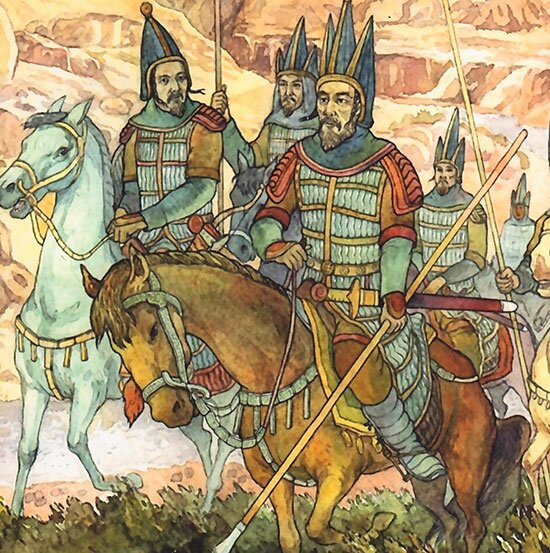
In the 60 year BC Syuylyuy - Tsyuantsyuy died (or was killed). As a result of the revolution Tutsitan came to power who has governed under the name Voyan - Tsyuydi. He tried to make peace with China, to weaken the tribal aristocracy and strengthen shanyu genus. In 58 year BC Hunnish kinds rebelled against the hated shanyu and proclaimed Shanyu Huhanye. Despite all this civil war among the Huns broke out with renewed vigor. Huhanye’s brother Chzhichzhi raised against his brother. Faithful elders called Huhanye to "rule over the nations," ie, the wars must go on, the main thing - independence from China. But adviser of shanyu ichzhitszy-duke said that the greatness of the Huns is in the past, and Han is powerful, the only possibility for Hunnu to survive - is to obey to China. Huhanye reconciled with reality, and in 53 year BC sent his son – Chzhuley-tsyuytana to serve in China. After the death of Chzhichzhi in 36 year BC civil wars among the Huns ended.
52 year BC - adoption of the southern Hunnu nationality of China
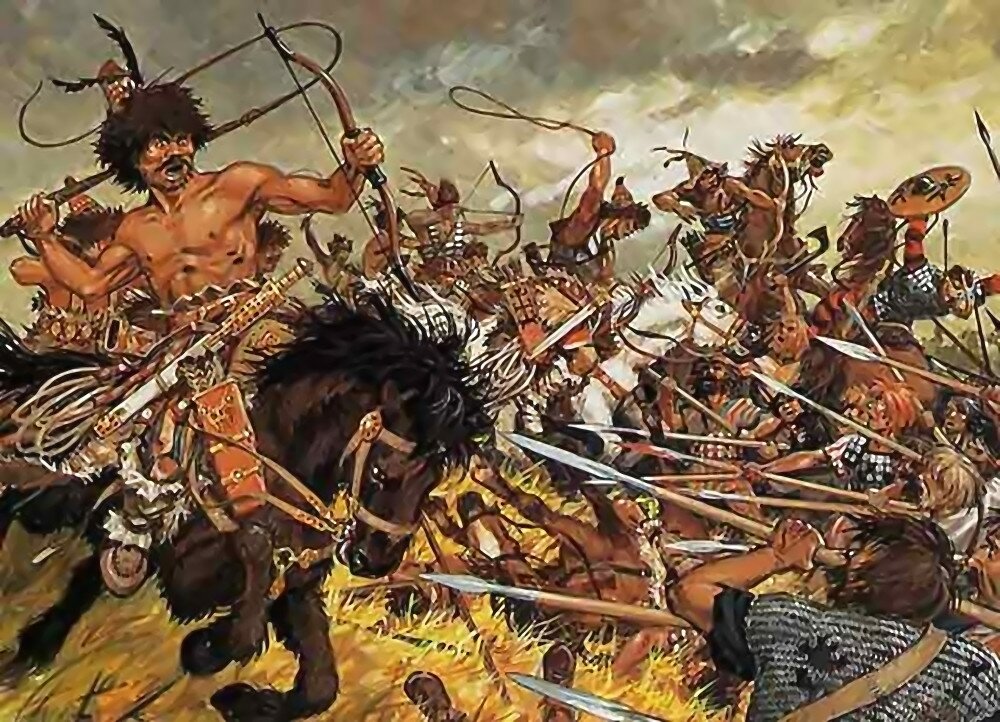
In 56 year BC shanyu Huhanye ascended the throne. In Hunnish powers began a civil war for power, where Chzhichzhi the younger brother of Huhanye took part. Position of Huhanye-shanyu was quite heavy, and one of his associates, eastern ichzhitszy-duke, advised him to obey China. At the council of elders Hunnish leaders began to argue about this decision: "It is impossible, - told the elders. - Fighting on horseback is our dominance and that’s why we scare all nations. We still do not languish in the brave warriors. Now two siblings argue about the throne, and if not older, the younger will receive it. In such circumstances to die is a glory. Our descendants will always rule over the nations. China, no matter how powerful, cannot absorb all the possessions of the Huns, why then violate the Code of the ancestors? To become vassals of the House of Han - means to humiliate and be ashamed to deceased shanyu... It is true that such advice will deliver peace of mind, but we will no longer have dominion over the nations." Like a bucket of cold water poured on their hotheads was response speech of ichzhitszy-duke: "The power and weakness have their time. Now the House of Han in a flourishing condition. Usun and settled possessions are of its citizenship. House of Huns from the time of Tszyuydiheu shanyu diminished day by day and cannot return the former greatness. No matter how he tries, no one sees a relaxing day. Now its tranquility and existence depend exclusively on citizenship of China; without this... it will die." In 52 year BC shanyu came to the Great Wall and asked for a meeting with the Son of Heaven (the Chinese emperor). In suburban palace Gan Quan emperor accepted shanyu as a vassal. Shanyu was bestowed and he vowed to protect the emperor from rebel Huns and his brother Chzhichzhi, which many clans proclaimed Shanyu.
10 year AD – Huns’ restoration of independence from China
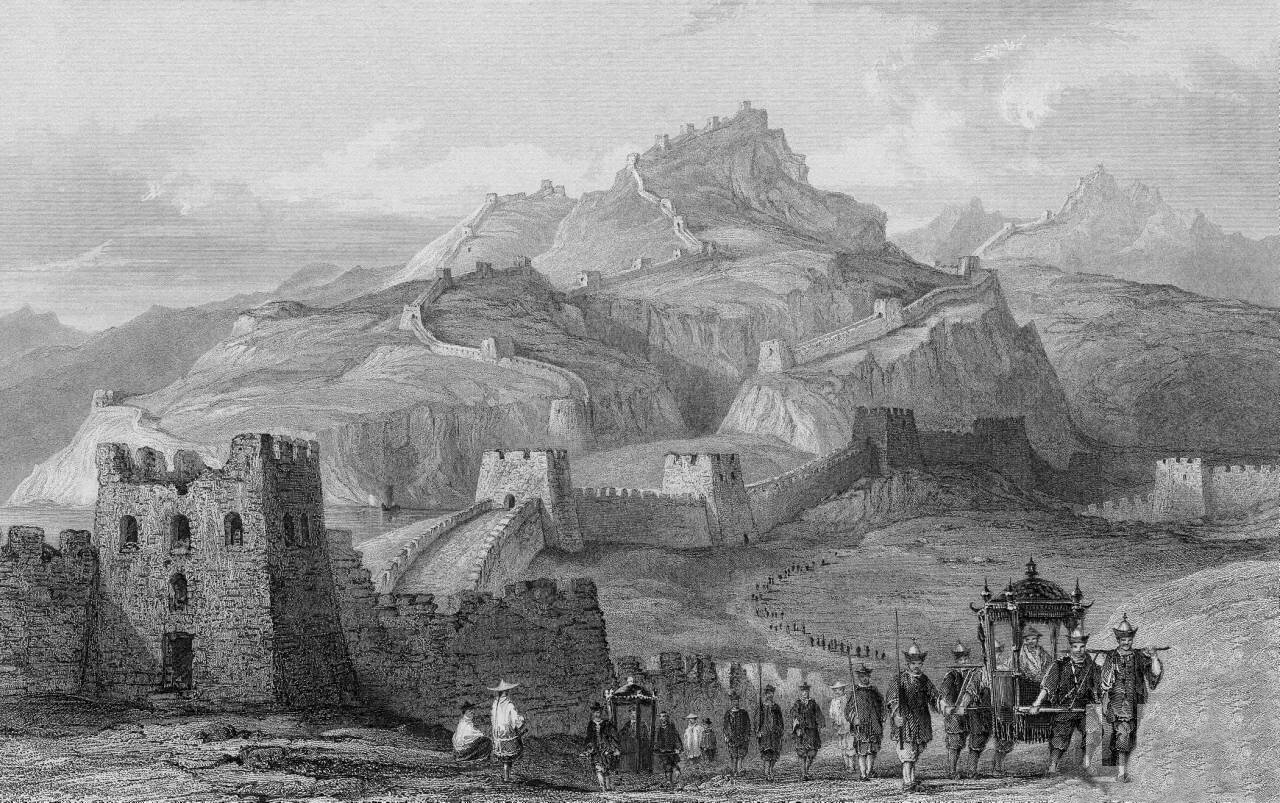
In 31 year BC Huhanye died and his sons became shanyu successively: In 8 year BC youngest son Uchzhulyu ascended the throne. In the 3rd year AD the de facto ruler of China Wang Mang (the de facto ruler of China) demanded shanyu to extradite two Chinese defectors. Shanyu agreed, but asked Wang Mang not to execute them. They were executed. Shanyu lost confidence in Wang Mang. Wanting to show own greatness, Wang Mang ordered Shanyu to pass the old seal, and issued a new one. Signs on seal meant that shanyu is a simple official of the emperor, but not vassal ruler. Hunnu did not forgive it. In 10 year principality Cheshi revolted and Huns unexpectedly supported them. In 11 year Wang Mang declared Uchzhulyu to be deposed and appointed Hyanya-duke as Shanyu in response hunnu said that Wang Mang - the usurper of the imperial throne. Since that time, Hunnu were independent of China and fought with China to 48 year AD.
48 year AD - re-adoption of southern Huns the nationality of China.
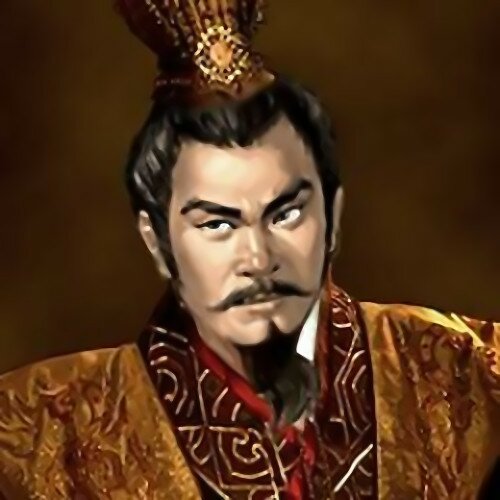
This event was associated with an increase in the number of potential candidates to the Hunnu throne. Ruler Hun Yu wanted to exclude from succession to the throne children and grandchildren of Huhanye and leave the throne to his son. Despite the fact that Yu received the throne from his brother, who became Shanyu resulting usurpation of power of Yuya nobody disputed, but the rightful successors, according to tradition, were the son of Huhanye shanyu - Ituri Chzhyasy as a senior in clan, and Bi son of Uchzhulyu shanyu. Yu again changed the order of succession, returning to an old custom to bequeath the throne to his son. Huhanye son, Ituri Chzhyasy was born by Chinese princess. In 47 year she was gifted to Huhanye for binding contract and was inherited by his eldest son Fuchzhuleyu. Yu did not win kingdom from China to leave it for non-native person. Ituri Chzhyasy was killed and son of Yuya - Udadiheu was declared as successor. In 46 year shanyu Yuya died, and soon his successor Udadiheu died. Throne was given to the second son of Yuya - Pune. During these years, the land of the Huns had three misfortunes: droughts, locusts and epidemic. From hunger and epidemics Huns lost more people than twenty years of war. New shanyu decided to end the protracted war and sent an embassy to China to conclude a treaty of "peace and kinship." Bi took advantage of it. First he sent to China a map of Hun lands and in 47 year he went to the Chinese governor and expressed his desire to adopt the citizenship of the Han Empire. In 48 year elders of eight southern clans proclaimed Huhanye Bi - Shanyu II and migrated to China. Huhanye name was chosen not accidentally: Bi concluded with Guang Wu a union and he began to defend China from his countrymen. Contract of 48 year AD repeated contract of 47 BC.
93-155 years - Retreat of the northern Huns to West in Jungaria
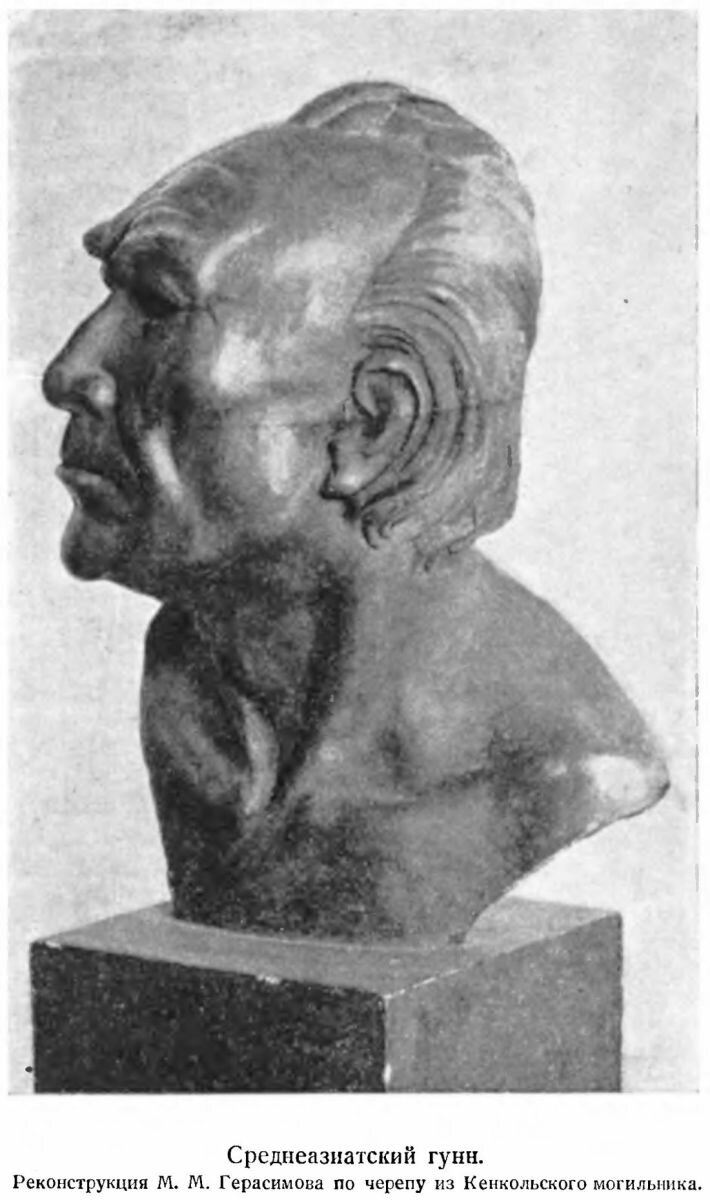 Breakup of Northern Hunnu state. In the Northern Hunnu in ten years (73-83 years) changes for the worse happened, as you can guess by circumstantial evidence. Elder Gilyus transferred to China, he brought with him 38 thousand people and a lot of cattle. Possessions of the Western Region began negotiations with China on a military alliance against the Northern Hunnu. Relations between the Huns and dinlinami strained and Xianbi finally concluded an alliance with the Chinese. Strife entailed exile: in 85 year seventy three clans fled to China, weakening the already overstrained power of Northern Huns Empire. The first blow struck Xianbi. In 87 year they entered the eastern lands of the Huns, and Ulu-shanyu suffered a complete defeat. He was captured by enemies who stripped off his skin. Sianbi did not develop success; disposing of the enemy, they went back, but the panic they sown among the Huns, immediately bore results. Another 58 clans, with 200 thousand people and 8000 soldiers, migrated south and transferred to China. The following year in State of Huns passed locusts, and hunger was added to the ravages of war. In 91 year the Chinese western governor again broke shanyu who escaped and went missing. Yuychugyan, the brother of disappeared, declared himself Shanyu and sent an embassy to China to ask for peace. He was supported by the General Dow Hyanya. The latter presented a report in which he proposed to keep the North Hunnu not to disturb the political equilibrium and some order in the steppe, because he was supported by the Huns. Chinese court agreed to the proposal of shanyu, and negotiations have already started, when the Dow Hyan was arrested and executed. Scared by loss of a patron Yuychugyan migrated north. Chinese officials report portrayed migration as a rebellion. In pursuit of Shanyu thousands of Chinese cavalry was sent, lured him to the meeting and killed him, and his army was destroyed (93 year). Yuychugyan was the last northern Shanyu of Modu kind. On this basis, the Chinese historians believed 93 year as the end of Hunnu state. In fact, the fight was not over. In the Northern Hunnu dynasty was replaced by: among the irreconcilable noble Hun clan Huyan rose. In 155 year, the Huns suffered a final defeat by Xianbi and split into two parts. First went to Volga and became the ancestors of the European Huns. While the other part has started to recede to Semirechie and became known as state of Yueban.
Breakup of Northern Hunnu state. In the Northern Hunnu in ten years (73-83 years) changes for the worse happened, as you can guess by circumstantial evidence. Elder Gilyus transferred to China, he brought with him 38 thousand people and a lot of cattle. Possessions of the Western Region began negotiations with China on a military alliance against the Northern Hunnu. Relations between the Huns and dinlinami strained and Xianbi finally concluded an alliance with the Chinese. Strife entailed exile: in 85 year seventy three clans fled to China, weakening the already overstrained power of Northern Huns Empire. The first blow struck Xianbi. In 87 year they entered the eastern lands of the Huns, and Ulu-shanyu suffered a complete defeat. He was captured by enemies who stripped off his skin. Sianbi did not develop success; disposing of the enemy, they went back, but the panic they sown among the Huns, immediately bore results. Another 58 clans, with 200 thousand people and 8000 soldiers, migrated south and transferred to China. The following year in State of Huns passed locusts, and hunger was added to the ravages of war. In 91 year the Chinese western governor again broke shanyu who escaped and went missing. Yuychugyan, the brother of disappeared, declared himself Shanyu and sent an embassy to China to ask for peace. He was supported by the General Dow Hyanya. The latter presented a report in which he proposed to keep the North Hunnu not to disturb the political equilibrium and some order in the steppe, because he was supported by the Huns. Chinese court agreed to the proposal of shanyu, and negotiations have already started, when the Dow Hyan was arrested and executed. Scared by loss of a patron Yuychugyan migrated north. Chinese officials report portrayed migration as a rebellion. In pursuit of Shanyu thousands of Chinese cavalry was sent, lured him to the meeting and killed him, and his army was destroyed (93 year). Yuychugyan was the last northern Shanyu of Modu kind. On this basis, the Chinese historians believed 93 year as the end of Hunnu state. In fact, the fight was not over. In the Northern Hunnu dynasty was replaced by: among the irreconcilable noble Hun clan Huyan rose. In 155 year, the Huns suffered a final defeat by Xianbi and split into two parts. First went to Volga and became the ancestors of the European Huns. While the other part has started to recede to Semirechie and became known as state of Yueban.
2nd century AD – 469 year – Existence of Hun’s State

Huns - a union of tribes formed in II-IV centuries in the Ural region of Turkic Huns, moved in II century from Central Asia, and local ugrov and Sarmatians, they invaded in the 70s in the IV century AD in Eastern Europe. Huns created a vast empire from the Volga to the Rhine. With commander and ruler Attila they tried to conquer all the Roman West (mid of V century). Center area populated by Huns was in Pannonia. In 70s IV century Huns conquered the Alans in the North Caucasus, and then defeated the state Germanarich that gave impetus to the Great Migration of People. Huns conquered most of the Ostrogoths (they lived in the Lower Dnieper) and forced the Visigoths (who lived in the Lower Dniester) retreat into Thrace (in the eastern part of the Balkan Peninsula, between the Aegean, the Black and Marmara seas). Then, in 395 year going through the Caucasus, devastated Syria and Cappadocia (Asia Minor), and about the same time, settled in Pannonia (Roman province on the right bank of the Danube, now - the territory of Hungary) and Austria, made out raids on the Eastern Roman Empire (in relation to the Western Roman Empire until the middle of V century Huns acted as allies in the struggle against the Germanic tribes). Subdued tribes they levied tribute and forced to take part in their military campaigns. Greatest territorial expansion and power Hunnish tribal union (it except Bulgars, had already the Ostrogoths, Heruli, Gepids, Scythians, Sarmatians, as well as some other German and non-German tribes) reached under Attila (ruled 434-453 years). In 451 year the Huns invaded Gaul, and Catalaun fields were defeated by the Romans and their allies: the Visigoths and Franks. After the death of Attila strife arose within the empire benefited previously subjugated them Gepids, who led a revolt of the Germanic tribes against the Huns. In 454 year at the Battle of the River Nedao in Pannonia Huns were defeated and driven into the Black Sea. Huns’ attempts to break into the Balkan peninsula in 469 year were in vain, son of Attila, was killed and his head was taken to Constantinople. Huns used ranged bow, which reached a length of over 1.5 m. Bow was made composite, for greater strength and elasticity it was strengthened with linings of bones and horns of animals. Arrows were used as a bone, and with iron and bronze-tipped arrowheads. Sometimes arrows were attached with bone drilled balls coming into the flight with terrible whistle. Bow was embedded in a special case, and was attached to the belt on the left, and the arrows were in the quiver behind warrior at his right side. "Hun bow" or Scythian bow (scytycus arcus) - according to the testimony of the Romans, the most modern and effective weapon of antiquity - was considered very valuable spoils of war among the Romans.
160-490 years – Yueban, state of "impotent" Huns
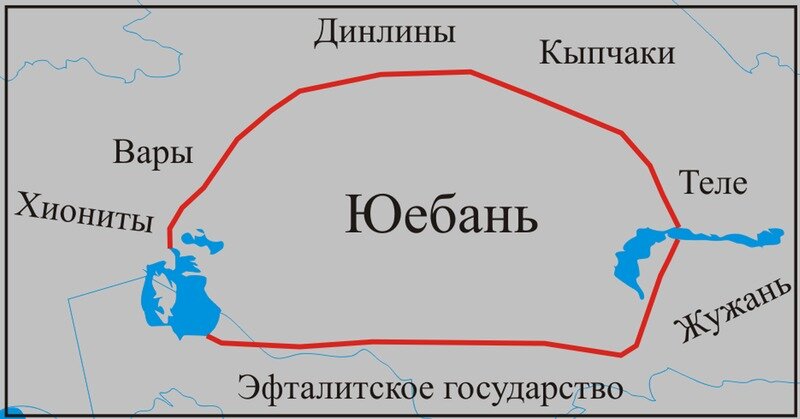
Yueban - ancient state of Hun people (one of the branches) in the south central part of modern Kazakhstan. After continuous wars with the Chinese, from the Huns, repressed for Tarbagatai probably through Dzungarian Gate, part restrained in Semirechie, forming here Yueban state, which lasted up to V century. In Yueban only “impotent” huns stayed, as the main mass of the Huns with Shanyu went farther west. Yueban divided into four tribes: Chuyue, Tschumi, Chumugun, Chuban. Some researchers believe that the state Yueban got its name from the tribe Chuban. All these years Yueban lasted only because they did not have strong neighbors. In the year of 490 Yueban was defeated by telesskiy tribes who founded on the Black Irtysh the State of Gaogyuy.
4th century AD-555 year The Existence of Rouran Khaganate
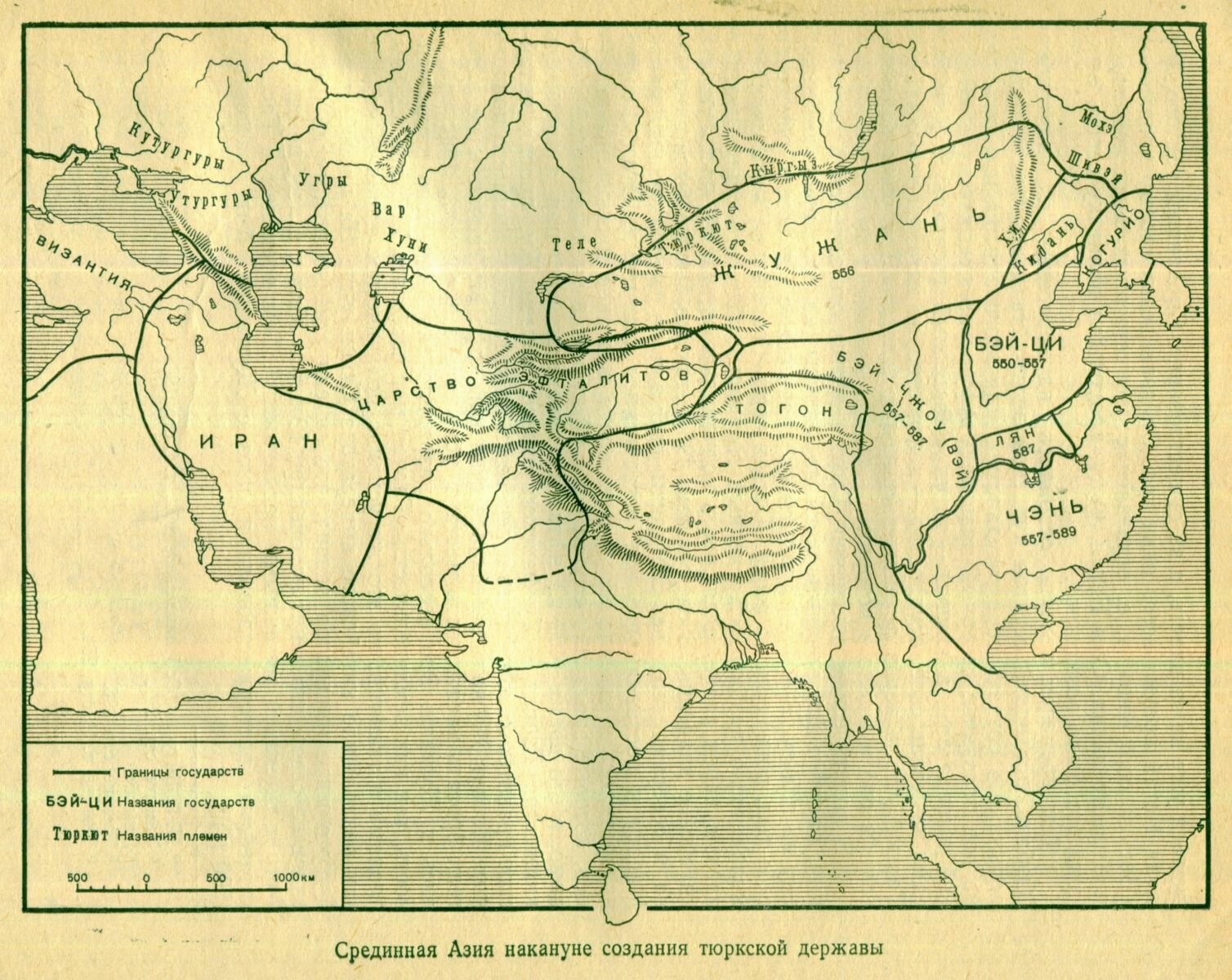
Union of Mongolian nomadic peoples. Founder of Rouran Khaganate was Yuytszyulyuy Mugulyuy. According to Chinese sources, Yuytszyulyuy Mugulyuy was a slave of unknown origin. Once he was caught by Xianbi, they called him mugulyuy - "bald" in the language of the Xianbi. He became a slave, and when he grew up, Xianbi allowed him to serve in the cavalry. For non-compliance of the order (being late) he was sentenced to death. Mugulyuy fled to the valley, where he collected another 100 fugitives. They settled in the aimag Chuntulin and became the core of the future Rouran Khaganate. In 402 year, his descendant Shelun ruler of Rourans was first among the steppe peoples who took the title of Kagan. After that Rourans started war with Toba Empire for dominance in the steppe. In 550's Rourans suffered a series of defeats and obeyed to established Turkic Khaganate.
434-453 years – rule years of Hun’s Chief Attila

Attila was born in about 410’s; his father Mundzuk in 420 years fought the Burgundians on the Rhine. Attila was the leader of the Huns from 434 to 453 a year. He united under his rule the barbarian tribes from the Rhine to the Northern Black Sea. A century after the death of Attila the Gothic historian Jordan said of the leader of the barbarians: "Lord of all the Huns and the governor, the only one in the world, tribes almost all Scythia, worthy for a fabulous surprise his glory among the barbarians." Together with his elder brother Bleda inherited power from his uncle Ruga. During negotiations with the Byzantine Empire Attila and his brother forced them to pay 230 pounds of gold per year, with his uncle Byzantium paid twice less gold. 7 years after the reign of Attila and his brother fought with the barbarians. In 1437, they defeated the Burgundian kingdom 20,000 Burgundians were killed. In 441, the brothers invaded Byzantine possessions. Huns captured vast territory of modern Serbia in the area at a distance of five days' journey to the south of the Danube. Between 444 and 446 year Attila murdered his brother and became the sole ruler of the Huns. Attila made two expeditions to Byzantium in 441-442 years, and in 447, forcing Byzantium to conclude a peace treaty with great benefit tribute to the Huns. In 447, the Byzantine Empire ceased paying tribute to Attila and Attila invaded Byzantium. Byzantine Emperor backpedaled and was forced to fulfill all the requirements of the Huns: "Give the Huns defectors and six thousand liters of gold [ approx. 2 tons ] in salary over time, pay annually a certain tribute to two thousand one hundred liter of gold for each Roman prisoner who fled [ from the Huns ] and passed into their land without compensation, pay twelve gold coins, if you will not pay this price, a fugitive must be given to Huns. To Romans not to accept any barbarian, resorting to them." In the year 448, the Byzantine emperor tried to kill Attila, but the attempt failed. In 451-453 years Attila fought against Western Roman Empire. In 451, Attila captured and destroyed the Mets, the cities of Trier, Cologne, Reims, Tongeren, Troyes also fell. Attila approached Orleans in central Gaul and besieged it. To help Orleans the aid of the combined armies of the Roman general Aetius and Theodoric, king of the Visigoths, came. Attila withdrew to Catalaunian fields (more than 200 km east of Orleans) by clicking on the right bank of the Seine, in the city of Troyes. To the north of Troyes on the vast plain in the modern province of Champagne a decisive battle took place. As a result of the grand slaughter both sides suffered heavy losses, after the Battle Attila led his troops to march to Italy. In 452 he took Milan and Pavia, and went to Rome. But because of the plague Attila was forced to curtail his campaign. In 453, Attila died.
490-540 years - Gaogyuy. Ancient state in eastern Kazakhstan
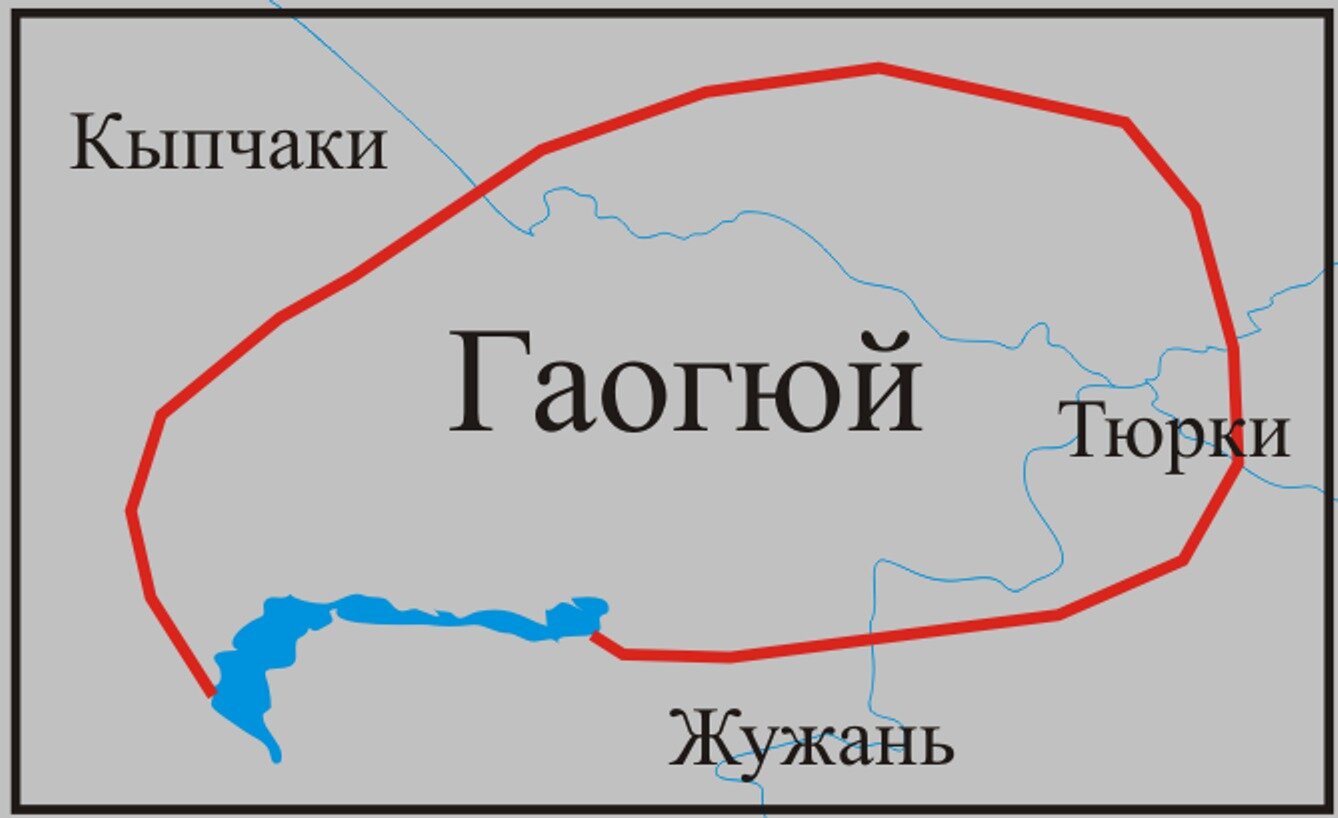
Gaoguy was formed as a result of the defeat of the state Yueban in 490 and the time when telesskih tribes came to the region. The Gaogyuy structure consisted of 12 clans: Lifuli, Tula, Ichzhan, Dalian, Kuhe, Dabo, Alun, Moyun, Syfan, Fufolo, Tsiyuan, Yushupey (Yukuanpey). According to legends, Gaogyuy originated from youngest daughter of Hun shanyu. At the end of V century BC Rourans conquered Fufolo clan. During Kagan Doulune Juan-Juan weakened controls on Gaoguys and Afuchzhilo, Elder of Fufolo clan and his cousin Tsyuntsi began to collect Gaoguys troops, number of their subjects was about 100,000 yurts. In 487, using as a pretext the reluctance of war with China, Afuchzhilo relocated his tribe to the upper Irtysh and declared himself an independent ruler. Tsyuntsi became heir to the throne, and lived in the south and Afuchzhilo lived in the north of Gaogyuy. Jujan attempts to break them failed. In 490 Afuchzhilo sent an ambassador to Wei Yuan Hun and conveyed that he recognizes himself a vassal of Wei and Jujan opponent. Gaoguys happened to have a war with ephtalites, Tsyuntsi was killed, his sons were captured, and southern gaogyuytsy defeated. In 496 Afuchzhilo died, Mivotu became a ruler. In the year 508 Mivotu fought Rourans. Broken Mivotu retreated for 150 km and strengthened in the mountains. Rourans accidentally discovered army of Wei Meng in the steppe. Rourans decided that Weis were going to help Gaoguy and fled. Mivotu overtook them and killed, and the head of Foote (Rouran Khan), together with gold, silver, horses, sable, he sent to Wei. In 516 Mivotu went to war with Rourans, Mivotu was captured and executed, and out of his skull Chounu (Khan of Rourans) made a cup. Many Gaoguys fled to ephtalites. About 516 year Yifu, the younger brother of Mivotu regained horde. In the year 521 Yifu broke Rourans. In 534 Rourans defeated Yifu and his brother Yuetszyuy stabbed him. In 537 Yuetszyuy was defeated by Rourans and son Yifu Bedi killed him. In 540 Bedi was defeated by Rourans. Gaoguy ceased to exist and became part of Rouran Khaganate.
545 year – Rebellion of Tiele against Rourans.
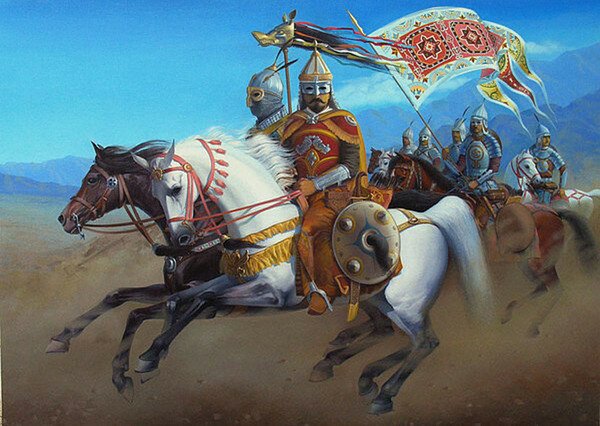
By 545, the rule of Rourans repeled almost all subjects, among which were the Tiele tribes and ancient Turks. Tiele’s tribal leader did not want to obey Bumyn, founder of the Turkic Khanate. To get rid of oppression of Rourans, he decided to act independently, but Bumyn, realizing intentions of the Tiele’s leader, placed his army in the valley of the Altai Mountains. Coming Tiele decided to submit to the authority of Bumyn. So, in 546 tribe of Tiele (by Chinese sources 50,000 yurts) became part of the future state of the Turks.
Turkish khaganate
Turkic Khaganate (552-603 years)

552-603 years - Turkic Khagnate (Kektyurk - Celestial Turks) - the largest state in the early medieval Eurasia, created by the ancient Turks, led by the rulers of the genus Ashin. This tribe was destined to play a special role in history. The word "Turk «means» strong and some Turkic peoples used its original meaning as "together." During the period of greatest expansion Turkic Khaganate controlled territory of Northern China (Manchuria), Mongolia, Altai, East Turkestan, Central Asia, Kazakhstan and North Caucasus. In this state a leader was Kagan - Higher ruling khaganate face. The second person in kaganate was yabgu (dzhagbu), but he did not inherit power after Kagan. Often yabgu was the ruler of a certain domain in khaganate (e.g. Istemi - yabgu, ruled western territories of Turkic Khaganate). Successor of throne held the title tegin. Other titles in the top khaganate - shad, elteber, bek buyruk, Tarkhan. The main occupations of the Turks were nomadic herding and hunting herbivores which wore a character of raid because of the large herds of animals of the steppe. The main food of the Turks was meat, drink - kumys. Clothing and tents were made of animal skins. Turks were also made felt and woolen fabrics. The main livestock species were sheep and horses. Turks have mastered the industrial production of iron. A method for producing iron was bloomer process. Development of metallurgy allowed Turkic kagans to rearm its military.
552 year – the rule of Bumyn-kagan

In 545 year Tiele tribes rebelled against Rourans again and the new Turkic state was headed by governor of Turks-Ashin Bumyn. After the conquest of the Tiele tribes Bumyn demanded Rouran princess as his wife. Rouran kagan refused, which led to the rupture of the vassal relationship with Rourans, which until then were sovereigns of Turks and Tiele tribe. In 551 year Bumyn became an alliance with the Chinese empire, Western Wei, married their princess and attacked the Rourans. After defeating them, he was proclaimed Kagan, at the end of 552 year he took the title Il-Khan (Khan El). The literal meaning of the title Il-Khan - "the ruler of the nations." It was he who made the first step to join other tribes and managed to unite the Turkic peoples into a single state - Turkic Khaganate. Bumyn, born as slave, at the end of the year 552 died as Il-Khan - "Khan of nations."
552-553 years – the rule of Kara Issyk-kagan
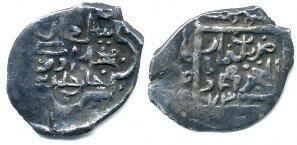
After the death of Bumyn Kagan his son Kara Issyk-Kagan comes to the throne. He finally defeated Rourans and strengthened the power of the Turks in the steppes. Six months after the death of his father, after his victory over Rourans Kara Issyk-Kagan died under mysterious circumstances. And the government was headed by his brother Mukan-Kagan.
553-572 years – the rule of Mukan-kagan
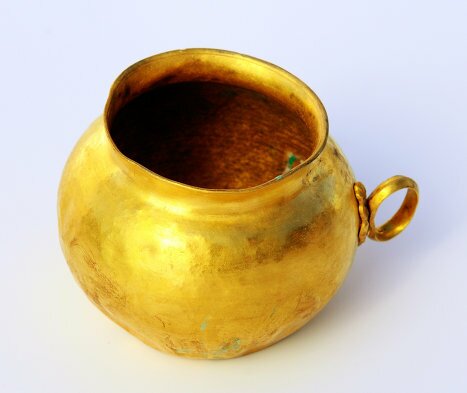
Mukan-Kagan – the son of Bumyn-Kagan. Under his rule, the boundaries of the Turkic Khaganate extended from the Yellow Sea to the Black Sea. During Mukan-Kagan order of succession was established (not inherited his father's son, but the younger brother to the elder and elder nephew to the younger uncle) and the administrative-territorial division of Khaganate was also formed (originally four domains). In the year 554 Mukan-Kagan during a trip to the north conquered Kyrgyz, Chiks. In the east, the Turks extended their power over the Khitan and Tatab (hee) and otuz Tatars. During the reign of Mukan-Kagan his uncle Istemi subdued western possessions down to the Black Sea. In the years 554-558 border of Turkic Khaganate reached the Volga River. In 562-565 years the Turks seized possession of Ephtalites up to Samarkand. From 567 until 571 Turks led military action against Iran, which ended demarcation possessions for the Amu Darya and the payment of an annual tribute to the Turks in the amount of 40 thousand gold dinars. In 563-564 years Mukan-Kagan personally participated in campaigns against the Chinese kingdom. 100 bales of silk were annually presented to the Turkic Mukan-Kagan by China.
554-558 years Turks crusade to the West

On behalf of Mukan-Kagan his uncle Istemi led a large army consisting of 10 Turkish tumens, went to the west in the spring of the year 554. Usuns weakened by Rourans raids did not resist and already in 555 without encountering serious resistance along the way, yabgu reached the Aral Sea, conquered all the tribes and the states on his path. In 556 he conquered Abarov and stumbled on resistance of Chionites, Vars and possibly joined them part of Rourans. War with them stretched to 558 year, when the Turks managed to expel the remnants of the defeated tribes beyond the Urals (where fugitives became known as Avars). Reaching the banks of the Volga, the Turks did not cross the river, and came back. By this time, Iran concluded a truce with the Byzantine Empire and was ready to start a war with the Turks against Ephtalites.
563-567 years – the War of Turks and Ephtalites
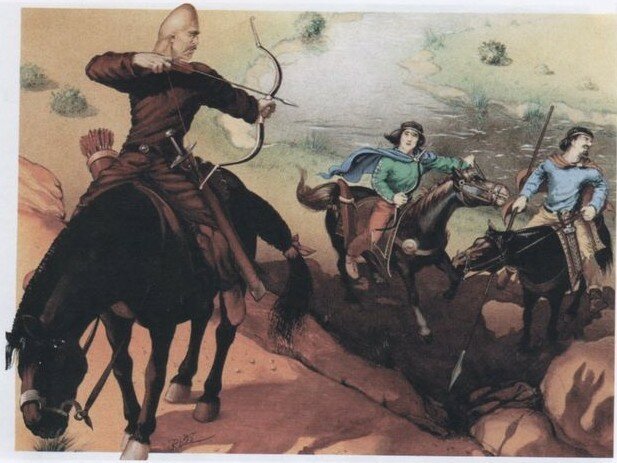
In 562 year, the armies of shakhinshakh Khosrow Anushirwan inflicted defeat to Ephtalites and took Tocharistan. After this Turks struck and conquered Chach. After crossing the river Chirchik Istemi occupied Samarkand. Main troops of Ephtalites who focused in Bukhara, decided not to take the battle on the plain, and retreated into the mountains. The decisive battle took place in the year 565 near Karshi, it lasted eight days and ended by victory of Istemi. Ephtalites deposed king Gatfara electing instead of him a chaganian Prince Fagonisha, who tried to persuade Iran against the Turks, but Khosrow I. Anushirwan returned to Khorasan. Ephtalites state ceased to exist and was divided between Turks and Iranians.
567 year – Maniah embassy to Byzantium
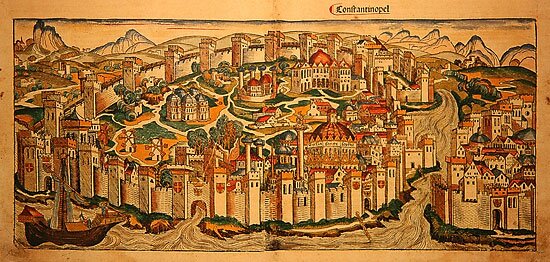
When dividing former possessions of Ephtalites Turks got Sughd. Sogdians - one of the main actors in Asian trade - were obliged to Turks by termination of Rourans robberies and Ethtalitian wars. But their desire to establish trade with Europe was met with obstruction of Iranians for uncontrolled quantities of goods entering Byzantium. Sogdians persuaded Istemi to send their representative Maniah in head of the embassy in Iran. But Khosrow I. Anushirwan bought all the silk goods they brought and defiantly burned it, making it clear that the passage of goods through Iran is not in his interests. Then Istemi sent Maniah directly to Byzantium. Greek historian Menander narrates: "... the mission was aimed at an agreement with Romeos on silk trade bypassing Sasanian Iran, whose rulers, struggling with Byzantium, put high duties on taxable goods of foreign merchants." Shakhinshakh "was quite unlikely to let the Sogdians to transgress his country impunity." Therefore the embassy elected roundabout way through the North Caucasus. Maniah caravan, leaving behind snow-capped mountains, plains and forests, swamps and rivers, Caucasian ridge, finally reached Byzantium. Emperor graciously greeted arrivals and sent to the Turks response embassy headed by strategist of eastern provinces Zemarh.
568 year – Zemarh embassy to Turkic Khaganate

Istemi took Zemarh in his summer residence in the north of the mountains Aktag, i.e. the Tien Shan, in the Valley of Yolduz River, northwest of Karashahr. Thus, between the Turkic yabgu and Byzantine representative was an alliance against a common enemy: the Sasanian Persia. Sassanian envoy, who arrived to Talas River for a meeting with Istemi, was sent back, and the Turkic king declared war against Persia.
572-576 years – the rule of Taspar-kagan
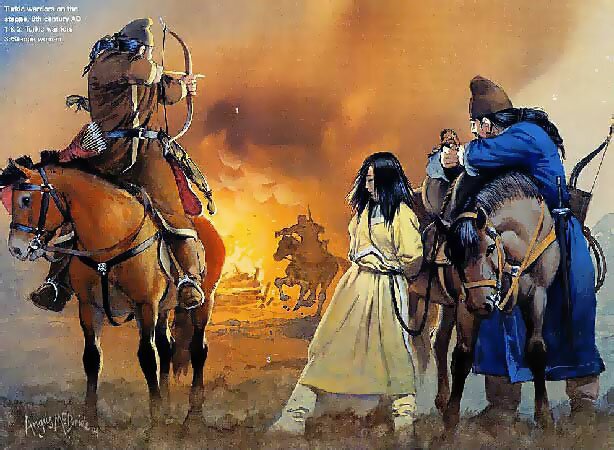
Taspar was the third son of Bumyn-Kagan. He ascended the throne, put Taspar corulers ("small Kagans"): nephew Shetu (son of Kara Issyk Khan) appointed Erfu Khan, i.e. the ruler of the eastern domains, and brother Zhutan Khan - in the west, with the title Bouley Khan. Zhou Emperor Wu (Yuwen Yun) was forced to conclude a peace treaty with the Turks, send to Kagan 100,000 annually silk fabrics and feed Turkish "embassy" consisting of several thousand people by the Treasury. Northern Qi till 577 year also sent gifts as a tribute to the Turks. Taspar Kagan said: "Just to the south of the two boys (Northern Zhou (Zhou Bay) and Northern Qi (Qi Bay)) were obedient to us, then we will not be afraid of poverty." In 577, the Emperor Wu conquered Northern Qi and Duke Gao Shaoyi, the last representative of the Qi dynasty, fled to the Turks. Taspar supported Gao Shaoyi and attacked Zhou in 578 year. District Yuchzhou was ravaged by the Turks. Wu fell ill and died. All winter Turks plundered northern China. In 579, the start of peace talks took place. New Emperor Xuan Di gave daughter of Wang Zhao to marry Tsyangin-kagan, and asked to give Gao Shaoyi. Kagan refused and raided. He Zhoi envoy was sent by Zhou emperor with rich gifts to Taspara rate, and the other one agreed to give Shaoyi. Kagan invited Shaoyi to hunt, there he was tied up and handed to Zhoi Ho, who took Shaoyi to Chang'an. At the end of 581 years Taspar Kagan became ill and died.
576 year – death of Istemi, brother of Bumyn and de facto ruler of the Western Turkic Khaganate
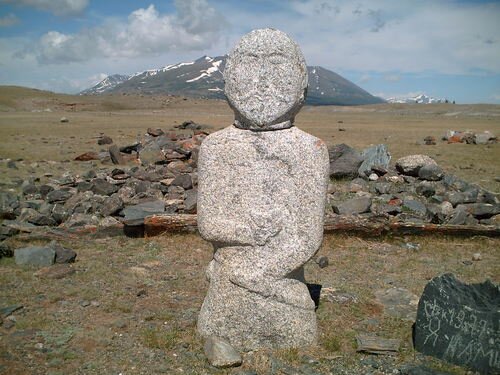
Istemi, brother of Bumyn, died. After his throne was inherited by his son Kara Churin, who controlled the western part of the Turkic Khanate until its collapse.
581 year – beginning of crisis in Khaganate

After the death of Taspara there was a crisis caused by the lack of a clear line of succession. Before his death, bequeathed Taspar left the throne to Toremen. But Toremen son of Mukan-Kagan and youngest wife, was considered mean-born and the nobility decided not to put him as Kagan. Under pressure of Shetu (future Baga-Yshbara Khan) nobility favored Amrak the son of Taspara. Toremen was planning to depose newfound Kagan and take the throne, he and his servants publicly insulted Kagan with impunity. Deciding not to risk, the nobility declared brave and initiative Shetu as Kagan. Toremen received the title of Abo-Khan and went north. Shetu became Baga YshbaraKhan. Subsequently, these quarrels led to civil war in Turkic khaganate a few years later.
599-603 years - split and collapse of the Turkic Khaganate

West Kara-Churin Kagan and East Zhangara Kagan. In 597 the Turkic Kagan Yong-Ulugh asked for help from Kara Churin, as the Chinese have decided to make Khan Zhangara Kagan and they already lured to his side many Turks. This year Kara Churin broke the Volga tribes and troops began to move east. In 599, the Chinese generals were able to defeat the army of Kara Churina. Yong-Ulugh’s death removed the last obstacle of Kara Churina towards Kagan throne and at the end of 599 year, he said, without convening a congress of Turkic nobility proclaimed himself Kagan. Zhangar was proclaimed Kagan supported by Chinese troops. Zhangar was entirely dependent on the Chinese emperor, and lived under the protection of Chinese troops who protected him from Kara Churina. In the 599 year old Kara Churin headed deflating Khanate. Chinese immediately went on the offence and sent Shi Vansuya to attack Kagan. Kara Churin evaded battle and sent his son to attack the Eastern Turks, but the approaching Chinese reinforcements forced the Turks to retreat. In 601 Kara Churin took the initiative and broke the Chinese general in Hynani. Zhangar and Chinese generals opposed Kara Churina, they camped on the north bank of the Yellow River, north of Ordos. Turkish detachment under the command of Syginya, crossed the river and in a deft maneuver captured cattle and people of Zhangar. Chinese generals Yan Co and Lyang Mo caught Turkish detachment and recaptured their prey, other Chinese troops went on other roads across the path. Despite the defeat, the other Turkish detachment attacked the bid of Zhangar for the second time. In the year 603 in the rear of the Kara-Churina rebellion of Tiele tribes started that broke commanders of Kara-Churina. Eastern Turks, seeing the defeat of Kara-Churina, left him to Zhangar, Tatabs also joined them. On the fate of Kara Churina little is known. According to Chinese information on it, he was abandoned by most subjects and fled to Togon, where he died or was killed.
Epoch of khaganates
603-630 years – Eastern Turkic Khaganate
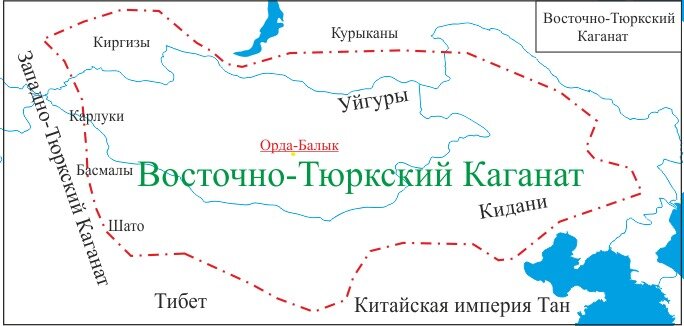
The power of Turkic state soon deteriorated. There is a weakening of the Turkic Khaganate, which became the main manifestations of civil wars strengthening, aggravation of social contradictions, the offensive on the Khaganate border by China, wars with neighboring countries. In the year 603 there was a collapse of the Turkic Khaganate on Western Turk Empire and the Eastern Turkic Khaganate. Initially, the rulers of the Eastern Turkic Khanate obeyed Chinese emperor (Zhangar Kagan). Zhangar Kagan until his death was a faithful vassal of the Chinese empire Sui. In the year 608 Zhangar visited Luoyang and returned to headquarters, where he soon died. Heir was his son - Shibir Kagan. Unlike previous Kagan, Shibir Kagan was not elected at a congress of dukes, but appointed by the Chinese Emperor Sui Yang Di. In 615, the son of Zhangar-Kagan Shibir-Kagan restored the independence from the Chinese empire. Since 615 year between the Eastern Turkic Khaganate and the Chinese empire a number of wars took place. In 617, the Sui Empire ceased to exist. Suddenly Turks again became a powerful force in East Asia, in 619 - Shibir Kagan died. Heir was his brother Chulo-Kagan, who died in 620. After Chulo Kagan Cat il Khan was elected governor. In 621-624 years he waged war against the Chinese Tang Dynasty. After the Armistice of 624-625 years, the war between the Turks and China resumed until 626, when it was signed a new truce. In 627, against Cat il Khan Seyanto Uighurs, bayyrku rebelled. As a result, Cat il Khan was captured by the Chinese and Eastern Turkic Khaganate ceased to exist.
603-704 years – Western Turkic Khaganate
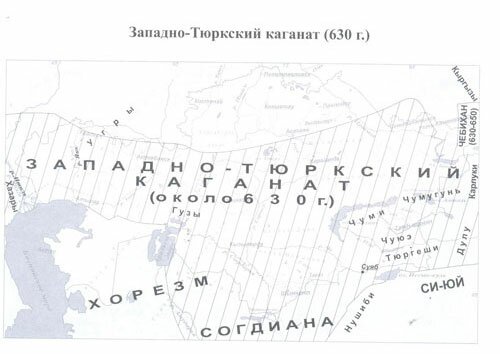
In the year 603 there was a collapse of the Turkic khaganate into the West and East. The boundaries of the Western Turkic Khaganate ranged from the Sea of Azov and the Don to the eastern spurs of the Tian Shan and north-eastern India. Core area of the state was Dzungaria populated with tribes of dughlats and Western Tien Shan with tribes nushibi. It was ruled by Kagans of the Ashina dynasty. Suyab became the capital city (near Tokmak city in Kyrgyzstan), and the summer residence was the Ming-Bulag (near the city of Turkestan). Center of the state was in Semirechie. In the first period of the Western Turkic Khaganate a certain anarchy existed within Khaganate. Also it is worth noting that at this stage the rulers of the Western Turkic Khaganate were dependent on the Chinese emperor. In the second period (610-630 years) Western Turkic Khaganate became an independent state and an active player in the global geopolitical field. In the third period (630-704 years) in the Western Turkic Khaganate strife occurred where two tribal groups fought Dughlats and Nushibi who supported those or other members of the genus Ashin. Last real independent ruler of the Western Turkic Khaganate was Hallyg Yshbara-Dzhagbu Khan (653-657 years) who achieved reunification of khaganate in the short term. He was involved into unequal war with the Chinese Tang empire, which led to the loss of independence of Khaganate. From 657 to 704 years Western Turkic Khaganate existed in the fourth period, when it was actually part of the Tang Empire.
610-618 years – the rule of Western Turkic Sheguy-Kagan
.jpg)
Sheguy, son of Young-Souh-tegin, grandson of Kara Churin Turk was Kagan of Western Turkic Khaganate since 611-612 years till 618 year. In 598, the Kara-CHurin Turk put his grandson Sheguy to rule in Shash, in what is now Tashkent. After fleeing of Taman Kagan, he was elected as Khan of nushibi tribes. In the case of Sheguya rule there were periodic collisions with Shibir Khan Turk-Shad - Eastern Kagan. These clashes have not brought any benefit to Western Khaganate. Sheguy made Altai an eastern border of Khaganate and extended its rule over the entire Tarim basin and the eastern Pamir region. Short-term flourishing of the Western Turkic Khaganate was a time of maximum territorial expansion of the new state, the rapid enrichment and the growing influence of the military-tribal nobility which joined forces under the auspices of the Kagan power for almost unceasing and always successful campaigns. Under his rule the state strengthened and stabilized.
618-630 years – the rule of Eastern Turkic Tone-dzhabgu kagan

Tone Dzhabgu - son of Young-Souh-tegin, son of Kara Churin Turk. His reign is considered to be the heyday of the Western Turkic Khaganate. In 619, he conquered the tribes of Kibi and Seyanto. After that, he conquered the Eastern Turkestan, Samarkand and the boarders of his state reached the territory of present-day Pakistan. Tone Dzhabgu tried to form an alliance with China against the Eastern Turkic Khaganate wooing the Chinese princess. In 626, the armies of Tone Dzhabgu captured Tbilisi. From 626 to 630 years Turkish troops were able to capture a lot of Caucasian possessions that belonged to the allies of Iran. Tone Dzhabgu held administrative reform and appointed his representatives - tuduns in the area for surveillance and control over the collection of tribute. They suggest that he released his coins with Sogdian inscription - Thun yabgu Kagan. He was killed by the rebels of Dughlats tribes led by his uncle Külüg-Sibir Khan.
632-671 years – Bulgar Khaganate

Short-term unification of Bulgar Turkic tribes (632-671 years), which arose in the steppes of Eastern Europe soon after the unrest in Western Turkic Khaganate and weakening of Avarians. The main area was located in the Black Sea and Azov steppes. Basis of the union was Bulgar tribe Kutrigurs. Khan Kubrat (632-665 years) managed to combine his horde with other Bulgar tribes Utigurs (previously depending on Turks) and Onogurs. Khan Organ, uncle of Kubrat, began to unite Bulgar tribes. Nicephorus, describing the events of 635 year, said: "In the same times Kuvrat rose again, relative of Organ, governor of Hun-hundurs, against Avar Kagan and all the people that were around him, exposing abuse, banished from his native land. (Kuvrat) sent envoys to Heraclius and made peace with him, which they kept until the end of his life. And Irakli sent him gifts and honored patrician dignity." After the death of Kubrat territory of Bulgar Khaganate was shared by his five sons: Batbajan, Kotrag, Asparukh, Cuber, Altsek. Each of the sons of Kubrat led his own horde, and none of them alone was strong enough to compete with the Khazars. During the collision with the Khazars, in the 660s, Bulgar Khaganate ceased to exist.
634-639, administrative reform of Yshbar Khilash-Khagan
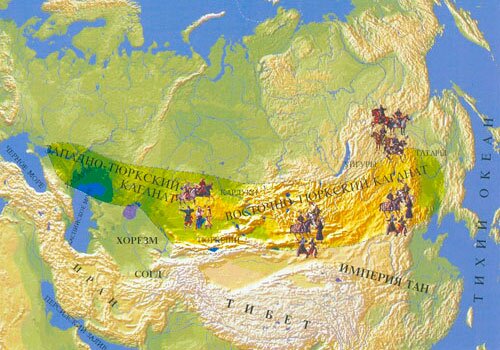
In 634, Yshbar Khilash-Khagan came to power. At the very beginning of his reign he was forced to start the management reform in his Khaganate. He made an attempt to revive the effectiveness of the military-administrative system of “ten arrows”. The major threat to the existence of Khagan was the eternal rivalry between the Turkic tribes – the Dulu and Nushibi. Hence, Khagan decided to split them. “Ten tribes” became the ethnic core of the Western Turkic Khaganate; five tribes of the Dulu stood out to the east of the Chu River; five tribes of the Nushibi – to the west. In historical sources, another name for the Western Turkic Khaganate is “On ok budun” (“The State of ten arrows”). These were mostly Turkic peoples: the Usuns and Kanglys in the Zhetysu and the Syrdarya River basin; the Turgeshs in the Balkhash Lake and the Trans-Ili Alatau areas; the Karluks in the East Kazakhstan; the Chigilis on the shores of the Issyk-Kul Lake; the Yagma – in the East Turkestan. The five rulers of the Dulu and the five for the Nushibi were appointed from tribal chiefs and note from the Ashin Princes. So the Western Turkic Khaganate became the Union of “ten-arrow” Turks, since as a symbol of the power, each Khan was given an arrow. The reform has not unified the Khaganate, but increased disintegration processes.
646-727, Tonyukuk, the political and military figure of the Second Turic Khaganate
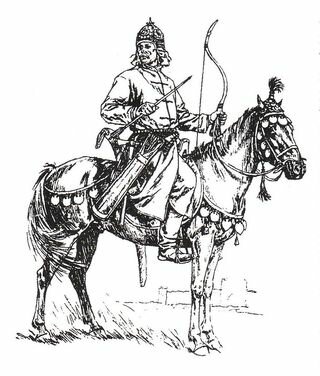
According to Tonyukuk, he got an education “under the influence of Chinese culture”. During the period of the restoration of independence of the ancient Turks, he was the closest advisor and associate of Kutlug, who took the title of Ilterish Khagan. Tonyukluk was the initiator of an active an aggressive foreign policy. He subsequently became an advisor to Bilge-Khagan, son of Kutlug Ilterish Khagan. It is also known that Tonyukluk initiated the erection of The Perpetual Epitaph in 717-718. Time when the stele was erected suggests that it was certain supporting “document” where Tonyukluk described his merits in the Khaganate creation, since after 716, Tonyukluk was in disgrace and escaped execution only because his kinship with Bilge-Khagan, who was married to his daughter.
650-969- The Khazar Khaganate

The Khazar Khaganate was founded by the Khazars, led by a Prince from Ashin Family. The Khaganate controlled the territory of the Ciscaucasia, lower and middle reaches of the Volga River, modern North West Kazakhstan, the Azov Sea region, eastern part of the Crimea, and also steppes and forests of Eastern Europe up to the Dnieper River. The center of the state was originally located in the seaside part of Dagestan; later it moved to the lower reaches of the Volga River. Part of the ruling elite of the Khaganate converted to Judaism. Number of the East Slavic tribal alliances was in the political dependence from the Khazars. Originally, the Khazars were one of the many monadic tribes, moving from Asia during the Great Migration of the Nations. The Khazars were speaking one of the early Turkic languages; the belonged to the tribes of the Ogur group, the first of which appeared in Europe in 463. The earliest reliable news of the Khazars is mentioned in the list of tribes by Pseudo-Zahari in 555.The rise of the Khazars is connected with the history of the Turkic Khaganate. The Khazars were first mentioned as a serious military force in connection with the Iran-Byzantine war 602-628, in which the Khazar ruler Jebukhagan became the chief facilitator of the Turkic-Byzantine Alliance against Iran. In 627, the Khazar army plundered the Caucasian Albania and took Tbilisi in alliance with Byzantines. Starting from 630 onwards, numerous internecine clashes have led to the collapse of the Western Turkic Khaganate. The result of this has been the emergence of two new political entities on its periphery in the steppes of Eastern Europe. The Great Bulgaria emerged in the Black Sea region; it was founded by Kubrat Khan in 632; Khazariya was created in the Caspian Sea region. At first time, the Khazars were not showing themselves. By the end of the 7th century, the Khazars controlled most of steppe Crimea, the Azov Sea region and the Northern Caucasus. In 737, the Arab commander Marwan ibn Muhammad (later the Caliph) at the head of 150 000 army suddenly invaded Khazariya simultaneously via Derbent and Daryal. Arab troops took the Khazar capital of Semender by storm and reached the city Al-Baida where the Khagan’s headquarters were. The Khagan fled deep into his possessions. In pursuit of him the Arabs came to the North further than ever: up to the Don and the Volga rivers. The Khazar army was defeated and the Khagan sought peace. In exchange for keeping the throne he promised to convert to Islam. The geopolitical consequence of the Arab onslaught was the displacement of Khazariya population from the dangerous Caucasian borderlands to the hinterlands - to the Don River area where the Alan tribes settled, and to the Volga River region. A new Khazar capital of Itil was founded in the lower reaches of the Volga River; it soon became a large trade center. Dagestan with the old capital of Semender converted to the southern edge of Khazariya from the central region. C.740, one of the Khazar commanders - Bulan- converted to Judaism. In the beginning of the 9th century, Obadiya, Bulan’s descendant, took the second after the Khagan’s post in the state and concentrated the real power in his hands. Since then, a system of dual ruling has been established in Khazariya: the nominal power was in hands of Khagans of the Ashin family while the real control was carried out on their behalf by Beks (Kings) of the Bulanid family. It is very likely that the establishment of the new order was accompanied by internecine clashes. Part of the Khazars, known under the name of Kavars, rebelled against the ruling dynasty, and after the suppression of the rebellion passed to the Hungarians. In the late 9th – early 10th centuries, the Khazar Khaganate weakened but still continued to be an influential state. In 965-969, the Khazar Khaganate was defeated by the Russians and the Oghuzs.
657, the Western Turkic Khaganate was captured by the Chinese troops and divided into two parts
.jpg)
After the death of Yshbar Khilash-Khagan, the 16-year tribal war began between groups of the Dulu and Nushibi; it weakened the Western Turkic Khaganate. Weakening of the Western Turkic Khanagate in the middle of the 7th, century led to China’s invasion to the territory of the Zhetysu. In 657, the Chinese decidedly conquered the Western Turkic Khaganate. Since that time, the Western Turkic Khaganate existed as a vassal state, and not as an independent one. Vassal settled population of the Zhetysu was called Tats; prisoners of war were turned into slaves.
682-745, the Second Turkic Khaganate

In 679, the Turkic tribes that settled in the Empire of Tang after the ruination of the Eastern Turkic Khaganate, organized a revolt in order to recreate the Khaganate. The mutiny was raised by the Turks of the Ashide tribe and was led by Ashide Yuanczhen. The rebels were defeated by Chinese troops, and a second rebellion led by Prince Funan was suppressed by the same commander. After three years in 682, the most tenacious supporters of the executed Funan led by Prince Kutlug of the Ashina dynasty raised a rebellion again. From this year, a Second Turkic Khaganate was restored. Kutlug ruled until 693. After his death, his brother Mochur became a Khagan; he fought with the Chinese up to 699. From 710-716, subsequent uprisings occurred against Mochur. Mochur was killed during suppression of one of these uprisings. His son was ruling for short time after his death, and was overthrown by children of Kutluk and nephews of Mochur. Junior son of Kutluk – Kul-tegin – killed Mochur’s son, and the elder –Bilge – became a Khagan. Bilge-Khagan’s reign is considered as the “golden age” of the Second Turkic Khaganate. In 741, a civil war startred in the Second Turkic Khaganate; a year later, the Karluks, the Uyghurs, and the Basmaly managed to unite and thrash the Turks. Confrontation between the Turks and their enemies lasted until 745.
685-731, Kul-tegin
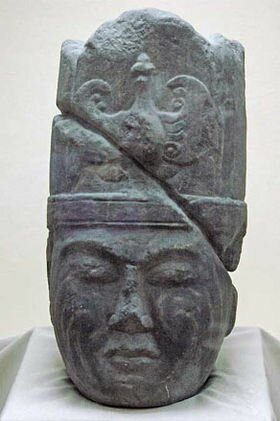
Kul-tegin was the younger brother of Bilge-Khagan. He was famous as the participant of numerous military campaigns which secured supremacy of the Turks in Central Asia. In 710, the Turkic army led by Kul-tegin together with his brother (the future Bilge-Khagan) and Tonyukuk, invaded Khakassia and defeated the Kyrgyzs. In 716, Kul-tegin prevented an overturn and enthroned his brother Mogilyan (Bilge-Khagan) to rule the Turks. In his honor a vast burial complex was created, an important part of which was a number of balbals – images of defeated opponents, among which the major one was the Kyrgyz Bars-Khagan. An Epitaph in Kul-tegin’s honor – a monument to the Turkic Runic script of the 8th century – was found in 1889 by N.M. Yadrincev in the Kosho-Tsaidam valley on the banks of the Orkhon River (Mongolia). In 1893, the writings were decoded by the Danish scientist – Professor Wilhelm Thomsen. This monument contains valuable historical information and gives a rich linguistic material.
704-756, The Turgesh Khaganate
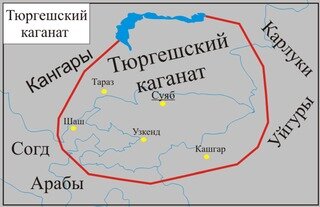
The Turgesh Khaganate was a medieval Turkic state on the territory of Kazakhstan. It ranged from Tashkent to Turfan and Beshbalyk. The state’s capital was Suyab. The Turgesh were part of the Dulu tribal alliance; they were divided into Kara-Turgeshs and Sary-Turgeshs. Their leader Ushlik toppled the Chinese Governor of the Zhetysy and the last Khagans of the Western Turkic Khaganate; he then sent an Embassy to China demanding from the Chinese to recognize him as a Khagan. The Khagan Ushlik moved his headquarter to Suyab city and divided the whole territory of the Khaganate in 20 areas – tutuks. In each area there were up to seven thousand warriors. Rising of the Turgesh power is associated with the names of such Khagans as Ushlik, Soge, and Suluk. Ushlik became the Turgesh Khagan back in 699 and captured Suyab in the same year. A small (nomadic) headquarter was on the Ili River. In 699, he sent his son Zheng to Changyan. Wu Zetian Empress accepted him highly, which could be regarded as recognition of the Turgeshs. Favor of the Chinese can be explained by the fact the Tang government looked for allies against the Eastern Turkic Khaganate. In 706(707) Ushlik got a Tang title of Huajde Chun Wang, i.e. foreign recognition. His son Soge got a military rank of Chocyaowei Dazyanzyun. When Ushlik’s son Soge became a Khagan in 708, a civil war between the Sary-Turgeshs and Kara-Turgeshs started. Soon, Zheng, Soge’s brother, unhappy with the fact that his brother gave him few people and power, rebelled and migrated to the Eastern Turkic Khaganate to Kapagan Khagan. Zheng suggested to overthrow Soge with a joint effort. Kapagan Khagan invaded the Turgesh Khaganate and defeated Soge, who was killed in the battle. After him, the Turgesh Khaganate was ruled by Suluk, who consolidated the state. After the death of Suluk, the Turgesh Khaganate entered into a series of internecine clashes and was conquered by the Karluks.
705, beginning of conquest of Central Asia by the Arabs

Arab tribes that lived in the Arabian Peninsula from the 3rd millennium BC were consolidated into a single state by Prophet Muhammad, who became the founder of a new religion – Islam. After the death of Muhammad in 632, the Arabs invaded Persia and Byzantium capturing the Byzantine lands and fully including Persia into the Arab Caliphate. In the first half of the 7th century, Arabs began conquering Central Asia. At that time the Turgesh Khaganate was ruling on the territory of Kazakhstan; the Turgeshs established a close relationship with the Sogdians to repel the Arabs. In 705, the Arab forces came close to borders with the Turgeshs hoping to take Mawerannahr. Under new circumstances, Ushlik had concluded an alliance with China and the Sogdians, and defeated the Arabs at Paikend and Bukhara. Ushlik’s son Soge Khagan expelled the Arabs from Central Asia and in fact became the hegemon in that region. In 708, an internecine war between the Khagan and his vassal Kuli-Churi started in the Turgesh Khaganate. In addition, Soge’s brother Zheng moved to the side of the Eastern Turkic Khaganate and appealed to it for help in the fight for the throne. The Eastern Turkic armies started a campaign and in 710, the Turgesh army was defeated on the Bolochu River. Soge began to gather new troops but again was defeated and captured; Zheng became a Khagan. The Turgeshs’ defeat allowed the Arabs to resume the offensive in Central Asian and in 711 they took Samarkand. In 713, the Arabs captured Hodjent, Fergana, and tried to take Tashkent; in 715, the Arabs tried to sneak in the East Turkestan.
715-738, the rule of the Turgesh Suluk-Khagan
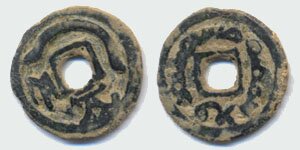
The spread of the Arab influence that started in 711 (after the defeat of the Turgeshs from the Eastern Turks) was again stopped by the Turgeshs led by Suluk, who in 715 freed Fergana of invaders. In 717, the talented Suluk Khagan managed to restore the former power of the Khaganate. Challenging the Arabs’ control over Mawarrannahr, the Turgesh were a formidable force. Despite the fact that the Arabs were trying to persuade Suluk Khagan to their side, he acted boldly and decisively against them. In 723, the Turgeshs together with the Karluks of Fergana and inhabitants of Shash inflicted a major defeat on the Arabs. In 724, the Turgeshs supported the rebellion in Sogd and began a guerilla war against the Arabs there. And only at the end of 732, the Arabs managed to thrash the Turgeshs and step in Bukhara. In 737, Suluk undertook a new campaign against the Arabs coming with his troops to Toharistan but he was defeated. The Arabs used rivalries among the Turgeshs and successfully completed the conquest of Sogd; they crushed the resistance of Samarkand, Tashkent, and Otrar; in 738, the Arabs established firm borders with the Turgeshs. Further movement of the Arabs in Central Asia and the South Kazakhstan was stopped by the Chinese in a battle on the Talas River near the city of Atlah. Peace with China was broken and Suluk had to wage war on two fronts. In 738, Baga-Tarkhan, a chieftain of the Sary-Turgeshs, killed Suluk and seized power.
745-840, the Uyghur Khaganate
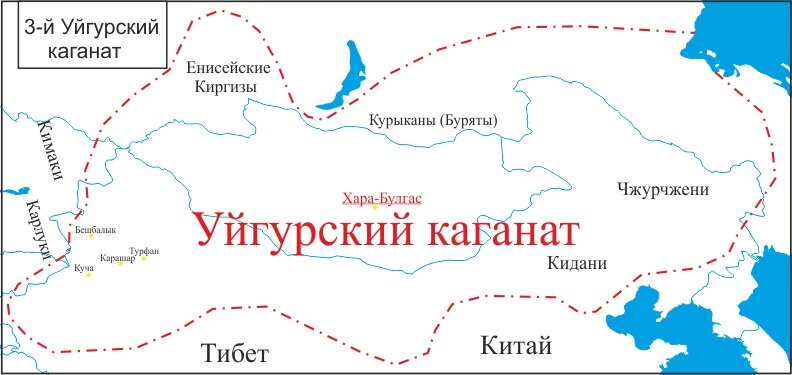
In 742, a coalition of the Basmaly, the Karluks, and the Uyghurs defeated the Turks. A clash between this coalition and the Turks lasted from 742 to 745. Also, there was a struggle within the coalition, from which the winners were the Uyghurs. In 745, the Uyughurs defeated the last Turkic Khagan and sent his head to China; the Chinese Emperor rewarded them generously for that. For the next two years, the Uyghur Empire expanded continuously, although it did not reach the size of the Turkic Khaganate. In 756, An Lushan’s rebellion was started in China. The Uyghurs took an active part in suppressing the rebellion. In 765, the Uyghur Khagan converted to Manichaeism and it was declared as the state’s religion. In 840, the Yenisey Kyrgyzs defeated the Uyghurs and captured the capital of the Uyghur Khaganate.
746, migration of the Karluks to the Zhetysu
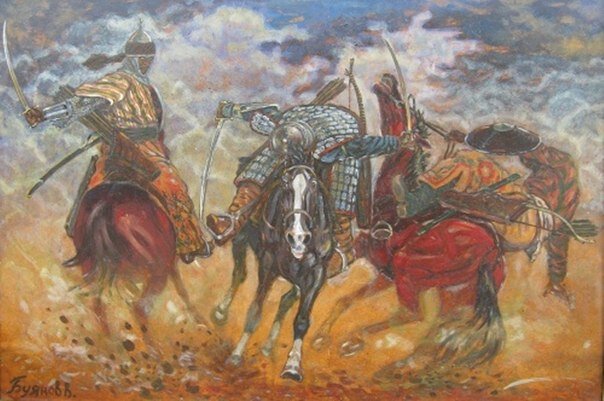
In 746, after losing to the Uyghurs in the war of succession of the Second Turkic Khaganate, the Karluks moved to the Zhetysu and Jungaria. The main purpose of the Karluks’ Yagbu was the fight against the Uyghur Khaganate for dominance in the steppes. By 751, together with the Kyrgyzs, tribes of the Chiks, and the remainders of the Turks, the Karluks managed to create the Anti-Uyghur Union.
751, battle on the Talas River
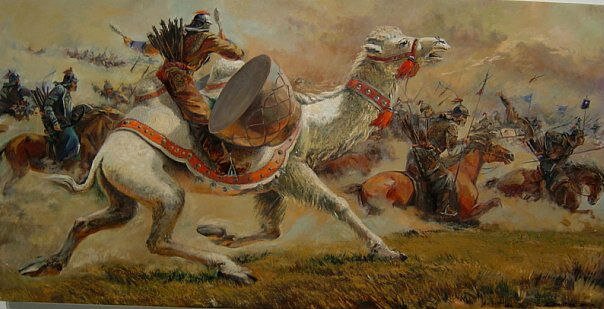
During the period of relocation of the Karluks to the Zhetysu and the Tien-Shan Mountains, the situation there remained tense. The Arabs managed to complete the conquest of Sogd, crush the resistance of Samarkand, Tashkent and Otrar and by 738, to establish firm borders with the Turgeshs. The Chinese also renewed the offensive; in 748, they destroyed the city of Suyab. Two armies, Arab and Chinese, met on the Talas River in 751. The violent battle lasted for five days and ended in victory for the Arabs thanks to the Karluks, who joined them. The battle put an end to the Tang Empire’s movement to the West. At the same time, Chinese military leaders managed to cause a significant damage to the Arab forces that halted their advance to the East, to the Zhetysu – to the lands of the Turgesh Khaganate. The Chinese were expelled from the Zhetysu but the Arabs were forced to retreat because of the continuous revolts in the conquered Sogd. The most winning side was the Karluks in this situation. This victory was crucial in the history of the peoples of Central Asia: the Chinese did not appear at its borders for thousand years that secured the development of Islam throughout Central Asia.
756-940, the Karluk Khaganate
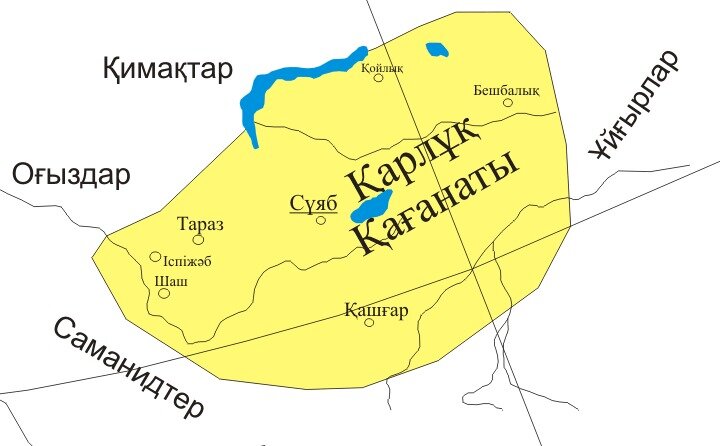
The Karluk Khaganate was the Turkic state which occupied the territory from the Jungar Alatau to the middle reaches of the Syradya River, between the Balkhash and Issyk-Kul Lakes. The first information about the Karluks relates to the 5th century. Initially, they occupied the territory between the Altai and the eastern coast of the Balkhash Lake. In the middle of the 7th century, the following tribes became a part of the Karluk Union: the Bulaks, the Chigils, and the Tashlyk (the Karluk). The title of the leader of the Union was Elteber. In 742, the Karluks together with the Uyghurs and the Basmaly opposed the Eastern Turkic Khaganate. As a result, the Eastern Turks were defeated and the new state has been founded – the Uyghur Khaganate (745-840). In 746, the Karluks were defeated by the Uyghur Khaganate and migrated to the Zhetysu. In the middle of the 8th century, the Karluks and the Oghuzs were fighting for the Turgesh heritage. The Oghuzs lost in this struggle and moved to the Syrdarya River; the Karluks remained in the Zhetysu and created an early feudal state – the Karluk Khaganate. The Karluk rulers started to take a title of Yabgu. In 756, the Karluks launched an offensive against the Turgeshs in the Zhetysu. Seven years later, taking Suyab, the Karluks moved their capital there. Part of the Turgeshs obeyed while another part roamed to the East. Karluk troops quickly reached the western spurs of the Tien Shan Mountains, cleared Fergana and middle reaches of the Syrdarya River of the Arabs. However, a series of victories resulting from the weakness of the enemy, soon gave way to heavy defeats. In 766-775, the Karluks took Kashgariya and at the end of the 8th century they have extended their influence to Fergana. In 791, the western Karlyks resigned to the Uyghurs; in 812, the Karluk Yabgu was heavily defeated and the Uyghur armies came to Fergana taking many people and cattle. In 791, the Uyghurs defeated the Karluks and the Tibetans at Beshbalyk; the following year the Karluks were defeated by the Arabs in Fergana. The Arabs have taken advantage of the situation and forced the Yabgu to flee to the Irtysh River. The Karluks were forced to obey the Uyghurs. In 840, the Yenisey Kyrgyzs defeated the Uyghur Khaganate, and the Karluks were able to free themselves. The Uyghurs were forced to settle in the Turfan Oasis and the Ganzhou region. In this situation the Karluks declared their independence and the Karluk Yabgu, the ruler of Ispidzhab, Bilge-Kyul Kadyr Khan has openly declared his rights to supreme power taking the new title of a Khagan. The Samanids who owned Central Asia announced a “holy war” against the Turks. At the end of the 9th century, the Arabs captured Ispidzhab and Taraz. The Khagan’s headquarter was moved from Taraz to Kashgar. In 940, the state’s capital Balasagun was taken by the Turks of the East Turkestan – the Chigils and the Yagma; the Karluk Khaganate ceased to exist formally. The Karluk Dynasty that was a branch of the Ashin Dynasty took a new name and became known and the Karakhanids, who were able to united the Karluk and the Turgesh tribes of the Zhetysu and the Syrdarya River basin for a long time. Part of the Karluks roamed over the Ili River and founded a new state – the Karluk Khanate with the capital Koilyk. The Karluk Union consisted of numerous tribal groups. The major tribes of the Karluks in the Zhetysu and the South Kazakhstan were: the Tuhs, the Chigilis, the Azkishis, the Turgeshs, the Haladzhis, the Charuks, the Barskhans, and the Yagma.
Early middle ages
840, Defeat of the Uyghur Khaganate by the Yenisei Kyrgyzs

In 839, a nobleman Kyulyug-beg relying on the Shato people, attacked Karakoram. The Khan committed suicide and the noblemen who supported the uprising, declared a little Kesi-tegin as a Khan. There was a little snow that winter and a lot of sheep and horses died; the famine was followed by the plague, and by 840th the Uyghurs have weakened from hunger, epidemics and confusion caused by the uprising. The Kyulyug-beg’s enemy, who was his elder patriarch, called upon for help of the Kyrgyz people and took Karakorum. The Khan and Kyulyug-beg have been executed and yurts of their supporters were burned down. However, Khalkha, Karakorum and all the treasuries of the Uyghurs were in the hands of the Kyrgyzs. Among the trophies obtained by the Kyrgyzs in Karakorum there were the Chinese princess and wife of three Uyghur Khans.
840, The Karluk rulera take the title of a Khagan
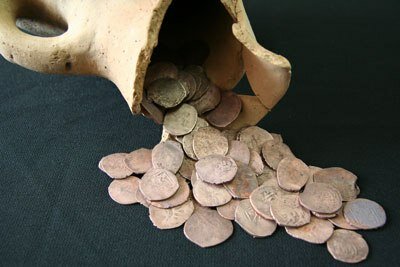
The tribes of the Chigili and Yagma, as well as on of the Turgesh tribes – Tuhsi – and the remaining Orkhon Turkic peoples entered into the Karluk tribal Union. The history of all these tribes, starting with the 9th century, is inseparable. One of the KaraKhanid legends tells that the first sovereign of a KaraKhanid dynasty was Bilge-Kyul Kadyr-Khagan who was fought by one of the Samanid Emirs, rulers of Samarkand and Bukhara, - Nuh ibn Asad who in 840, led a campaign against Zhetysu Turkic people and conquered Ispidzhab. When the Yenisei Kyrgyzs defeated the Uyghur Khaganate, the Karlyks declared their independence. The Karluk dzhabgu (a ruler) of Ispidzhab – Bilge-Kyul Kadyr-Khan has openly declared his rights to supreme power, taking the new title of a Khagan.
840-920, Kyrgyz Khaganate
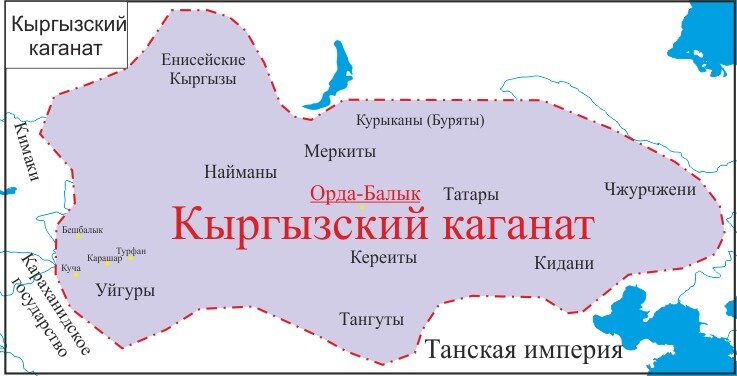
The Kyrgyz Khaganate is an early medieval Turkic State in Central Asia and Southern Siberia led by the Yenisei Kyrgyzs. In the 6th-7th centuries the Kyrgyzs together with the Taiga people under their power, formed the peripheral area of the Central Asian states that was headed by the Governor – Elteber. In the 8th century, it became a separatist region led by own beks and inals pretending for a Khagan title. In 840, the Kyrgyzs destroyed the Uyghur Khaganate and extended their authority to the Tuva and Mongolia. In pursuit of the remainders of the Uyghurs, the Kyrgyz reached the Irtysh and the Amur Rivers and invaded the oases of the East Turkestan. The Kyrgyz rulers were considered to be related to the Chinese and other neighboring countries’ ruling houses both dynastically and through marriages. The Emperor Tang wrote to a Kyrgyz Khagan that “it is known that you, Khan, have the same roots as my family does. [Han] Baypy Taishou’s talents had no equal in China; he established a friendship and served on the border. If he pulled a bow then he pierced a stone. His descendants have been studying a military art a lot and have been becoming generals. The Taishou’s legitimate grandson duvey Li Ling led five thousand select troops deep into a desert. A Shanyui raised people to fightback. Li Ling could not resist the power, and despite he incurred a defeat, his name shocked the barbarian tribes. My state has inherited the heritage of Baypy Taishou’s descendants; and you, Khan, is also a descendant of the duvey and this is why we have united our families and now everyone can learn the relationship from the highest to the lowest”. After 80 years (around 920th) the Kyrgyz state loses its territories in Mongolia. The Kyrgyzs retained two main areas of resettlements: 1) upper and middle Yenisei; 2) Altay. Later in 14th century, a part of Altaic ethnic Kyrgyzs moved to the Tien-Shan Mountains, marking the beginning of the modern Kyrgyz people. The Kyrgyzs, who remained at the Yenisei River, have become the ancestors of modern Khakassian people.
The 9th century – 1043, The Oghuz State
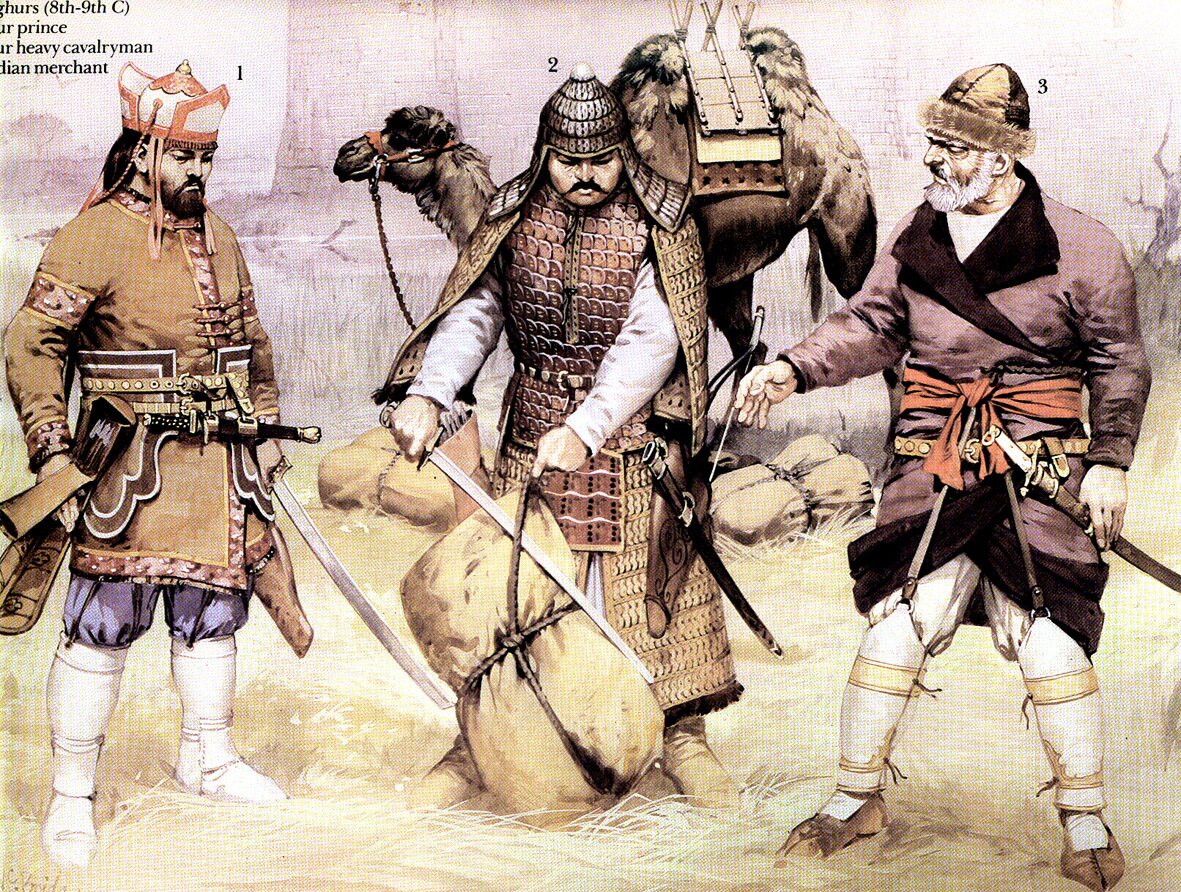
Originally the Oghuz roamed in the Zhetysu. Rotated off by the Karluks, the Oghuz migrated to the middle reaches of the Syrdarya River where they began fighting over land with the Kangards (Pechenegs-Bajanaks). Later they moved from the Syrdarya River to the Volga River and were scattered on the banks of Irgiz, Ural, Emba, Uiyl rivers and also in the foothills of the Alatau Mountains. The highest density of the Oghuz was in the middle and lower reaches of the Syrdarya River, on the Aral Sea cost, and the Eastern Caspian Sea coast. So the Oghuz State – Mazafat al-Oghuz (‘the Oghuz steppe’) – has been formed in the steppes of the Western Kazakhstan. In the 10th century Yangikent became the capital of the Oghuz state; Yangikent was situated on the junction of important caravan routes reaching out to Middle and Central Asia and Eastern Europe. Large cities of the Oghuz state were Zhent, Sauran, Karnak, Sautkent, Farab, and Sygnak. According to Mahmud Kashgari (the 11th century), the Oghuz were divided into 24 tribes: 12 tribes were Bouzuks and other 12 were Uchuks. Bouzuks enjoyed greater privileges. In 965, the Oghuz were allies of the Kiev Prince against the Khazars. In 985, the Oghuz and the the Kiev Price Vladimir entered into a military alliance against the Bulgars. In the 11th century, the Oghuzs started to move to Iran and the Near East. This movement was led by the heads of the Kanyk tribe Torgul-bek and Chagry-bek who were grandchildren of Seljuq; the tribes that participated in the movement were called the Seljuqs therefore. In 1025, part of the Seljuqs settled on the territory of modern Turkmenistan, near Nysa town. In 1034-1035, Togrul-bek’s people joined them. In 1038-1040, the Seljuqs stepped against the Ghaznavids of Nishapur. During the reign of Ali Khan number of people’s revolts against the cruel exploitation had increased. Discontent of the people was used by the Seljuq chieftains who wanted to seize power in the country. Ali Khan’s successor Shakhmaik suppressed the uprising and strengthened his power and conquered Hoerzm in 1041. However, two years later, Shakhmalik fell into the hands of the Seljuqs and was executed. He was the last ruler of the Oghuz. The Seljuqs ruled the Oghuzs thereafter.
The 9th century – first half of the 11th century, State of the Kimeks
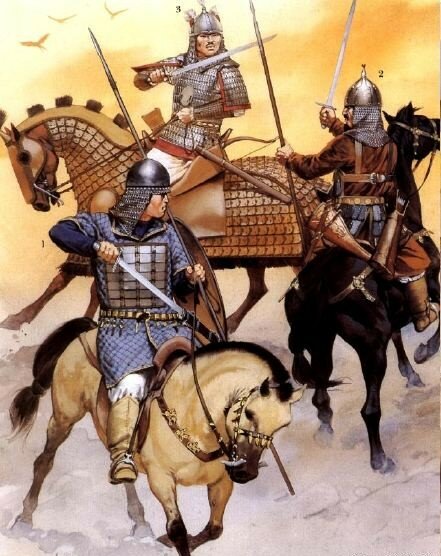
State of the Kimeks is an early medieval state on the territory of modern Kazakhstan and Southern Siberia. The state stretched from the Irtysh River in the East to the Ural Mountains in the West. The main part of population was the Kimiks who lived in the eastern lands of the Empire; the lands closer to the Ural Mountains were populated by the Kipchaks regarded as the western branch of the Kimeks. Also the state was inhabited by tribes of the Eimur, the Tatar, the Bajandur, the Lanikaz, and the Ajland. The state’s capital was Imakiya on the Irtysh’s bank. Around the 11th century, the Kipchaks moved further to the West occupying lands that had been previously belonged to the Oghuzs. The Kipchaks have strengthened and put the Kimeks under their power. According to some sources, the Kipchak migration was a thoughtful occupation of the best pastures. Many of the Kimeks moved together with the Kypchaks to the West while other Kimeks stayed on their territories near the Irtysh River. This migration of the Kipchaks, the Kimeks, and the Pechenegs has totally changed the ethnic map of Eastern Europe.
847-1036, The Uyghur State in Gansu
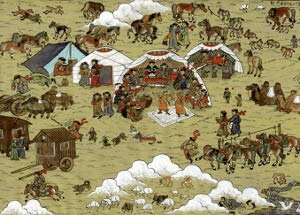
The history of the Gansu Uyghurs can be divided into three stages: 1) 841-862, the Uyghurs penetrated into the territory of modern Gansu province when they have been dependent on the Tibetans and even participated in the military operations of the Tibetans; 2) 862-902, the struggle with indigenous population of the region (the Shatos, the Tanguts, the Tatars etc.) and with the Tibetans and the Umo for creation of the independent Uighur State. 3) 902-1028, the Uyghur Gansu State existed. In 1028, the Uyghur State in Gansu surrendered under the Tangut’s pressure.
847-1368, The Turfan State of the Uyghurs
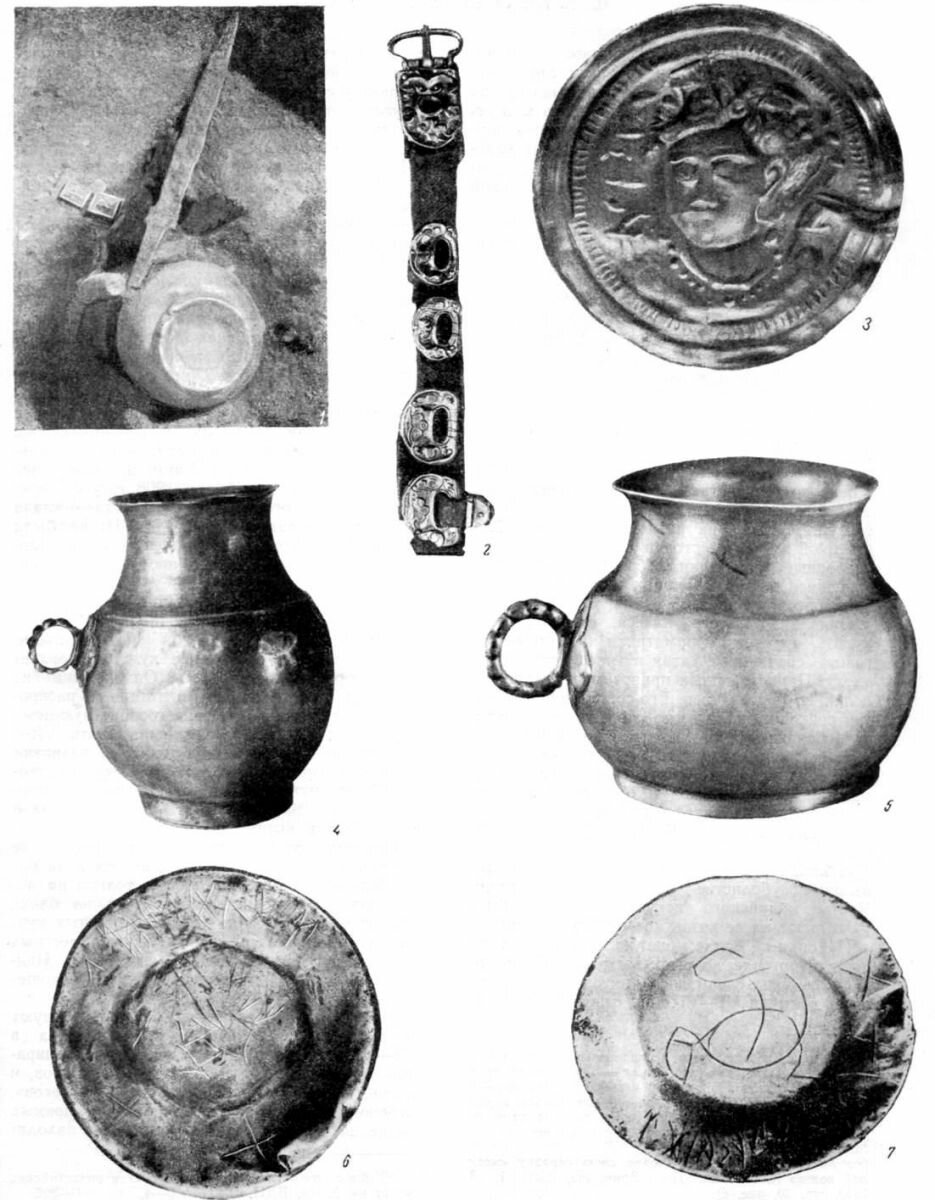
The Turfan State of the Uyghurs is a medieval Turkic State in the Northern part of the East Turkestan that was ruled by the dynasty of the Uyghur idykouts (‘a ruler’). This state was formed upon the breakup of the Uyghyr Khaganate. Pan Tekin is considered as the first idykout of Turfan. Pan Tekin had taken Turfan, Baytin, Karashar and Bugur from the Tibetans and founded the Uyghur Idykout. The Turfan State of the Uyghurs was the dominating state in the East Turkestan until the arrival of the KaraKhanids. In 1207, the Uyghur Idykout became a vassal of the Mongol Empire, and then – of the Ulus of Chagatai. The Idykout becomes a son-in-law of Genghis Khan and one of his close associates. After the collapse of the Mongol Empire, idykouts obtained some autonomy. After the liquidation of the Ulus of Chagatai in 1346 and formation of Mogulistan, The Turfan State became an independent state. In 1368, it was destroyed by the Moguls.
870-950, Abu Nasr al-Farabi
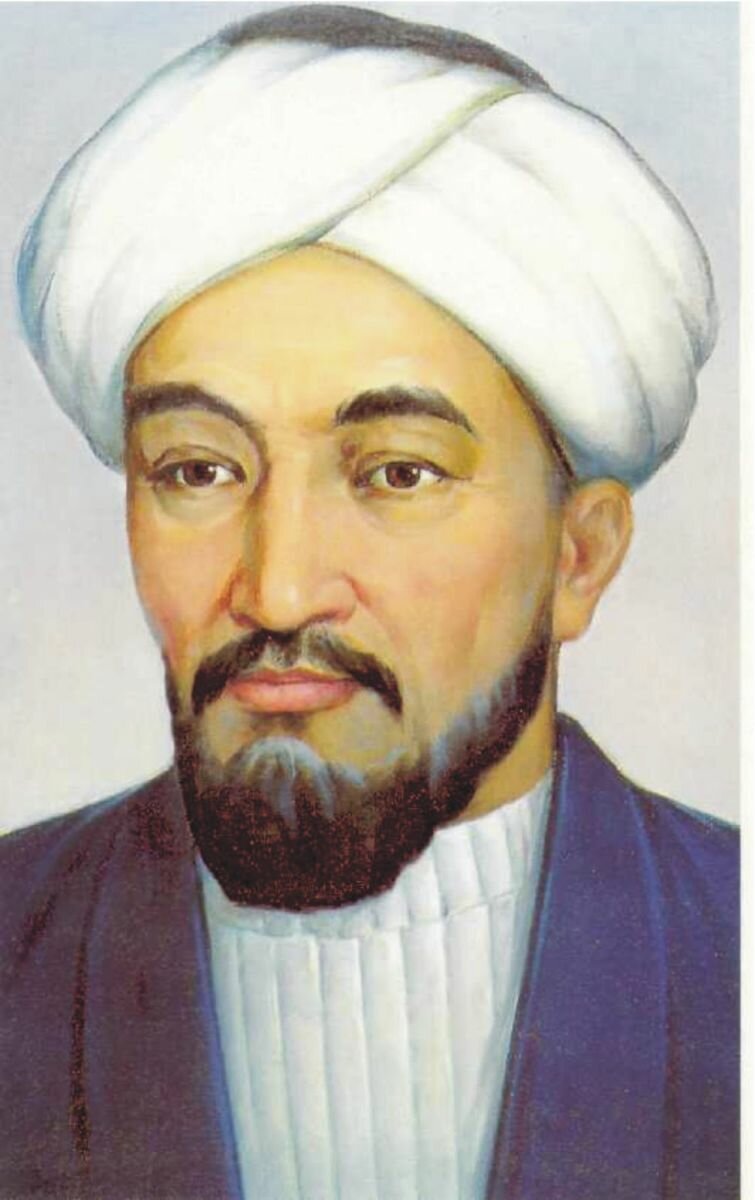
Al-Farbai was born in 870, in the ancient city of Otrar; the Arabs called this city Barfa or Farab that was situated on the banks of the Arys River. Hence his name is translated as Abu Nasr of Farab. The current location of the city is the territory of Shaulder area in the South Kazakhstan region. Full name of this prominent figure is Abu Nasr Muhammad ibn Muhammad ibn TarKhan ibn Uzlag al-Farabi at-Turki; common short name – al-Farabi. East scholars call al-Farabi a great and unique personality. He was a scientist-encyclopedist, mathematician, and music theorist. He is considered as one of the most prominent representatives of the medieval Eastern philosophy. Al-Fababi is also known for his works in science, literature, and astronomy. Al-Farabi is the author of comments to works of Aristotle (hence his honorary nickname is “Second Teacher”) and Plato. His works influenced ibn Sina, ibn Baja, ibn Tufail, ibn Rushd, and overall the science of medieval Western Europe. He had also interest in astronomy, logic, ethics, medicine, psychology, and right. Al-Farabi has written 160 treatises on various branches of knowledge. It is assumed that Al-Farabi has received the initial education at home. There is evidence that prior to his departure from Central Asia, al-Farabi resided in Shash (modern Tashkent), Samarkand, and Bukhara where he was studying and working for some time. He then went to Baghdad to continue his education; Baghdad was the capital and cultural center of the Arab Caliphate. Along the way he visited number of cities of Iran – Isfahan, Hamadan, and Rey (modern Tehran). In Baghdad al-Farabi settled during the rule of Caliph al-Muktadira (908-932) and started to explore different fields of science and languages. There is no consent who were teachers of al-Farabi. It is known that he studied medicine, logic and Greek language. In 941, al-Farabi moved to Damascus where he spent the rest of his life for scientific work. In Damascus, he finished “The Treatise of virtuous city” that he had started earlier. It is clear that the first years in Damascus were not easy for al-Farabi. Some sources evidence that he was forced to work as a watchman, and the only time for science was left at night by the light of candles that were bought on money earned during the day. However, he soon found a patron – ruler of Aleppo Sayf ad-Dawla ali Hamadani (943-967), who had been supporting advanced people of his time. After the studying the world of theoretical thinking, al-Farabi proposed his own philosophical concepts. His views came into conflict with established public views. In his works al-Farabi has been analyzing achievements of Arabic, Persian, Greek, Indian, and Turkic cultures and managed to find common features that those shared. Al-Farabi had a dream to enlighten the people. His motto was that a person striving for science, should be a man of merit with well manners. Such man should begin with the study of the Quran and jurisprudence; he should be honest and truthful; stay away from the lies; he should be a free-thinking man who bear on the basis of political ethics; use the principles of Shariah without distorting them. Al-Farabi was confident that on the basis of political ethics and the philosophy, one can come to the true harmony; he believed that the intellect is a basis for humanity; al-Farabi argued the futility of fighting and wars between people. Al-Farabi’s works have the special space in the history of science. There are two versions of the death of al-Farabi. According to the first one, he died of natural causes in Damascus; the second one tells that he was killed by robbers while travelling to Askalan. It is also known that Farabi was buried without the participation of the clergy.
907-1125, the Lyao state of the Kidans
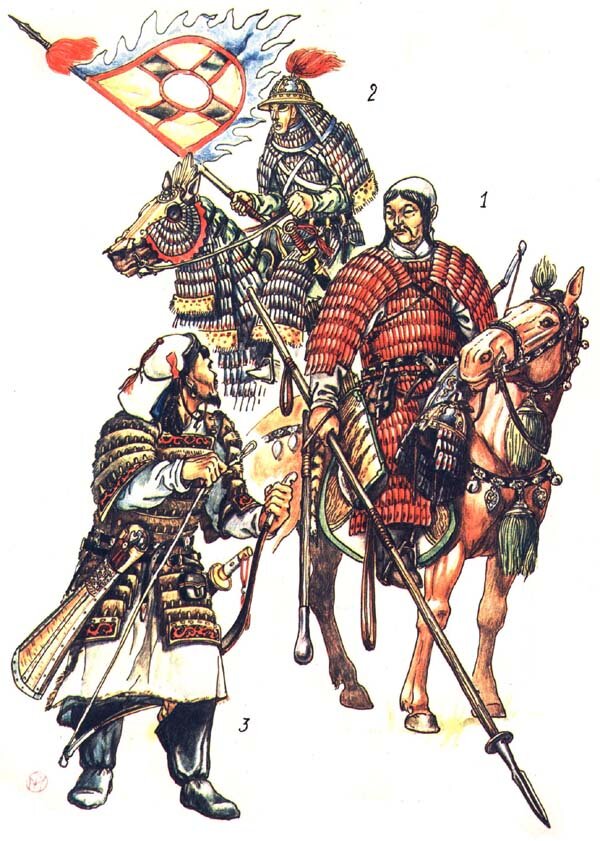
The Lyao state of the Kidans was the early medieval state that existed on the territory of the modern North-West China from the moment of foundation by the tribal leader Abaoczy in 907 till the uprising of the Jurchens in 1125. In 906, the Lyao state attacked the Bokhay state. After 20 years of resistance, the Bokhay state surrendered in 926. On the edge of the 11th century, the Kidans started fighting with the newly formed Song Dynasty in Kaifeng for the northern provinces of the Inner China. Starting from 1004, Song emperors paid tribute to the Kidans while the latters were imbibing the culture and traditions of the Song China. In 1125, the Jurchens, who were previously under control of the Kidans, started the uprising under leadership of Vanyang Agud; together with the Song Dynasty, they made the Kidans to move to Central Asia where the latter founded a state of Kara-Kidans.
942-1212, The KaraKhanid state
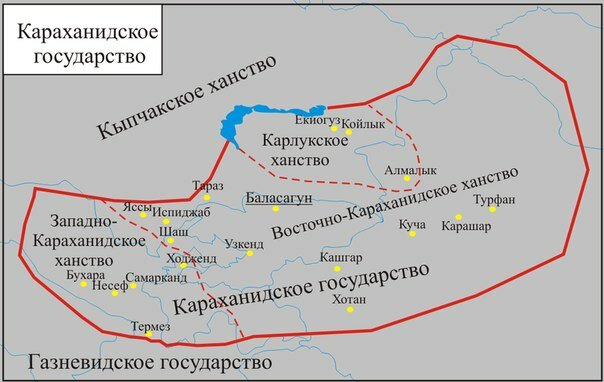
The KaraKhanid state is an early medieval Turkic formation that existed on the territories of the South Kazakhstan, the East Turkestan, and Central Asia. The power in the KaraKhanid state was divided between two tribal groups that were the core of the Karluk tribal unity in the 9th century – the Chigils and the Yagma. This division of power was observed in the following way: the KaraKhanid state was divided into two territories – Eastern and Western with own Khagan at the top of each. Eastern Khagan resided in Kashgar (the site of ancient settlement Buran near modern Tokmak city in Kyrgyzstan) was considered as a senior Khagan and was coming from the Chigils; his title was Aryslan Kara Khagan. Western junior Khagan was coming from the Yagma and had a residence in Taraz and then in Samarkand; his title was Bogra Kara Khagan (“Bogra” means “camel” – this was a tribal totem of the Yagma). In 920, Satuk (920-955) became a Yabgu (head of the tribe) of the Yagma; he was a grandson of the first Karlyk Khagan Bilge Kyul-Kadyr. In 932, Satuk converted to Islam and changed name to Abd al-Karim. Under his son and successor Musa ibn Abd al-Karim Bogra-Khan (956-958) a total conversion to Islam started in the state. In the time of Suleiman’s sons Ali (970-998) and Hasan (who is known in the written sources as “Shegab ad-Dawla or “Star of the State”) (970-992) the dual power has been established in the country. Nasr ibn Ali Aryslan-Khan (998-1017) was the youngest son of Ali Aryslan-Khan whom Ali bequeathed the throne, and he took Bukhara. In 1040, the state was effectively broken up into two parts – Eastern and Western. In 1089, the Western KaraKhanid state became a vassal of Seljuqs. In 1141, the Eastern KaraKhanid state falls under power of Kara-Kidans. In 1210, the Western KaraKhanid state became a vassal of HoresmShah Muhammad II. In 1212, Naiman Khan Kuchluk destroyed the Eastern Khaganate in Uzgen and Kashgar. At the same time, the Western Khaganate was destroyed in Samarkand.
960, Declaration of Islam as the State religion of the Karakhanids
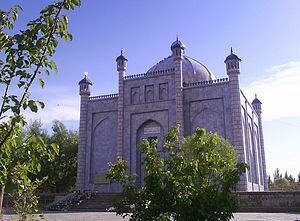
The most important even of the time of early Karakhanids was conversion to Islam by the dynasty and dependent tribes. In the 10th century there have been striking changes. The Arab geographer ibn Haukal reported on the adoption of Islam by thousand families of Turks, roaming in the region between Ispidzhab and Shash, i.e. in the mountains and steppes adjacent to the middle stream of the Syrdarya River. However, the biggest event of its kind, according to the Arab historians ibn Miskaveihu and ibn al-Asiru, happened when “200 000 tents of the infidels (i.e. the while nomadic population of the KaraKhanid state) embraced Islam”. This fact is linked with the name of the Karakhanid Khagan – son of Bazyr and nephew of Ogulchak – Satuk Bogra Khan who converted to Islam before the mass adoption of Islam by Turks; he also changed his name to the Islamic one - Abd al-Karim. His son Musa who inherited the throne in 955, was the one who declared Islam as the state religion. The centers of the spread of Islam in Mawarannahr (Central Asia) were cities among which were Samarkand, Bukhara, Shash (modern Tashkent), Merv, Khujand, Ispidzhab (modern Sairam), and Taraz. The Persian people of Central Asia, who converted to Islam in the 7-8th centuries, committed not only cultural but military incursion into the territory of the Turks. The majority of the Turks – the Yabgu, the Chigils and the Karluks who were considered most cultural and religious among the Turks – converted to Islam in the 9-10th centuries. These tribes played an important political role in the modern South and South East Kazakhstan.
965, Military alliance of the Oghuz with the Kiev Prince Svyatoslav
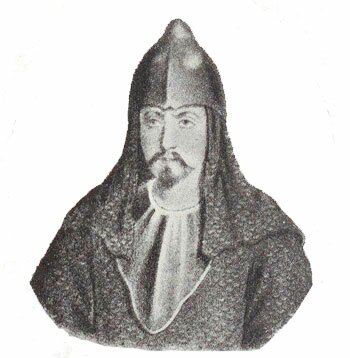
The Oghuzs have played an important role in the political life of Eurasia. In the 11th century, the Oghuz started to advance to Iran and the Near East. This movement was led by the heads of the Kanyk tribe Torgul-bek and Chagry-bek who were grandchildren of Seljuq; the tribes which participated in the movement were named Seljuqs therefore. During the reign of Ali Khan number of people’s revolts against the cruel exploitation had increased. The evidence for this could be found in the epic legend “Oghuzname” (13th century). The Oghuzs were divided into three main tribal groups: the Boi, the Oba, and the Kok. And they, in turn, were subdivided into the Urugs and the Aimaks. The Urugz were generic and family clans. A Yabgu (head of the tribe) divided his possessions in twelve aimaks (areas). The Oghuz state brought the Pechenegs , who were residing between the Volga River and the Urals mountains, under control. In 965, the Oghuz Yabgu and the Kiev Prince Svyatoslav entered into a military alliance and crushed the Khazar Khaganate. The Kiev Prince Svyatosloav Igorevich with the help of the Oghuzs conquered the Khazars, took the capital of the Khazars Sarkel and Itil.
965-1036, the Pechenegs
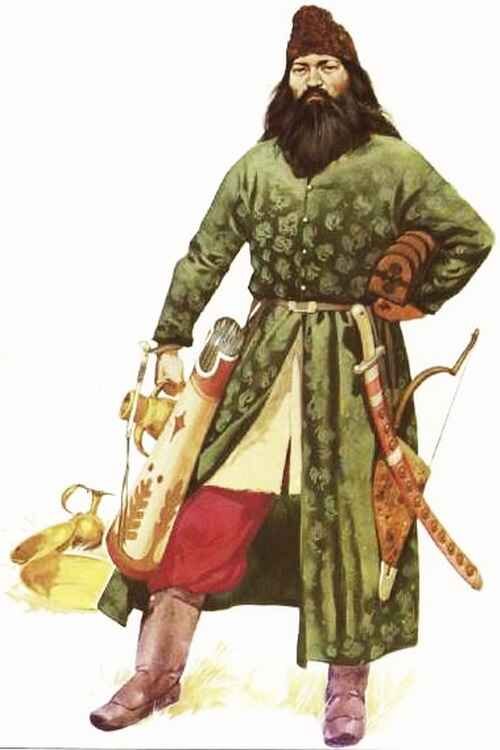
The Pechenegs is the Russian exoethnonim of the Kangar (the Kangly) people who are named in the Arab sources as the Bajanak. At the end of the 9th century, as a result of climate change (drought) in the steppe zone of Eurasia, and under pressure from neighboring tribes of the Kimeks and the Oghuzs, the Pechenegs crossed the Volga River and found themselves in the East European steppes where seven Hungarian tribes had been roaming. Until the year 965, the Pechenegs were under control of the Khazars. After the fall of the Khazar Khaganate, they began an active military expansion. In 968, the Pechenegs besieged Kiev but were defeated. In 970, the Pechenegs participated in the battle of Arcadiopolis on the side of the Kiev Prince Svyatoslav, but after the conclusion of the Russo-Byzantine armistice (July 971) a new conflict started to fester between the Russians and the Pechenegs. In 972, the Pechenegs of the Prince Kuri killed the Great Prince Svyatoslav Igorevich at the Dnieper Rapids; his skull was used to create a bowl as per an ancient tradition. By the 11th century the Pechenegs were pressed by the Cumans, and were forced to roam with the thirteen tribes between the Danube and the Dnieper. Around the year 1010, strife began among the Pechenegs. The Pechenegs of the Prince Tirah converted to Islam, while two western tribes of the Prince Kegen (the tribes were called the Belermanids and the Pagumanids – their number was 20 000 people) crossed the Danube on Byzantine territory under the scepter of Konstantin Monamah and converted to Christianity of the Byzantine model. The Byzantine Emperor was planning to make of them a boundary guards. However, in 1048, huge masses of the Pechenegs (up to 80 000 people) led by Tirah crossed the Danube on ice and invaded the Balkan Byzantium. In 1048, the Western Pechenegs settled in Moesia. In 1071, the Pechenegs played a significant role in the defeat of the Byzantine forces under Manzikert when at the beginning they were on the Byzantine side, and then fled from the battle. In 1091, The Byzantine-Cumans army inflicted a crushing defeat on the Pechenegs at the walls of Constantinople.
985, Campaign of the Prince Vladimir in alliance with the Oghuz to the Volga Bulgaria
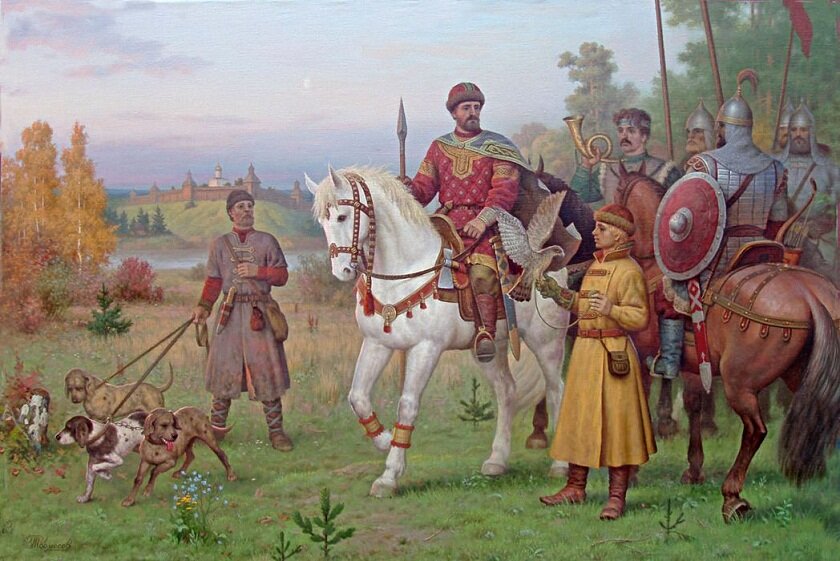
In 985, in alliance with the Oghuzs, Prince Vladimir was at war with the Volga Bulgars who first took the land of Cumans, and then began the territorial expansion. In foreign policy, the Oghuz rulers pursued two goals: take grassland land on the banks of the River Don, and capture the most important trade routes on the Black Sea shore that were linking Europe and Asia through the outskirt of the Volga, Mangistau and Ustyurt.
1055, emergence of Kipchaks on the borders of Kievan Rus

From the second half of the 11th century and until the beginning of the 12th century, the Western Kipchaks (Cumans) have been repeatedly attacking Southern Rus: they devastated lands, robbed cattle and property. The most damaged regions of Kievan Rus were the following principalities: Pereyaslav, Porosye, Seversk, Kievskaya, and Ryazan. Sometimes the Rus bought back hostages from the Cumans. By 1055, the first documented appearance of Kipchaks at the Russian borders occurred.
The 11th century - 1220s, Dasht-I-Kipchak
_tr-RESIZED.jpg)
Until the mid-11th century, the Kipchaks were part of the Kimek tribal alliance. In the middle of the 11th century, they separated from the alliance and headed expansion of Turkic tribes in the territories of the Oghuzs, the Kimeks, and the Cumans. Around 1030, the Kipchaks have reached the borders of Horesm. At the same time the new term occurs – the Kipchak steppe. It is known under name of “Dasht-I-Kipchak”; it was a historical region of Eurasia, the great steppe that stretched from the mouth of the Danube to the lower reaches of the Syrdarya River and Lake Balkash. For the first time the term “Desjt-I-Kipchak” occurs in works of the Persian author Nasir Khosrov in the 11th century when the Kipchaks (the Cumans), coming from the banks of the Irtysh River, by 1030 became neighbors of Horesm and occupied the territory of modern Kazakhstan and South Russian steppes. Starting from 1055, the Kipchaks came to the border with Kievan Rus and by 1090, have reached the borders of the Byzantine Empire taking the place of the Pechenegs. According to al-Nuvajri, the Kipchaks were consisted of many different tribes. In the 13th century, those were the Toskoba, the Jeta, the Burla, the Burjogly, the Burly, the Kanguogly (Kangarogly), the Andogly, the Durut, the Karabarogly, the Dzhuzan, the Karabirikli, and the Kotyan. Ibn Haldun also enumerated eleven tribes of the Kipchaks with small amendments in their names. He named the following tribes: the Toksoba, the Seth, the Burjogly, the Alburi, the Kanaarly, the Ogly, the Durut, the Kalabaaly, the Jersan, the Karabirikli and the Kunun. Under pressure from the Mongolian tribes, a group of the Western Kipchaks (mostly the tribe Durut) under the leadership of Khan Kotyan, moved to Hungary and the Byzantine Empire. Khan Kotyan was killed by the Hungarian nobility, and part of the Kipchaks found refuge in the Balkans. However, the vast majority of the Kipchaks became a part of the Golden Orda. In the 13th century, Dasht-I-Kipchak was conquered by Mongols and it became the core of the Ulus of Jochi (Golden Orda).
1091, battle of Levounion

In 1090, Pechenegs tribes (Greeks called them Skiffs) invaded the Balkan possessions of the Byzantine Empire, and by the year 1091 came to the walls of Constantinople. Byzantine’s positions were complicated by the fact that the Pechenegs were in alliance with the Seljuq fleet of Chah pirate. The Byzantine Emperor Alexius Komnin appealed for help of the Pecheneg’s enemies – Kipchaks – and entered into agreement with Kipchaks’ Khans Bonyak and Tugorkan. The estimated number of the Cumans were 40 000 warriors and judging by the Cuman Khan’s negotiations with the Byzantine Emperor, their number were sufficient to fight the Pechenegs and defeat the Byzantines. Greek-Kipchak army led by Alexius Komnin defeated the Pecheneg army at the walls of Constantinople on 29th April of 1091. After the defeat, the Byzantines killed thousands of the Pechenegs that outraged the Kipchaks. According to the Byzantine Princess Anna Komnina, an entire nation was destroyed in one day.
1092-1220, State of Horesmshakhs
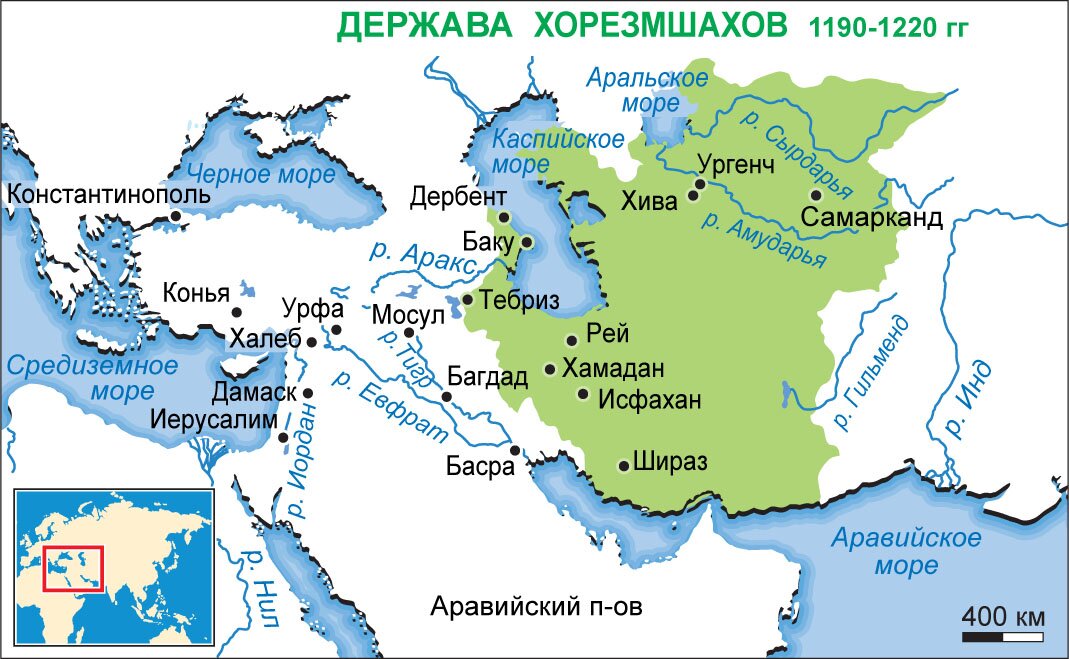
State of Horesmshakhs situated in the lower reaches of the Amudarya River. Starting from 1092, Horesmshakhs were considering themselves as vassals to Seljuqs. In 1097, the mayor of Horesm Akinji ibn Kochkar of Turkic origin announced independence from Seljuqs and declared himself a Shah of Horesm (‘Horesmshakh’ or head of the state). The same year he was assassinated. Seljuqs took Horesm and appointed Qutb ad-Din Mohammed of Turkic tribe begdili as a Horesmshakh. Throughout his reign, he remained a vassal of the Seljuq sultan Sanjar, maintaining loyalty to him. His successor Ala ad-Din Atsyz constantly tried to get rid of the protectorate of the Seljuq sultan Sanjar. In 1138, he rebelled against his suzerain, but Sanjar defeated him and Atsyz was forced to flee. Sanjar announced Suleiman, nephew of Atsyz, as a Horesmshakh. However, Suleiman-Shah was unable to hold on to power over Horesm and in 1141, sultan Sanjar returned Atsyz to the throne. After the defeat of Sanjar in Katvan battle, Atsyz took and robbed Merv in winter of 1141; in 1142, he came close to Nisapur. However, in 1143, sultan Sanjar forced Atsyz to pay tribute while Horesm had to pay tribute to the Karakitais as well. Atsyz continued the policy of collecting lands that had been begun by his predecessors; he attached Jend and Mangyshlak to Horesm. Many nomadic tribes were depending on the Horesmshakh. By the end of his life Atsyz conquered the North Wrst part of Central Asia and actually achieved an independence from neighbors. In 1156, Atsyz died and the throne of Horesm was occupied by his son Taj al-Din Il-Aryslan. Like his father, he paid tribute to the Seljuq sultan Sanjar and the Karakitais. Just a few months after Il-Aryslan came to power, in 1157, Sanjar died that allowed Horesm to completely get rid of Seljuq dependence. In 1160s, Il-Aryslan attached Dihistanared to Horesm. He managed to subdue several cities in Horasan and attempted to conquer part of the cities of Iraq Sultanate and Mawarannahr. In 1172, he successfully defended Horesm from Karakitais’ attack. Soon after Il-Aryslan died, his sons Ala ad-Din Takesh and Jalalabad ad-Din Sultan-Shah began to fight for the throne. The throne was inherited by Takesh’s little brother Sultan-Shah, but Takesh refused to recognize the power of his brother and he sought the assistance of the ancestral enemies’ dynasty – Karakitais – promising annual tribute to be paid to them. With their help, Takesh managed to displace his brother and take the throne of Horesm. Only after the death of Sultan-Shah in 1183, Takesh was able to permanently attach Merv and Sarakhs (1193) to Horesm. In addition to this, Takesh made several attacks on Mawarannahr in an effort to get rid of vassalage from Karakitais. During the reign of Shah Takesh, Horesm became one of the most powerful states in Central Assia. His possessions stretched from the lower reaches of the Syrdarya and the Aral Sea in the North to the Persian Gulf to the South; from the Pamir mountains to the East and to the Iraninan Highlands in the West; during Takesh’s reign he managed to double the territory of his possessions. After death of Horesmshakh Takesh, his youngest son Ala ad-Din Mohammed took the throne and further widened the ownership of Horesm. By 1215, Horesmshakh’s power spread to Horesm, Mawerannahr, Turkmenistan, Afghanistan, Iran, Atrpatakan, Horasan, South Kazakhstan, as well as other areas. In 1219, when Genghis Khan’s troops attacked Horesm, Muhammed II did not dare to give a battle, leaving his army scattered in the towns and fortresses by individual detachments around the State. One by one the following towns surrendered under Mongolian pressure: Otrar, Khujand, Tashkent (Shash), Bujhara, Samarkand, Balkh, Merv, Nishapur, Heart, Urgench, and other major cities of Horesm State. The Horesmshakh first retreated to his Persian territories, then fled with a small detachment to the Caspian region and died on the Abeskun island in the Caspian Sea because of pneumonia. Horesm State ceased to exist.
1125-1211, the Karakitai state
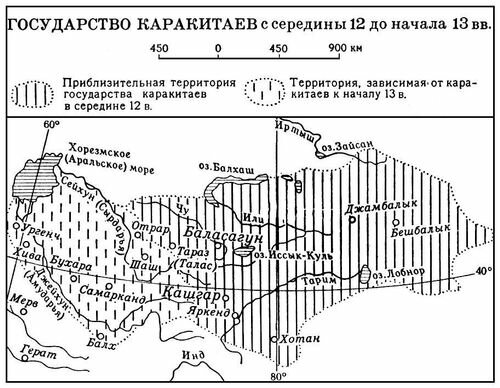
The Karakitai state was an early medieval state that existed in Middle and Central Asia in 1125-1218. It was founded by the Kidan Prince Elui Dashi after the fall of Lyao Empire. Th capital of the state was the city of Balasagun on the banks of the Chu River. The Empire stretched from Amudarya and Balkash to Kunlun and Bayshan hills. In 1211, the state was conquered by Naimans led by Kuchluk. In 1134, Elui Dashi took the city of Balasagun from the Karakhanids making of it his capital. In 1137, the Kidans defeated Western Karakhanid Khanate. In 1141, Elui Dashi took the title of an Emperor. After his death, the power passed to his widow as a Regent for a small son Iliya. Iliya came to the throne in 1151 and ruled for 10 years. After his death in 1161, his younger sister Elui Pusuvan was enthroned and has been ruling till 1177. After killing her husband’s as per her lover’s request, she and her lover soon became the victims of warriors who were made indignant by father of the murdered. The throne was taken by Iliya’s son – Chzhulhu. The Empire was weakened by continuous uprisings and internecine wars that made it easy for Naiman Khan Chukluk to conquer the Karakitai state; Chukluk overthrew Chzhuhlu in 1211.
9th September 1141, battle of the Valley near Katvan
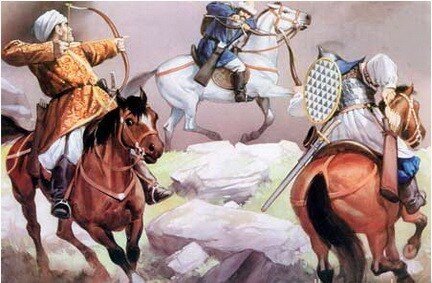
In 1141, a head of the Seljuq dynasty Sanjar started a campaign in alliance with Karakhanids against Karakitais and their allies Karluks; they met near Samarkand. He suffered a heavy defeat by Elui Dashi and fled along with fifteen his horsemen. Shortly thereafter, the founder of the Karakitai state Elui Dashi conquered Mawerannahr and Horesm, and took the title of an Emperor.
1162-1227, Genghis Khan

Temujin was born at the Deluun Boldog Mountain on the banks of the river Onon in the family of Yesugei Baghatur of the Borjigin tribe and his wife Hoelun of the Olkhonut tribe. Year of Temujin’s birth remains still unclear, since the main sources point out at various dates – 1155, 1162, and 1167 – although conventional wisdom is the year 1162. When Temujin was 9 years Yesugei Baghatur proposed his son to Borte, 11 year-old girl from the Ungirat tribe. Yesugei left his son in the bride’s family until Temujin’s adulthood for them to get to know each other; then he left home and on the way back Yesugei lingered in the parking lot of the Tatars where he was poisoned. On his return to his native Ulus, he fell ill and died three days later. After the death of Temujin’s father, Yesugei’s supporters have left his widows and children. The head of the Taujuit clan drove the family from their lands and hijacked all their cattle. Few years widows with children lived in extreme poverty. At the age of 11 years, Temujin became friend with his coeval noble descent from the Jadaran (Jadjirat) tribe – Jamuha who then became the head of this tribe. As a kid Temujin became a sworn brother (‘anda’) with Jamuha twice. A few years later, Temujin married Borte with whom he had been engaged before. Having been held captive by the Taijuit clan he then escaped; Temujin enlisted the help of the leader of the powerful Kereit tribe – Togrul, once a former sworn brother of his deceased father. Temujin began to collect an army around himself. His first nukers were “people of long will” – the Mongols for one reason or another separated from tribal structure of the steppe. Thus, from the beginning of his political activities, Temujin began to build a completely new type of military organization. His army was constructed on the basis of strict military discipline, based on merit and dedication of individual soldiers to him. The principle of blood relationship did not play a decisive role in it. The first serious opponents of Temujin were the Merkits, acting in alliance with the Taijuits. In the absence of Temujin, they attacked the Bordjigins’ lands and took Borte as a hostage (it is assumed that she was already pregnant and was awaiting for the first son Jochi). In 1184, with help of Togrul and the Kereits and Jamuha of the Jadjirat tribe, Temujin defeated the Merkits in the first battle of his life; the battle took place in an interfluve of confluence of the Chikoy and the Khilok rivers and the Selenga River on the territory of modern Buryatiya; as a result of the battle, Temujin got Borte back. In the same period, the second Temujin’s son Chagatai was born (the exact date of his birth is uknown) and the third son Ogodei (October 1186). Temujin created his first small Ulus in 1186 (1189 and 1190 years are also possible) and had 3 tumens (30 000 people) in it. In the same period, the confrontation between former companions and sworn brothers Jamuha and Temujin has started. The rationale for confrontation was due to different views about the role of the State and the authorities of a Khan in life of nomads. Jamuha and his close people who were representatives of the old aristocracy were supporters of the classic nomadic powers – ‘ale’, a conglomerate (union) of tribes united under the rule of a Khan. Khan’s power was largely dependent on his personal attributes (charisma) and was fully implemented in the course of fighting and collection and distribution of taxes. The tribal structure in the state and the army remained intact, which, of course, has made the state a short-lived. Temujin had a different logic of the state structure. Devoid of strong support from relatives, he was building a system based on personal loyalty and personal qualities of his officials and generals. His Ulus, which was unified by iron discipline and absolute power of the Khan, was the basis for the first nomadic Empire – “steppe Rome”. Of course, that conflict with the tribal aristocracy led by Jamuha, was inevitable and could not been smoothed out neither by any personal relationships nor oaths of eternal fidelity by two sworn brothers. In the period from 1190-1206, the fight for the unification of the nomads ruled by one person continued. The contenders were Temujin, Jamuha, Togrul, and the Naiman Khans. In 1200, Temujin and Togrul conquered the Tajuits. In 1201, all Temujin’s enemies united and put Jamuha on the throne with the title of gur-Khan. In 1202, Temujin defeated the Tatars and killed all of their adults except for children with the height below wheel of a cart. In the spring 1203, at Halahaljin-Elet there was a battle between Temujin and combined forces of Jamuha and Togrul Khan. Temujin’s Ulus suffered heavy losses as a result of this battle. In the same year, taking advantage of suddenness, Temujin attacked a feasting headquarters of Togrul and dispelled the Kereit Ulus. With the fall of the Kereits in 1204, Jamuha joined the Naimans with the remaining troops hopinh that Tayan Khan would kill Temujin or vice versa. Tayan Khan recognized Temujin as a sole rival in the struggle for power in the Mongolian steppes. After learning that the Naimans were thinking of the attack, Temujin decided to step against Tayan Khan. However, before the attack he started the reorganization of management of the army and the Ulus. In the early summer of 1204, Temujin’s army started a campaign against the Naimans. Tyan Khan’s army influenced by the insistence of his son, Kuchluk, came into the fight. The Naimans were defeated and only Kuchluk managed to escape to Altai to his uncle Buyuruk with a small detachment. Tayan Khan was killed and Jamuha fled before the fierce battle realizing that Naimans would not win. Temujin, building on the success, stepped against the Merkits and they fell. Tohtoa-beki, the ruler of the Merkits, escaped to Altai where he united with Kuchluk. In the spring of 1205, Temujin’s army attacked Tohtoa-beki and Kuchluk near the Buhtarma River. Tohtoa-beki was killed and his army and most of Kuchluk’s Naimans chased by the Mongols, drowned while crossing the Irtysh River. Kuchluk and his men fled to Karakitais (South-West of Lake Balkhash). There Kuchluk managed to gather the scattered troops of the Naimans and Kereits; he got close to the Karakitai’sgurKhan and became quite significant political figure. Sons of Tohtoa-beki fled to the Kipchaks taking with them their father’s severed head. After the defeat of the Naimans, most of Jamuha’s Mongols passed to the side of Temujin. In the end of 1205, Jamuha was handed to Temujin by Jamuha’s nukers who were hoping to save their lives and gain favor but they were executed by Temujin as traitors. Temujin offered a complete forgiveness and renewal of old friendship to Jamuha but the latter refused and was executed by the noble way without the shedding of blood. In the spring of 1206, at the river-head of Onon at kurultay, Temujin was proclaimed as a Great Khan of all tribes and received the title of “Genghis Khan”. You can find the information about his rule in 1206-1227 under “the rule of Genghis Khan”.
1184-1227, Jochi
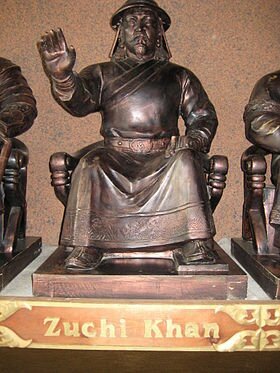
Jochi was the eldest son of Genghis Khan and his first wife Borte of the Ungirat tribe (Konyrat). He was a commander who participated in the conquest of Central Asia and led a detachment in the lower reaches of Syrdarya River. Hereditary lands of his descendants are the Ulus of Jochi (starting from 1224) in the western part of the Mongol Empire which is known as “The Golden Orda” in the Russian historical sources. It is not known who Jochi’s father was as Borte was taken as a hostage by Genghis’ enemies after marrying him; soon after her return from captivity she gave birth to a child. Genghis acknowledged Jochi as his son stating that at the time of capture by the Merkits Borte had been already pregnant. However, the “curse of the Merkits’ captivity” hung on Jochi for a whole life. In 1207, Genghis Khan sent Jochi to lead troops to lands located to the West of Lake Baikal where he wanted Jochi to conquer tribes living in the woods. Tribes of the Oirats and the Yenisey Kyrgyzs recognized the rule of the Mongol Khan without fighting. Genghis Khan praised Jochi for having managed to subdue those people without a fight and granted him the newly acquired lands. Jochi engaged in many campaigns of his father. Jochi’s last years of life passed in a bad relationship with Genghis Khan. Jochi died in the beginning of 1227 being 40 years old. He was buried in a mausoleum in the Karaganda region of Kazakhstan in 50 kilometers northeast of Zhezgasgan. In 1946, the body of Jochi Khan was excavated by Soviet archaeologists. The skeleton was discovered in the tomb without the right hand and hacked skull.
1007-1203, the Kereit state
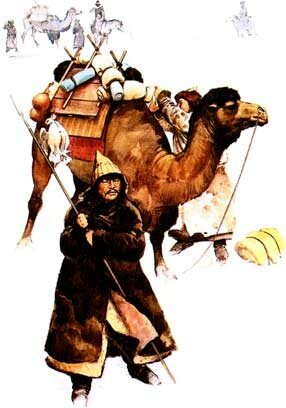
The Kereit state was a country of the Kereits who lived in the modern territories of Transbaikalia and Mongolia in the 10-13th centuries. They had their own religion – Nestorianism. The Kereits had borders with Yenisey Kyrgyzs on the North, with the Mongols in the East, with the Naimans and the Merkits in the West, and with the Tatars in the South. According to the Arab historian Abu-l-Faraj bin Harun, the Kereit Khan turned to the Nestorian Metropolitan of Merv city asking to covert him into the Christian faith together with his people. Upon conversion to Christianity, the Khan was named Marguz (Mergus, Marhus, Marcus, or Mark); a total of 200 thousand people have been baptized. In the 12th century the Kereit state played an important role in the stepped; it led wars with the established Chzhurjen dynasty of Jin in the Northern China. The Kereit Khan Marguz, who had a title Buyuruk Khan, was took as a hostage by Tatars who to the Jin palace where he was executed by nailing to a “wooden donkey”. Marguz has left two sons after him who then dividedthe Kereits into tribes. One of the grandchildren of Marguz - Togrul (Togoril), received the titled of Wang Khan. Initially he was an ally of Genghis Khan but then he fell out with him; Wang Khan was defeated by Genghis Khan and ran away to the Naimans where he then died. The Kererits fell under the rule of Genghis Khan, and since then their independent existence ended.
11th century-1206, the Naiman Khanate
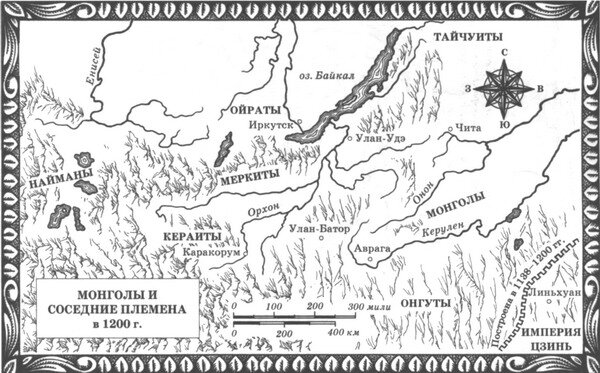
In the 11-12th centuries, the Naiman Khanate was a major Central Asian state association. The Naimans were one of the most powerful nomadic tribes of Mongolia. Their territory extended from the rivers of Tamir and Orkhon to Irtysh River. The Naiman state occupied the lands to the West of Kereits in the modern Western Mongolia and Eastern Kazakhstan. Peaceful relations were followed by periods of hostility with the most strong and powerful trubes such as the Kereit state. After the collapse of the Kidan state in 1125, number of tribal unions occurred on its ruins in Central Asia. Naimans there were a customary law, records management, and written language based on the the Uighur script. By the end of the 12th century, Temujin’s political power has grown and he conquered Naimans in 1206. Naimans fell under the rule of Genghis Khan and became part of his State.
Mongol Empire
1206-1227, the rule of Genghis Khan
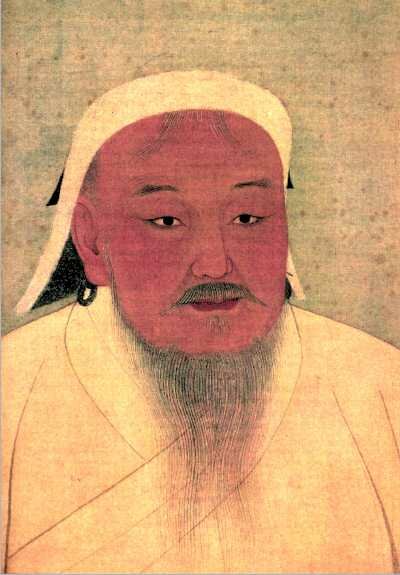
In the spring of 1206, at the river-head of Onon at kuriltay, Temujin was proclaimed as a Great Khan of all tribes and received the title of “Genghis Khan”. In 1207-1211, the Mongols conquered lands of forest tribes, i.e. conquered almost all of the major tribes and peoples of Siberia and the latters were forced to pay a tribute to the formers. Then Genghis Khan stepped against the Tangut Xi Xia State. In 1211, Genghis Khan invaded the Jin Chinese Empire. In the spring of 1214, he returned to Mongolia and made peace with the Chinese Emperor leaving him Beijing. In 1217, in preparation for a Western campaign against Kuchluk, Genghis Khan handed over all his powers and units in China to Muhali Jalair. In 1218, the armies of Genghis Khan invaded the Zhetysu; in alliance with the Muslim rules of the cities of Kailyk and Almalyk they defeated Kuchluk and attached his lands to the Mongol Empire. Before his campaign against the Horesmshakh, Genghis Khan asked for help from Tanguts but got a hard refuse. Genghis Khan harbored a grudge against the Tangut ruler but moved his forces against the Horesmshakh in 1219. In three years (1219-1221), Mohammed Horesmshakh’s kingdom under pressure of the Mongols surrendered; the kingdom extended from the Indus River to the Caspian Sea, i.e. the Mongols conquered the eastern part of it. Horesmshakh’s son resisted the Mongols for another 10 years until he died. After his return from Central Asia, Genghis Khan once again led his army across Western China. According to Rashid ad-Din, in the autumn of 1225, when roamed to the borders of Xi Xia state Genghis Khan fell off his horse and badly bruised during a hunt. By the evening Genghis Khan had a strong fever. Hence, a Board met to discuss a question “whether to continue war with the Tanguts”. In the spring of 1226, Genghis Khan led the army and they crossed the border of Xi Xia in the lower reaches of the Edzin-Gol River. The Tanguts and some allied tribes were defeated and lost tons of thousands people. Genghis Khan let his army to rob the civilian population. This was the beginning of the last was or Genghis Khan. In December, Mongols crossed the Huang He River and came to the East lands of the Xi Xia. Under Linchzhou the Tangut army of hundred thousand people clashed with Mongols. The Tangut army was completely defeated. The way to the capital of the Tangut state was open. In the winter of 1226-1227, the last siege of the Tangut capital started. In the spring and summer of 1227, the Tangut state was destroyed, and the capital was doomed. The fall of the capital of the Tangut state is directly connected with the death of Genghis Khan, who died under its walls in the late summer or early autumn of the year 1227.
1209-1255, Batu
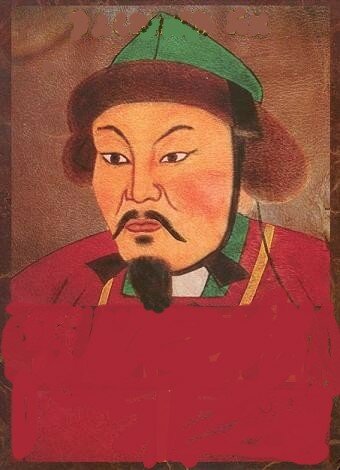
Batu was son of Jochi. According to the division by Genghis Khan in 1124, the eldest son of Jochi, Batu, was given the Kipchak steppes, Horesm, and also Jochi was obliged to conquer the western part of the Dasht-I-Kipchak, Caucasus, Crimea and Rus. Jochi died in 1227 owning only the Asian part of the Kipchak steppes and Horesm. Batu has been active on the political scene since 1230s. In 1236-1243, Batu led the western campaign of all the Mongols as a result of which among conquered lands were – western part of the Dasht-I-Kipchak, Volga Bulgaria, Russian principalities etc. During this campaign Batu’s relationship with Guyuk, son of Ogodei, worsened dramatically. After the death of Ogodei and enthronement of Guyuk, Batu became at risk of dying from the Khagan’s hands. Guyuk started a campaign agaist Batu, but on the way he died. This has changed the balance of power. During interregnum, Batu received support from the children of Tolui and enthroned one of them (Mengu). Upon entrhonement, Mengu tried to reduce the influence of Batu. However, until the end of his life, Batu was de facto co-regent of Mengu controlling all of the western territories of the Mongol Empire.
1210, defeat of the Karakitais by the Horesmshakh
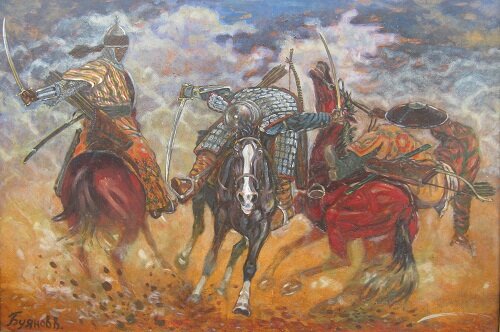
In 1210, Mohammed Horesmshakh started a strong resistance relying on support of Muslim Karakitais who considered him as a liberator. In September 1210, at battle of Ilamish on the Syrdarya River, the Karakitais troops were defeated. In the Muslim world the victory of Muhammad has been hailed as a victory of Islam over “infidels” and thus greatly increased his credibility. In the official documents of Muhammad he was named as the “second Iskander” and “Sultan Sanjar”. On his finger ring it displayed a writing “shadow of Allah on Earth” – that was one of the main titles of the Seljuk rulers.
1211-1218, rule of Kuchluk in the Zhetysu
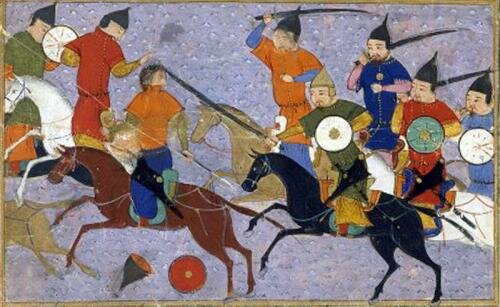
After the defeat from the Mongols, Kuchluk managed to escape to the Zhetysu to the Karakidan’s Gurkhan – Elui Czhulh. The Gurkhan received Kuchluk graciously and married his daughter to him. After defeat of Karakitais from the Horesmshakh, Kuchluk did not come to the rescue of Czhulh but instead captured his Treasury and tried to capture him. However, in the battle near Balasagun Kuchluk has been defeated. The Gurkhan’s army had fought back Treasury but has not returned it to their ruler. As a result of this rebellion the Gurkhan was captured by Kuchluk (1211). Czhulh kept his title but the real power in the country belonged to Kuchluk. In 1213, Czhulh died and Kuchluk was proclaimed a Gurkhan. Then Kuchluk made a religious prosecution of Muslims who constituted the majority of population in the state. In 1215, Kuchluk besieged the Almalyk city where the ruler recognized power of the Mongols. In response, Genghis Khan sent twenty thousand of Jebe noion’s troops against Kuchluk. Upon arrival to the Karakitais state, Jebe proclaimed a religious freedom and Muslims began to kill Kuchluk’s troops based in the cities. Kuchluk fled but was caught and beheaded in the Pamir Mountains.
1219-1224, the conquest of Kazakhstan and Central Asia by theMongols

Genghis Khan agreed with the Horesmshakh on the good trade relations. Soon, Genghis Khan sent his first merchants to the state of Horesmshakh. Accused of spying, they were captured and killed by Inalchik Kair Khan, the Governor of Otrar, who was a cousin of Terken-hatun. It has become a convenient excuse for the grand campaign of the Mongol army. In the autumn of 1219, Genghis Khan moved his army from the banks of the Irtysh River to the West. In the same year he invaded Mawerannahr. There were two opinions among population of Horesm how to resist the army of Genghis Khan. The first inclined to battle with them in open combat. The second relied on their fortress walls and offered to host the garrisons on fortresses. Second opinion prevailed, although they underestimated the siege skills of the Mongols. In September of 1219, the Mongols laid siege of Otrar and soon as a results of the treachery of some Horesm generals, Otrar was taken and Kair Khan was killed. In 1220, the Mongols took Syganak, Uzgend, Barchlygykent, Jend, Yangikent, Benakent, Balkh, Buhara, and Samarkand. At the beginning of 1221, the capital of Horesm, Urgench, was taken by the Mongols. THE Horesmshakh escaped to one of the islands in the Caspian Sea where he died in February of 1221. Actually, the conquest of Central Asia was completed in 1221; however due to the fact that the campaign of Subutai and Jebe finished only in 1224 – this year is considered as the formal year when the Central Asian campaign was over.
1219-1220, the siege and destruction of Otrar
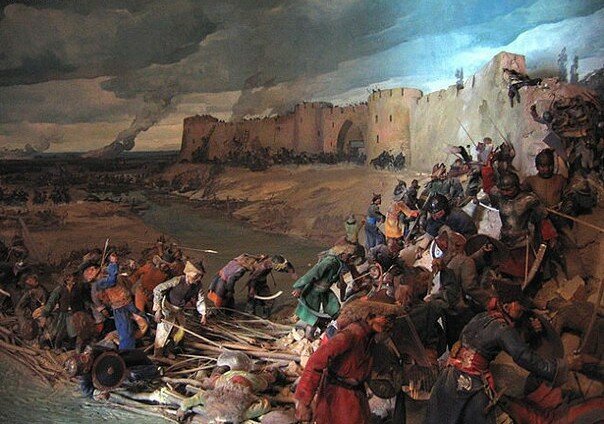
The first blows of the Mongols had been inflicted on cities of Syrdarya River basin. In September of 1219, part of the Mongol army led by Chagatai, Ogodei and Subedei, laid siege of the city of Otrar – one of the major centers of Turkestan. Two months after the start of the siege the Mongols were able to cut off the source of drinking water. Soon, food stocks were exhausted in Otrar. The city has experienced great distress, the fortress was destroyed, and many neighborhoods were ransacked, but the city continued to live. Unable to bear this, part of the Otrar garrison (10 thousand people) led by Karacha Kajip, surrendered to the Mongols. Two months later the Citadel of Otrar was taken and Kair Khan was taken prisoner. Overall, the siege of Otrar lasted for seven months. Otrar was destroyed and Kair Khan was taken to Genghis Khan where he was executed.
1220, the siege and capture of Syganak

Other cities of Turkestan were conquered by Jochi Khan subsequently – Syganak, Uzgend, Barchynkent, Ashnas, Jend, Yangikent, and others. Jochi’s troops, who carried out raids on the Syrdarya River, arrived to Syganak in the spring of 1220; Jochi began negotiations with the city’s residents. A Muslim merchant Hasan-haji was sent by Jochi to persuade the population of Syganak to surrender without a fight but “villains, mobiles and tramps” rebelled and slayed the traitor; they were preparing for the “great holy war”. The Mongols have been besieging the city for seven days and nights without a stop; they finally took it by rush and “closing the gates of mercy and charity” killed the entire population of Syganak. Hasan-haji’s son was appointed as a Governor of the city.
1220-1224, the Reid of Jebe and Subutai

In 1220, Genghis Khan allocated three tumens (30 thousand people) to chase after Mohammed Horesmshakh; after the death of the latter, he organized a campaign against states of the Caucasus and the Kipchaks. At the beginning of the campaign to the Caucasus, there were 2 tumens (20 thousand people) led by Subutai and Jebe. Breaking forces of Caucasian rulers Mongols met with a coalition of the Kipchaks and the Alans. Subutai managed to split the coalition in fact by bribing the Kipchaks. Smashing the Alans, the Mongols defeated the Kipchaks. The latters fled to the Kipchak Khan Kotyan. Kotyan called for help of the Russian Princes, but in the battle on the Kalka River the Russian Princes were defeated by the Mongols. During the return to the East, the Mongols were defeated in Volga Bulgaria in the end of 1223 or the beginning of 1224. According to Ibn al-Asir, only four thousands of the Mongols survived. Through Saksin that was located on the lower Volga, they moved to the eastern Dasht-I-Kipchak where they joined the army of Jochi.
1223, battle on the Kalka River
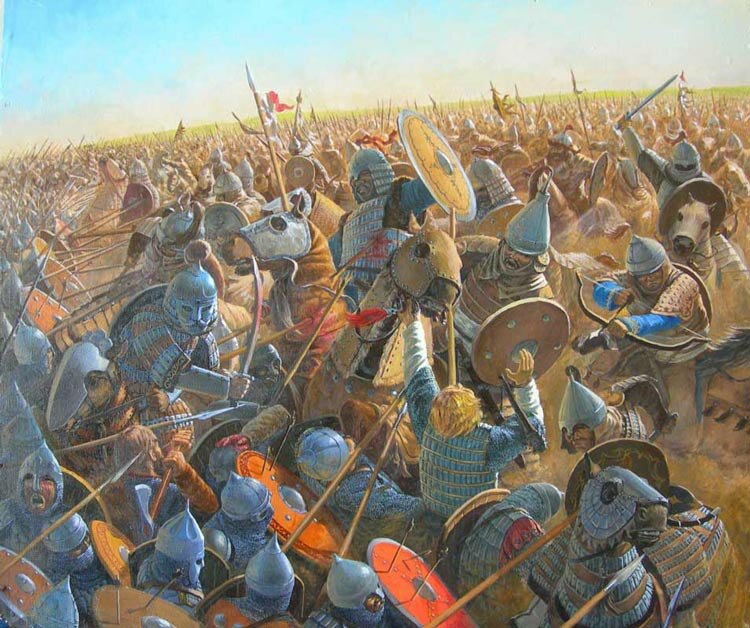
At the beginning of 1223, the Prince Congress was convened in Kiev; it decided that the forces of Kiev, Galich, Chernigov, Seversk, Smolensk, and Volyn principalities should support the Kipchaks and Kotyan-Khan against the troops of Jebe and Subutai. The Mongol envoys suggested the Russians to step against the Kipchaks but Mstislav killed the ambassadors. On 31st of May 1223, the Mongols defeated the Russian Princes and the Kipchaks.
1124-1503, the Ulus of Jochi
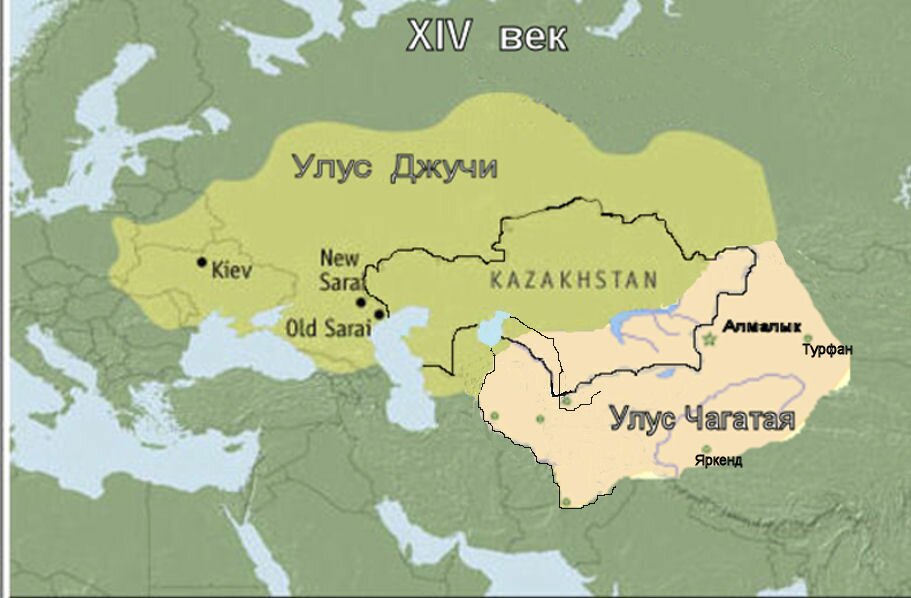
History of creation of the Ulus of Jochi began in 1207. According to the “Innermost legend”, in this year Jochi led a campaign for which he got the conquered lands. According to the medieval Mongolian hereditary right, eldest sons were getting the most distant possessions during the lifetime of their father, while the younger children were getting lands of “indigenous yurt”. Jochi conquered the most remote lands. However, soon the Empire began a violent expansion to the West. In 1221, the Ulus of Jochi acquired Horesm and lands to the west of it that were mainly inhabited by the Kipchak tribes. Around the year of 1224, Genghis Khan officially divided the lands among his sons, brothers, and nephews. It was at this time when the status of the Ulus of Jochi was formalized. The Ulus of Jochi (autonym in Turkic language is Ulug Ulus or “The Great State”; in Russian – The Golden Orda). In the period from 1224 to 1269, it was a part of the Mongol Empire. Starting from 1263, the Ulus of Jochi actually gained independence by winning the war with Hulagu. Starting from 1313, the official religion in the Ulus of Jochi has been Islam. By the mid-15th century, the Golden Orda has been disintegrated into several independent Khanates; its central part that was nominally acknowledged as the major one – The Great Orda – ceased to exist in 1503.
1227, Jochi’s death

In the last years of his life, Jochi had a very strained relationship with his father. The reason for this was not performing orders of Genghis Khan. Father ordered him to conquer territory in the West at the time when Jochi did nothing. Also, the systematic absence of Jochi at khuriltais, for different reasons, gave suspicious Genghis Khan food for thought. As a result, Jochi died at the beginning of 1227. There are two version of his death: 1) he died on the hunt; this is a very popular version in the people and even the kyui “Aksak-kulan” has been composed on Jochi’s death; 2) Jochi was killed by his father’s order.
1227-1250s, a joint ruling of Batu and Orda-Edjen in the Ulus of Jochi

After the death of Jochi, his two sons Batu and Orda-Edjen were called to Khagan where they were appointed as co-rulers of their father’s territory. This joint ruling continued until the deal of Orda-Edjen. Although after the Western campaign of Mongos Orda-Edjen had much less of subservient territories and armies. Guyuk Khan and later Mengu openly or secretly supported the ambition of Orda-Edjen against Batu. After the death of Orda-Edjen, his children were not pretending for a joint ruling with descendants of Batu but only headed the eastern wing of the Ulus of Jochi.
1227-1229, the Regency of Tolui, son of Genghis Khan
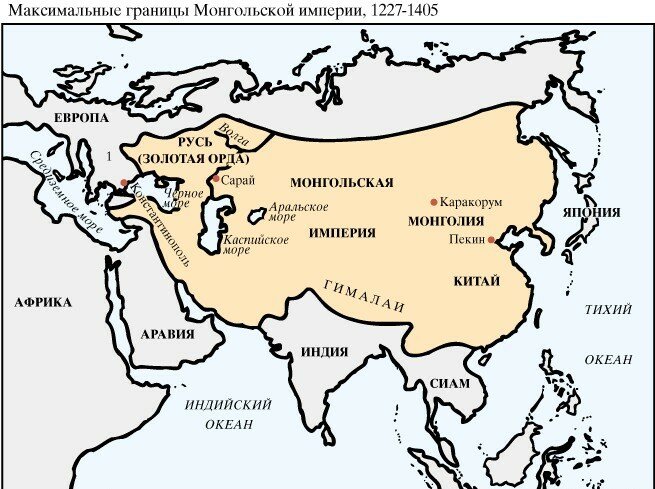
Tolui was the fourth son of Genghis Khan and Borte. After the death of Genghis Khan, Tolui inherited the native lands of his father and got in control all armies of the latter until a khuriltai would select a Khan of the Mongol Empire to whom Tolui would be obliged to pass on all troops. At the first time Tolui was busy organizing the funeral of his father, who died in a campaign against the Tanguts in 1227. In 1229, the khuriltai elected (to be more precise, approved) Ogodei as a Khan of the Mongol Empire; Ogodei was legitimate heir of Genghis Khan according to the testament. Tolui handed him his power, keshektins (the khagan’s guard) and sworn allegiance to Ogodei.
1229-1241, the rule of Ogodei
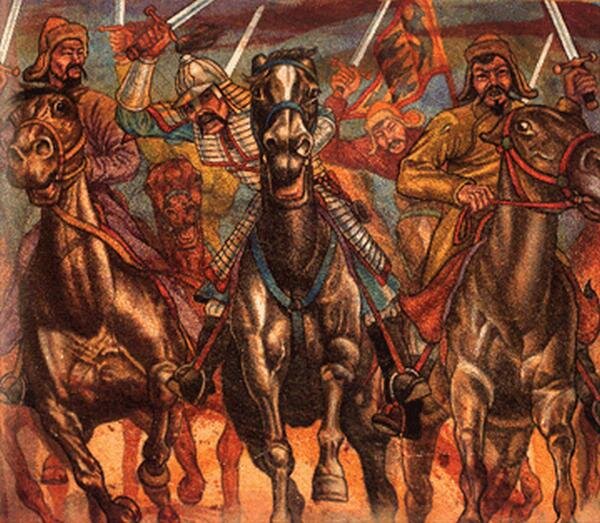
Ogodei was the third son of Genghis Khan and Borte. He continued father’s aggressive expansion of the territories. Just upon taking the throne, Ogodei sent two detachments of thirty thousand troops each to Iran and Nothern Caspian territories to conquer the peoples living there. Churmagun’s army defeated Jelal ad-Din and conquered the Transcaucasia. By 1234, Ogodei’s army completed the conquest of the Jin Empire. The entire North China was in hands of Mongols. Number of campaigns has been initiated against the Goryeo kingdom during Ogodei’s reign; the result was that the Goryeo’s king expressed his obedience to the Mongolian Khan in 1238. In 1235, on a kurultay Ogodei initiated the Western Campaign of 1236-1242 that was a massive hike to the West. As a result of this campaign among conquered territories were Volga Bulgaria, western Dasht-I-Kipchak, Poland and Hungary which were devastated. The Mongolian troops reached the Adriatic Sea. During the reign of Ogodei, Ueli Cucai became Ogodei’s adviser who brought the theses that “you can build your Empire on the horse, but you cannot manage it on a horse”. During the rule of Ogodei, four large-scale reforms were carried out: 1) a reform of military conscription for sedentary peoples when the number of recruits people from sedentary peoples became less in percentage terms; 2) a postal service was organized; 3) census of population was conducted; 4) the tax system was improved. Also, during Ogodei’s reign construction of Karakorum, capital of the Empire has been finished. Ogodei died on 11th of December, 1242.
1236-1242, the Western Campaign of the Mongols
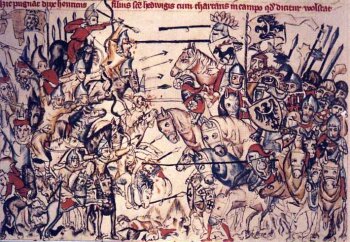
In 1235, on a khuriltai Ogodei initiated the Western Campaign for conquering the Kipchaks and their allies. The following groups took part in the campaign: children of Jochi – Batu, Orda-Edjen, Shiban, and Berke; Chagatai’s son Baidar and Chagatai’s grandson Buri; Ogodei’s children Guyuk and Kadan; children of Tolui Mengu and Buchek and also the youngest son of Genghis Khan Kulkan; generals Subutai and Burundai. In 1236-1237, the Mongols waged war in the Volga region against the Volga Bulgars and their allies. Part of the Bashkirs and the Mordvins became allies of the Mongols and merged with their army. In 1237-1238, the Mongols invaded the Russian principalities. In 1238-1239, the Mongols conquered the remaining Kipchaks, the Alans, and the Cherkes as well on the Crimea peninsula. In 1240, after the army was topped up and some of its parts were withdrawn, the Mongols resumed military actions. The Mongols took the Kiev, the Galich and the Volyn principalities. In 1241, parts of the Mongol army carried out campaigns in Poland and Moravia. Most of the Mongol army went to Hungary, where it managed to crush the Hungarian King; in a pursuing of him, the Mongols reached Croatia and the Adriatic Sea. In December 1241, Ogodei died and in March 1242, the Mongol troops began the way back.
1241-1246, the Regency of Torakina, Ogodei’s widow

Tarakina was the second wife of Ogedei and mother of Guyuk. She was a regent in the period between reigns of Ogodei and Guyuk. Tarakina was a granddaughter of the Merkit chieftain – Genghis Khan’s enemy. Before his death, Ogodei appointed his grandson Shiramun as successor but Torakina managed to prevent this. Tarakina’s Regency is characterized by a large degree of disintegration of the central power and the high level of political intrigues. In 1246, the khuriltai elected Guyuk as a Khan and Torakina with her henchmen were removed from making important political decisions.
11th April of 1241, the battle on the Shayo River
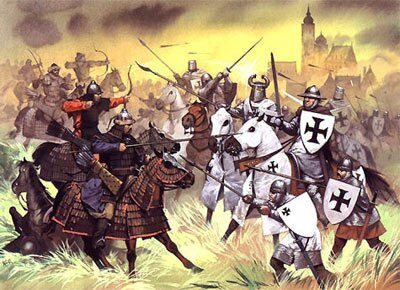
The battle on the Shayo River was between King Bela and Croatian Duke of Koloman on one side and the Mongolian troops led by Batu, Shiban, Kadan, and Subutai on the other side. Army of Hungarians had twice as many troops than the Mongol’s army. Batu was inclined to avoid battle but Subutai insisted on it. The Hungarian-Croatian army was chasing the Mongol’s advance detachment for six days and on the seventh day they camped in the Mohi valley on the Shayo River. At night, the main forces of the Mongol army led by Subutai crossed the river on the left wing, bypassing Hungarian camp from the south; another part of the Mongols (led by Batu and Shiban) captured the bridge across the river edging out Hungarian protective detachment. In the morning the Mongols began shelling Hungarian camp located in the valley from surrounding hills by bows and catapults; then the Mongols broke in the camp. However, they did not close the circle. Hungarian army had fled and the Mongols have been gradually destroying them during the chase over six days; together with the fleeing Hungarians the Mongols broke into Pesht. The death of troops made the Hungarian lands vulnerable to the Mongols.
1246-1248, the rule of Gayuk, son of Ogodei
.jpg)
Gayuk was elected as a Khagan in autumn of 1246. He cancelled all orders of his mother’s Regency times; he also executed Torakin’s henchmen Abd ar-Rahman and Fatima. Chinkai and Mahmud Yalavach were restored in their positions. Gayuk probably planned the conquest of the Middle East, where the vicar Baiju was replaced by Gayuk’s ally Eljigedei. However, the primary issue was to deal with his main opponent- Batu. At the beginning of 1248, an army led by Gayuk moved to the Ulus of Jochi. Batu was warned of this by Tolui’s widow Sorhahtani, so he moved with his army to meet Gayuk. However, the first civil war of Genghis’ descendants did not happen as Guyuk unexpectedly died reaching only up to Mawerannahr. The most common version is that Gayuk was poisoned.
1248-1251, the Regency of Ogul-Gaimysh, Gayuk’s widow

Ogul-Gaimush was the wife of Gayuk and came from the Merkit tribe. After the death of Gayuk in April 1248, Ogul-Gaimysh ordered to deliver a coffin with his body to the Emil River where his headquarters were located. Batu, being the eldest descendant of Genghis Khan, proposed to organize a khuriltai in Alakamak (on the week way from Kayakyk) where he was at that moment. Ogul-Gaimysh was to temporarily govern the state with the support of Chinkai and other advisers. Since Khatun spent most of her time with shamans, each of her sons like other Princes was unilaterally issuing orders. Affairs in the state came in a mess. Meanwhile, the khuriltai gave its preliminary approval for the election of Khan Mengu, but sons of Ogul-Gaimysh believed that the power should belong to the house of Ogodei; they carried out an assassination attempt on him but with no success. Together with Ogul-Gaimysh they were convicted. In 1252, by order of Mengu she was tortured and sewed into the felted cloth, and then thrown into the water.
1251-1259, the rule of Mengu, Tolui’s son
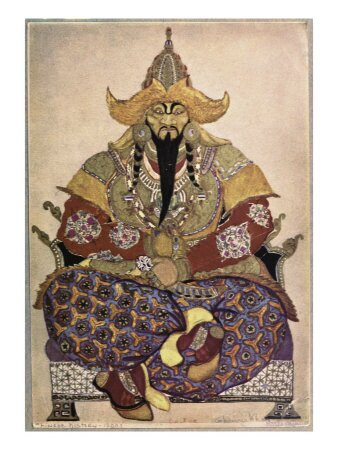
At the beginning of 1251, descendants of Tolui backed by Joshi’s descendants organized a khuriltai in Karakorum; it was intended to proclaim Mengu as a Great Khan. Batu sent his brother Berke with the army in order to support Mengu. In addition, Mengu’s mother, Sorhahtani, has managed to attract Belgutei (brother of Genghis Khan), who enjoyed a great respect and Uryanhadai (Subutai’s son), who had a huge influence in the army, to Mengu’s side. Even part of noions from the side of Ogodei’s and Chagatai’s descendants took part in the khuriltai; Kadan, Ogodei’s son, who participated in the Western Campaign, was among them. Ogodei’s descendants’ attempts to resist failed. After coming to power, Mengu issued decrees on campaigns to China and Iran. He participated in the campaign to China himself with his brother Hubilai; the campaign to Iran was led by his brother Hulagu. Mengu died during the siege of the Chinese fishing town Hezhou on the site of modern Chongqing, which was owned by the Southern Song in 1259.
1255-1256, the rule of Sartak in the Golden Orda

Sartak was son of Batu. He secretly professed Christianity. After the death of Batu in 1255, Sartak was appointed by Mengu as a ruler of the Ulus of Jochi. However, on the way home he was poisoned. According to one version, he was poisoned by Mengu, since Mengu pursued a policy of centralization and wanted to appoint as a ruler of the Ulus (similar to the Ulus of Chagatai) a child led by the Regent. According to another version, Sartak was poisoned by his uncle Berke.
1256-1259, the rule of Ulagchi in the Golden Orda
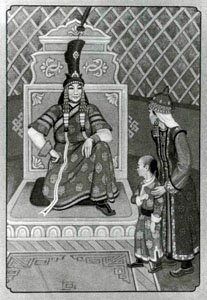
Ulagchi was appointed by Mengu-Khagan as the ruler of the Ulus of Jochi. He was accompanied by Batu’s widow Borakchin as the Regent. In 1257, Ulagchi was visited by Alexander Nevsky with his borther Andrey, who were forgiven for the anti-Mongol activities.
1258, Burundai’s campaign against Poland and Lithuania
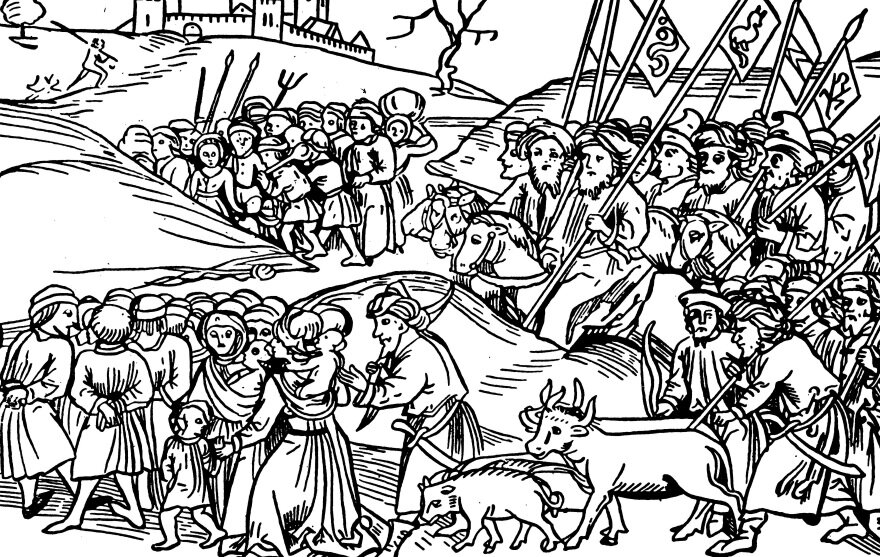
In 1256-1257, Burundai of the Kiyat tribe was appointed to replace Kuremsy on the western frontiers of the Ulus of Jochi. In 1258, the Lithuanians harried the principality of Smolensk and came to Torzhok without encountering resistance from Alexander Nevsky who was at that time in the Orda together with other Princes of North East Rus. Burundai told to Daniil about the campaign against Lithuania and ordered to join him. Daniil sent the help with his younger brother Vasilko and troops. After defeating the Lithuanians, Vasilko handed part of the plunder (“saigat”) to Burundai. A year after Burundai led a campaign against Poland and took Lublin. Through Vasilko and Lev, Burundai promised safety to residents of Sandomir in the event of termination of the resistance, but did not keep his word: the Mongols have been slaughtering and drowning people in the Vistula River. It is usually considered that the outcome of these campaigns was establishment of protectorate in the Galish-Volyn principality.
1258, capture of Baghdad by the Mongols; collapse of the Abbasid dynasty
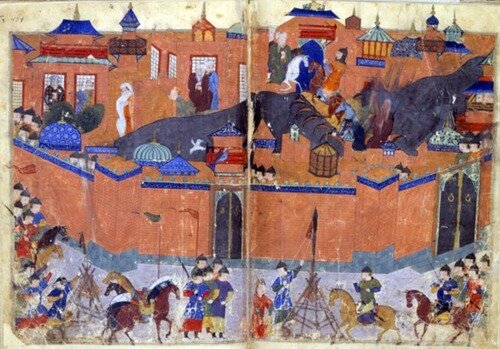
Prior to the siege of Baghdad, Hulagi conquered the Iranian Ismails-Nizarits (known as “assassins”) by taking the impregnable Alamut castle without a fight in 1256. Then, in 1257, Hulagu wended to Baghdad. Mengu ordered Hulagu to spare the Caliphate if it would reign to the Mongols. Upon approaching Baghdad, Hulagu demanded surrender but Caliph Al-Mustasim refused. Hulagu made part of his army to cross the Tiger River and took the city in “jaws”. The Caliph’s army managed to repel the Mongols in the west but the next attack of the latter killed it. The Mongols lured the Caliph’s troops into a trap in the lowlands and destroyed the dam water constraints. Many soldiers of the Caliph drowned. On 29th of January, Chinese engineers surrounded the city by a palisade and began constructing siege artillery and catapults. The Mongols led an assault in their usual style and by 5th of February, captured part of the wall. Al-Mustasim’s offer of negotiations was rejected. On 10th of February, Baghdad surrendered. On 13th of February, the Mongols entered the city, and Hulagu let his troops to plunder it. The Caliph was prosecuted.
1259-1262, absence of a ruler in the Golden Orda
.jpg)
In 1259, the Golden Orda actually came to the anarchy. This was due to the subsequent deaths of Ulagchi and Mengu. Hence, the political crises began in the Ulus of Jochi. A Khagan could not appoint the ruler of the Orda due to the fact that a Khagan himself had not been elected yet. The rally of aristocracy was unsuccessful, since Borakchin’s candidacy (she was nominating a small Tuda-Mengu) as a Regent did not satisfy descendants of Jochi and their Emirs. As a result, the local khuriltai did not enthrone anyone in the Ulus of Jochi. Borakchin had tried to appeal to Hulagu, but due to the fact that it became known to all she was caught and executed after the trial. This anarchy prevailed until the invasion of Hulagu when an informal leader (Berke), who had no rights for the throne of the Ulus of Jochi, came to power.
1260-1269, civil wars in the Mongol Empire
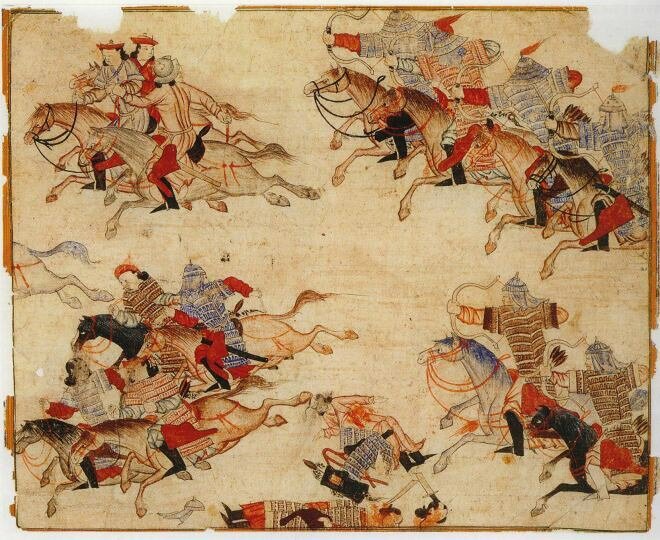
The disintegration of the Mongol Empire started in 1260. Starting from that year, the Mongol Empire has been torn apart by internecine wars. After the death of Mengu, a fight for supreme power between his brothers Kublai and Ariq Boke started. In 1260, Kublai was crowned as a Great Khan at the khuriltai in Kai Pin. Ariq Boke was also crowned in Karakorum. These khuriltais were illegitimate, as the majority of Chingizids (descendants of Genghis Khan) were absent at both Kublai’s and Arig-Buga’s khuriltais. Jochids (descendants of Jochi) were initially supporting a candidacy of Ariq Boke. Kublai was trying to split the Ulus rulers. Kublai promised to Hulagu that he’d be given the conquered lands. After ruminating, Hulagu decided to support Kublai, and also at the invitation of Boarkchin he dared to invade into the possessions of Jochids. After the defeat at the Terek River, Hulagu retreated. Berke became the de facto ruler of the Ulus of Jochi but he has not taken a title of a Khan. In fact the disintegration of the Mongol Empire started because of the Talas khuriltai when the rulers of the Uluses of Jochi (Mengu-Timur), Chagatai (Barak), and Ogedei (Haidu) formed an alliance and pledged to help each other. Mengu-Timur, Barak, and Haidu took the title of a Khan that had been previously taken by the rulers of the Mongol Empire only. Therefore, their Uluses got a formal independence when in fact they had been independent since the beginning of 1260s.
1260, the battle at the Ain-Julat against the Egyptian Mamluks; defeat of Kit-Buqa-Noion
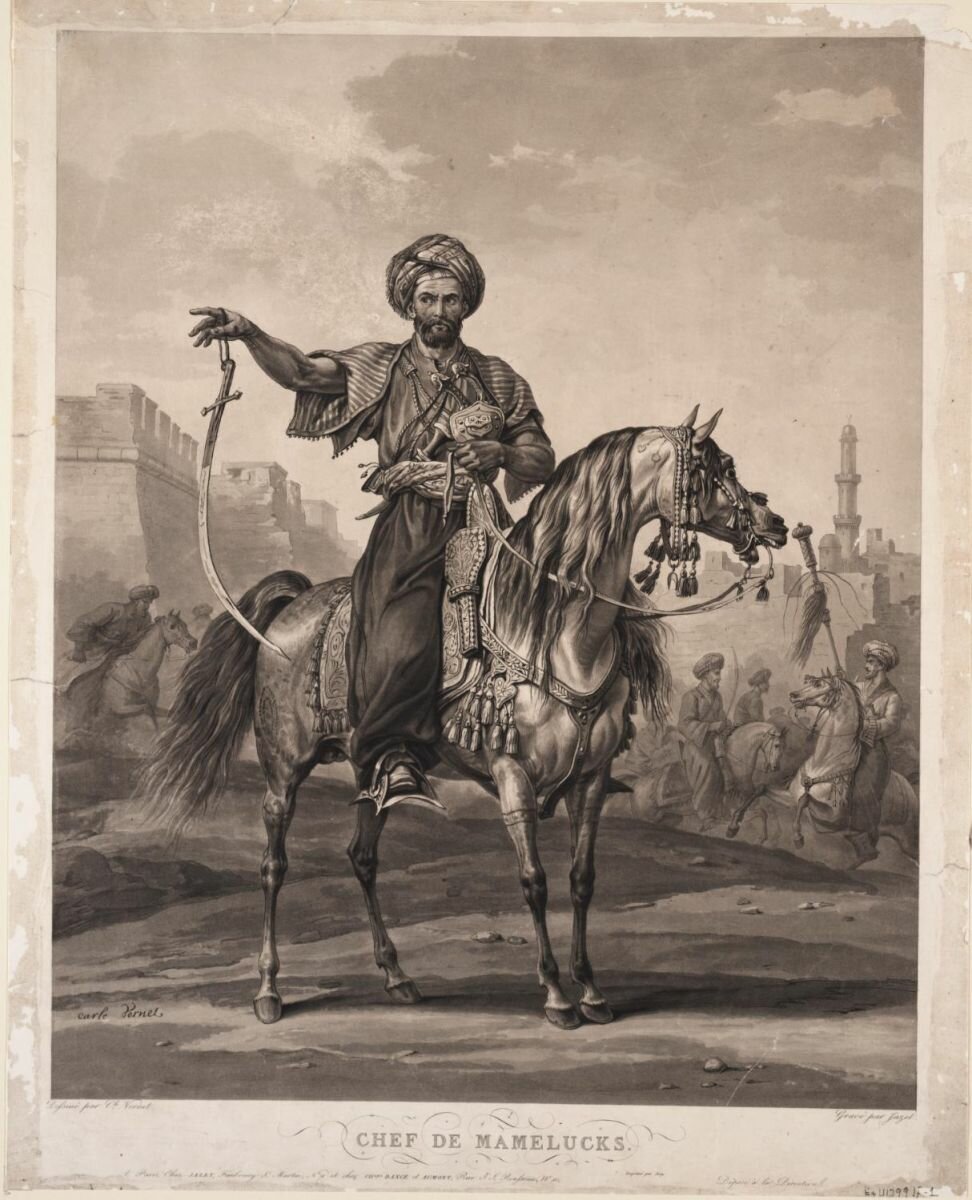
After the death of Mengu, Hulagu withdrew most of his forces to Iran, while a 10-thousand corps of the Mongols, under the leadership of Kit-Buqa, invaded Syria and captured Damascus. On 3th of September 1260, the Mamluks and the Mongols converged at the Ain-Julat. The Mongol army had a few Georgian and Armenian troops among its warriors. The battle began with the attack of the Mongolian cavalry. Baibars’ false retreat lured Kit-Buqa to a trap where the latter was attacked by the Mamluks from three directions. The Mongol army was defeated; Kit-Buqa was taken prisoner and was executed.
1262-1266, the rule of Berke
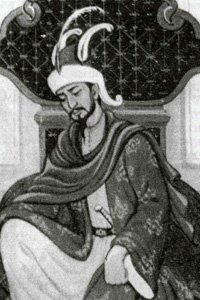
Since the year of 1262, Berke was the ruler of the Ulus of Jochi; he was the son of Jochi and Sultan-hatun who was the daughter of Muhammad Horesmshakh. Since his childhood, Berke was brought up by his mother in the spirit of the Muslim religion. In the period of a ruler’s absence in the Ulus, Berke was participating in the work of the khuriltai, which failed to elect a ruler of the Ulus of Jochi. After the deaths of Jochids in Hulagu’s army, one of the relatives of the deceased, Nogai, invaded into Iran but was defeated. Hulagu’s army invaded into lands of the Ulus of Jochi. Berke has declared full mobilization and this helped to defend the independence of the Ulus of Jochi; hence, he became the informal leader and the ruler of the Ulus of Jochi. Berke fought Hulagu and his heirs, not having reached any tangible results. In 1266, Berke died.
1263, the battle on the Terek River
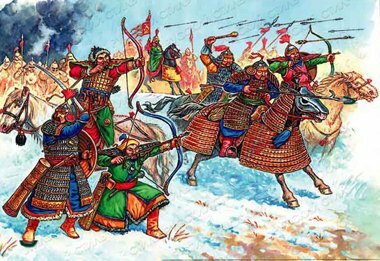
Due to the anarchy and lawlessness in the Ulus of Jochi, it was unclear who would be the ruler of the Ulus of Jochi after Ulagchi’s death. Borakchin, the former Regent during Ulagchi’s reign, sought to retain power by the enthronement of her grandson Tuda-Mengu; however Tuda-Mengu’s uncles (children and brothers of Batu) have not agreed to it. Borakchin fearing so much opposition has offered Hulagu to the throne of the Ulus of Jochi. However, her messages to Hulagu were intercepted and she was captured and executed for treason. In 1262, Hulagu decided to invade the Ulus of Jochi and prior to this he executed three of Jochids in his army; Hulagu led his troops to the North. At the end of 1262, Hulagu’s forces crossed the Terek River and took the camp and troop transports of Nogai. Berke organized a counter-attack and on 13th of January 1263, there was a battle on the Terek River. Hulagu’s army was defeated, and many soldiers fell thorough the thin ice of the river during the retreat. Losses on both sides so great that Berke, according to Ibn Vassil, exclaimed: “Let Allah shame Hulagu for killing the Mongols by swords of the Mongols. If we had worked together, we would have conquered the whole Earth”. Victory in this battle has cost dearly.
1266-1282, the rule of Mengu-Timur
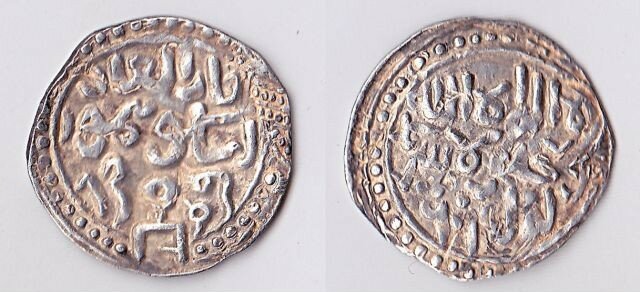
After Berke, in 1266, Mengu-Timur came to power; he was the son of Tukan and the grandson of Batu. Mengu-Timur was a rightful heir of childless Berke. At the beginning of his reign, Mengu –Timur fought with rebels. Upon enthronement, Mengu-Timur granted the Ulus of Shiban to the latter’s son Bahadur; Crimea was given to Uran-Timur, son of Tuka-Timur. In 1269, Mengu-Timur was proclaimed a Khagan (Khan) and began to mint coins with his name and tamga. Mengu-Timur allowed the Genoese to settle into Kaffa, which has rebounded the Crimean trade and increased the value of the peninsula and its capital city of Solhat. He ordered a census that was held in Rus. During Mengu-Timur’s reign, the Ulus of Jochi became independent as a result of the Talas khuriltai where rulers of three Uluses (the Ulus of Jochi, the Ulus of Chagatai, and the Ulus of Ogedei) concluded a legal disintegration of the Mongol Empire. Mengu-Timur’s uncle Berkechar was participating in the Talas khuriltai on his behalf. Mengu-Timur made raids on Byzantium (c.1269-1271), Luthuania (1274), and in the Caucasus (1277) against the Alans. The Russian Princes were participating in the campaign into the Caucasus; they were getting part of the plunder. On Mengu-Timur’s behalf the first survived tag on the release of the Russian church to pay tribute to the Golden Orda was published. During Mengu-Timur’s reign, the Genoese colony Kaffa was founded.
The Golden Horde
1269, the formal independence of the Goldan Orda from the Mongol Empire
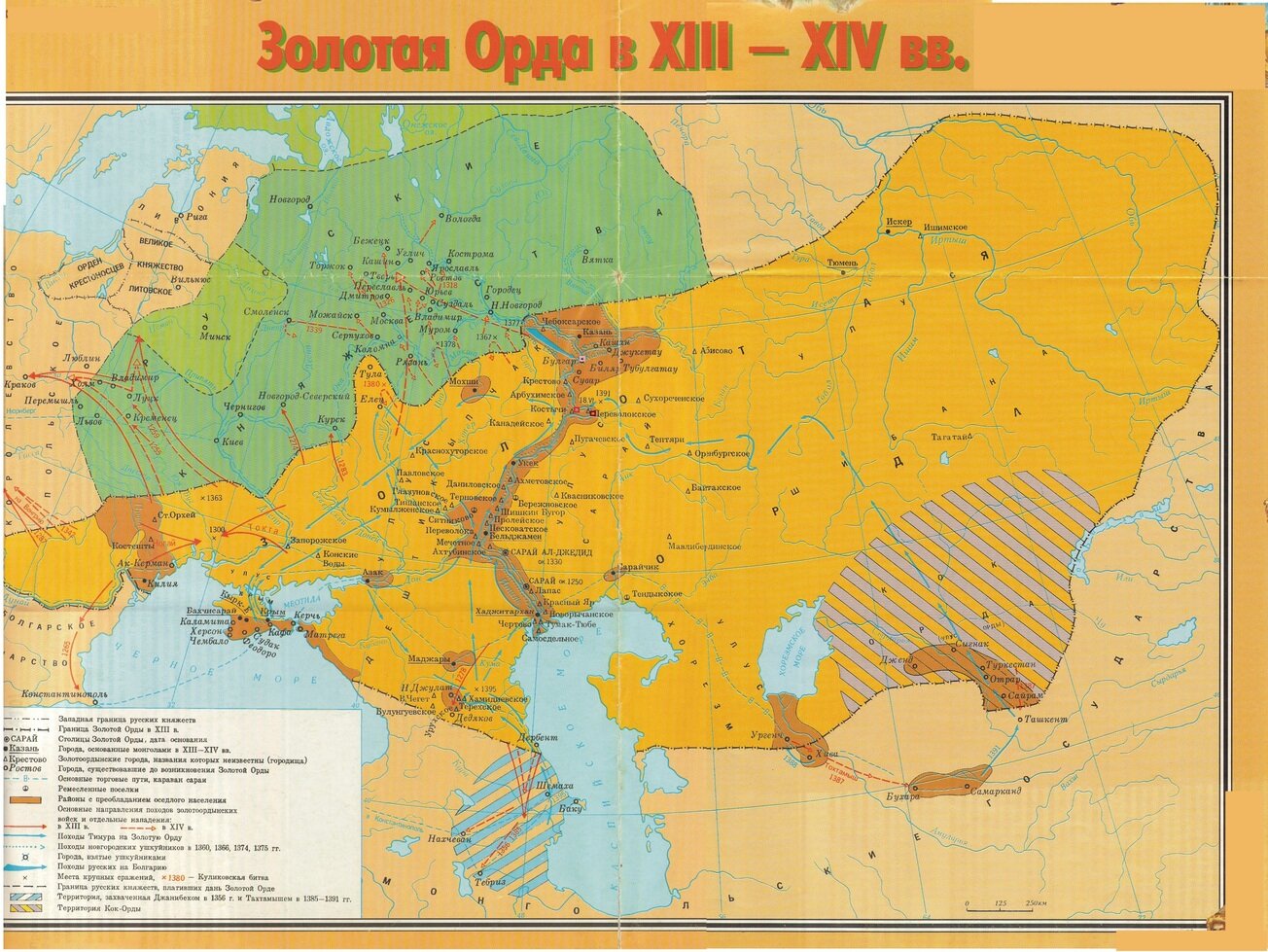
Mengu-Khan took a Khan title. In 1269, in the Talas khuriltai the rulers of the Uluses of Jochi (Mengu-Timur), Chagatai (Barak), and Ogedei (Haidu) formed an alliance and pledged to help each other. Mengu-Temir, Barak, and Haidu took the Khan title that had been previously taken by the rulers of the Mongol Empire only. Therefore, their Uluses got a formal independence when in fact they had been independent since the beginning of 1260s.
1282-1287, the Rule of Tuda-Mengu

In 1282, Tuda-Mengu, Tukan’s son and Batu’s grandson, came to power. His reign is marked by the weakling of the centralized power. At the end of his live he was fascinated by Sufism and moved away from affairs; he was removed from power by his nephews – children of Mengu-Timur and Tarbu (borther of Tuda-Mengu and Mengu-Timur).
1287-1291, the rule of Tula-Buga
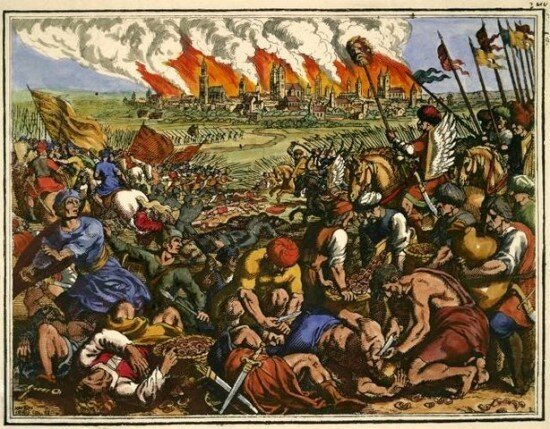
In 1287, Tula-Buga began to rule the Golden Orda together with children of Mengu-Timur; Tula-Buga was son to Tarbu, grandon of Tugan, and great-grandson of Batu. He meant to conquer Hungary and Poland and organized military campaigns which ended in failure; this strained his relationship with Nogai. Tula-Buga died as a result of conspiracy of Tokhty and Nogai.
1291-1312, the rule of Tokhty
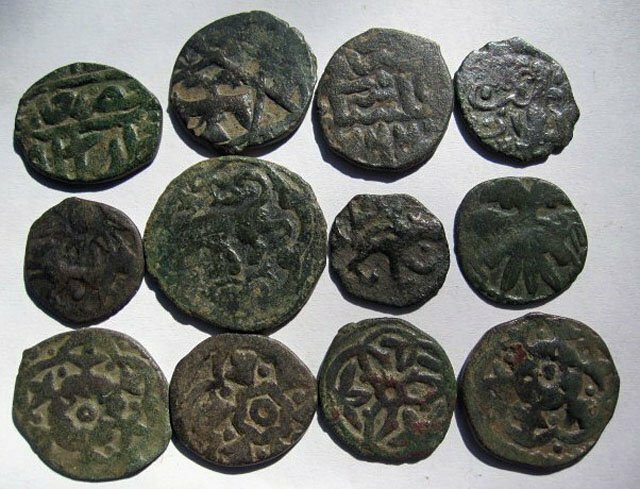
After entering into a conspiracy, the son of Mengu Khan Tokhty took the power. He came to power with the help of Nogai and Bakykchi (grandson of Berkechar, son of Jochi). From his mother’s line, he was a relative to Hubilai’s descendants (his grandmother Kelmish-aka was of those kindred); his grandfather Saljidai-gurgen came from a kind of Kungirat. After coming to power, by the direct order of Nogai, Tokhty killed his brothers who had previously attempted on his life. A little later he was asked by Nogai to execute some of the Emirs of Tula-Buga. The alliance with Nogai was sealed with the marriage of Tokhty’s uncle Yailaik (son of Saljidai) and Kabak, Nogai’s daughter. This marriage later became a cause of a quarrel between Nogai and Tokhty. The fact of the matter was that Yailak, like his father, adhered to Buddhism while Nogai and his daughter were Muslims. The family quarrel over religion ended up with a quarrel between Nogai and Saljidai. In addition, at this time, another relative of Nogai and Tokhty Tama-Toktai, who was the ruler of the Derbend Ulus, has renounced Islam; for this he received the nickname of Tokta-murtad (apostate Tokta). Apparently, Tama-Tokta converted to Buddhism and became an ally of Saljidai. Their heads were demanded by Nogai, but he received a refuse and started a military action against Tokhty in 1299. In one of the battles, Nogai had been captured by a Russian soldier and was beheaded; his head was delivered to Tokhty who executed the Russian soldier for such inglorious death of Nogai who was worthy of noble death according to Tokhty. Nogai’s son started to rule in Bulgaria but the pressure of Tokhty made the Bulgarian nobles to kill the son of Nogai. Then the remaining children of Nogai tried to overthrow Tohkty with help of Sara-Buga, brother of Tokhty, but they died. Nogai’s grandson fled to Bulgaria. With the help of wars Tokhty managed to centralize power in the Ulus of Jochi. He held a monetary reform in the state. During his life his successor Ilbasar died. Ilbasar’s son was appointed as legitimate heir to Tokhty.
1313-1341, the rule of Uzbek-Khan
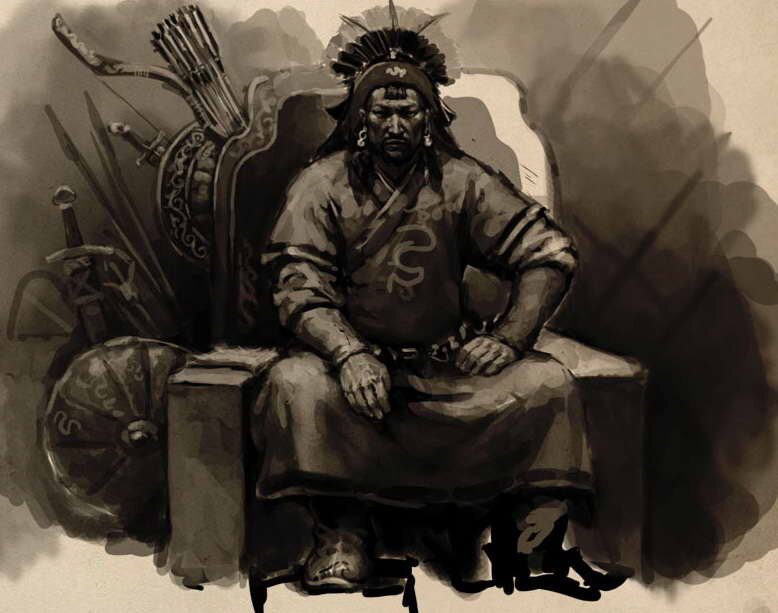
In 1313, Uzbek-Khan, Mengu-Timur’s grandson, came to power. After the death of Tokhty, the khuriltai was gathered where the second son of Tokhty Tukul-Buga (Tuk-Buga) contested wills of Tokhty who had appointed Ilbasar’s son as his successor. Uzbek arrived to the khuriltai and, under the pretext of conspiracy against him, killed Tukul-Buga. Then, using bribes to Bayalun (Tokhty’s widow), he was elected as a Khan on the khuriltai. After the election as a Khan, Uzbek conducted administrative reforms removing Jochids from power in Uluses and assigning their places to the tribal aristocracy. As a result of the reform, the most persistent Jochids were killed and the others were given away in subjection to Isatai kiyat. Also Uzbek declared Islam as the state religion of the Ulus of Jochi. His reforms have changed the Golden Orda, turning the confederation of the Uluses into a signed centralized state.
1341-1342 the rule of Tanybek
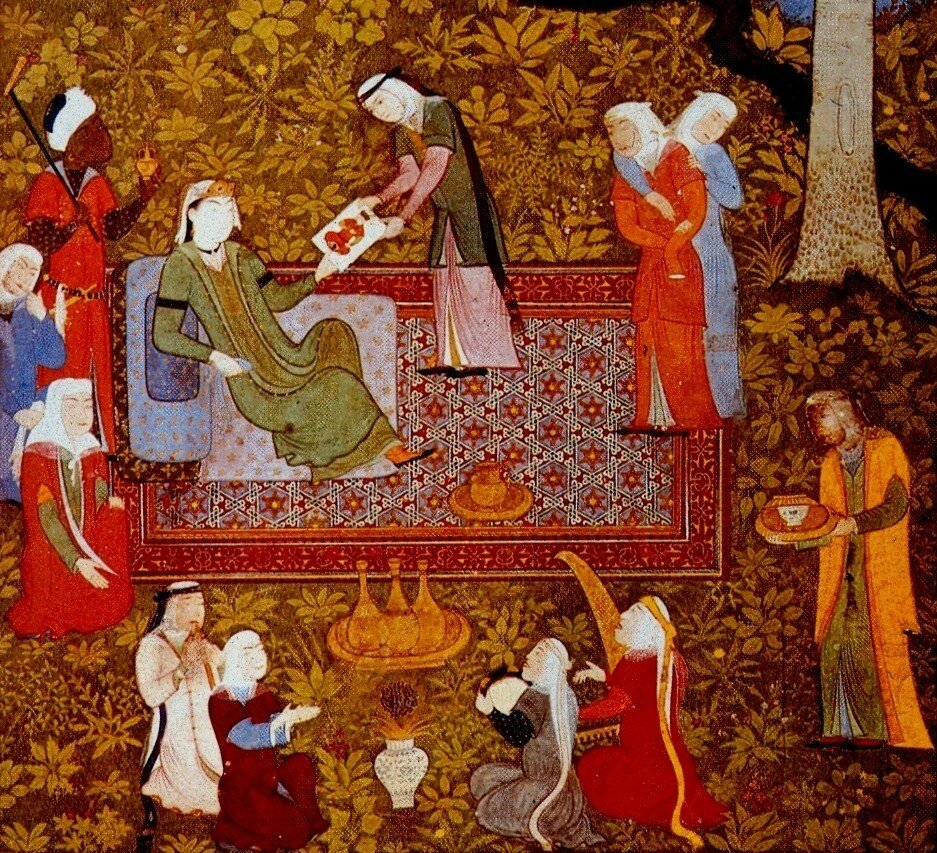
Tanybek was son of Uzbek and Taidulla. He had been ruling for only a year and was killed by his brother Janibek. “Khosrow and Shirin” Kutba poem, free translation from Persian to Turkic language of Nizami’s work, was devoted to Tanybek and his wife.
1341-1342, the rule of Janibek
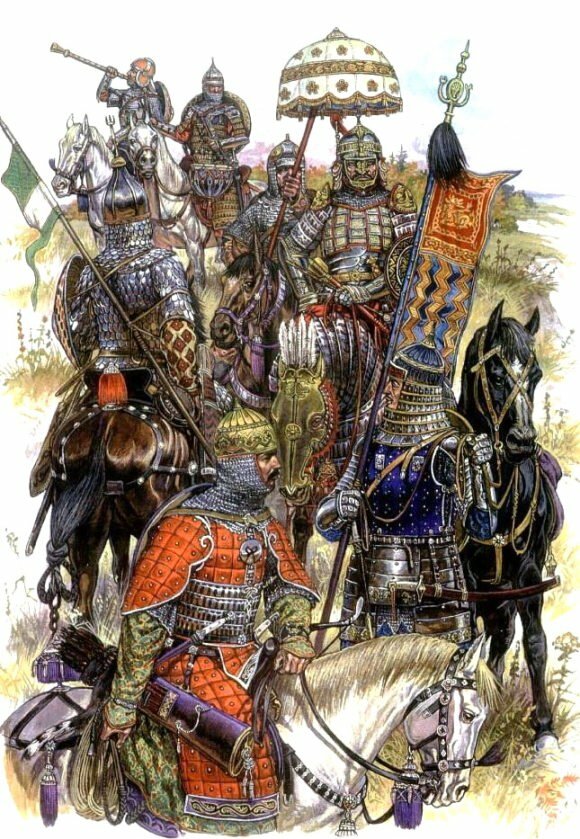
Janibek was son of Uzbek and Taidulla. During his reign there were no big wars. In 1357, Janibek managed to take Tabriz, which Jochids were pretending for from Berke’s time. However, upon arrival to Sarai from Tabriz, Janibek became ill. His son learned about this and came from Tabriz. Janibek improved in health but the arrived Berdibek killed the father and brothers and enthroned.
1342-1356, life of Yedige
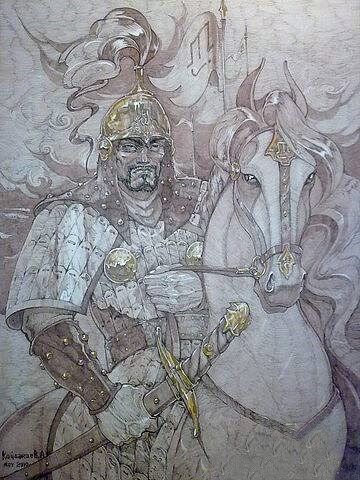
Yedige was the founder of the dynasty that headed the Nogai Orda. His direct descendants in the male line were Princes Urusovs and Yusupovs. Yedige was a political figure of the end of the 14th century and the beginning of the 15th century. He was coming from the Ak Mangyt tribe. His father was killed by Urus-Khan, and Yedige started to serve Tohtamysh. He married Tohtamysh’s daughter Janika. Later on Yedige fled to Tamerlane and started to serve him. He participated in the campaign of Tamerlane against Tohtaymsh in 1391. After Tamerlane had defeated Tohtamysh, Yedige received a protective charter from Tamerlane and started to organize his Ulus together with Timur-Kutluk. Starting from 1390s, he has been fighting Tohtamysh. Until 1395, Yedige and Timur-Khan owned East Dasht-I-Kipchak. Yedige had been enthroning nominal Khans and has been ruling on their behalf. He died in the battle with Kadyrberdy, son of Tohtamysh. For more details please refer to “1391, the rule of Timur-Kutluk, “1399, the battle on the Vorksla River”, “1399-1407, the rule of Shadibek”, “1407-1411, the rule of Pulad”, “1411-1412, the rule of Timur-Khan”, and “1412-14120, struggle between Yedige and the sons of Tohtamysh”.
1357-1359, the rule of Berdibek
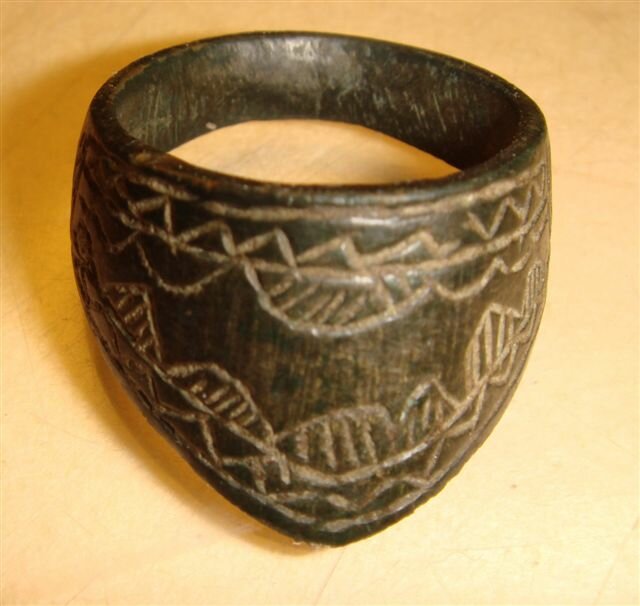
In 1357, Janibek, father of Berdibek, led a campaign to Azerbaijan and conquered it. Janibek left his son Berdibek as a Governor in Azerbaijan, while going back to the Golden Orda. After that, he severely sickened. His mother Taidulla called for Metropolitan Alexy to treat her son. Upon learning of his father’s illness, Berdibek secretly returned to the Golden Orda. However when he arrived, Janibek began to recover. Berdibek and his attalyj (educator) Toglubai scared for themselves because Berdibek violated the father’s order to remain in Azerbaijan and arrived home. Berdibek came to power by killing his father. Afther that he destroyed almost all his brothers and close relatives-descendants of Batu. The following year Berdibek murdered his son Mohammed-hoja for disobedience. In the autumn of 1359, Berdibek fell ill and died. After his death civil wars started in the Ulus of Jochi.
1347, formation of Moghulistan
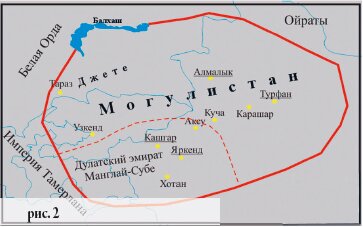
Moghulistan was the state formed in the middle of the 14th century on the territory of South-East Kazakhstan and Kyrgyzstan (East Turkestan) as a result of disruption of the Ulus Chagatai. After the death of Kazan-Khan (descendant of Chagatai), the tribal top of the Moguls decided to form a state independent from the Ulus of Chagatai. The center of the new state was lands of the Duglat tribe called “Manglai-Sube”; these lands included the following: South East of Zhetysu including regions of the East Turkestan from Fergana to Kuchi and Cherchen. In 1347, the Emir of the Duglats Puladchi appointed Tugluk-Timur (descendant of Chagatai) as a ruler; Tugluk-Timur is considered as the founder of the state of Moghulistan.
The break-up of the Golden Horde
1359-1380 –Velikaya amyatnya
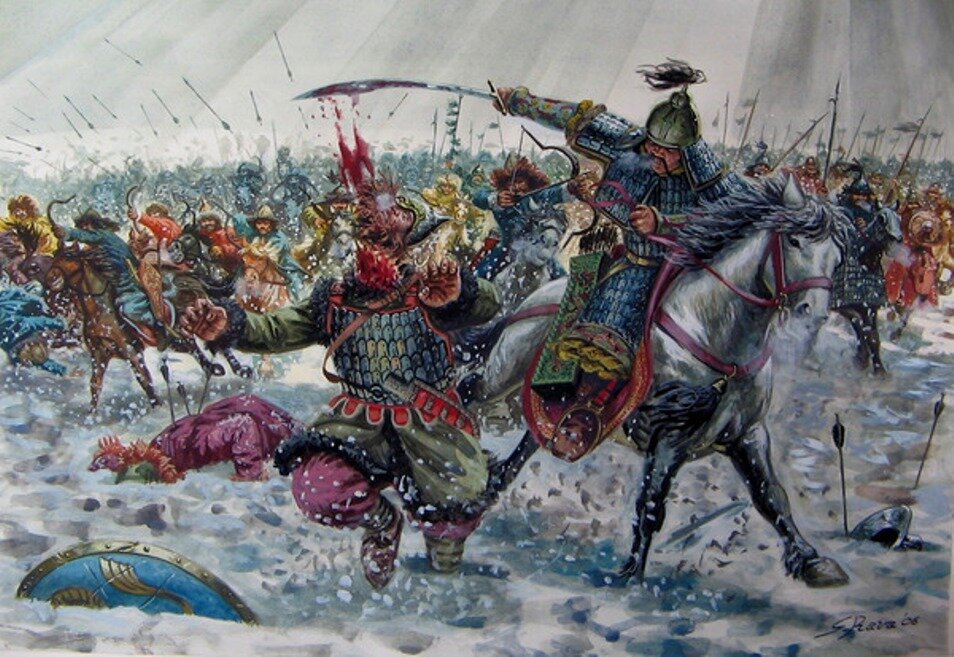
In 1359 the struggle for the power in the Golden Horde sharpened and political discord, which lasted for about 20 years, had begun. These events were called “Velikaya amyatnya”. In years of the discord between Berdibek and Toshtamysh khans more than 20 different khans replaced one another, that is to say, practically every year the Horde had a new leader. Moreover, often there was not a single power and different khans ruled over different regions of the country at the same time. A number of different factors was a reason of the discord. One of them was the epidemic of plague or “Black death” as they called it at that time, which was in all countries of Europe and Asia. Basic victims of plague were residents of towns in the Golden Horde, and nomadic population lived in more relaxed way and exposed to smaller risk of the infection. Numbers of townsmen considerably reduced and it brought to the state power as traditionally, settled population supported the state power. There was not an exact order of succession of throne in the Golden Horde. Before Tohta-khan and Uzbek-khan, a khan was elected at the kurultai by chingizids and representatives of tribal nobility. At the time of Tohta-khan’s reign accession to the throne ended with bloodshed. As a rule victims were relatives, who were striving for the power. Tohta had killed 6 brothers and cousins before he was a khane. Uzbek killed from 20 to 120 princes-chingizids. Uzbek’s successor, Zhanibek killed his two own brothers. During the accession to the throne Berdibek killed most of his relatives and did not spare even little children. In the end after Berdibek khan’s death there were few Batu’s direct descendants. Alive potential pretends for the power lived far from the capital, where they hid from Berdibek khan. Mutual annihilation of Batu’s descendants brought to that other branches of Dzhuchids started to pretend to political power. There were many pretends for khan’s power and the struggle had been lasting for many years. The discord ended after Tohtamysh-khan’s accession to the throne, who managed to assert himself on the khan’s place and unite all parts of the Golden Horde.
1368-1377 – Urus-khan’s reign

Urus-khan was a direct descendant of Dzhuchi,in 1368 he proclaimed himself as a sovereign ruler of East Deshti-Kipchak and in for this respect a coin with his name were made. Urus-khan strived for unite all lands of the Golden Horde and in 1372 he took the fieldto Sarai. Later he managed to occupy Hadji-tarhan. For non-participation in the march to Sarai he killed Tohtamysh’s father and Tui-khudzhu who was a ruler of Mangyshlak. In order to escape Urus-khan Tohtamysh ran to Tamerlan who received him hospitably and sheltered. Tamerlan gave lands of Otrar and Sauran to Tohtamysh. Urus-khan’s troops leaded by his son Kutlug-Buga kept persecuting Tohtamys and finally attacked him. At this fight Tohtamysh had lost but he managed to escape and Kutluk-Buga lost his life at this fight. Confrontation between Urus-khan and Tohtamysh lasted and at that time there was blood revenge between them. Urus-khan took vengeance beloved son’s death and Tohtamysh strived for revenge capital punishment of his father. During Tohtamysh’s struggle against Urus-khan, he was supported by Tamerlan, who shared troops to him and directed them to Sauran. There was another battle where Urus-khan’s second son Tohtakiya opposed to Tohtamysh and he was defeated again. He was injured and he went across the river in order to escape his enemies. He was considered as the dead but Tohtamysh managed to survive and got to his people. Tohtamysh appreciated Tohtamysh’s brevity and supported him again. At the same time Yedige appeared at the political scene, he had come to Tamerlan from Urus-khan and informs him about his repeated attack on Tohtamysh. Tamerlan came to help himself and placed his troops in Otrar. Urus-khan’s troops reached Syganak at that time and settled there. At that time strong frost had been lasting for three months and did not make it possible for troops to start a battle. At that time Urus-khan died unexpectedly and decisive battle did not happen. According to some historicans, Urus-khan’s state was one of the first Kazakh states and accordingly Urus-khan was one of the first Kazakh khans.
1370-1405 – Tamerlan’s reign
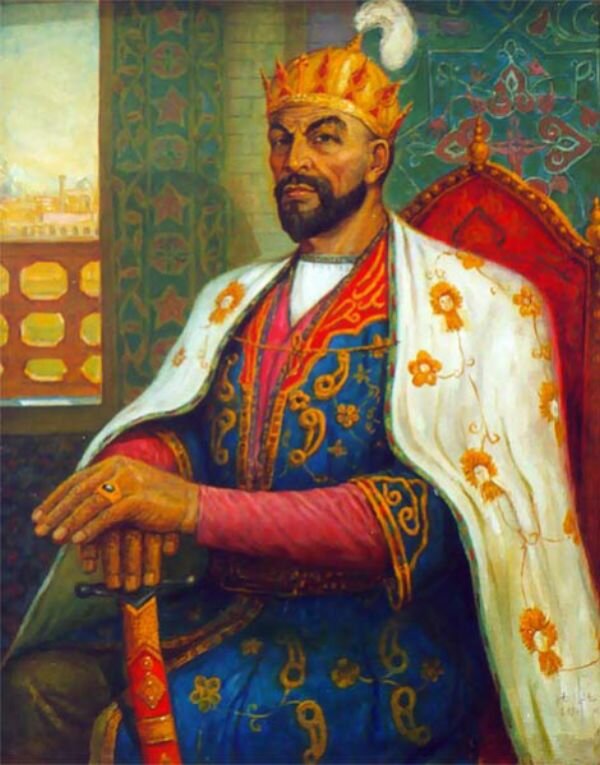
In 1370 Tamerlan’s formidable figure appeared in Central Asia. Tamerlan descends from a tribe barlas and is a direct descendent of Karacharnoyan, the emir of Chagatay, Chingiz-khan’s son. Formally Tamerlan was not a ruler. He implemented his rule on behalf of Chingiz-khan’s front khan-descendants. Suyuguratmys ruled in 1370-1388 and after him his son Mahmud from 1388 to 1402. During almost all term of his informal ruling, Tamerlan or Emir Temir leaded wars of conquest. From 1371 to 1390 he took seven fields to Mogolistan, however Tamerlan managed to crush Kamaridin and Ank-tyur’s army finally in 1390 at the time of the last march. In the course of his marches Tamerlan reached Irtysh on the north, Alakol on the east and besides it Emil and headquarters of Mongol khans Balig-Yulduz. Tamerlan did not have time to conquer the eastern lands of the Tangri-Taga and Kashgara Mountains. In 1380-1381 Tamerlan conquered Balch, Horasan and Herat. In 1383 he conquered Seistan, where Zireh, Zave, Farah and Bust were thrown down by him In 1384 Tamerlan took a new field and seized Astrabad, Amul. Sari, and Tebriz. Thus in fact Tamerlan conquered nearly all territory of Persia. After that a great conqueror went to conquer Armenia. These marches are known in the world history as three-years-old, five-years-old and seven-years-old ones, at the time of marches Tamerlan leaded uninterrupted wars in territories of Syria, India, Armenia, Georgia, Turkey and Persia. In 1390 Tamerlan started a struggle against his former ally a khan of the Horde Tohtamysh and in the course of this war he inflicted two cruel defeated on the khan. Battles were held in 1391 at the Kondurchi River and in 1395 at the Terek River. After these battles Tohtamysh khan lost the throne and had to lead a permanent struggle against khans who were put at the head by Tamerlan Tamerlan in his declining years in 1402 won one of the main victories over Ottoman sultan Bayazid I Lightning. Battle took place in July 28, 1402 next to Ankara and in the course of the battle sultan was taken as a prisoner. As a result of the war Tamerlan conquered all territory of Small Asia and it brought to the breakup Osman Empire. In August of 1404 Tamerlan came back to Samarkand where preparation for a new march to China was started several months later and Tamerlan planned realization of this march in 1398. In that year he built a fortress at the border of present Syrdariya region and Semirechiye. March had hardly started and was ended because of unusually cold winter and in February of 1405 a great conqueror died.
1377 –Toktakiya’s reign
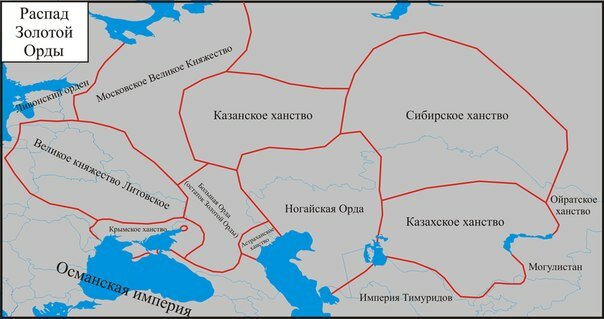
Toktakiya is a middle son of Urus-khan. After his elder brother, Kutlug-Buga died at the battle against Tohtamysh khan, Toktakiya was a single heir of Urus-khan. Toktakiya commanded Urus-khan’s troops against Tohtamysh successfully and in the second march he inflicted a cruel defeat. However Toktakiya ruled for a short time and in 1377 he died unexpectedly two months later after he took the throne.
1377-1379 – Timur-malik’s reign
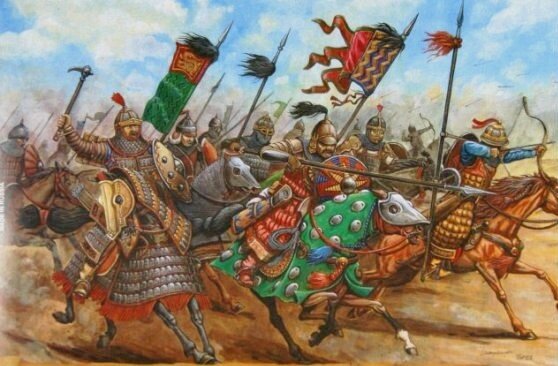
Timur-malik is Urus-khan’s younger son. According to several sources he distinguished with a dissolute lifestyle. In 1377 he became the khan after his brother, Toktakiya died unexpectedly. Timur-malik’s short reign was noticed by permanent was against Tohtamysh. In spite of that in this war he managed to gain several victories, the war was lost because of betrayal of the part of nomadic elite. Timur-malik was executed by Tohtamysh’s order in 1379.
1380-1406 – Tohtamysh’s reign
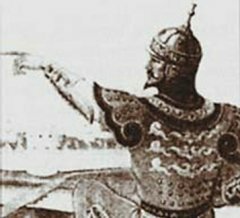
After Urus-khan died the rule over East Deshti-Kipchak passed to Toktakiya’s son, however he died after two months. After him Urus-khan’s son Timur-malik became the khan. At the time Tohtamysh strived for seizing khan’s power and leaded a permanent war against Urus-khan’s heirs. In 1379 Tohtamysh gained a victory over Timur-malik and dethroned him and executed. Tohtamysh’s only rival in the struggle for khan’s throne was Mamai. Mamai was defeated by Russian troops not for a long time (in 1380) on Kulikovoye field and was weakened because of this failure and was betrayed by many people. Nevertheless he decided to fight against troops of Tohtamysh and during the battle Mamai sustained another defeat and several troops were passed on Tohtamysh. Finally crushed Mamai escaped to the Crimea and died there under unclear circumstances. After Mamai’s death Tohtamysh took the sole rule and he managed to unite whole ulus of Dzhuchi. Tohtamysh ruled over all lands of the Golden Horde except Wallachiya and Moldova which came off in 1310. During Tohtamysh’s reign the Golden Horde suffered economic growth, connected with strengthening the central power and economic development. Tohtamysh managed to revive the peace with heneuzes and established good close trade relationships with this Italian republic. Peace and prosperity lasted for a short time and as a result of these two invasions of Tamerlan in 1391 and 1395 Tohtamysh lost the rule and intestine strives broke out with a new power. Tohtamysh managed to escape Siberia, where he died in 1406.
1391 –Battle at the Kondurcha river
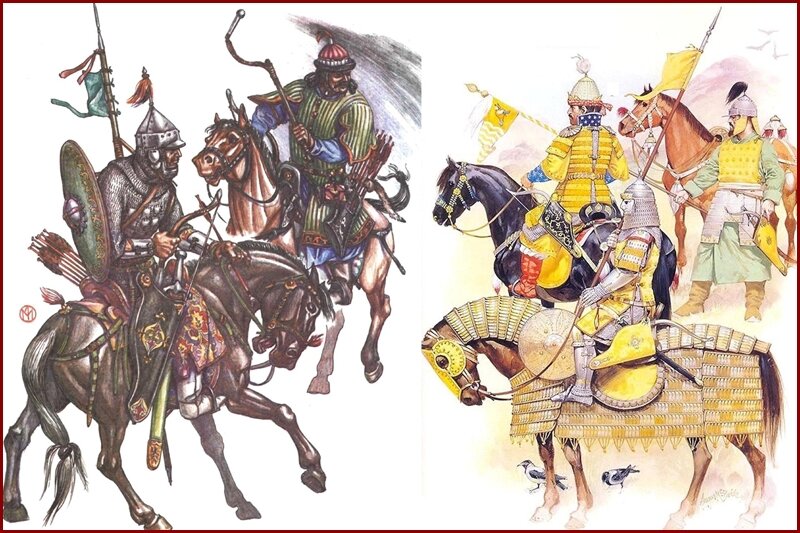
In 1388 Tohtamysh khan took a field to Tamerlan’s lands. Lame Timur had never forgiven such actions and he decided to crush Tohtamysh and in 1390 he gathered big troops and started a march to the ulus of Dzhuchi. During the first half of 1391 Tamerlan’s troops went over the territory of Kazakhstan and suffered hunger and cruel frosts. By June 18 they managed to meet with Tohtamysh’s troops and the battle took place at the Kondurcha river banks (Modern Samara region). The battle was bloody and two sides lost many people and as a result Tohtamysh had to withdraw to the west and Tamerlan refused persecution in order to save his people. In spite of it he divided his troops into many parts and sacked the population of East Deshti-Kipchak.
1395 –Battle at the Terek
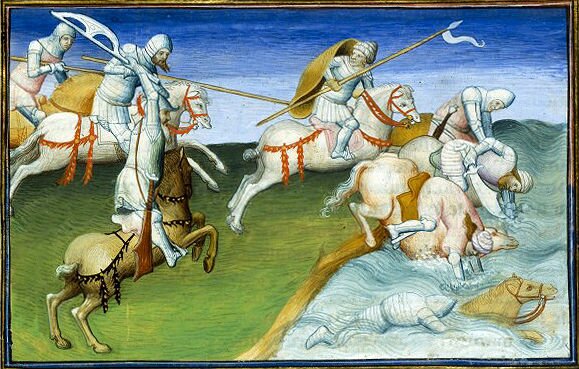
In the winter of 1394 Tamerlan took the second field against Tohtamysh. Being relied on the hard experience he did not lead his troops in cold and thinly populated steppes of Kazakhstan. He chose another, favorable way and leaded troops through warm Caucasus. In spite of a longer way troops moved faster. On April 15, 1395 the second battle took place near the Terek River. Tamerlan gained total victory and proclaimed Urus-khan’s son, Kuyurchak as a khan of the Golden Horde. Lame Timur made several predatory raids and after that he left the Golden Horde. Tamerlan’s predatory marches caused a considerable economic damage and after them the Golden Horde could not return last greatness.
1391-1399 –Timur-Kutluk’s reign
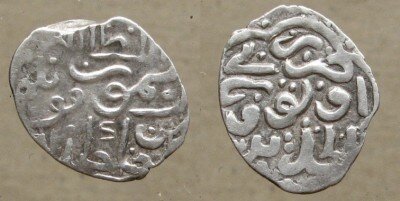
During Tamerlan’s first march to the ulus of Dzhuchi, Tamerlan’s closest allies and conductors were Timur-Kutluk and Yedige mangyt. Tamerlan gained victory , sacked a part of conquered lands and went to the south, also left educts and safe-conduct to Timur-Kutluk. After the conqueror left, Timur-Kutluk was supported by Yedige and was proclaimed as the khan. New khan did not rule over all territory of the state and only eastern part was subordinated to him. There was an interesting fact that Timur-Kutluk used a safeguard given by Tamerlan in order to confirm his rule and he attracted people, who apprehended from a conqueror’s new invasion, on his side. As a result of the second march in 1395 Tamerlan gained victory and conquered the territory of the Golden Horde after he sacked and devastated several towns, he went to the south and proclaimed Urus-khan’s son, Kuyurchak, as the khan. However Kuyurchak ruled for a short time as there were many pretenders for the khan of the Horde. One of them was Timur-Kutluk who did not control a part of the territory and was supported by Yedige. In the course of the intestine strife, which had been lasting for several years, Kuyurchak died and Tohtamysh continued the struggle for the khan’s throne. In 1399 the battle between Timur- Kutluk and Tohtamysh took place near the Vorskla River. Timur-Kutluk won the battle, however he ruled not for long and died in the same year.
1397-1398 –Building of the Hodzha Ahmed Yassaui mausoleum
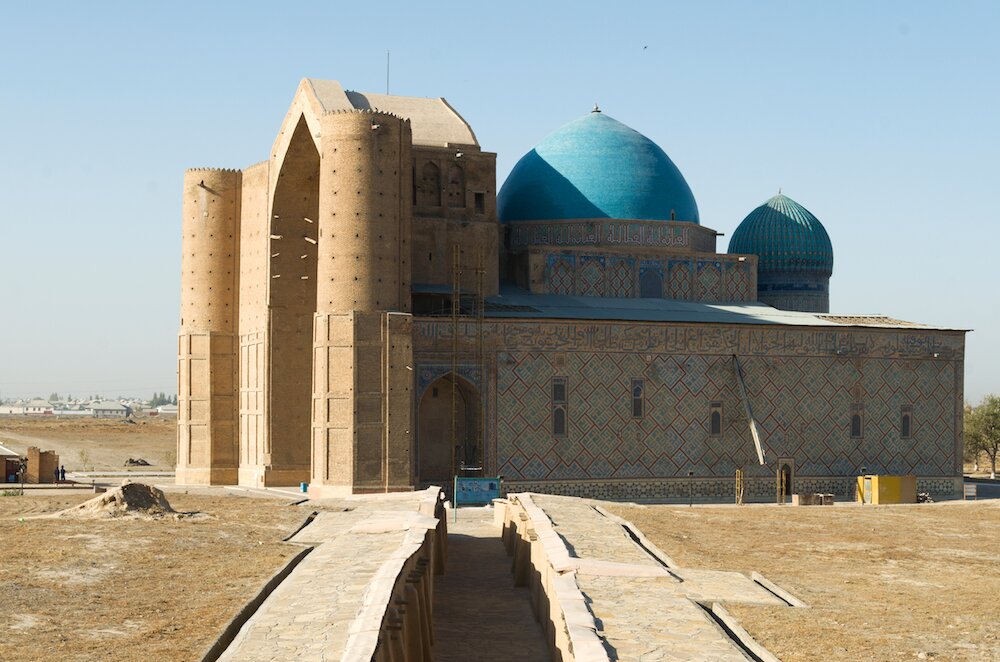
The mausoleum was built on the place of the burial site of Sufi Hodzha Ahmed Yassaui, who had a great authority in the Muslim region and had a big importance on spreading of Islam in Central Asia. Hodzha Ahmed Yassaui died in 1166 (67) and was buried with all honors in a small mausoleum. Great building of the mausoleum of nowadays was raised by Tamerlan’s order after 233 years after Sufi died. In 1395 Tamerlan gained another victory over Tohtamysh and conquered the ulus of Dzhuchi. In the respect of this victory a commander decided to build a new, grand memorial complex on the place of Hodzha Ahmed Yassaui’s old mausoleum, which was dilapidated state. At the time of Kazakh khanate, the mausoleum was Kazakh khans’ burial vault. In 1864 at the time of Turkestan march, Russian general Nikolai Verevkin issued an order to shoot at cupolas of the mausoleum and as a result the monument was partly destroyed.
1399 – Battle at the Vorskla
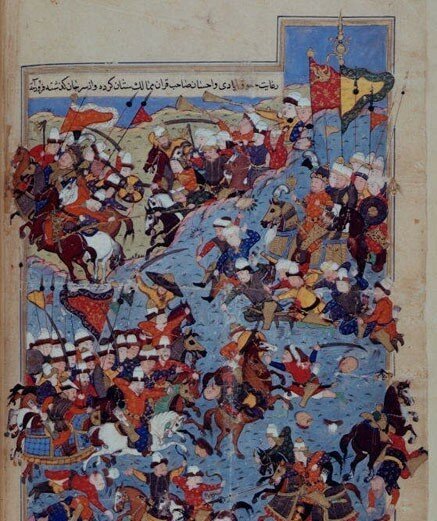
During intestine strife from 1395 to 1399 a struggle for the khan’s throne between Timur-Kutluk and Tohtamysh. Tohtamysh got a military support from Lithuanian duke Vitovt. If he won, he promised to give all Russian princedoms to Vitovt for his support. Timur-Kutluk had a small army, managed by ruse and started negotiations with Vitovt and promised to admit his rule (« to become a son») and make coins with the name of Vitovt and pay the tribute. These negotiations had only one aim: Timur-Kutluk expected the approach march of Yedige’s troops. Timur-Kutluk got the reinforcement and ended negotiations. And on August 12, 1399 two armies met at the Vorskla River. In spite of that the army of Lithuanian duke had artillery at that time, Tohtamysh and Vitovt’s united troops suffered a crushing defeat.
1399-1407 –Shadibek’s reign
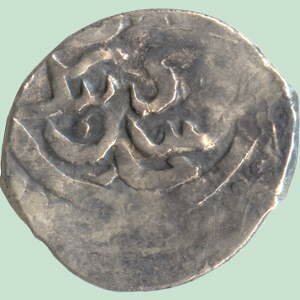
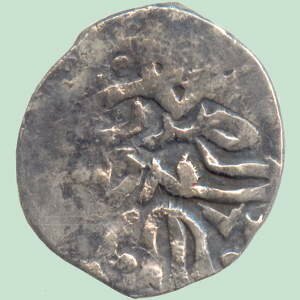
Shadibek was Timur-Kutluga’s cousin and was elected to Yedige’s throne after his death. Shadibek had a formal rule, Yedige ruled on behalf of him. In the end of reign Shadibek tried to get rid of Yedige’s rule but he suffered defeat and had to escape to Derbend. Yedige negotiated with a ruler of Derbend in order to reach extradition of Shadibek. Shadibek considered himself as a legal ruler of the Golden Horde until he died and he made coins in the Caucasus.
1407-1411 –Pulad’s reign
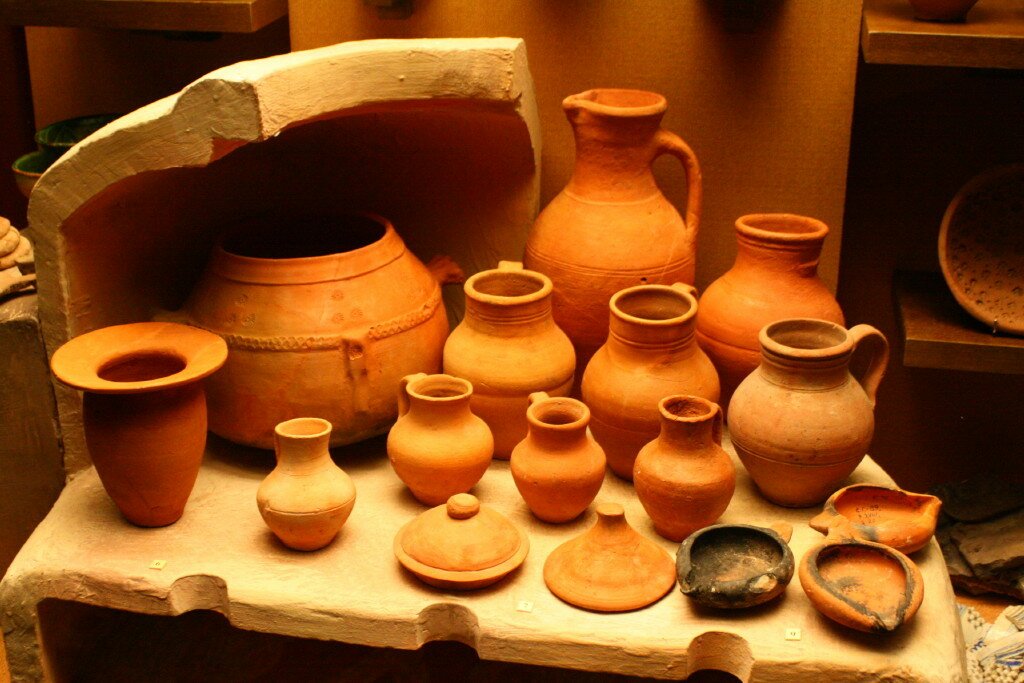
Pulad was Timur-Kutluk khan’s son. He was elected to the khan’s throne by Yedige in 1407 after Shadibek escaped to Derbend. Pulad had a formal rule and as before Yedige ruled over the state. In 1408 Yedige spread false information about the march to Great Lithuanian Princedom and prepared the march to Moscow. At that time Great Lithuanian Princedom and Moscow were at war with each other and it was a suitable time to the march. Yedige gathered troops and took a field to Moscow Tohtakiya’s son, Bulat and father of future Kazakh khan, Kerei took part in this march. After three-days-long siege of Moscow Yedige reached a ransom of 3000 roubles then came back to the steppe. Several facts caused this withdrawal: Moskow duke made peace with Vitivt and went to Moscow; also Yedige was informed about attempts of dethronement Pulad khan who was Yedige’s henchman. As a result of the march Moscow duke admitted himself as a tributary of khans of the Golden Horde and resumed paying the tribute.
1411-1412 –Timur-khan’s reign

Timur-khan is Timur-Kutluk’s son. Timur-khan was Yedige’s son-in-law and one of his daughter’s husband. In spite of it there was conflict between Timur-khan and Yedige, young khan was discontented for his nominal power. He gathered troops and sent them to Horesm, where Yedige was. In the course of the conflict Timur dethroned Yedige, however he did not manage to be the khan and it caused another discord. Other heirs took advantage of it. Tohtammysh’s children returned from Great Lithuanian Princedom, attacked Timur’khan and seized power in the ulus of Dzhuchi.
1422-1429 – Barak’s reign
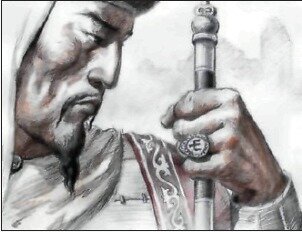
Barak was Koirchak-khan’s son and Urus-khan’s grandchild. In the beginning of the spring in 1419 Barak escaped to Ulugbek’s lands, who was Tamerlan’s grandchild. He lived in Samarkand and was protected by Ulugbek. After Yedige died his son Mansur elected Hadzhi-Muhammed to the throne of the Golden Horde, who revived diplomatic relations with Timurids. Ulugbek carried on double actions, he supported illusions of good-neighborly relations with Hadzhi-Muhammed and on another side he helped Barak to arm troops and struggle for the khan’s throne. In the autumn of 1422 Barak invaded Povolzhiye. In the spring of 1423 Ulugbek met a ambassador and recognized that Barak killed Hadzhi-Muhammed. BarakBarak became the khan of the Golden Horde however the discord was in progress and in 1426 Ulug Muhammed crushed Barak’s troops and forced out him to east, Timurid’s lands. Barak left out of things and in the same year he claims his rights to Syganak as his grandfather’s heritage. Ulugbek worried about these conflicts and in February, 1427 took a field to Syganak. In spite of numerical superiority of rivals in last battle Barak gained persuasive victory. In the period of 1428-1429 Barak died in one of intestine strives.
1424-1445 –Ulug Muhammed’s reign
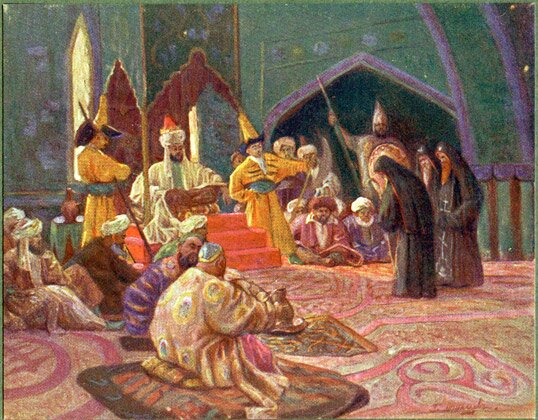
In 1425 Sarai town was occupied by Ulug Muhammed. He ruled over the town and the Golden Horde until 1437 when he had a conflict with beklyaribek (governor of internal region of the ulus) Nauruz (Yedige’s son). Nauruz with his troops passed to Kuchuk Muhammed’s side. By that time Kuchuk-Muhammed who struggled for the rule in the Horde, conquered the Crimea and Taht ali (one of Batu’s domens domains in the Volga). Ulug-Muhammed escaped the battle with Kuchuk-Muhammed’s troops and had to fall back to a Russian town Belev. There he fought against a Moscow duke. As a result of the battle Moscow duke was taken as a prisoner by Ulug Muhammed and afterward he released him for a big ransom. Starting from 1438 Ulug Muhammed was in the territory of Nizhni Novgorod and modern Kazan. In 1445 Ulug Muhammed was killed by own son Mahmutek, who proclaimed himself as the khan of Kazan. Ulug-Muhammed’s other two sons Kasim and Yakub feared their elder brother and asked for protection from a Moscow duke. As a result Kasim got lands from the duke and became the khan of Kasym khanate which was dependent on Moscow.
1429-1449 –Kuchuk-Muhammed’s reign
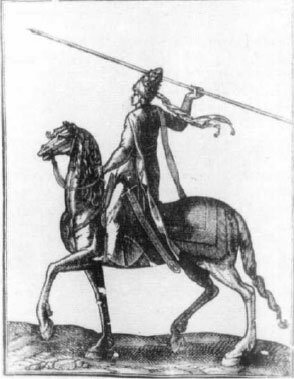
Kuchuk-Muhammed was a son of Timur-khan and Yedige’s daughter and which means that he a direct heir of the throne in the Horde. After Barak khan died Kuchuk-Muhammed was proclaimed as the khan and ruler of the ulus of Dzhuchi. Many historians connected establishment of so called Big Horde with this period of Kuchuk-Muhammed’s reign. In the beginning of his reign in 1429 Kuchuk-Muhammed controlled over a small part of eastern lands which is called the ulus of Dzhuchi. In 1430 he attacked successfully Horesm and a few years later he occupied That ali which consisted of former Pvolzhiye lands of the ulus f Dzhuchi. Kuchuk-Muhammed controlled large territories and such Povolzhiye towns as Sarai, Hadzhi-Tarhan (Astrahan). In 1449 Kuchuk-Muhammed died and his sons Ahmad and Mahmud became rulers of That ali.
1430-1469/70 –Abulhair’s reign
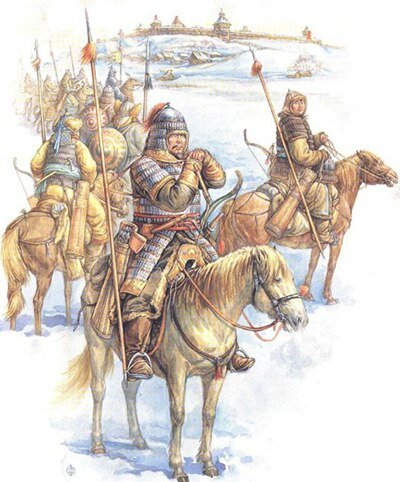
Abulhair became a ruler of East Deshti-Kipchak after Barak khan died. Abulhair carried out policy of centralized unity and spread his power all over whole territory of Deshti-Kipchak. In 1430 Abulhair took a field to Turu (the capital of Siberian yurt), gained victory and occupied the town. After that Abulhair attacked Mahmud-hodzha-khan. Two khans met at the riversides of the Tobol and Abulhair gained a victory, his troops crushed Mahmud-hodzhi-khan’s troops. As a result of this battle Mahmud-hodzha-khan and his son. Consequently Abulhair married Mahmud-hodzha-khan. Khan’s predatory wars did not end and after a short time he took a field to Horesm and occupied it, however the epidemic of plague made Abulhair withdraw his troops back to Deshti-Kipchak. In 1440 years Abulhair occupied Sygnak and other several Syrdariya towns. In 1448 Abulhair-khan took an advantage of Ulugbek’s absence and his troops and attacked Samarkand. Abulhair carried out active foreign policy and interfered in timurids’conflicts and in 1451 he helped to Abu Said to become a new ruler of Mavrennahr. However the khan did not succeed and in 1457 Abulhair suffered a cruel defeat from Oirats and consequently it shook his authority. Abulhair-khan died in the winter of 1469-1470. Abulhair’s forty-year-old reign in East Desti-Kipchak brought to a certain social-political stabilization. There was a situation when Abulhair-khan could struggle actively and had influence on geopolitical processes all over Central Asia. Abulhair-khan’s state was founded in West Siberia (with the capital of modern Tyumen (Tura) but depending on increase of its power it included nearly all territory of modern Kazakhstan (except Semirechiye and towns near the Syrdariya of south-east Turkestan), Horesm and Bashkiria and etc.
1457 –Battle between Abulhair and Oirats
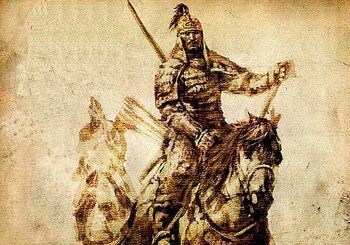
In 1457 Oirats’ ruler (Dzungars’ forefathers) Uz-Timur-taishi leaded his people to lands located on the riversides of the Chu River. Abulhair-khan, who considered these lands own, took an immediate field against Uz-Timur-taishi. There was a battle where Abulhair-khan suffered a cruel defeat. These troops had great losses; it is enough to say that his Ahmed and cousin Bahtiyar lost their lives at this battle. After unsuccessful battle of Abulhair-khan hid in Syganak. At this time troops of winner Uz-Timur-taishi plundered Turkestan, Sairam, Shahruhiya and suburbs of Tashkent. After that Abulhair had to conclude a peaceful agreement with Uz-Timur-taishi and gave him his grandchild as a hostage.
Kazakh khanate
1465-1466 –Establishment of Kazakh khanate
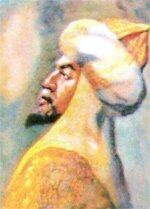

Rulers Kerei and Zhanibek. Kerei was Pulad’s son and Toktakiya’s grandchild. Zhanibek was Barak’s son. The first mention about them is connected with the reign of the khan of Mogulistan Yesen buga, according to sources Kerei and Zhanibek roamed to him. Yesen-Buga gave them a region of lands between rivers Chu and Talas. After Abulhair died Kerei and Zhanibek returned to Deshti-Kipchak and more than 200 thousand people from former Abulhair-khan’s ulus were naturalized under them. Kerei and Zhanibek were Cossacks (free people, who lived separately and did not subdue to anybody), then population of Kazakh khanate called themselves Uzbek-Kazakhs and finally this name was shortened and became simpler and more sonorous – Kazakhs. Zhanibek outlived Kerei and after his death he recognized the rule of his son Burunduk khan.
1509-1510 –Muhammed Shaibani’s marches to Kazakhs

Muhammed Sheibani was Abulhair-khan’s grandchild. Muhammed Shaibani seized the power in Mavrennahr in 1509, consequently took the throne and strived for making it impossible to strengthen Kazakh khanate. He impeded a total establishment Kazakh khans’ rule near to the Syrdariya. He tried to stop trade relations with Kazakh khans and issued an order which prohibited population of Turkestan to conclude bargains with Kazakh merchants. In fact Shaibani-khan announced an economic blockade of Kazakh khanate. Ban on the trade, also permanent war conflicts caused Kazakh khans’ reciprocal actions. Struggle for towns in South Kazakhstan lasted for a long time. Kasym khan considered towns near Syrdariya as an economic and military support for his rule over population of nomadic regions. Kasym khan carried out permanent war actions and disturbed Shibanids in the frontier districts of Turkestan and Tashkent. In return of his movement to Turkestan, Shaibani-khan took a field to the ulus of Kasym-khan in 1510, who was in the Ulytau foothills. This march was unsuccessful and ended with a complete defeat. Consequently it was reason of relaxation Shaibani-khan’s rule and his death under Marv. Shaibani-khan’s death in the end 1510 and intestine strife between Shibanids and Timurid Babur drew attention of Kazakh khans’ rivals from Turkestan. Kasym khan did not fail to use these circumstances in order to strengthen his rule over South Kazakhstan. Soon the biggest town near to the Syrdariya, Sairam was under Kazakh khan’s rule.
1511-1521 –Kasym’s reign

Kasym was a son of one of the founders of Kazakh khanate –Zhanibek khan and was a direct descendent of Dzhuchi (according to the information given in Abu-Gazi’s family tree). at first he did not have a formal power and was a sultan in Burunduk-khan’s palace, however in fact Kasym was a ruler. In the period of his reign Kazakh khanate strengthened his state, it was broadened and established control over broad territories of East Deshti-Kipchak. According to a historian Haidar Dulati closely- related tribes from Nogay Horde and other neighboring khanates were included to Kazakh khanate and the number of people who considered themselves as Kazakhs increased to a million. Even before Kasym became a khan, he was recognized as the khan of all Kazakhs and legal ruler, formal ruler Burunduk khan was not popular among people. As a result of it Kasym solved all matters connected with wars and foreign relations of Kazakh khanate. In the beginning of 1500 he made peace with Muhammed Shaibani khan. According to this agreement he gave troops of eight thousand people for Muhammed Shaibani for the march to Horastan. In the return Muhammed Shaibani was obliged to make coins with Kasym’s picture and hutbu in masques of Mavrennahr must be read with mention of his name. In spite of all conditions Muhammed Shaibani did not keep his promises and started the war against Kasym. This war was successful for Kazakhs and they got several towns which were situated at the Syrdariya River. In the second half of 1510 Kasym took a field to Nogay Horde and occupied the capital Sarayshik. Kasym died in the winter of 1521 at the age of seventy six. Kazakh people associated Kasym’s reign with a code of laws and norms which was called «Kasym hannyn kaska zholy» («Kasym khan’s valorous way»).
1521-1522 –Mamash’s reign

Mamash was Kasym-khan’s son and legal descendent; he took the throne after Kasym-khan’s death. In the years of Mamash’s reign contradiction between Kazakh khanate and Nogay Horde strengthened. As a result khans of Nogay Horde conquered broad territories to the Turgai River. The territory of Kazakh khanate became smaller in the years of Mamash’s reign. Nevertheless many neighboring states reckoned with the khanate. Mamash-khan’s reign was short and permanent intestine strives of sultans-dzhuchids made Kazakh khanate weaker. In 1524 Mamash khan died in the intestine strife.
1522-1532 –Tahir’s reign

Tahir was Adik’s son and Zhanibek’s grandchild. In the first years of reign Tahir-khan carried out an active with Nogays, as a result of several defeats on the west and lost nomads’ camps at the Yaik River. After Tahir’s war failures he roamed to Kochkara. Unsuccessful war decreased the number of citizens and brought to lose of authority among people. However in 1526 he managed to conclude a union with Kyrgyz people and conquer practically whole Semirechiye after Moguls fell back. Profitable union lasted for a short time and there were contradictions. One of reasons of short popularity was cruelty. As a result there was a rebellion and Abulkasym was killed, Tahir-khan was stripped of power. Tahir-khan died in obscurity and was left by all citizens.
1532-1551 –Civil wars in Kazakh khanate

After Tahir-khan died, the period of anarchy started in the territory of Kazakh khanate. There were several khans in different parts of the state, they did not subdue to the central power and were at war with each other. After Tahir died Buidash (Adik’s son and Zhanibek’s grandchild) became a formal khan, however there were other khans. Buidash had close relations with Kyrgyz people and lived in the territory of Semirechiye. At the same time, relations with shibanids were complicated. Abd al-Latif, Abd ar-Rashid’s son took 5 fields to Kazakhs’ nomadic camps. After one of such marches Buidash reached conquerors’ troops, crushed them and executed Abd al-Latif. Abd ar-Rashid found out it and decided to revenge on son’s death; he gathered troops and took a field against Buidash. The battle took place near the Issyk-kul, Abd ar-Rashid gained a victory. Crushed troops of Buidash fell back. However the war had been lasting and Buidash and bish-oguls (Adik’s descendents) took a new field against shibanids. They reached Sairam, however Nauryz Ahmed’s son, Darvish crushed them at the battle. Kazakhs started the battle, but it paralyzed Kazakhs’ actions and Uzbeks took the advantage of it. Kazakh 24 sultans, Adik’s descendants lost their life at this battle.
1551-1580 –Hak-Nazar’s reign

Hak-Nazar was Kasym khan’s son. After his father died he lived in Nogay Horde for some time. After Hak-Nazar took the throne, started policy of renewal and strengthening of Kazakh khanate. In the beginning of the reign he carried out wars against Moguls and Siberian Tatars. In 1569 Hak-Nazar took a field to Nogay Horde. There were rather mixed relations between Hak-Nazar and sibanids — war conflicts were replaced by periods of collaboration and friendship. Shibanid Abdallah-khan II was more interested in relations with Hak-Nazar. In the end of 1570 there was a war between Abdallah II and Baba-sultan (Nauruz-Ahmad’s son); Baba occupied Tashkent and killed his elder brother, Darvish who was left by Abdallah II as a ruler and it caused the war. Hak-Nazar supported Abdallah II at this battle as he was based on « agreement of oath » and his interests (Tashkent as other towns at the middle course of the Syrdariya, was the reason for struggle between Shibanids and Kazakh khans). Hak-Nazar’s support had an important place in neutralization Baba-sultan’s revolt, and in August of the same year Abdallah II made peace with Baba-sultan. Baba-sultan made peace and union with Kazakh sultans and ceded vilayets of Yassa and Sauran, this concession helped him to attack on Buhara together. However Kazakhs’ union with Bab-sultan was insecure. In April of 1580 Baba-sultan killed Dzhalim-sultan insidiously with his two sons and Hak-Nazar’s sons. Nowadays there are not authentic details about Hak-Nazar’s death.
1580-1582 –Shigay’s reign

Shigay was Dzhadik’s son and Zhanibek-khan’s grandchild. Shigay was born in about 1503. At the time of Hak-Nazar’s reign Shygay was his closest comrade-in-arms and in 1569 he took an active part in his march to Nogay Horde. After Hak-Nazar’s death he became a khan, although his reign did not last for a long time. Shigay was known for being Ahmed-Girey’s father-in-law, Kuchum’s brother. He took a field to Siberia and killed his son-in-law for disrespectful treatment to his daughter. Consequently Kuchum married Shigay’s daughter. In the beginning of 1582 Shigay participated in the march of Abdallah II against Baba-sultab to Ulytau. After this march, any information was not fixed in the sources, perhaps he died in one of these battles.
1582-1598 –Taukel’s reign
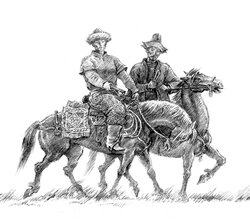
Taukel was Shigay’s son. In 1582 Taukel-khan beat Baba-sultan, cut off his head and got from Abdallah II Arikent vilayet. In the beginning of 1583 Tauekel suspected Abdallah II of malevolence during his return from the march from Andizhan and Fergana and left him. In 1585 his brother Ondan-sultan died at the time of attack on Dzungars, a few people of Tauekel’s family ran to Siberia and consequently he was taken to Russian prison. In 1586 Tauekel starts the war for towns near the Syrdariya and even made an attempt to conquer Tashkent. After a short war Taukel made peace with Abdallah, and proclaimed his elder brother Shaih-Muhammed a ruler of several Dzungar (Kalmyk) clans. In 1594 Tauekel sent an ambassador Kul-Muhammed to Moscow tsar Fedor in order to made a war-political union and liberate his nephew Uraz-Muhammed (Ondan’s son) from Russian prison. In 1598 Tauekel started the war against Buhara khanate. Abdallah II took a field against him but he died on the way. During the march Taukel managed to conquer Ahsi, Andizhan, Tashkent, Samarkand and Miyankala. But he was injured at one of these battles, fell back to Tashkent and died there soon.
1598 –Joining of Siberian khanate to Russia
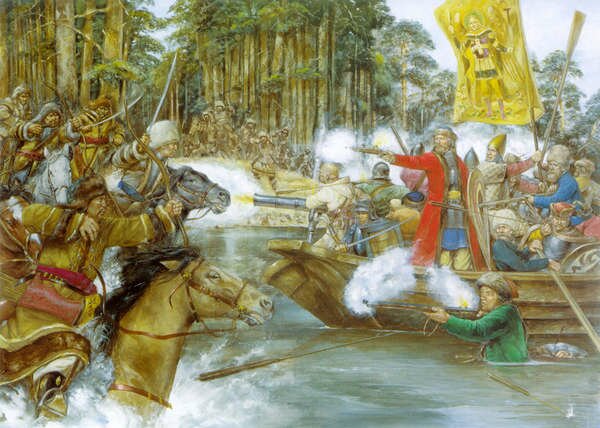
After Yermak’s death, generals Vasili Sukin and Ivan Myasnoi were sent to Siberia in 1586. After them another detachment of Strelets under the command of Danila Chulkov to Siberia. Forces of the khanate were undermined by intestine strife between Taibugid and Kuchum-khan. In 1594 and 1597 Russian generals tried to take Kuchum to a prison. Moscow government suggested to Kuchum to be naturalized in Moscow but he refused. In August 1598 the general Andrey Voeikov with cavalry attacked Kuchum’s headquarters, crushed his troops and took his five sons to prison at Irmenski battle. Kuchum’s brother and two grandchildren died, many people of the guard were killed . After the defeat Kuchum could escape to the Ob. In the end of his life Kuchum lost the sight, lived in exile and died in 1601.
1598-1628 –Yesim’s reign
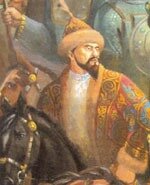
Yesim was Shigay’s son. His full name was Yes-Muhammed (Ish-Muhammed). After Taukel died Yesim sultan became a khan of Kazakh khanate. It happened at the time of the war march to Buhara. Yesim-khan concluded a peaceful agreement with Buhara. According to the agreement all borders of the state were the same, except Tashkent and Fergana, which were included to Kazakh khanate. In 1607 the war was resumed and Buhara khan’s governor-general managed to conquer Tashkent again. Yesim gathered troops and was ready to take a field. They made compromise by negotiations and Tursun-Muhammed’s son; Shah-Said was assigned as the formal ruler of the town and Zhalantas alshyn was assigned as an atalyk and virtual ruler of the town (Kazakh khanate). In spite of these conditions, Kazakh sultans leaded by Yesim occupied the town in 1611 but in 1612 Buhara khan Imamkuli returned it. In 1613 the power in Tashkent passed on to Tursun-Muhammed, Imamkuli’s henchman. Yesim-khan took part in intestine wars in the territory of east Turkestan. In 1624 he came back again, but the affair ended with a peaceful agreement. Tursun-Muhammed broke the agreement, attacked Yesim’s lands while he fought against Dzugars. After Yesim returned, he gathered troops and took a field against Tursun-Muhammed. In the battle which took place in 1627 Yesim was luckier and killed his rival. In the time of Yesim khan’s reign a code of laws (original constitution) — «Yesim hannyn eski zholy» (Yesim-khan’s ancient way), which was adopted as addition to Kasym-khan’s rules.
1611-1627 –Tursun-Muhammed’s reign
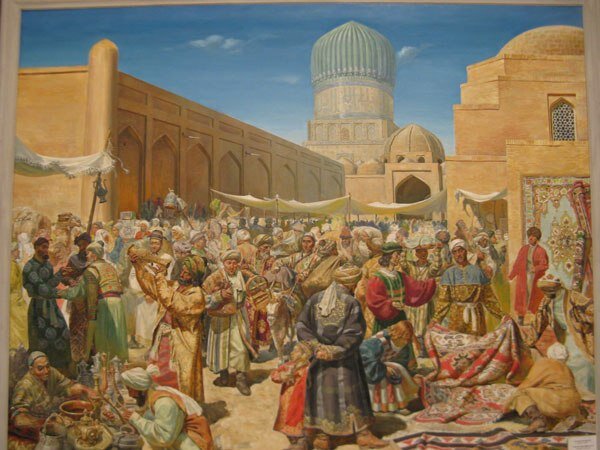
Tursun-Muhammed was Yesim-khan’s cousin. From 1611 to 1627 he was one of rulers of Tashkent. In 1613 Tursun-Muhammed was supported by Buhara khan Imamkuli and became his vassal. In spite of the formal dependence, Tursun-Muhammed did not recognize Buhara khan’s power and attacked Imamkuli’s lands. In 1621 Imamkuli sent the troops against Tursun- Muhammed, however he did not succeed and his troops were crushed. In 1623 Imamkuli set out against him again and suffered a defeat again. In 1625-26 Tursun-Muhammed established peaceful relations with Yesim. In 1627 Tursun-Muhammed attacked Yesim-khan’s lands when he took a field to Dzungars. In the return to it Yesim took a field to Tashkent and killed Tursun-Muhammed.
1635 –Establishment od Dzungar khanate

Dzungar khanate was established in the years of the reign of Batur’s son Hara-Hula-taidzhi from Choros dinasty.After Batur’s father died, he took the throne and title huntaidzhi which was given to him by Dalai Lama V. Batur took the title and declared the formation of Dzungar khanate. The term dzungar is translated as a right or east wing of troops and the west wing (left wing) was populated by Kalmyks. Thus Dzungars showed their relations with Kalmyk khanate There were such tribes in Dzungar khanate as Choros (the ruling dynasty), Hoshout, Torgout, Derbet, Hoit, Elyut and etc.
1643 –Battle at the Orbulak
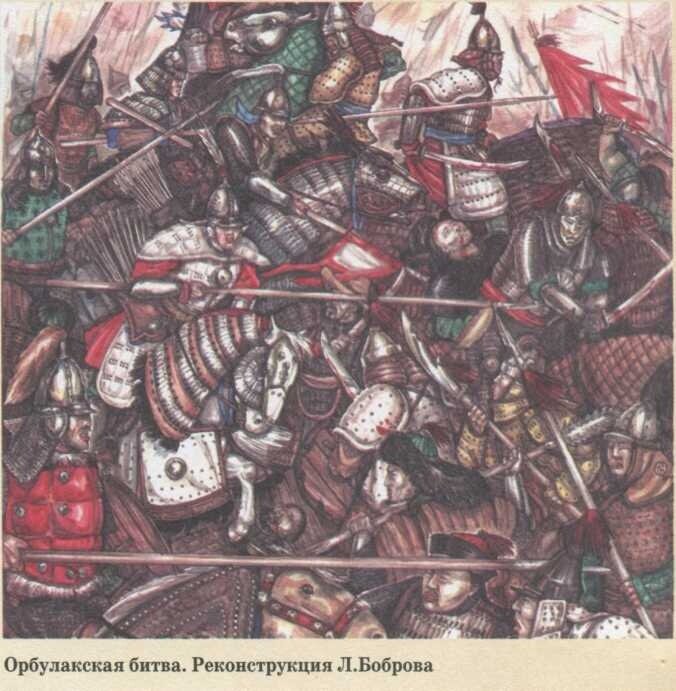
The battle between Dzungars and Kazakhs took place in 1643 and Kazakhs leaded by Zhangir-khan gained a victory over Dzungar troops of 50 thousand people. Zhangir with 600 warriors took a comfortable position in the gorge, where Dzungar troops could not pass whole. Half of the warriors organized blockage on the way and the rest concentrated at rocks and made an ambush for Dzungars. At this battle Kazakhs were the first to use firearms. After that Dzungars lost many people and they fell back after they were informed about reinforcement leaded by Zhalantos-bahadur for Zhangir.
1643-1652 –Zhangir’s reign
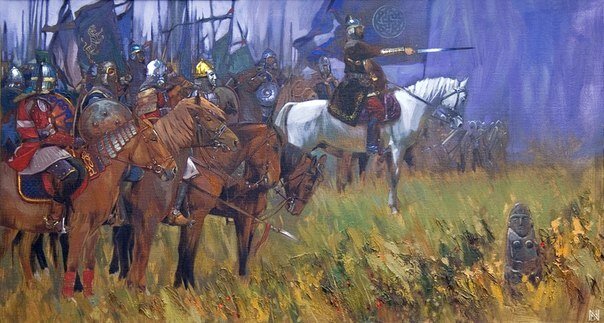
Zhangir-khan is Yesim-khan’s son. Zhangir-khan’s full name was Zhahangir. In 1635 Zhangir was taken prisoner after one of battles against Dzungars. Later he managed to escape and return to the motherland. In 1643 after his brother Zhanibek died, Zhangir was proclaimed as the khan. In the same year Dzungars attacked him. Zhangir gained a victory by using war ruse and the talent of military leader. The war started again in 1652, Hoshout Ochirtu-Tsetsent khan took a field to Kazakh uluses and in the course of the battle Tsetsent-khan Haldama killed Zhangir-khan. He was buried in Turkestan, near the Hodzha Ahmed Yassaui mausoleum in the respect of his services; the mausoleum, which was raised at his grave, was not preserved to nowadays. Zhangir was called «Salkam Zhangir» (Impressive Zhangir) for shown courage.
1652-1680 –Batyr’s reign

After Zhangir and Tauke-khan died Kazakh uluses were leaded by a certain Batyr, his origin is unknown and there is not information about his reign.
1680-1715 –Tauke’s reign
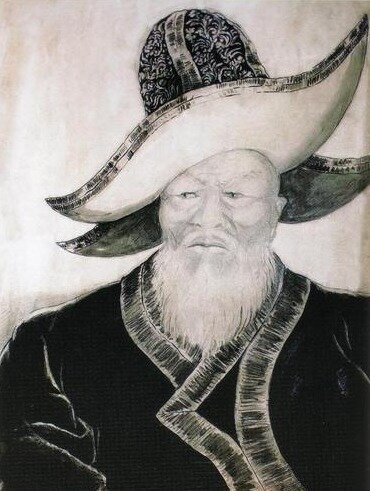
In 1680 Zhangir’s son Tauke took the throne. So called «Sairam» war between Dzungar and Kazakh khanates in the time of Tauke’s reign lasted starting from 1680 to 1680. The reason of this war was Kazakhs’ refusal Dzungar khan’s offer to profess Oirats’ religion (Buddhism). In 1680 Galdan-Boshoktu-khan attacked Semirechiye and South Kazakhstan. Dzungars conquered towns Sairam, Tashkent, Shymkent and Taraz. In 1684 Dzungars took another punitive field against people of rebellious Sairam. The town was occupied, Tauke-khan’s son was taken prisoner to Dzungars’ ruler Galdan and later Galdan sent him to Dalai Lama. Dzungars destroyed a city and leaded away a part of people to Dzungaria and East Turkestan. After described events, there was a lull in the struggle between Kazakhs and Dzungars as Galdan was interested in East-Mongol and East-Turkestan affairs. Dzungar huntaidzhi controlled over nomadic camps in Zhetysu and partly near the Chu and Talas rivers. However this provisional rule was shown by limitation of political influence. Dzungars could not reach the real rule over Kazakhs. Tauke-khan used relatively peaceful years for implementation administrational reform in Kazakh khanate. 1. Kazakh khanate consisted of 6 parts in that time: the Old zhuz, the Middle zhuz, the Younger zhuz, Kara-Kyrgyz, Kara-Kalpaks and Kurama (Tashkent Kazakhs: Katagan, Dzhiama and etc.). People called it Alty Alash (six alashes). Tauke-khan struggled against separatism between local sultans and assigned own representative in every part of the khanate. Tole bi Alibek-uly from the clan Dulat, department Dzhanys was the bi in the Old zhuz. Kazybek Kazdausty from the clan Argyn, department Karakesek was the bi in the Middle zhuz. Chegen bi from the clan Dzhagalbayly, and then Aiteke bi from the clan Alim, department Tortkara were the bi in the Younger zhuz (Zhalantos’s grand-nephew) Kokym-bi, Karashoryna were the bi among Kara-Kyrgyz. Sasyk-bi was the bi among Kara Kalpaks. The name of the bi among kurama is unknown. 2. In order to strengthen separate zhuzes and clans Tauke khan detached 7 weak and small clans, passed them on to the Younger zhuz and called the union of these Zhety ru (seven clans). 3. He made his code of laws called Zhety zhargy (Seven codes) on the base of Kasym and Ishym’s laws with his seven representatives-bis in Kul-tobe(«Hanabad», on the left side of the Angren river, in 40 versts to the south from Tashkent). There is Kazakh saying about this place and events «Kultobenyn basynda kunde kenes». 4. Under Tauke-khan tolenguts’ institution was formed completely: Tolenguts are khan’s guard, faithful to the khan and who were not connected with other Kazakh clans. By birth Tolenguts were from Kalmyks, Dzungars, Bashkirs, Altay Tolenguts and other tribes. Tolenguts’ efficiency consisted in their close connection with khans and was not connected with Kazakh clans. In 1698-1703 there was another war between Dzungar and Kazakh khanate. The reason of the war was Tauke-khan’s order to destroy Oirats’ embassy in Turkestan and Kazakhs’ attack the wedding procession of Seterdzheb, Tsevan-Rabdan’s bride. In 1698 Dzungars leaded by huntaidzhi crushed Kazakh nomad’s camps in the valleys of the Chu and Talas rivers and conquered thousands prisoners. Dzungars’ another raid to Zhetisu and valleys of the Chu and Talas was in 1699, they crushed and took about thousand Kazakhs prisoners again. In spite of permanent raids Kazakhs gradually strengthened. One of the main preconditions was Tauke-khan’s strong centralized power. Separate Kazakh detachments took fields to the north. Kazakh detachments with Kara Kalpaks devastated stockaded town of Tarhan in Tyumen district. Next year they attacked Tsarevo-ancient settlement and Utyatskaya fortress near Irtysh. The power of Dzungar ruler Galdan-Boshoktu was gradually shaken. Chinese emperor Kansi crushed him near the Tule river and took prisoner about 10 000 people. It made it possible for Kazakh warriors and commanders to be more confident in their actions. Kazakh citizen soldiers organized simultaneous attack on Dzungaria and Volga Kalmyks in 1702-1703. Intestine strives broke out among Volga Kalmyks and most of them (about 60 thousand) went away to Altay. At this period Kazakhs inflicted defeatto them in the steppes of West Kazakhstan. Kazakh troops inflicted their main attack in the upper course of the Irtysh. Kazakhs were supported by Tyan-Shan Kyrgyz and forced Dzungars back. Because of Kazakh troops’ threat Dzungar huntaidzhi planned to change his headquarters from the region of the Ili River to the lands between rivers Ob and Irtysh. Under these circumstances Dzungar zaisans and dukes of Kyrgyz of Minusinsk leaded away several thousand Kyrgyz of Minusinsk with the number of 3 thousand farms by deception. In 1702 and 1703 Kazakh leaded successful war actions in the upper course of the Irtysh. In spite of Kazakh warriors’ success an ambassador Bokey was sent to the headquarters of huntaidzhi from Turkestan. On behalf of Tauke and Kaip sultan he suggested to carry out the meeting of two rulers of Kazakhstan and Dzungariya with a purpose of making peace. As a result of diplomatic arrangements there were not big war conflicts for next a few years. In the end of life Tauke could not rule over Kazakh khanate. Because of the weakness of power disintegrated processes started. Separatism was strengthened and there was a new khan in every zhuz who did not recognize the rule. In end of the long war Semitechiye was taken by Oirats, loss the cattle, food and other values. Peace lasted not for long and in 1708 Kazakhs repulsed Dzungars’ another attack. The war lasted for long and had changeable success in 1708-1712. Although it lasted with recesses and without marked events, however it was another trial for Kazakh batyrs, bis, rulers of clans. In the first year of the war Kazakhs could oppose their troops consisted from 30 thousand citizen soldiers against Dzungars. Big attack of Dzungar troops on lands of Kazakhstan took place in 1710-1711. It was so serious that representatives of Kazakh zhuzes met at the meeting (Kurultai) in the autumn of 1710. Kurultay took place in Karakums, the lands of nomad’s camps of Karakesek. Position of batyrs tabyn Bokenbay, Shakshak Zhanibek, Tam Yeset attracted common attention at Kurultai. They were followers of the unity of citizen soldiers not only from different clans but different zhuzes. Bokenbai’s speech persuaded Kazakhs to continue the war against Dzungars. He was a commander of people’s volunteer corps, and Abulhair and Kaip became khans who helped Tauke to rule over Kazakh khanate. Dzungars’ war actions widened more and more, huntaidzhi Tsevan-Rabdan overrode East Turkestan, invaded Tibet. In 1713 Dzungar troops took new fields against Kazakh khanate. In 1715 Tauke-khan died.
1710 –Kurultay (meeting of all representatives of three zhuzes) in Karakums

After a few defeats of Dzungars Kazakh clans of the Younger and partly the Middle and the Old zhuzes gathered in Karakums, where they discussed the matter of submission and resistance to Dzungars. They decided to resist Dzungars and take a field to Kalmyks under the influence of speech of Bokenbay batyr from the Tabyn. The commander of all troops was Bokenbay.
1715-1718 –Kaip’s reign

Kaip was Ksaru’s son, Syrdak’s grandchild and a direct descendent of Yesim-khan. After Tauke khan died Kaip became the elder khan. Kaip carried out negotiations about the formation the military union against Dzungars, regulating border matters and opening Tobol market for cattle trade with Siberian governor M. Haharin in Tobolskoye. В 1715-1718 годах резиденцией Каипа был город Туркестан One of Kaip’s sons Batyr was the khan in Horesm and later he was the khan of the Younger zhuz. In 1716 Dzungar ruler Tsevan-Rabdan leaded the main part of his troops against Kazakhs. In the beginning of these events Kazakh citizen soldiers could not restrained pressure, suffered defeat and many of them were taken prisoners. Dzungars managed to reach Yamyshevskaya fortress and laid siege to it. Kazakh people’s volunteer corps took a successful field to Dzungars-Choroses, who lived near the Ili. War events were continued in 1717. Main events took place near the Ayaguz River. Big battle between Kazakh people’s volunteer corps and Dzungars took place here. Most of Dzungar troops were drawn from wars on the east. Kazakhs’ superior forces were drawn up to the Ayaguz River. Success must be provided with the number predominance of Kazakh troops and swiftness of attacks. Really, Kazakhs had a big number of troops. Kazakh troops’ total numbers in this battle was about 30thousand people. In the spring of 1718 Dzungars took a swift field from Zhetisu to the Arys, Bugun, Chayan rivers and reached Turkestan. Their main intention to conquer Kazakh khans’ headquarters. Kazakh towns in the middle course of the Syrdariya were threatened with danger. There were a few battles. Dzungars gained several local victories, but a small number and isolation from the nomad’s camps did not make it possible to reach this victory. In the end of 1718 Kaip was killed by one of sultans in the intestine strife.
1718-1723 –Bolat’s reign

Bolat was Tauke-khan’s son. In spite of that Bolat was the khan of all Kazakhs, he had not khan’s ambitions and his power was unstable. Bolat was a compromise figure on the khan’s throne. Kazakhs took advantage of Chinese-Dzungar war and attacked Dzungaria in 1719. «Years of great disaster» took place in the years of Bolat’s reign. In the beginning of XVIII century from decisive actions against Kazakh zhuzes Dzungar rulers were held back by threat of attack of Tsin rulers’ troops on Dzungar khanate. But this danger considerably decreased after Chinese emperor Kansi died in 1722. Peace between Dzungars and Chinese was made in 1723. Dzungar huntaidzhi secured his rear on the east and started to prepare for the war against Kazakhs. In the spring of 1723 Dzungar troops of 70 thousand people attacked Kazakhstan by seven columns: Son of Dzungar ruler (huntaidzhi) Tsevan-Rabdan Galdan-Tseren with 10 thousand soldiers went to the Balhash and Karatau. Younger brother of Kulan-Batur huntaidzhi went to Altay and along the Koktal River. Amursana’s detachments, who was huntaidzhi’s grandchild made their way to the basin of the Nura River. Galdan-Tseren’s son Tsevan-Dorzhi made his way to the valley of the Chilik River. Another son of Galdan-Tseren Lama-Dorzhi went to the Issyk-Kul. Noyon Doda-Dorzim headed for the Chu. Huntaidzhi Tseven-Rabdan went across Ili and fought his way forward along south Zhetisu. Tseven-Rabdan’s son Shona-Daba took the command over the attack. As a result of this march by the 20s of XVIII century Dzungars occupied a large part of Kazakh lands. The Ulytau Mountains, Lake Balhash and lands between the Chu and the Talas were the nearest border between lands of Dzungars and Kazakhs. Kazakhs of the Old and the Middle zhuzes went across the Syrdariya and roamed to Hodzhent, most of the clans of the Middle zhuz went to Samarkand, the Younger zhuz roamed to Hiva and Buhara. Kazakhs fell back with battles and inflicted great losses to Dzungars; citizen soldiers managed to break away from enemy in Betbakdala and repulsed them in the battle in Tanbalytas. Kazakhs forced Dzungars to take up a defensive position at the banks of the Sarysu. The illustration of heroic struggle against Dzungars was a permanent siege of Sairam. Dzungars could not conquer this town; they surround it and started the siege. Их Their aim was to conquer and sack Sairam. The siege lasted for long but Dzungars did not manage to occupy the town. Huntaidzhi sent a part of the troops to mountains and ordered to change courses of the Sairam and the Tuvalak. These rivers supplied the town in the siege with water. Residents of Sairam were without water and gave themselves up after some time. Bolat died after Dzungars attacked.
1718 –Foundation of Semipalatinsk
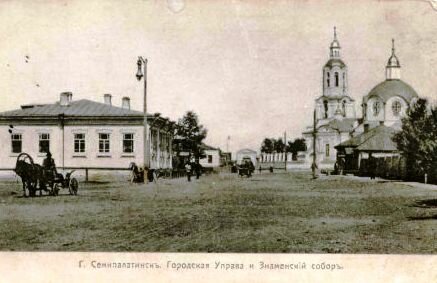
Name of Semipalatinsk fortress and of the town Semipalatinsk comes from seven Buddhist Kalmyk temples, which lived not far from Dzungar settlement Dorzhinkit ( Tsordzhinkiyd). Russian researchers knew about these temples in 1616. In 1660-1670 these builsings were exposed to destroying during Kazakh-Dzungar wars, therefore G. F. Miller, who collected information about them, found these buildings in a tumbledown state in 1734. Semipalatinsk fortress was founded by tsar’s general Vasili Cheredov and his detachment in 1718 on the 18th km of the lower part of the Irtysh from the present location of the town in a connection with the Decree about protection lands and building fortresses near the Irtysh of Peter I. The fortress was fortified and fully armed under the observation of a colonel Stupin in the autumn of `1718. At the present time the place of Semipalatinsk fortress is called «Old fortress» and is a recreation center of townsmen.
1720 –Foundation of Ust-Kamenogorsk

In May, 1720 Major Ivan Mihailovich Liharev’s expedition supplied by the decree of Peter I made their way to Lake Ziasan. They reached the lake safely but a large Dzungars’ detachment blocked their further way along the Black Irtysh. Attack was easily repulsed, however it was impossible to go further because of shallow Irtysh. The expedition went back. On August 20, 1720 the war detachment of Russian army arrived in the place of confluence of the Irtysh and the Ulba, where building the fortress was started. This day is considered as the day of foundation Ust-Kamenogorsk town. By Liharev’s order in the autumn of 1720 Ust-Kamenogorsk fortress was founded in the place of confluence of the Irtysh and the Ulba, and it was called so because the Irtysh gushed from mouth of Rocky Mountains and flowed along the valley.
1720-1740 –Zholbarys’s reign
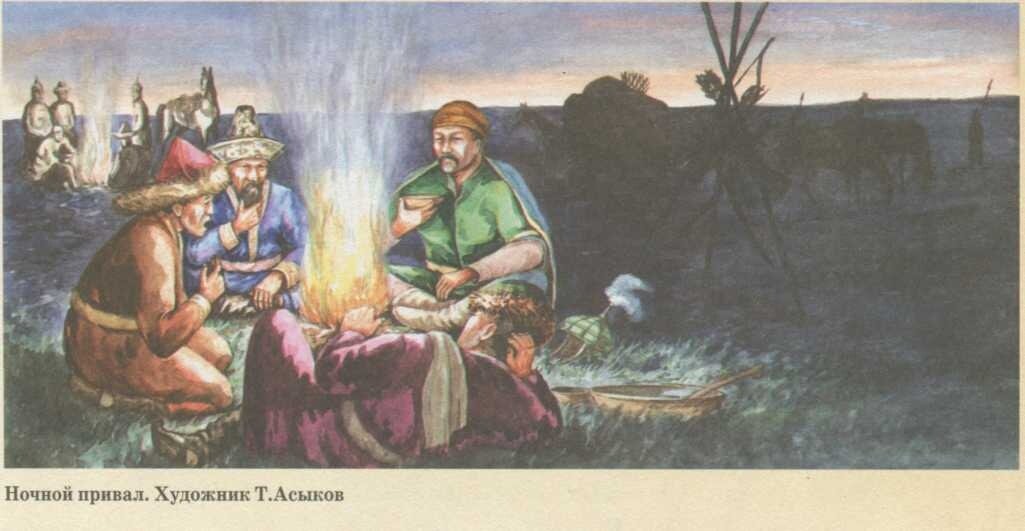
Zholbarys was Abdulla’s son. Zholbarys ruled over Tashkent and its suburbs. Besides that he had broad pastures in the valleys of the Chirchik and Arys, also lands between Tashkenet and Turkestan. In the autumn of 1726 Zholbarys took part in Kazakhs’ kurultai, which took place at the Badam, Ordabasy. Zholbarys was Abulhair’s true follower, he always supported him in all arguments between the khan and the sultan, and he was even called «Abulhair’s brother». After Abulhair took Russian citizenship Zholbarys also expressed a wish to be naturalized by Russia. Zholbarys ruled over Tashkent with Tole-bi, Tauke-khan’s adviser. He died tragically, he was killed by Uzbeks and according to Miller they «cannot stand Kazakhs’ offences and the khan did not protect them and judged unfairly».
1723-1748 –Abulhair’s reign
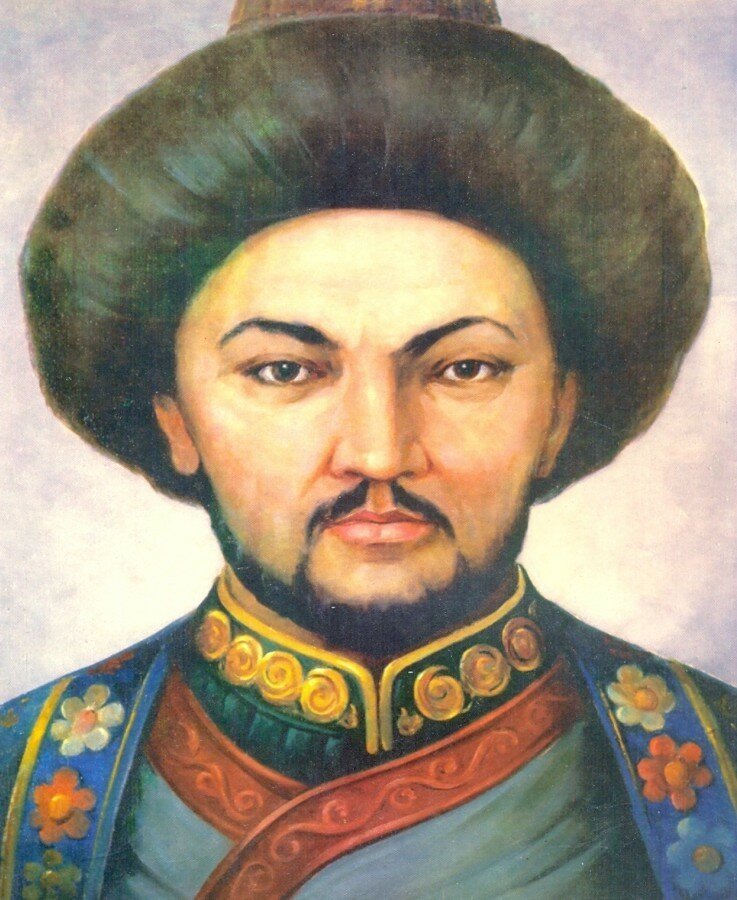
Abulhair was Kazhy-sultan’s son, Irish’s grandchild and Zhanibek’s direct descendant. In 1709 Abulhair with a group of dependent Kazakhs and Kara Kalpaks from lands near the Aral to East Bashkiriya to the headquarters of the leader of local insurgents, the sergeant major of Burzyan clan of the Nogay road, a noble tarhan and batyr Aldar Yesengeldin (Isekeeyv). One year later Abulhair came back. In 1710 he headed Kazakh people volunteer’s corps against Kalmyks. In 1718 Abulhair was dependent from Kaip khan and had a main headquarters in the lower part of the Irtysh, but after Kaip died he got the status of Kazakhs’ head khan and from 1719 to 1724 he lived in Turkestan with interruptions, which was his permanent residence in the territory of Kazakhstan. Abulhair foresaw the union of Kalmyks and Dzungars and apprehended its consequences and in September of 1723 troops of twenty thousand Kazakhs and Kara Kalpaks leaded by him took preemptive field to nomad’s camps of Volga Kalmyks. In 1724 at the time of Great disaster Kazakhs under Abulhair’s command gained the first victory over Dzungars. However in view of marked superiority of Dzungars’ numbers and war force, Abulhair had to leave Turkestan, Tashkent and several other towns of the Syrdariya in 1725 which were conquered by Dzungar troops. Средней Азии. Kazakhs were cut off from eastern markets and town industrial centers. As a result of Dzungar conquests a new wave of Kazakh refugees came to west and north of Kazakhstan from south and east. In the autumn of 1726 Kazakh detachments of 10 thousand people leaded by Abulhair khan, khan of the Middle zhuz Sameke, sultans Esim and Barak took a field to the uluses of Kalmyk taidzhi Lobzhi Nazarov, this march developed into a prominent bloody battle between Kazakhs and united troops of taidzhis Dorzhi and Lobzhi Nazarovs and Donduk Ombo. At first Abulhair’s troops were successful, which « crushed the ulus of Lobzhi, beat so many people as they could and took wives and their children as the loot». But Kazakh detachments on the approach to Yaik were attacked by Volga Kalmyks which outnumbered and attacked from three sides at the same time. After four-days-long siege to Kalmyk’s detachments by Kazakh troops the sides made peace. All-Kazakh congress at the Badam in Ordabasy took place the autumn of 1726. Abulhair was proclaimed the commander of Kazakh people’s volunteer corps at this kuruktai. In 1726 Kazakhs gained their first serious victory over Dzungars near Bulanty under his command. Anyrakay battle took place in 1730. Abulhair commanded the battle in Anyrakay personally. This battle was the top of his political activity. With a purpose of regulating contradictions between Kazakhs and Bashkir Kazakh sergeant majors took a decision about concluding the agreement with Tsar’s government at the congress of people’s representatives of the Younger and Middle zhuzes in May, 1730. On 28 August 1730 Abulhairs’ envoys arrived at Tsar’s palace. On February 19 1731 Empress Anna Ioanovna signed two letters for Abulhair and Kazakh sergeant majors and expressed her consent to take Kazakhs to Russian citizenship being based on the khan’s conditions. On October 10, 1731 Abulhair took the oath to be true to Russian emperor’s throne at the congress of Kazakh sergeant majors of the Younger zhuz during a sharp confrontation. As a result of taking Russian citizenship in 1732 Abulhair managed to conclude utterly important agreement with A. I. Tevkelev about delimitation disputable pasturable territories in the district of lands between the Volga and the Yaik (the Volga and the Yaik) and on the left side of the Yaik between Kazakhs and the Volga Kalmyks, Bashkir and Cossacks from Yaik in favor of Kazakh population. In the autumn of 1737 Abulhair arrived in nomad’s camps of neighboring Bashkiria under the pretense of help to local Russian powers in neutralization people’s rebels and tried to elect his son Kozhahmet to the throne, however he did not succeed. A few months later Abulhair appeared in frontier Bashkir nomad’s camps then he came in Orsk with a large group of local rebels in April of 1738 because Bashkir batyrs asked him to help and his proclamation as the "head of Bashkiria". New leader of Orenburg expedition V. N.Tatishev (1737-1739) had to spend many diplomatic efforts in order to persuade Kazakh khan to roam to Bashkiria. In view of ambiguous state Tsar’s government needed Abulhair to confirm his oath to be true to Russian Empress. Therefore on August 3, 1738 he took Russian citizenship in Orsk again. In 1742 Kara Kalpaks sent ambassadors to Orenburg and Petersburg in order to be taken to Russian citizenship because of permanent attacks of neighboring tribes. Russian government satisfied Kara Kalpaks’ request. It caused cruel reaction from Abulhair and he attacked on them in 1743. As a result of this attack most of Kara Kalpaks moved to east channel of delta of the Zhanadariya from Syrdariya by the 2 half of 18 century. In 1746-1747 Abulhair carried out cut-throat arguments for realization his main political aims with governor Neplyuev from Orenburg. Finally on June 27, 1748 Abulhair and Neplyev reached compromise, which caused considerable conflicts in Russian official quarters about the matter of further policy of the empire in a connection with the "main khan’s" institution. On August 15, 1748 Abulhair was killed in lands between rivers Olkeyak and Turgaiv in the course of the struggle for the power in the unequal fight with his main rival- Barak sultan.
1723-1734 –Samekes’ reign
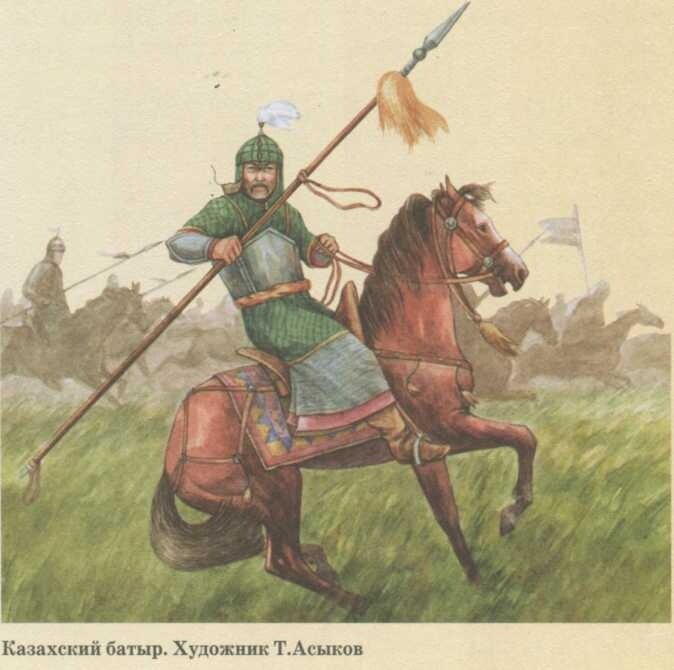
Sameke was Tauke-khan’s son. Several clans of Naimans, Kipchaks and a part of Argyns were under Sameke’s command. In 1720 Sameke became Karakalpaks’ khan. In the autumn 1726 Sameke took part in Kazakh kurultai which took place at the Badam, Ojrdabasy. In 1730 after Anyrakay battle and Bolat khan’s death majority at the kurultai supported proclamation Abulmambet the elder khan. Sameke and Abulhair did not agree with the decision and went away to their nomad’s lands. At first Sameke kept Russian position (he even carried out negotiations with Russia about joining in 1731-1732) but after tsar’s authorities started to support Abulhair Sameke changed his attitude and became set hostilely to Russian rule. In 1733 Sameke organized the march against Ural Bashkirs but Abulhair gave advance notice to them about it and Sameke suffered a defeat. In 1734 Sameke died unexpectedly and at that time ambassador I. Kirillov with the letter from Empress Anna Ioanovna headed to him but the ambassador did not find him.
1726 –Battle at Bulanty

In the autumn of 1726 All-Kazakh kurultai took place at the Badam, Ordabasy. Khans Abulhair, Abulmambet, Sameke, Kushik, Zholbarys, sultans, bis of different clans leaded by Tole bi Alibekuly, Kazdauysty Kazybek bi, Aiteke bi, famous commanders and batyrs were invited to the kurultai. Abulhair was a commander of Kazakh people’s volunteer corps in Ordabasy. In 1726 Kazakhs gained the first serious victory over Dzungars at Bulanty.
1730 – Battle at the Anyrakay
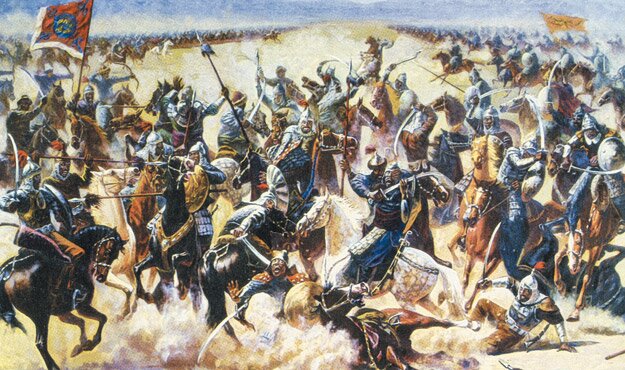
The Anyrakay Mountains and Lake Alakol were important strategic posts during of Dzungar-Kazakh confrontation. There was a going-out to the Sarysu, the Karkaraly Mountains and Ulytau by the Chu. In 1730 the battle between Kazakhs and Dzungars took place near Anyrakay. From Kazakhs representatives of all three zhuzes took part at this battle. Abulhair-khan took a general command. Firearms were used in this battle. Kazakh troops had a good reconnaissance which was relied on good knowledge the location. Dzungars could not stand advance of Kazakh cavalry. Kazakh troops forced out Dzungars across small steppe rivers to Lake It-Ichpes and Anyrakai mountains. Rival strived to fall back to the next hollow or climb up mountains; he was forestalled by Kazakh detachments. There was not stable unity in Dzungars’ camp. Huntaidzhi Galdan Tseren did not manage to resist Kazakh cavalry. He could not get reinforcement- wars between Dzungars and Tsin rulers. Many circumstances were in this battle and Dzungars were crushed.
1738-1771 –Abulmambet’s reign
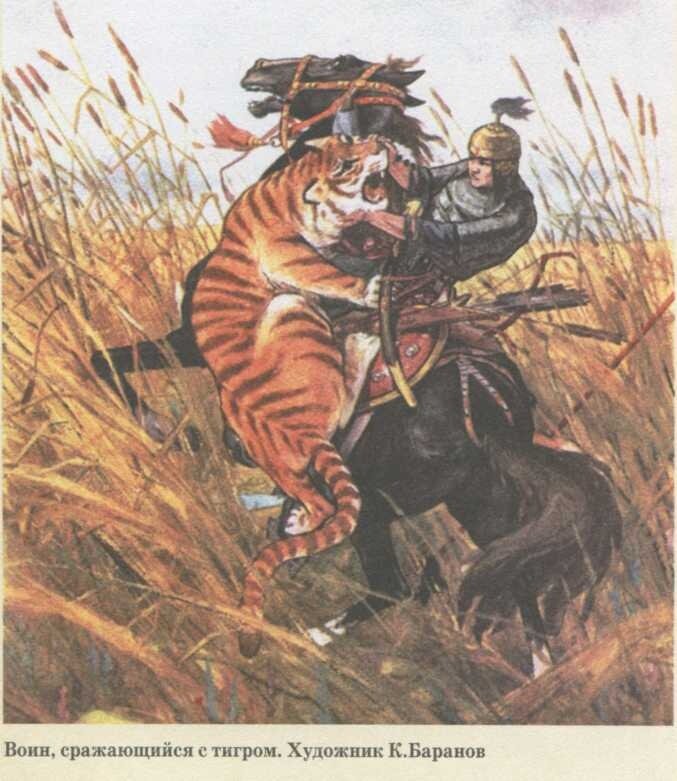
Abulmambet was Bolat khan’s son. Abulmambet ruled over several clans of Naimans, Konyrats, and many Argyns. Nomad’s camps of Abulmambet were situated near Turkestan. After Sameke died the Middle zhuz recognized Abulmambet the khan of the Middle zhuz. Abulmambet became the khan and like Barak khan sent his son to Dzungaria as a hostage. On August 28, 1740 Abulmambet, Abylai and about 120 sultans and eminent heads of clans arrived in Orenburg and concluded an agreement about the protection the Middle zhuz by Russian Empire. Abulmambet lived in Turkestan since 1743 where he had been rivaling with sons of khans’ Sameke seyit and Yesim for about three ten years for power and political influence on neighboring nomadic and settled-agricultural population and he asked support from Dzungar khans in the 40s. After Abulhair khan died Abulmambet got the nominal status of the head khan in the Steppe. He was Ablai sultan’s protector who had a personal affection to him and trusted and respected him as the closest relative among contemporary khans. The eighth war between Dzungar khanate and Kazakhs was at the time of his reign in 1739-1743The reason of this war was Galdan-Tseren’s striving for punishment Kazakhs of the Middle zhuz for their attack on Oirats at the period of the third war between Oirats and Tsin (1729-1739). In May of 1741 the war ended, rulers of the Middle zhuz recognized the citizenship of Dzungaria and sent hostages to Galdan-Tseren’s palace. Later Abulhair khan sent his son as a hostage. Belated Russian troops leaded by a major K. Miller were sent from Orenburg to Dzungaria in 1742-43 with a request to stop Oirats’ war actions against Kazakhs of the Middle zhuz as they were citizens of Russian empire. Однако However Russian representatives were not admitted to the huntaidzhi by the general-governor of North-West Russian Dzungaria Sary-Mandzhy under the pretense of rife and rampant smallpox in Dzungaria. In 1743 Ablai sultan signed the peaceful agreement in urhe and was set free. In the same 1743 Kara Kalpaks took Dzungar citizenship. In 1758 Abulmambet had a conflict with Sameke’s son, Yesim-sultan which lasted to 1762 until Kazybek bi at Bi’s court decided to share Turkestan between Abulmambet and Yesim. In the years of Abulmambet’s reign Ablai was the virtual ruler of the country. Abulmambet died a natural death in 1771 in Turkestan and was buried here.
Joining of Kazakhstan to Russia
1731 –Establishment of Russian protectorate
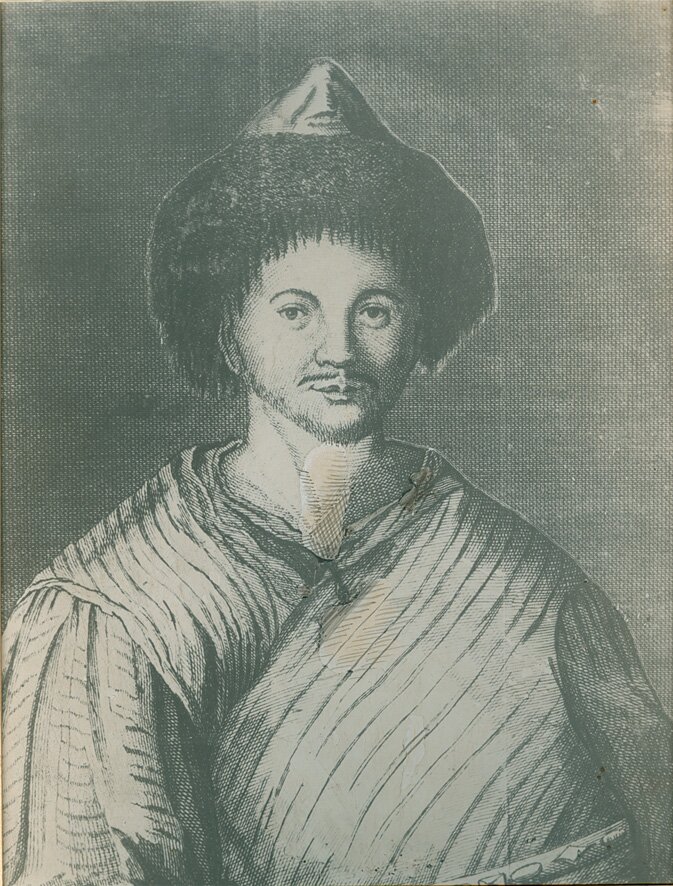
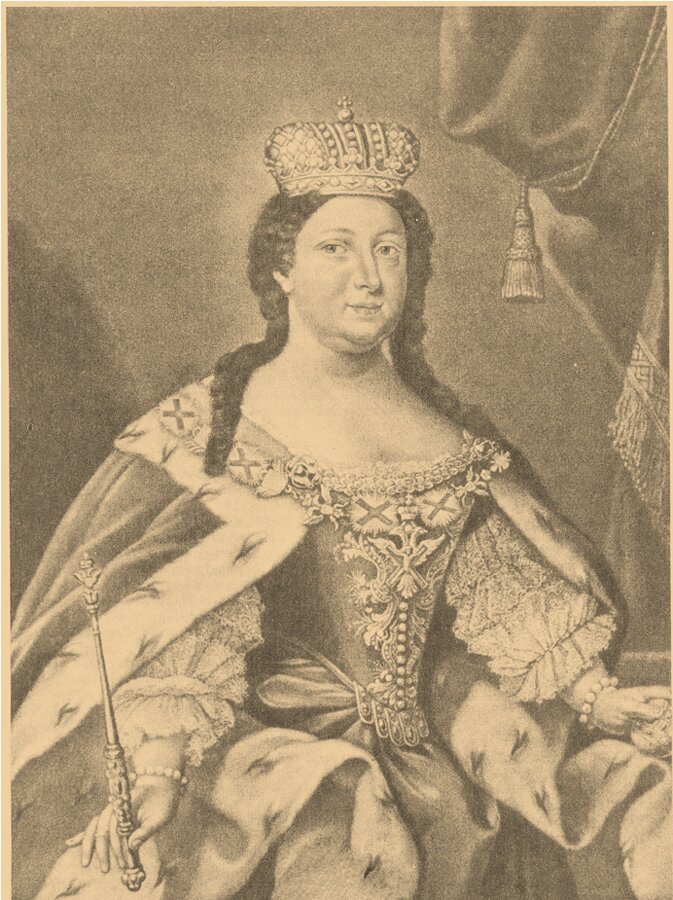
In 1730 Abulhair sent the embassy to Petersburg. Official mission of the embassy was regulating relations between Kazakhs and Bashkir; however envoys announced verbally Kazakhs’ desire to take Russian citizenship. This step of Abulhair was not coordinated with Kazakh nobility and other rulers . 1731 года September 8 (19) 1730 envoys of the Younger zhuz were taken by Empress and their request about citizenship was not complied by the decree of 19 February (2 March) 1731. Special Russian embassy leaded by a translator "oriental languages" of College of foreign affairs murza A. I.Tevkelev (1674-1766) was sent to the Younger zhuz by Anna Ioanovna on April 30, 1731 administration of oath of Abulhair. On October 5 Tevkelev with 60 people arrived at Abulhair’s headquarters on the right coast of the Irgiz River in Maitube where he was met by khan’s elder son Nuraly sultan with several noble sergeant majors and batyrs. On October 10, 1731 Abulhair took the oath to be true to Russian emperor’s throne at the congress of Kazakh foremen of the Younger zhuz during a sharp confrontation. The lists of the oath were signed by the khan and noble batyrs of the tribe Zhetiru Bokenbay Karauly (died in 1741), Yeset (1667-1749), Kudaynazar-murza and 27 noble foremen. Kazakhs were obliged to be true to Empress and her heirs, agreed to limit outer sovereignty of the khanate, were obliged to serve, not to attack the trade caravans and Russian citizens, return prisoners, pay yasak and assign children of khans and sultans as hostages. Russia was obliged to protect own new citizens from outer attacks and oppression. On the first period of joining problems of internal political life of Kazakhs were not touched.
1735 –Foundation of Orsk. (called Orenburg)

On October 10 (21), 1731 considerable part of the congress of Kazakh sergeant majors leaded by Abulhair khan supported adoption the document about voluntary joining of Kazakhs of the Younger zhuz to Russia. In this respect Abulhair khan requested to approve succession to the khan’s throne forever in his clan and build a town with fortress at the Or river, where he would take refuge in a case of danger. Orenburg expedition headed by a senior-secretary of the Senate, a well-known scientist-geographer of ХVІІІ century Ivan Kiriilovich Kirillov was organized in May 1734 in order to strengthen positions in joined Kazakhs’ lands. The aim of the commission: all-sided study lands included to Russia, reconnassance of natural resources, building of Orsk fortress, establishment new border between Russian and Kazakh lands. Thus Orsk was founded on August 15 (26) 1735 as a fortress near the Preobrazhenskaya mountain on the left bank of the Yaik (Ural) at the confluence of the Or. The hydronium Or from Kazakh is «ditch». The citadel was built at the Preobrazhenskaya Mountain and the wooden church of Andrew the First-Called. The first name of the settlement is Orenburg; it was intended for protection from nomads and was fortified. Its building caused frontier war line along the Yaik. In 1741 the fortress was renamed Orskaya; and Orsk was changed to the lower part of the Ural. The fortress had an important place in the development Russian-Kazakh political and trade relations.
1743 –Foundation of Orenburg
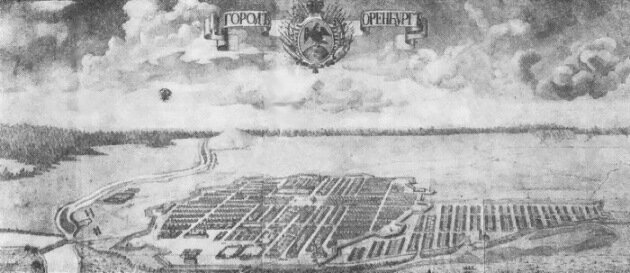
On August 31, 1735 Orenburgskaya fortress was founded at the confluence of the Or and the Yaik. The first place for the town was chosen in the course of I. K. Kirillov’s expedition, who took the lead of settlement the region. After he died V. N. Tatishev was assigned the leader of Orenburg expedition. He decided that a place was too inconvenient and also it was flooded with high waters in spring. Strong floods of rivers in this place caused the preparation for building new town under the previous name on the Red mountain, along the Yaik. On August 6 1741 it was founded. The old town was named Orskaya fortress (the present town Orsk). However building of town was started. On April 19 (30) 1743 Orenburg was founded for the third time, on the place of former Berdyanskaya fortress, which was situated 100 km from Krasnogorski hole. I. I. Neplyuev was a new head of the committee. In 1742 he chose a new place which is a historical center of the town. The town built on the Red mountain was named Krasnogorskaya fortress.
1748-1786 – Nuraly’s reign
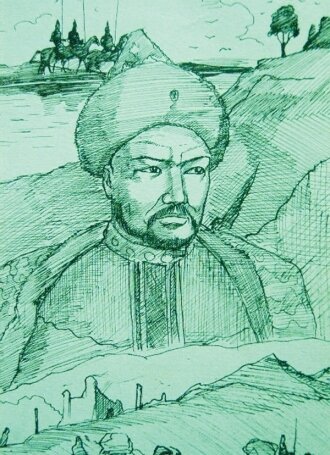
He was Abulhair and Bopai’s son. He ruled in Horesmin 1740-1742, in the Younger zhuz in 1748-1786. (02.10.1748-03.06.1786). On October 2, 1748 after his father died, he was proclaimed by elders of clans in the Younger and the Middle zhuses with a violation the number of important attributes of the steppe election rites. Council of Elders was convened for elections. There were about 1000 people. There were bis, batyrs, sultans from different clans in the Younger and the Middle zhuzes. The elections were held « unlike it was openly, but by chosen 10 people and outstanding bis moreover in the khan’s kibitka …All bis and outstanding foremen and Kyrgyz people who were in hansha’s neighborhood imposed Nuraly’s rule on them and on another day about 1000 people of all different posts departed». On October 5 1748 Nuraly and members of late Abulhair’s family spoke to Russian Empress with a request about confirmation the title of a new people’s elected representative " a head Kazakh khan" over otherrulers in the Younger and the Middle zhuses by the advice of the governor of Orenburg I. I. Neplyuev. On April 13, 1749 Empress Elizaveta Petrovn confirmed the title of "Kazakh khan" for Nuraly khan by a special patent and localized the field of his competence in сlans and tribes of only the Younger zhuz. In the end of 1748 the state salary of 600 roubles in a year was fixed for Nuraly khan Nuraly could not keep his father’s all lands even in the Younger zhuz. Several Kazakh clans recognized Batyr their khan. During the first eight years of Nuraly’s tenure as the head of nomadic population of East Kazakhstan, his rule was formally recognized by some departments of clans such as Shekty, Shomekey, Karakesek of Alimuly tribe and most of clans of Baiuly tribe in the Younger zhuz, also large groups of families of several clans of Kerei tribe and Shakshak clan of Argyn tribe in the Middle zhuz. In the 80s of XVIII century his political influence spread on the separate departments of clans Shekty, Karakesek, Karasakal and Karakete of Alimuly tribe and Baiuly tribe in the Younger zhuz. In 1749-1750 Dzungars’ embassy arrived to Nuraly khan, new ruler of the Younger zhuz. Achievement of the agreement is giving a daughter of Abulhair khan and a girl of Kalmyks in marriage to the khan of Dzungaria. The khan of the Younger zhuz must have got Turkestan and support in persecution of his father’s killer – Barak sultan for his consent for marriage between his sister and Tsevan-Dorzhi. The agreement caused uneasiness in Russia and apprehension among Kazakh nobility. Barak sultan was poisoned in April 1750. Intestine strives in Dzungaria and Tsevan-Dorzhi’s death impeded the marriage. In September 1760 the khan’s nephew Mambetali and 20 influential Kazakh foremen from different clans were killed by participants of Russian geological reconnaissance party in the steppe. It caused a fierce indignation among different clans of the Younger zhuz, which was followed by change the governor of Orenburg. According to the tsar’s decree, which was issued in 1756, Kazakhs were not allowed to drive the cattle to the west Ural. Small pastures along the left coast of the Ural were trampled down by the cattle during summer and Kazakhs often had losses of the cattle. In the 50s of XVIII Orenburg authorities managed to strengthen Russian presence in the Younger zhuz by Nuraly khan’s force pressure and limited the freedom of khan’s actions in the field of foreign policy on one hand and on the other hand they conferred compulsory-punitive, control and partly fiscal functions and prerogatives on him which were not unusual for the steppe rulers. In 1771 Nuraly took part in crushing Kalmyks Shandy Zhoryk (Dusty march). Kalmyks went away from their territory located between the Volga and the Ural. Kazakhs tried to persuade the administration to cede this free territory. In September, 1773 he carried out negotiations with Yemeliyan Pugachev, but he did not dare to support him. At the end of life Nuraly became rather unpopular with Kazakhs. In November 1784 Syrym Datov opposed to the tsar’s administration of Nuraly. Russian authorities organized a punitive squad and Kazaks started to oppose to the administration starting from 1785 in big numbers. At one of the raids Russians seized Aishuak sultan who was in prison till 1787. It caused discontent among Kazakhs who realized Nuraly did not have a real power and Russian administration had all power. Under rebels’ pressure in April 1786 Nuraly khan had to escape to the tsar’s authorities. On June 3, 1786 Catherine II signed a rescript of removal Nuraly from khan’s rule. Niuraly was called out to Orenburg and was sent to Ufa where he died. He was buried in Ufa.
1752 –Foundation of Petropavlovsk
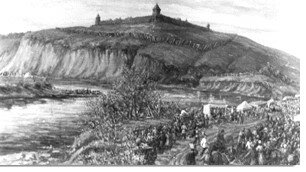
Petropavlovsk was founded on July 12, 1752 as St. Peter’s war fortress in South Siberia, Novo-Ishimsk defensive line of Russian state. In June 1752 the expedition consisted of dragoons of Lutski regiment, foot soldiers Of Noteburg regiment and the battalion of Vologodski dragoon regiment set out to the hole at the Ishim. There were about 2 thousands of people. Dragoons crossed to the right coast of the Ishim at the small pine forest situated opposite the flood Babashevo Lake. Two steep ravines which limited the construction area flowed to the Ishim and with a bank of the wide (about 47 m) river they created a natural bar for enemy. Expeditions had to build up a big fortress of St. Peter and two small fortresses called Poludennaya and Lebyazhiya and 8 redoubts between them in a short term.
1758 –Crushing of Dzungar khanate
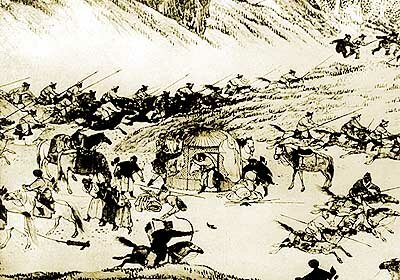
In 1755 Amursana, who was one of the pretenders to Dzungars throne, struggled for it and suggested to Chinese people to bring troops into Dzungaria and count on they will help to him to be a ruler of Dzungaria. Two detachments of Tsin Empire (according to different sources the numbers of made up from 90 to 200 thousands) in spring marched into the territory of Dzungar khanate. In the end of April two detachments united in the valley of the Borotal, near the Abinor Lake, reached the Ili River crossed it and set out further and did not meet any resistance. Many Oirats passed to Tsin army after they were informed that Amursana was going with troops. Tsin authorities spread a common administrational system which was adopted in conquered regions of Mongolia all over Dzungaria; All-Oirats’ institution was abolished. Tsin authorities founded 4 independent princedoms —Hoit, Derbet, Hoshout and Choros on the debris of the khanate and their rulers were placed under Pekin. Amursana reckoned to be a khan of all Oirats by the help of Tsin but was deceived. In September 1755 he escaped from Chinese army and rebelled against Chinese people. Amursana’s escape caused commotion in Pekin. Demobilized warriors were started to be returned urgently to the army Tsin troops crowded Dzungaria did not have an organized rival and started to exterminate all Oirats. Detachment found out Amursana hid in nomad’s camps of Ablai-sultan and they made their way to the Middle zhuz. In August 1756 the battle between Abylai-khan’s people’s volunteer corps and Tsin Emperor’s troops which ended by Kazakhs’ defeat and who started withdrawal to Russian lines. In the end of autumn of 1756 Amursana appeared again in Dzungaria after five-month residence in Ablai-sultan’s lands. In the winter of 1756-11757 he was in the Tarbagatai Mountains and knocked together new forces for struggle against Tsin Empire. In 1757 Amursana asked Russain government for help and got the consent. Amursana suffered a number of defeats and came to Semipalatinsk on July 28, 1757 for finding a shelter. He was taken by the local command and was conveyed to Yamyshevo two days later where he found out that was ill with smallpox. Amursana died on September 21, 1757. Chinese representatives ascertained Amursana’s death in 1758 and started to withdraw troops of China from Dzungaria. As a result 90% of Dzungars either died or escaped from Dzungaria to other countries.
1770-1805 –Pirala’s reign
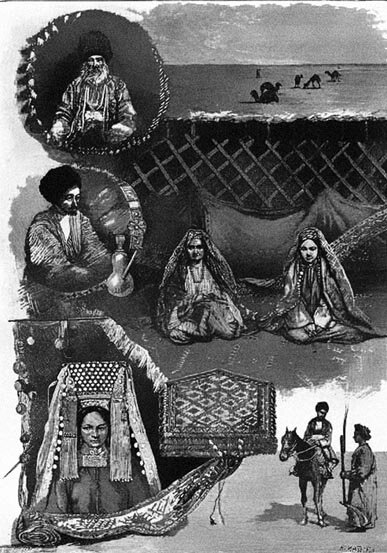
Nuraly’s son. In 1750-1752 he was as a hostage of Nuraly in Orenburg. After he returned to Steppe he roamed with his father for some time and then he ruled over Aday. In 1770 he was elected as a khan by the wish of Turkman in Mangyshlak and Kazakhs-Adays. In 1748 and on September 1791 he applied to a general-governor of Simbirsk and Ufa O. A. Igelstrom (1784-1792) with a letter about granting Russian citizenship to him and dependent people on him. His request was complied by the decree of empress Catherine I. On May 1802 he was confirmed as a khan of Turkman in Mangyshlak and Kazakhs-Adays by the emperor Alexander I.
1771-1780 –Ablai’s reign

He was Korkem Vali’s son, who was Ablai Kanisher’s son, who was Vali’s son, who was Dzhangir’s son. His real name was Abulmansur. The pseudonym Ablai was taken in honor of his grandfather. In the years of Great Disaster (Aktaban Shubrundy) his father was killed. Ablai’s family died at that time. He was rescued by a slave Oraz. At first they escaped to Urgench and he worked as a shepherd of famous Tole bi and then they went to Saryarka and there they were workers of Dauletkeldi. Ablai got to know poverty and humiliation in farm hand. Tole-bi called a poorly dressed and thin boy Sabalak (dishevelled). But in spite of poverty Abilmansur always behaved with dignity and liked loneliness. In spite of there are rumors in literature that Ablai killed his servant Oraz he, in fact, paid a bride price and married Oraz after he became a sultan. Oraz’s descendants still live in Shucinski district of Akmola region. Sabalak heard Abulmambet gathered Kazakhs for fight with Kalmaks, came to Dauletkeldy and asked his permission to take part in the war. Dauletkeldy gave a horse (well-known Shalkuiruk) to Ablai. Ablai beat a Dzungar Sharysh at his first battle. After the battle Ablai found a relative and in 1735 assigned him a ruler of the clan Atygai. In 1740 Ablai with Abilmansur took Russian citizenship. Then Ablai was taken prisoner to Dzungars. Ablai was in a prison till spring of 1743 and he was released after Abulfeiz sultan came, who was a hostage from Abulmambet. In prison Ablai married Galdan-Tseren’s niece, Topysh-khanum (Mergen’s daughter). In 1750 Ablai took part in civil wars between Dzungar rulers. In 1756 at the age of 45 he was injured in the unequal battle with Tsin army at the Irtysh. His left thigh-bone was injured and the fracture was well healed. In 1750-60 Ablai became a virtual ruler of the Middle zhuz under Abulmambet khan. In 1762 thanks to mediation of Ablai sultan and Kazybek bi Abulmambet managed to return Turkestan which was taken by Sameke’s son, Yesim who also pretended to the khan’s title. In the end of the 50s –the beginning the 60s relations between Kazakhs and Kyrgyz people became complicated. The reason of dispute was pastures in Zhetisu on the north from the Alatau, which were pretended by Kazakh and Kyrgyz people after crushing of Dzungaria. In the end of the 50s these lands were securely taken by communities of the Old zhuz, however in the beginning of the 60s the dispute of territory developed into the open war. In 1760 Kyrgyz attacked on the nomad’s camps of Dulat and Konyrat clans. In response Ablai gathered a big number of troops and in August of the same year he inflicted a defeat to Talas Kyrgyz. Nevertheless, Kyrgyz organized the march to Kazakhs in Zhetisu and destroyed Naimans’ auls in 1746. In the summer of 1765 the army of 30 thousand people under Ablai’s command crushed Kyrgyz again. By the end of the 60s Ablai sultan managed to strengthen the supreme power in most of the regions of Kazakhstan. The Middle and Old zhuses were under him and he ties of relationship by dynasty marriages with rulers of the Younger zhuz. At this period Ablai started to be called a khan in the official correspondence although old Abulmambet remained as the supreme ruler. In 1768 he was recognized as« commander of all Kazakhs and sultans» by Tsin Emperor. Also in the end of 1769 he asked Russia to assign 10 000 strong army and offered one of his sons as a hostage. Conditions for election Ablai as All-Kazakh khan after Abulmambet died in 1771. In the autumn of 1771 representatives of three zhuzes arrived in the old capital of the khanate Turkestan for election a new khan after long consultations. Influential zhyrau Buhar Kalkamanuly, Abulfeis and Bolat sultans, rulers of Kazakhs in the Younger zhuz, representatives of the Middle and Old zhusez except Nuraly rendered unreserved support for Ablai. According to Kazakh tradition Ablai was lifted on the white felt mat in front of the crowd and was proclaimed the khan of three zhuzes. According to A. Levshin he « obtained the above-mentioned title by victories over Torgauts and election not only by all Kyrgyz and Kazakh hordes but people in Turkestan and Tashkent after Abulmambet’s death». Thus Ablai managed to re-establish unity in Kazakh khanate although some Kazakhs did not recognize his rule over them. In 1774 Kara Kalpaks built a town Aulieata (Taraz) by Ablai’s order on request of foremen of Uisun clan, where his son Adil was assigned as a ruler. In January 1776 Ablai-khan met with a captain Brehov in Kokchetau for confirmation the title of the khan by Russian Empress. Empress recognized him as the khan only of the Middle zhuz; Ablai answered to it with demarche and did not come for the letter. Russians stopped paying salary to him and renewed the payment after they did not reach any successes. Ablai did not take Empress’s letter. Ablai died in 1780 and was buried in Turkestan.
1771 – «Dusty march»
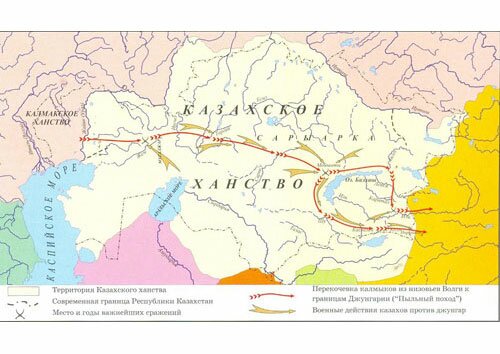
Under the influence of Russian’s pressure and religious factors, Ubashi khan and his surroundings gradually decided to resettlement in their historical motherland, Dzungaria. The plan was matured secretly, moreover relations of Kalmyks with Bashkir,Kazakhs and peoples of the North Caucasus did not look favorable. In January of 1771 Ubashi issued an order about roaming to Dzungaria with a purpose to capture lands near the Ili. According to different authors from 30 to 33 thousand kibitkas of Kalmyks besides 11 thousand kibitkas which stayed on the right coast of the Volga went away across Kazakh steppes. Kalmyks crossed the Ural and went along the Embe with their herds. Here Kazakhs leaded by Zhaman-Kara opposed to Kalmyks but they were repulsed. Ubashi khan wrote to Kazakh khan Nuraly about it: « Kalmyks lived in peace with Kyrgyz-Kaisaks and they must not offend Kalmyks now». However Kalmyks suffered great losses at affairs with detachments of Nuraly khan at the Embe River and the Mugodzhar Mountains. Tsarist government sent the war detachment for return Kalmyks. However the detachment of a general Traunberg did not make special efforts to pursue Kalmyks and pleaded that they went far inland of Kazakhs. In the north regions near the Balhash, the Moiynty River Kalmyks were surrounded by the detachments of Nuraly khan, Urus and Adil sultans, under Ablai’s command. They reached understandings about three-day truce. Three days later Ubashi khan with soldiers went out from surrounding of Kazakhs and made his way to the Balhash. Then they passed in a region of Kastek and Kaskelen. Other 20 thousand of Kalmyk soldiers under Taidzhi’s command passed along the north coast of the Balhash, across the Ayaguz, Lepsy Rivers. However Kazakh troops which pursued them, inflicted great losses to them and as a result a small part of Kalmyks reached China. In general, one tenth of Kalmyks were included to historical Dzungaria who came out from the lower Volga. Kalmyks were dispersed in different communes after they crossed the border. This march of Dzungars to East was called Shandy Zhoryk (Dusty March) by Kazakhs.
1773-1775 – Kazakhs’s participation in Yemelian Pugachev’s uprising
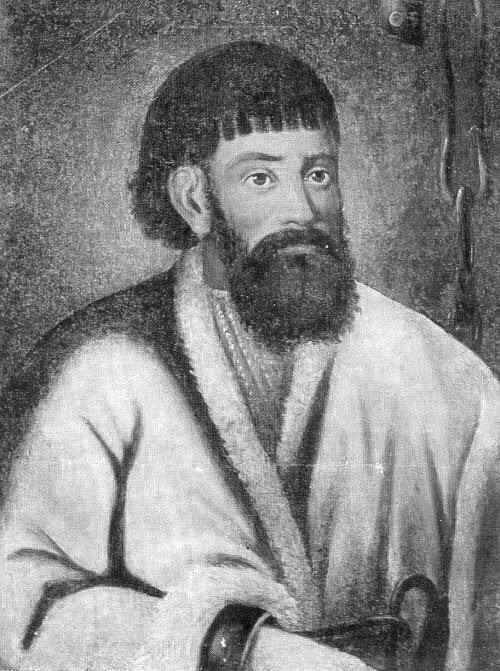
In September 1773 Nuraly carried negotiations with Yemelian Pugachev but he did not dare to support him. Nuraly did not support Ye. Pugachev openly therefore he sent his cousin Dosaly sultan in secret who took part in uprising of Yemelian Pugachev openly, his detachments (200 people) took part in the siege to Orenburg. In October 1773 200 people detachment leaded by Seidaly-sultan (Dosaly’s son) arrived the sieged Yaitskaya fortress. Dosaly’s three sons were on the side of Pugachev. Dosaly-sultan and his detachment with Pugachev’s people took part in a storm of Yiatskaya fortress. Kazakhs took part in Kulaginskaya fortress. Detachment of Kazakh rebels, leaded by « Kyrgyz khan’s son» also took part in the siege to Tatishevskaya fortress. He was killed in one of encounters during the siege. About 2000 Kazakhs supported rebels at different periods of the siege to Orenburg. Dosaly drew off from the revolt after failure near Yaitski town. Syrym Datov also took part in this revolt.
Joining of Kazakhstan to Russia
1781-1821 –Vali’s reign
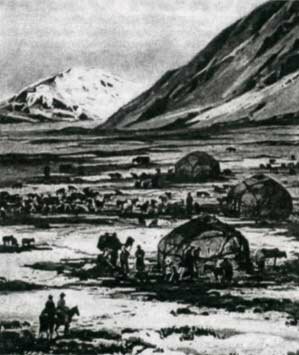
Son of Ablai and Saiman-khanym, Kara Kalpak bek Sagendek-Chuvakbai’s daughter. He was formally a supreme ruler of Kazakhs but in fact only Ablai’s descendants recognized his rule and he controlled Kokshetau and its suburbs. He was a ruler of Karaul and Atygai clans. In December 1781 Vali was proclaimed the khan and was lifted on the white felt mat in front of Tsin ambassadors, sultans and bis. There was funeral repast for Ablai khan and new ruler of the Middle zhuz was given rich presents such as the throne covered with gold, silver dish and a lot of silk fabric and paper money. About five thousand representatives of Kazakh tribes, including a Russian ambassador Chuchalov were at the election procedure. In the beginning of 1782 Vali made his way to Petropavlovskaya fortress where he took the oath to Russia and was recognized by Russian admiistration. In 1785-86 Vali and his brother took part in the unsuccessful war against Kyrgyz. In January 1795 2 sultans and 19 sergeant masters headed 120 thousand Kazakhs of the Middle zhuz sent in application to Russian Empress of removal Vali from the rule however this conflict was solved as a result of reached compromise between two sides. Weakening of the khan’s power brought to Kazakhs in Central Kazakhstan proclaimed Bokey their ruler in 1816 who was officially recognized by Russian government. Vali died in 1821.
1783-1797 –Revolt under the command of Syrym Datov
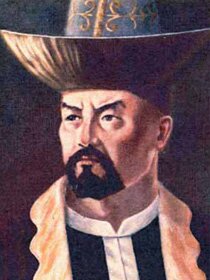
Syrym Datov was from Baibakty clan, Baiuly tribe of the Younger zhuz. He was Nuraly-khan’s trusted person until the beginning of the revolt. Winter of 1782-83 wassevere in the territory the Younger zhuz. Finally Kazakhs started to cross the Ural. Ural Kazakhs started to attack on Kazakhs. As a result of encounters with Ural Kazakhs Syrym Datov’s children died. In response Kazakhs attacked on Russian settlements. In one of affairs Syrym Datov was taken prisoners. O. Igelstrom was assigned as a new governor of the region and establishment of the Frontier court was announced in order to regulate conflicts between Kazakhs and Cossacks. There are attempts to implement reforms in the system of Kazakh clans in the Younger zhuz which would make it possible to Tsarist administration to establish the order. One of these attempts was convocation of peculiar steppe parliament — people’s assembly in 1785. At this kurultai three bis were elected for three tribal departments (Zhetiru, Alimuly and Baiuly), also Syrym Datov was elected as the first adviser of all the Younger zhuz. After the kurultai Nuraly apprehended for his life and escaped to Russians in 1786. In 1786 Syrym was taken to prisoners by Nuraly’s son, Yesim and was taken to Yeraly, Nuraly’s brother. In 1787 Syrym was released thanks to O. Igelstrom’s activity. O. Igelstrom was removed from the rule in 1790 and in 1791 Yeraly was proclaimed the khan. In response Syrym Datov declared the war against Russia and killed its placeman Yesim who became the khan after Yeraly, many raids which did not stop during ten years were started to frontier line. In 1797 Syrym Datov, who was pursued by sultans, had to roam to the south, lands of Hiva khanate with fellow tribesmen. He died in 1802.
1784-1799 –Hanhondzhi’s reign
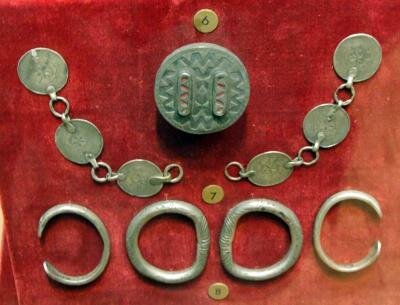
Son of Barak-khan (1749-1750), stepson of Abulfeiz-sultan. He was adopted by Abulfeiz sultan at the age of four, who married his mother for love, a Volga Kalmyk, who was married with Barak khan. After stepfather’s death he was proclaimed the khan by foremen of many tribal groups of Naimans in the course of rivalry. In 1783 the title "van" (prince, monarch of the second class) was conferred on him owing to election Tsin emperor and in the beginning of 1784 he was officially recognized by China in his nomad’s camps with an ambassador of Tsin palace. Next years he kept up close political relations with Tsin Empire also relations with Russian frontier rules in Siberia. He had a considerable political influence on Kazakhs in east region. He died a natural death in own nomad’s camps. He had sons called Zhanbubek (Zhanhozhu who became the khan after his father and was recognized by China), Kushyk, Sivankul, Daniyar, Shalgymbay, Agadai.
1791-1794 –Yeraly’s reign
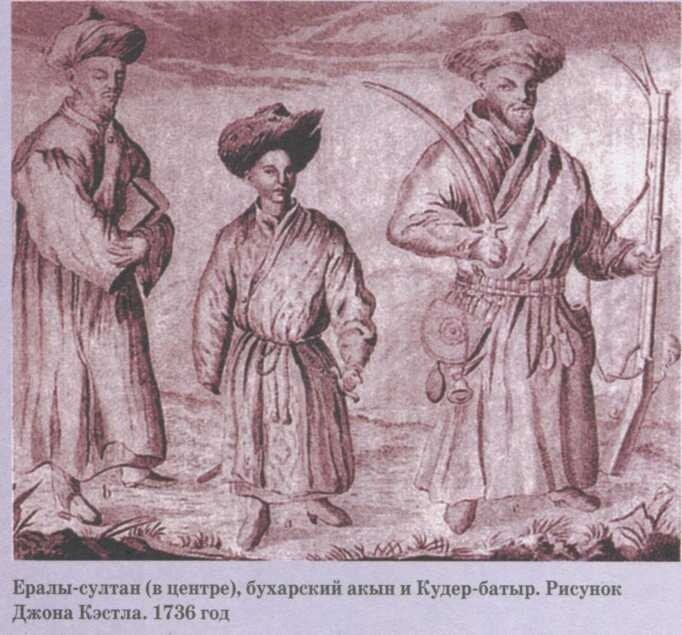
Son of Abulhair and Bopay. On January 29 the Empress heard about Nuraly’s death and decided to assign Yeraly as a khan. On September 4, 1791 under cover of troops fifteen versts from Orskaya fortress Yeraly was elected as the khan of the Younger zhuz and it caused concentration of insurgent detachments at the border of the steppe with a line. Syrym expressed his protest to administration about election of Yeraly khan. By September 1792 Syrym started to carry on a direct armed struggle against tsarism — he declared the war on Russia. The beginning of the armed war was attack of batyr and his 1000 people on Iletskaya zaschita fortress but rebels were repulsed then Syrym made an attempt of attack on Krasnogorskaya fortress but it also failed and Syrym did not get support. Before the declaration the war against Russia Syrym tried to punish the foremen who disagree with him. Then they started to oppose to Syrym with tsar’s troops. But people’s mass was supported by Syrym Datov. Syrym Datov’s fluctations and inconsistency revealed themselves in the period of new growth of people’s movement . He refused requirements of liquidation the khan’s rule and joined to requirements of many bis and foremen «to choose a khan, who would be dutiful». He carried out a struggle against Yeraly and started to focus on support of Abulgaziz Kaipov khan who pretended to the title of the khan of the Younger zhuz and was closely related with the khan of Hiva. Syrym Datov roamed to the Syrdariya in order to strengthen relations with Abulgaziz. In the summer of 1794 Yeraly died.
1795-1797 гг. – Yesim’s reign
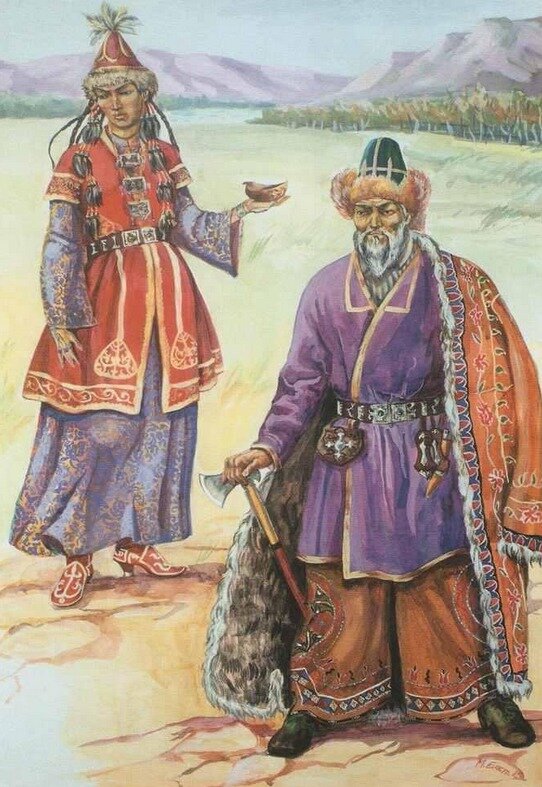
Son of Nuraly and supposedly of the khan of the Middle zhuz, Kushyk’s daughter. In September 1795 he was elected to the khan. A small group of foremen of the Younger zhuz took part in the official statement of election. On October 1796 Empress Catherine II confirmed his khan’s title officially. He did not have authority and influence on nomadic population of West Kazakhstan. Elevation of Yesim to the rank of the khan caused a big discontentment of influential foreman of Baibakty Syrym Datuly batyr (died in 1802) and of several foremen of the Younger zhuz who supported him and treated to this son of Nuraly-khan hostilely. On March 27, 1797 Yesim khan was killed by Kazakh foremen Tlen Korbas-uly of Kerderi, Otegul of Shekty, Kosbai-murza of Kete, Baimurza-Shomekei , Komurza- Alasha , Sholak and etc. Khan’s auls were destroyed, the cattle was driven, his family escaped to the internal side of the Ural and found a shelter in the town of Ural.
1797-1805 гг. –Aishuak’s reign
.jpg)
Son of Abulhair and Bopai. After Yesim died Igelstrom tried not to elect a new khan, to charge the khan’s Council with ruling over the zhuz and its residence was the district Hobda of the Malaya River. In August 1797 the khan’s Council started work, and Aishuak sultan was assigned as its chairman. However sultans elected Karatai sultan as the khan on their own, without attraction representatives of people and it caused a radical confrontation, at this situation Syrym roamed to the region of the Syrdariya and inclined to reconciliation with foremen that furthered the growth of authority of khan’s Council. Under the circumstances Igelstrom went to election Aishuak khan not Karatai and neutralized further Syrym’s actions as Aishuak’s authority was high. Karatai started to pursue Syrym during his roaming to Hiva and most of foremen turned away from him. Besides it he found himself out of his nomad’s camps where he could find a shelter. Soon news came from the lower Amudariya that Syrym Datov was poisoned. After Aishuak was elected, many Kazakhs who always roamed near the Ural took themselves to the steppe and refused submission to Abulhair’s descendants. Some of them joined to several tribes of the Middle horde and chose new houses for them; others crossed the mouth of the Syrdariya, crushed Kara Kalpaks and called Abulgazi Kaipov the khan. The third ones attacked Turkmen, made them cede some lands for them and took the largest part of isthmus separated the Caspian and Aral seas. Aishuak and several sultans had to cross the Ural and stay in Russia up to that time until common disarray quieted down in order to escape. On October 31,1797 emperor Pavel I was confirmed. In the autumn of 1805 he was removed from the rule by the emperor Alexander I "until extreme old age" with a pension of 1000 roubles by submission of the war governor duke G. S. Volkonski (1803-1817). Aishuak died in 1810 in own nomad’s camps.
1801 - Foundation of Bukei Horde
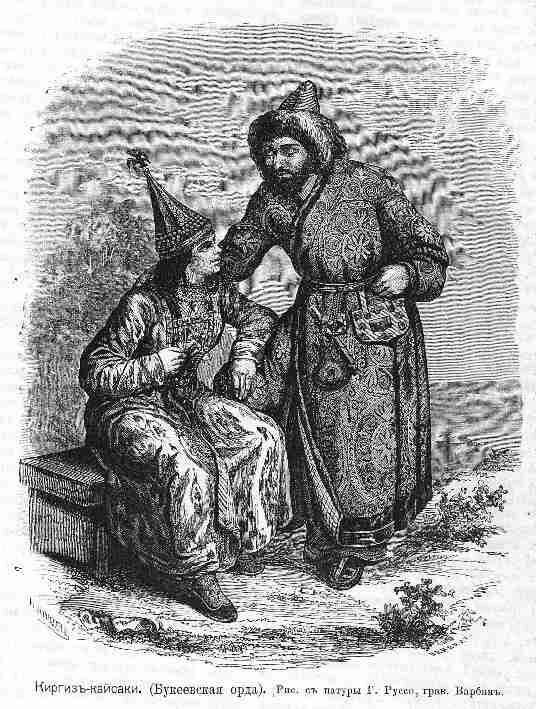
Bukei applied to the commander of the Caucasus line and the officer of the Caucasus marines a general-lieutenant K. F. Knorring with a request to inform the emperor about his wish to get the right for "unchecked roaming in the steppes between the Ural and the Volga rivers". On February 13 K. F. Knorring sent a relevant dispatch to Petersburg and a month later on March 11, 1801 Pavel I issued the decree addressed to of K. F. Knorring and permitted Bukei sultan to roam with dependent people on him to the territory of the lands between the Volga nad the Ural. By the end of 1802 5 thousand Kazakh families from different tribes of the Younger zhuz, mostly Baiuly tribe (some of them Alimuly, practically there were not families from Zhetiru) roamed with Bukei to the right coast of the Ural.
1801-1815 –the reign of Bukei, Nuraly’s son
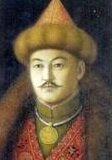
Nuraly-khan’s son. Up to 1801 he took a position of the chairman of khan’s council and roamed in steppes near the Ural. Rather intensive migrations of Kazakhs beyond the Ural had been lasting for last 10 years. In this period Bukey reckoned to gain the khan’s rule over Kazakh clans, which roamed beyond the Ural as he did not have necessary resources for struggle for the khan’s title on the scale of the Younger zhuz. According to the decree of April 25, 1810 by the emperor Alexander I who gave the right to nomads for election a new khan instead of killed Zhantore who was killed a year ago, Bukei sultan was lifted on the white felt mat on the right coast of the Ural on September 26, 1811. On November 11, 1811 Alexander I confirmed Bukei’s khan’s title officially, and on June 7 1812 Orenburg authorities held a solemn rite (confiramtion) of Bukei’s rank near Uralsk . He became the only legitimate ruler over the Internal and Bukei Horde, and the juridical status was defined as the appanage khanate dependent on the Russian throne.
1805-1809 – Zhantore’s reign
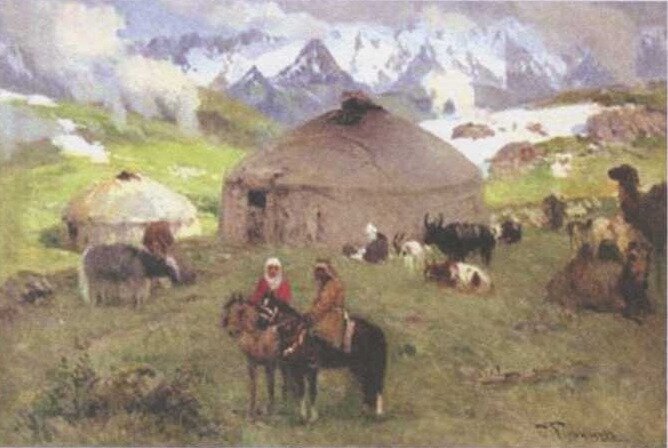
Aishuak’s son. In 1805 after Aishuak died a governor of Orenburg,duke G. S. Volkonski assigned Aishuak’s son Zhantore as the khan. The procedure of his elections was interesting. Volkonski understood most of influential rulers of tribes could follow Karatai and Volkonski staged this old rite. Baigushes who lived near Orenburg and "voted" for Zhantore were gathered together. They tried to conceal these "elections" from Karatai however he got to know the truth after he came to Orenburg. Karatai started to carry out an intensified agitation in the steppe against Zhantore. Most of influential foremen of tribal unity Zhetiru passed to his side. Authority of khan and tsarist powers fell to down. Znahtore was killed by Karatai sultan’s people near Mergen outpost on the Ural line in the morning of November 2, 1809 and got 27 knife wounds. His two wives and daughters were dishonored and left in the steppe. Organizers of murder were Nuraly-khan’s son Orman sultan and Yesim-khan’s elder son, Kara sultan, the main executor was Orman Nuraliyev’s son Shiman sultan.
1806-1824 –Karatai’s reign
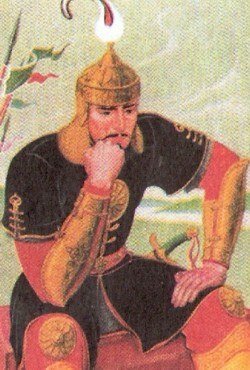
Karatai Nuraliyev’s reign. Nuraly-khan’s son who was born from the Volga Kalmyk called Ryss who was taken to prisoner by Nuraly in 1740. In August, 1747 the khan’s Council started its activity and Aishuak sultan was assigned as its chairman. However sultans elected Karatai sultan as the khan on their own, without attraction representatives of people and it caused a radical confrontation, at this situation Syrym roamed to the region of the Syrdariya and inclined to reconciliation with foremen that furthered the growth of authority of khan’s Council. Under the circumstances Igelstrom went to election Aishuak khan not Karatai and neutralized further Syrym’s actions as Aishuak’s authority was high. Karatai started to pursue Syrym during his roaming to Hiva and most of sergeant masters turned away from him. Besides it he found himself out of his nomad’s camps where he could find a shelter. Soon news came from the lower Amudariya that Syrym Datov was poisoned. Karatai accepted election Aishuak as a new khan. New blow to sultan’s self-esteem was in 1805 after Aishuak khan died Governor of Orenburg, a duke G. S. Volkonski passed over Karatai and preferred him his son Aishuak, Zhantore. Karatai carried out an intensified agitation against Zhantore. Most of influential foremen of Zhetiru tribal unity supported him. In 1806 he was elected the khan at the kurultai by foremen of 38 different departments of clans of Baiuly and Zhetiru near the Hobda River. On November 2, 1809 Karatai and Urman attacked headquarters of Zhantore and killed him. Seemingly this murder antoganized many followers from Karatai. Some of them including Urman sultan were arrested. After that this ally of Karatai died in Petersburg beaing arrested. In 1811 Tabyn clan recognized him as a khan. Karatai took himself to Hiva in 1810 where he lived to 1812. The Younger zhuz was leaded by the khan’s council. Another son of Aishuak Sergazy (Shyrgazy) became a new khan only in 1812 and was approved by Orenburg. Raids to Karatai resumed. War expeditions of Donskoi in 1812 and of Yepaneshnikov in 1814 caused crushing of auls which were faithful to Karatai but they did not manage to capture him. Volkonski decided to come to understanding. In 1814 he met with Karatai in Orenburg and unacknowledged khan signed a special obligation to be faithful to Russia and got presents from the duke. However Karatai did not refuse the khans’ throne. After liquidation the khan’s institution in the Younger zhuz in 1824-1826 he took a post of sultan-ruler of the West part of the horde in Orenburg department. He died on June 3, 1826.
1812-1824 –Aishuak’s son, Sergazy’s reign
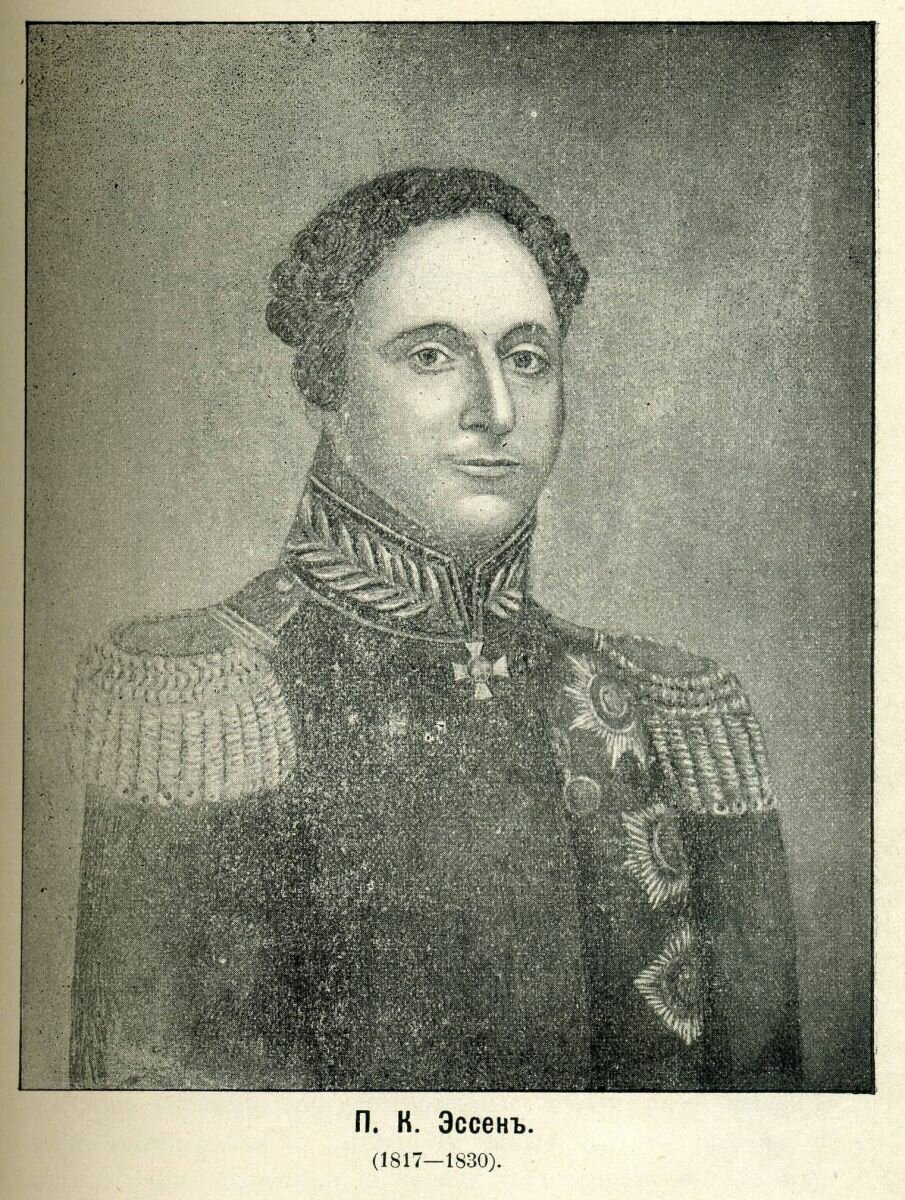
Aishuak’s son. He was elected to the khan in accordance with the decree of tsarist government on 25.04.1810, which allowed Kazakhs of the Young zhuz to elect a new khan instead of Zhantore. He was confirmed as the khan on August 22 1812 near Orenburg. The general-governor P. K. Essen tried to reach confirmation Aryngazy Abulgazieyev as the khan with Sergazy Aishuvakov. Sergazy understood his minimal rule could be disappear and agreed with any conditions of keeping up «sole» rule. It suited Russian government and after long arguments it refused imposition of a position of the second khan in the Younger zhuz. Sergazy’s rule spread several clans Zhetiru and separate clans of Baiuly and Alimuly. On May 1824 Sergazy was called to Orenburg and was formally removed from the khan’s rule, gained a life title of the chairman of Orenburg frontier commission with monthly salary. In the middle of the 1820s he asked the khan of Hiva Allakuli (1826-1842) for support and hoped to return the lost title. On August 8 1827 by Allakuli’s "command" he was elected as the khan of Kazakhs of small department Shomyshly of Tabyn tribes which was ruled by Hiva. However the union of Sergazy and the khan of Hiva broke down soon. In 1830 he returned to West Kazakhstan from lands of the Ural and at the age of 78 he died in the steppe not far from Orenburg on August 29, 1845.
1816-1821 –Aryngazy’s reign
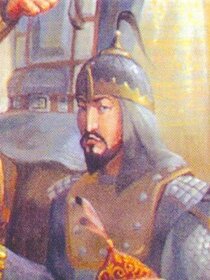
Abulgazy’s son, who was Kaip’s son. He was brought up in Buhara and then roamed to north region of the Aral with his father. On April 1816 he was elected as the khan of the Younger zhuz by Kazakh nobility. Aryngazy tried to create a strong Kazkh khanate by uniting nobility of the Younger and the Middle zhuzes. He reached recognition him as the khan by the emir of Buhara Haidar, also he was supported by Orenburg governor P. K. Essen for some time. Aryngazy rules over a large group of tribal departments of the Younger zhuz (about 100 thousand auls of Shekty, Shomekei, Zhagalbaiul of Alimuly tribe). In November 1816 people of Hiva attacked Kazakhs again. After 200 Kazakhs’ attack ob Kara Kalpaks (in December 1816) Muhammad Rahim-khan sent Suyun-bi, Dosym-bi and Iliyas shigavula to Kazakhs of Shekty which were ruled by Aryngazy. Yomuds, Choudors and Kara Kalpaks took part in the march. During the march 20 thousand of invaders were killed, 2 thousand Kazakhs were killed and 700 Kazakh women and girls were taken to prisoners. Aryngazy-khan escaped and hid in thicket. After these robbers’ raids several Kazakh sultans recognized the supremacy of the khan of Hiva. In March 1819 Aryngazy’s uncle, Sergazy-khan gave his daughter to Muhammad Rahim-khan.Then on November 21, 1819 Muhammad-Rahim-khan confirmed Sergazy-khan’s son, Zhangazy-tore as the khan of Kazakhs. The khan of Hiva was supported by his father and son and organized two raids to Aryngazy in 1820 and 1821. In 1821 Aryngazy was called to Petersburg according to the decree of Alexander I. In Petersburg he was captured by tsarist rules and was exiled to Kaluga in 1823. He died from pneumonia in exile in 1833. He was interred in Kaluga.
1815-1824 –Shigai’s reign
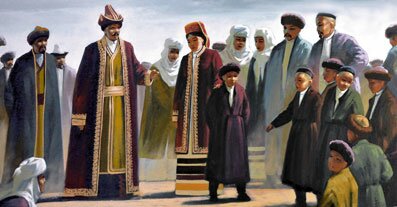
Nural’s son. He was a regent of Bukei Horde in 1815-1824. Bukey-khan died in 1815 and left the throne to his son Zhangir by his will and upon his age his brother, Shigai sultan temporarily ruled over the Horde. Regent of a young heir of the khan’s throne in the Internal or Bukei Hordes of Zhangir sultan (1804-1845). He was elected as the khan in the beginning of August 1816 in nomad’s camps of clans of Baiuly tribe. After that on October 29 1816 he initiated the application of Kazakh foremen who were dependent on him about confirmation him as the khan of the Internal Horde to Orenburg war governor duke G. S. Volkonski. However the tsarist administration which had necessary information about Kazakh foremen’s moods and Bukey khan’ young heir officially refused Shigai’s request. In the middle of 1824 he ceded the rule to a descendant Zhangir according to the decree of the Emperor on June 22 1823.
1816-1819 –Barak’s son, Bukey’s reign
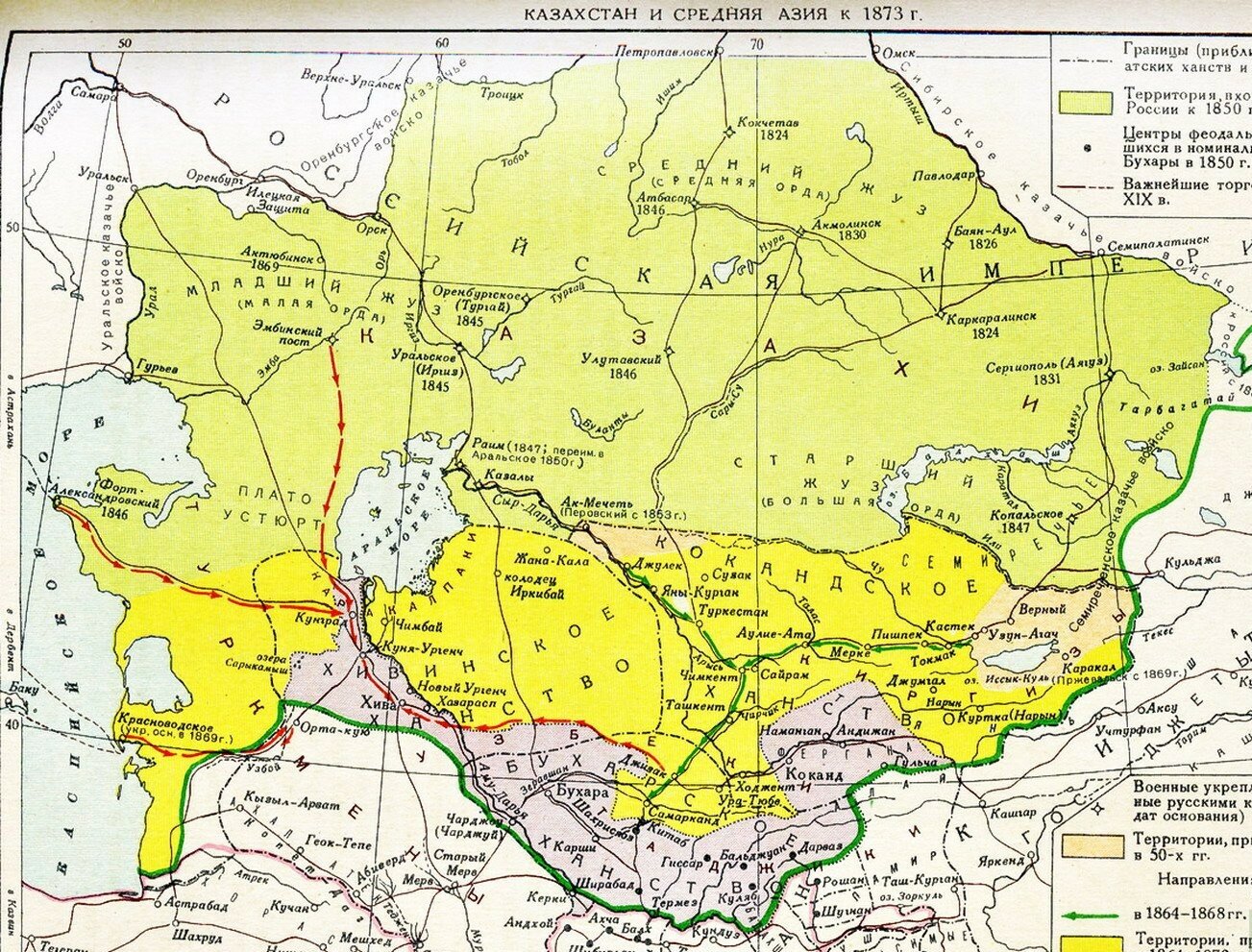
Barak’s son. After Bukei’s brother, Dair died in 1786 he could not reach election and kept ruling over his lands as the sultan. He ruled over Argyn clans which lived along the Nura River until his proclamation. In 1816 Kazakhs in Central Kazakhstan (some of Argyn and Naiman) proclaimed Bukei as the khan. Russians recognized him in order to reduce Vali-khan’s influence. At first Bukei lived in Iraq (suburbs of Turkestan) where 200 families ofrom Tashkent, Barak’s Tulenguts lived. After Abulhier was killed Barak was afraid of his life and his children’s life and sent Bulei to lands of Karakesek tribe. Having been the sultan in the 40-50s of XVIII century he came with his Tolenguts to Karkaralinski uyezd from Turkestan and the most famous of them are Bayan, Tleugabyl, Dzhanbyl and Dongelek. On arriving the steppe Bukei khan with his people was taken by Bigeldy clan and consequently was given "yenshi", that is to say allotment – lands and cattle. According to A. Bukeikhanov there is "hannyn-karatobesi" - "khan’s grey hill" which was called Bukei khan’s winter camp there. Bukei khan had eleven sons fron five wives.
1817-1819 –Kaip’s son, Sergazy’s reign
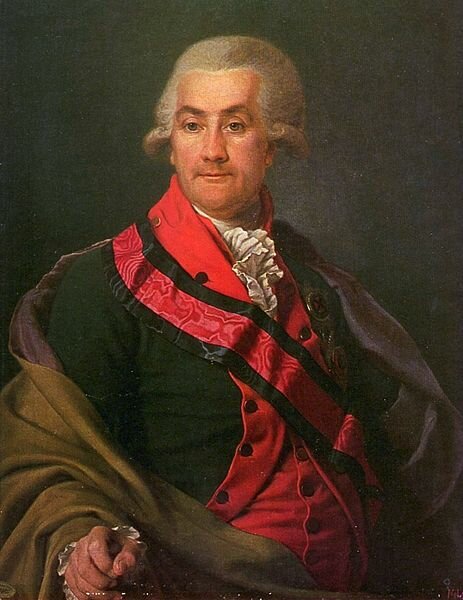
By command of the baron O. A. Igelstrom he was sent to Petersburg as a deputy from Kazkahs in 1789. He took part in Swedish war and was promoted to major. In 1790 he accompanied Russian embassy to Buhara and in 1791 he returned to Petersburg again and worked as the graph P.A. Zubov’s adjutant in 1793. In 1795 he came to Kazakh steppes during elections of Yesim khan and went to Simbirsk with S. K. Vismitinov, then was sent to Petersburg in 1796 whwere he lived to 1798. In 1798 he came back to Kazakhstan. On coming back to Kazakhstan he headed clans Shekty and Tortkara. In 1816 foremen of several Kazakh clans of the Younger and the Middle zhuzes elected Sergazy as the sultan and after that he supported his nephew Aryngazy sultan about striving for uniting Kazakh people and establish united Kazakh khanate.
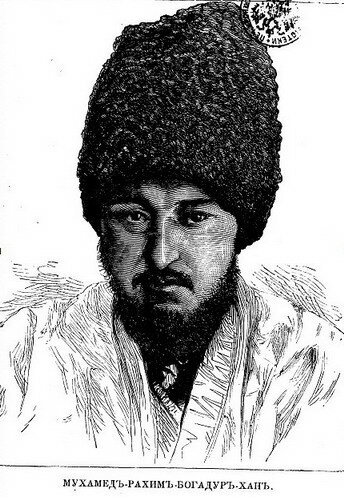
But in the spring of 1818 both relatives fell out and parted. Sergazy sultan took himself to Hiva and stated to serve Muhammed-Rahim khan (1806-1825 ). In the same year he was given a farman which confirmed him as the khan of "of west Kazakhs". He was elected as the khan by dependent Kazakh clans during support of the khan of Hiva. The khan of Kazakhs of Syrdariya in the Young zhuz (1817-1819) was not officially recognized by Russian throne, ruled over 2,5 thousand families of department Kishkene of Shekty clan, several clans of Shomekey and Tortkara of Alimuly tribe. He roamed along the Kuvandariya River and New road between the Syrdariya and Hiva khanate. Henchman of Muhammed-Rahim, the khan of Hiva (1806-1825). He died in Hiva.
1822-1825 – Zholaman Tlenshiyev’s Rebellion
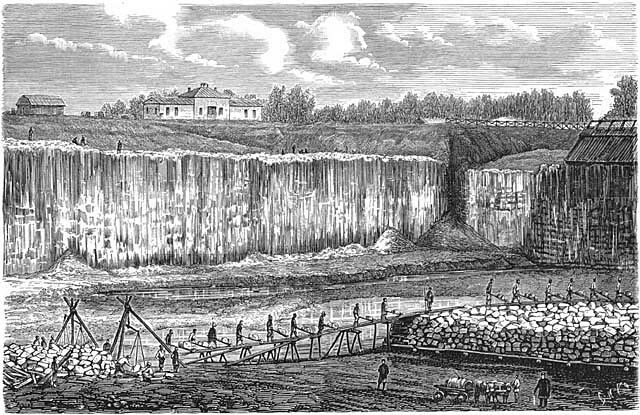
The Russian government appropriated all the new lands, located alongside the river Ilek, where the richest salt deposits were discovered. In 1822 a new rebellion against Russian government in Junior zhuz began. The leader of this rebellion was Zholaman Tlenshiyev – come from Tabyn – grandson of the famous batyr Bokenbay who was the Abulkhair khan’s team mate. Initial efforts of amicable regulation didn’t give any results and Zholaman had to raise the revolt. Three forces were organized against him by imperial government. The force of rebels couldn’t bear press and retreated towards the south of Khiva. In 1824 one more force was organized, by which the goal was achieved. In 1825 sultan Karatay’s force defeated the rebels, but Zholaman never recognized the imperial regime. Thereafter Zholaman joined Kenesary’s movement. The result of Zholaman’s revolt is the liquidation of khan’s regime in Junior zhuz.
1822-1824 – Gubaidulla’s rule
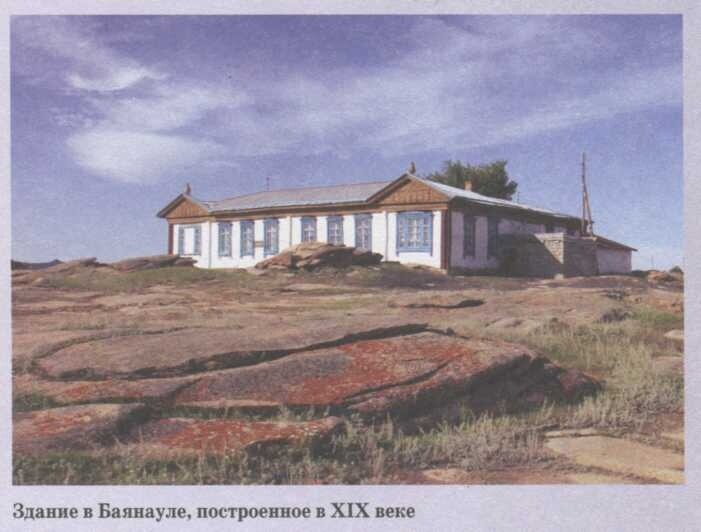
In 1822 Gubaidulla – the son of Valy-khan, the grandson of Abilay khan, the leader of the Atygai clan of the Argyn tribe, is entitled to the khan of Middle zhuz. Though Gubaidulla was the legitimate heir of khan’s title under the will of his father and the decision of Middle zhuz elders, he was not officially approved by the Russian government. Upon the death of his father – Vali-khan, Gubaidulla forwarded his ambassador to the Qing emperor – Daogun, requesting his approval of khan’s title. As a token of positive determination of the given issue, Qing government forwarded to Kazakh steppes their numerous ambassadors in return. But in 1822 the imperial government issued a decree about liquidation of khan’s regime in Middle zhuz and starts the realization of administrative-territorial reformations. In June of 1824, when the Chinese delegation comes to Bayan-aul district to raise Gubaidulla to the rank of khan, Siberian authorities arrest Gubaidulla demanding his abdication from the khan’s title. The latter was forced to obey, and gave notice to Qing ambassadors about it. The Chinese delegation returns back with no result.
1822 – adoption of the “Decree about Siberian Kyrgyz” and abolishment of khan’s regime in Middle zhuz
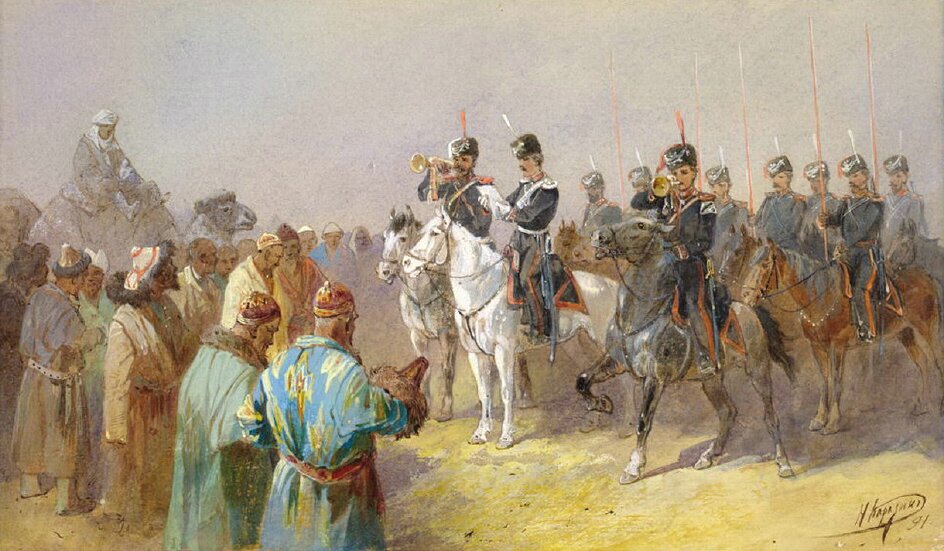
In 1822 Siberia was divided into two parts: East Siberia with its headquarters in Irkutsk and West Siberia with its centre in Tobolsk. In 1839 the centre of West Siberia was re-located in Omsk. The territory of the Kazakh steppe inhabited by Middle zhuz nomads was reckoned in West Siberia. This territory was called “Oblast of the Siberian Kyrgyz”. And in 1822 “Decree about the Siberian Kyrgyz” was developed under the guidance of Governor-General M.M.Speranski. The major objectives of “Decree” lay in abolishment of khan’s regime in Middle zhuz and joining of Kazakh steppes the Russian Empire. With this view districts managed by “district orders” were formed in the territory of Middle zhuz. Aga-sultans (elder sultans) conducted these orders. Two “Honourable Kyrgyz” and two Russians were appointed as assessors. The board of sultans elected an elder sultan for two years, who was awarded a rank of “Major of Russian Service”. The assessors were elected for two years as well. After three years of duty elder sultans were eligible for the award of “dignity of the Russian nobility”. One district consisted of 15-20 volosts. Each district had a highly restricted territory. Residents of one district had no right to cross the territory of other districts without any special permission of local authority. Any self-willed crossing was cruelly punished. Sultans (volost elders) were at the head of the volosts. According to their status they were treated as the bureaucrats of 12-th class, and their authority was administrative: execution of orders, enactments and judicial sentences. Each volost consisted of 10-12 auls. Aul elders were elected triennially and they were approved by the district order. Each aul consisted of 50-70 families. According to the Decree, legal cases were divided into criminal and civil. The most serious legal cases such as betrayal of Motherland, murder, robbery, barymta (cattle-lifting), snatching the Russian prisoners, anti-governmental strikes were exempted from a local court and sent to the imperial court. Pursuant to the medical unit of the Decree, the presence of a hospital and two doctors was required. The definite part of the decree dealt with education. The decree also introduced the tax system – each owner of a household had to pay the government “yasak” in the amount of one cattle out of one hundred heads, except camels, because they were needed for the development of trade. The first five years Kazakhs, who adopted “Decree”, were tax exempts. The Decree considered other types of duties – watching the coffles, horse-drawn services, post, control of lines of communication.
1824 – adoption of “Decree about the Orenburg Kyrgyz” and abolishment of khan’s regime in Middle zhuz
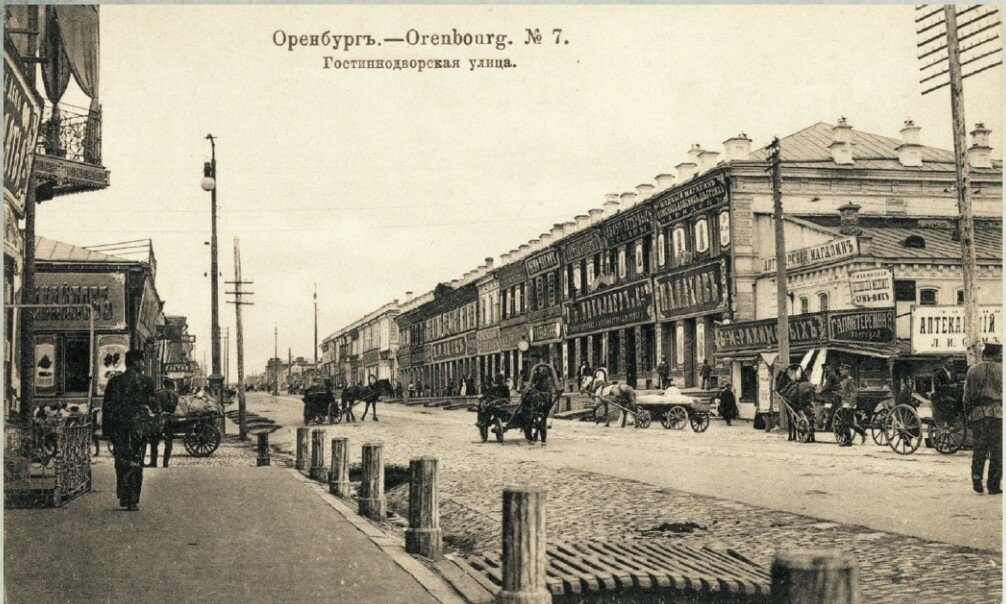
In 1822 the design of the Decree for Middle zhuz was created by the Orenburg Governor-General P.K. Essen and was confirmed by Asian committee. And the Russian government adopted “Decree about the Orenburg Kyrgyz” in 1824. As per this Decree, the khan’s regime in Junior zhuz, as well as in Middle zhuz, was totally defeated. Junior zhuz was controlled by the boundary commission. In accordance with the Decree Junior zhuz was divided into three parts – West, Middle, East. Sultan-governors, appointed at the head of the parts, as a matter of fact, were the bureaucrats of the Orenburg boundary commission, which consisted of a chairman, per four counselors and assessors from prosperous Kazakhs. In such a way the commission discharged functions of provincial government. Sultan-governors were responsible for maintaining order preservation in the steppe, having control over local bureaucrats among Kazakhs, organizing tax administration and prosecuting cases. The Governors of the parts of zhuz were appointed only by the Orenburg Governor, and other administrative officials were appointed by the Boundary commission. The position of the guardian of in-lineal Kazakhs was introduced as well. Court system foresaw all the big deals to be conducted by the military court or the boundary commission, but other inconsiderable deals were considered by the local courts.
1824-1836 – Sarzhan Kasymov’s Rebellion
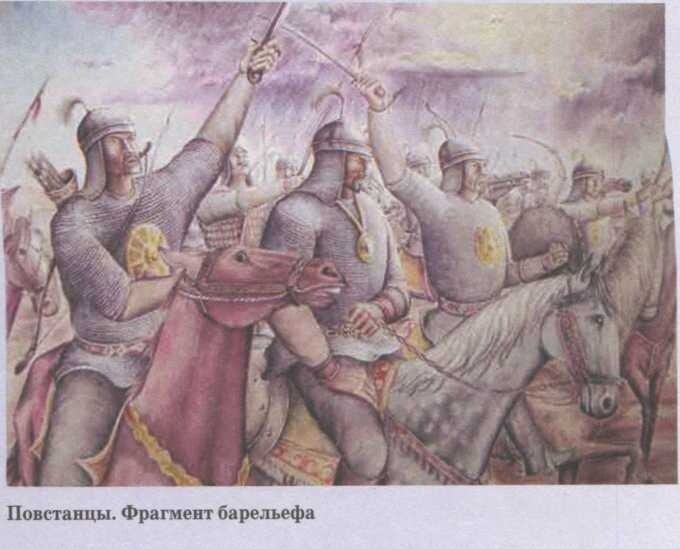
Sultan Gubaidulla’s exile to Siberia and abolishment of khan’s regime resulted in strengthnening the fight against Russian empire. Riots began in auls of Karkaralinsk district, Karpikovsk volost, which were under the authority of Sultan Sarzhan – the son of Kasym, the grandson of Abylai. In spring of 1825 antiauthority riots were strengthened in Central Kazakhstan where Abylai’s descendants’ influence was powerful. Imperial punitive force of 200 picked Cossacks, directed to the Karpikovsk volost on the individual orders of P.M.Kapcevich, supported by the artillery arm, went into action with Sarzhan batyr’s troops. Both parts incurred significant losses. The first face-to-face fight, arisen on January 31 of 1826, ended with military defeat of Sarzhan sultan; his “likeminded people”, who were imprisoned, were disarmed and put on trial. Sultan with his followers managed to outride pursuers, having migrated with numerous auls to Orenburg territory. He spent winter in Kidel-Kypchaksk volost nearby Troitsk. With this he wanted to engage in his revolt Kazakhs from Middle zhuz, who were not satisfied with Aryngazy’s arrest. Sultan Abylai Gabbasov – the leader of one of the Sarzhan’s troops, attracted a number of volosts. In Kokchetavsk oblast the revolt was leaded by sultan Sartai Chingisov. Representing Karaulsk oblast, striving for the re-union of Kazakh lands, he coordinated his actions with Gubaidulla, being totally under Sarzhan’s authority. In the second half of 20-s years the temporary stagnation took place in Middle zhuz: the government, taking care of strengthening of the already open in 1824 Karkaralinsk, Kokchetavsk districts and establishing Bayan-Aulsk district in 1826, refrained from accoutrement of big Cossack troops for persecution of arisen auls. Sultan Sarzhan with his delegation of 20 people visited Tashkent, and presented 80 horses to the local khan. Sarzhan batyr agreed to pay tribute to Tashkent as recognition of tashkents’ authority. Armour at the cost of 500 chervonets and a gold rimmed sward were presented to Kazakh sultan. In return, Sarzhan made a commitment to disturb auls under the Russian allegiance, capture one of the bitter partisans of Russia - sultan Konyrkuldzha Kudaimendin and crush his auls. Sultan Sarzhan’s rapprochement with Kokand, the possibility of developing anti-russian union hastened the continuation of all-out assaults of punitive forces against revolting auls. In the middle of 1831, the troop consisting of 500 people from Kokchetav unexpectedly attacked Sarzhan’s auls and defeated them. At the beginning of 1832 the Cossack force of 250 people under command of P.N.Kulakov forcedly arrested Kushuk and Esengeldy, killed 60 Kazakhs, ravaging Zhanaidar clan. On the 14-th March of 1832 Sarzhan’s followers at the amount of 400 people gathered at the Sulukol district and stole 1600 horses from the Kazakh followers of Russia, what became a serious concern in Akmolinsk order. Being oppressed by the imperial forces, still hoping for the support of Kokand khan, trying to cooperate separated strengths of Kazakh people of the region, Sarzhan moved to the territory of Seniour zhuz, endeavouring to draw over Kazakhs dependent to Tashkent government. This was the main cause of the conflict between sultan and kokan people. Tashkent’s governor gave the command to destroy Sarzhan. Sarzhan with his brother Esengeldy and the son Erzhan were killed in summer of 1836.
1824-1845 - Zhangyr’s rule
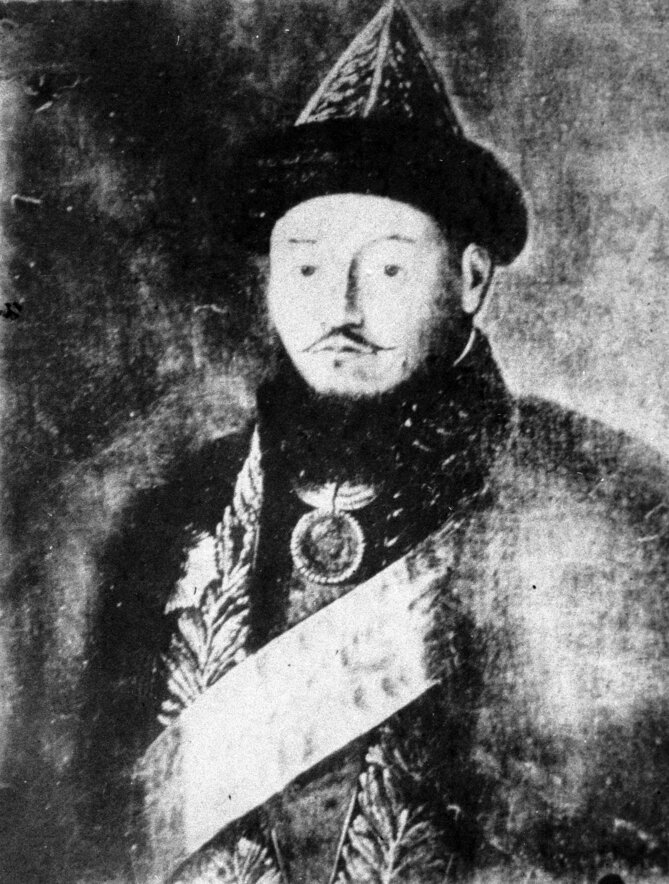
On the 22-nd of June of 1826, the emperor signed the letter of recognition for Zhangyr – the son of Bukey as the khan of Internal Orda. On the 26-th of June of 1824, with observance of ancient ceremony under control of imperial authority in Uralsk, he was entitled to khan. He had the title of major general of Russian armed forces. He gained his primary knowledge from the teacher-mullah, then he was put under care of Astrakhan governor – Andriyevski, the family of whose he lived in for almost ten years. In 1833 Zhangyr appointed his father-in-law – Karaul-khodzha Babadzhanov as the governor of clans, migrating nearby the Caspian Sea.
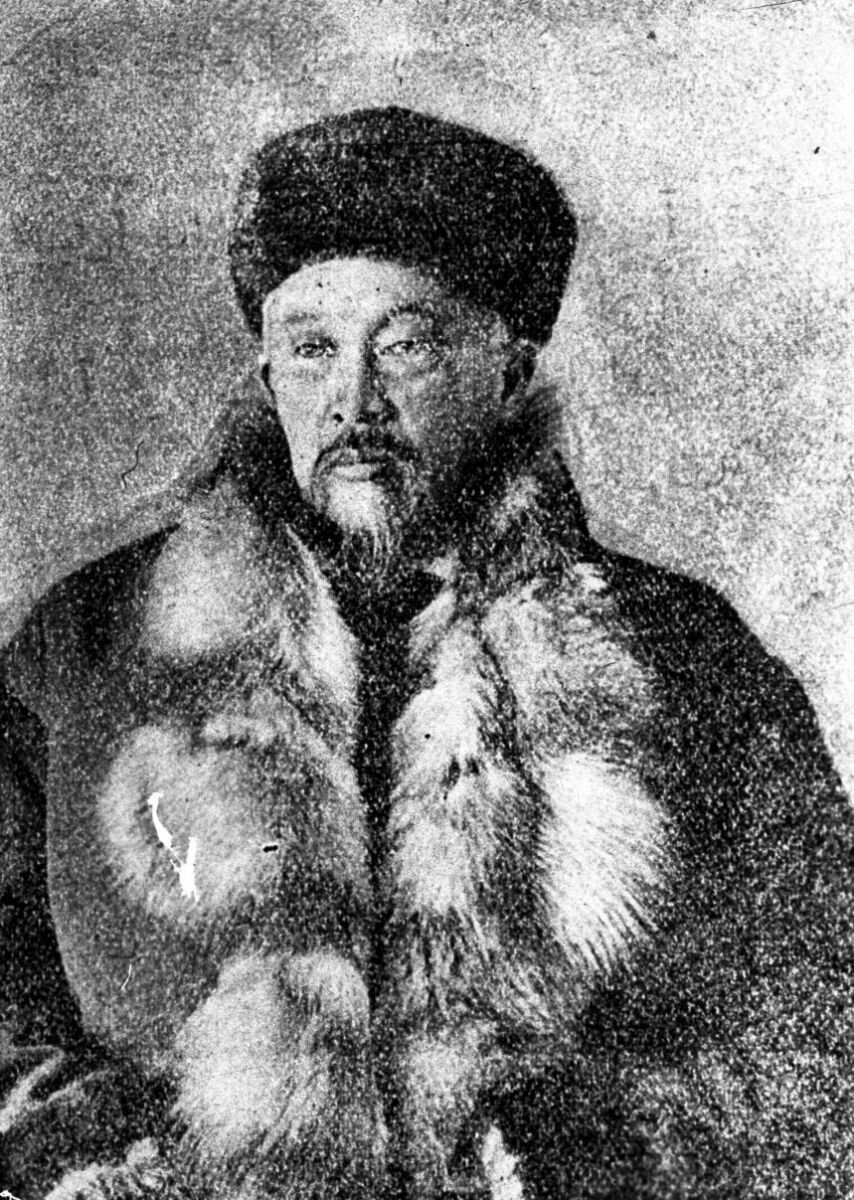
This became the one of the reasons of the revolt under the leadership of Makhambet Utemisov and Isatay Taimanov. On the 15-th November of 1837 they were defeated and went away outside Ural. In 1841 Zhangyr khan obtained the military rank of major-general. Khan Zhangyr died in 1845 and was buried in the village Urda ( the modern West Kazakhstan region).
1830-1850 – Kaipgaly’s rule

In 1830 Kaipgaly - the son of Esym and Karakushik-khanum, officially unrecognized by Russian authority, the khan from tribal subdivision of Kazakhs of Junior zhuz, the subject of Khiva, took power into his own hands. After the murder of his father in 1749, he and other children of the dead governor of Juniour zhuz were got away by their mother in Pre-Uralsk steppe and there he was put under care of his uncle Sultan Bukey. In 1827 Kaipkali began to call upon Kazakh elders not to obey the khan, not to pay tax into his treasury, to migrate from the interstream area of Volga and Ural to the east towards Pre-Uralsk steppes. Under the impact of these invocations, a part of Kazakh clans tried to move to the left side of the river Ural, for what Kaipgaly was arrested in his aul by the half-colonel of the Uralsk Cossack force – F.P.Bizyanov on February 28, 1828 and shut into the Orenburg prison. Having got liberty after eight months, he tried again to carry out his idea and at the beginning of 1829, he, being at the head of the big group of Kazakh clans of Internal Orda, crossed over Ural towards camping ground of west part of Juniour zhuz. On March 4 of 1829 he was arrested in the neighbourhood of Orenburg border by the ataman of the Uralsk Cossack force D.M.Borodin and firstly was sent to Uralsk, later on to Orenburg, where he with his comrade sultan Risaly Zhangiruly followed proceeding in border court and then he was shut into Orenburg prison for the second time. One year on, on the 10-th March of 1830, both sultans, with the connivance of security, escaped from the prison and went into hiding in trans-Uralian steppe. From March to the beginning of August of 1830, Kaipgaly gathered a big group of auls from different clans of Juniour zhuz and refugees from Bukeev orda, the elders who elected him as their khan in spring of the same year. At the end of 1831 the majority of auls from the strong and the militaristic clan Adai, who were exposed to devastating invasion of Khivas, joined the clans under his leadership. In January of 1836 ambassadors of the khan of Khiva Allakuli came to Kaipkaly’s aul, Karakul district, they invited him to Khiva for confirmation of the title of “khan of west Kazakhs” and proposed to move with his dependant clans from the Russian borders towards Khiva. In the next month, Kaipgaly, at the head of the group of Kazakh elders, made a return visit to Khiva khan. After coming back from Khiva, he acted as the representative of the Khiva khan, demanding his dependent Kazakhs to pay “zakyet” (tax) to the Khiva treasure. In 1837-1838 Kaipgaly joined Isatay Taimanov and Makhambet Utemisov, the leaders of the kazakhs’ liberation movement against Russia. He ran away to Khiva after the crush of rebellious troops by the forces of colonel K.K.Geke and Isatay batyr’s destruction on July 12 of 1838 on the river Akbulak. There Kaipgaly was approved by Allakuli-khan as the “khan of west Kazakhs” and some years on received an analogous approval from his successor – khan Rakhimkuli (1842-1846). By the direction of these khans, he made incursions on Kazakh auls which were under the protection of Russia and gathered tax from dependent Kazakhs for Khiva khans. At the end of the 40-th years, by means of messengers and sending letters to Kazakh elders of Juniour zhuz, he unsuccessfully tried to pull their clans and motivate them to move from Transurals towards Khiva. Due to the fact that Kaipgaly turned out to be incapable to meet expectations, laid on him by the new Khiva khan – Mukhammed-Emin, in the middle of the 50-th years of 19-th century he lost his khan’s title and property, and then he was placed in a special house under surveillance of Khiva authority. He died in Khiva being poor and was buried there.
1830 - establishment of Akmolinsk (Astana)
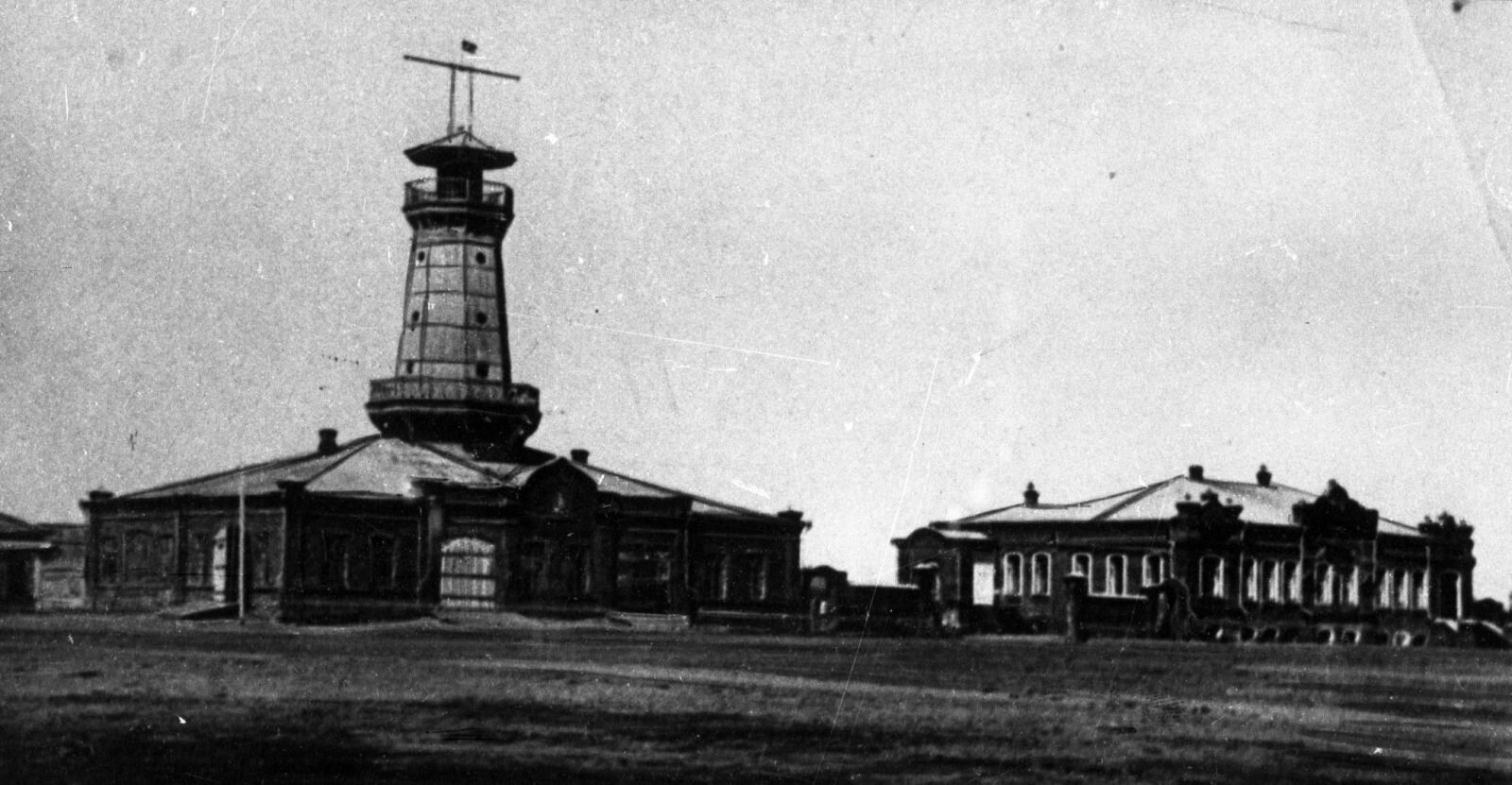
Akmolinsk was established as a Cossack outpost, the primary status was the order (Akmolinski). Later on the small tower developed into a town.
1832-1871 – the years of rule of Mukhammed-Salih Babadzhanov

In 1832 Mukhammed –Salih Babadzhanov – descendant of the clan Kozha, the son of Karaul-khodzha Babadzhanov takes the power. His sister – Khalima was the wife of Zhangyr – the khan of Bukey orda. He finished Russian-Kazakh school at khan’s headquarters. Afterwards he finished the Asian department of Orenburg Nepluyevsk cadet corps. From 1852 he was the government official of Orenburg Boundary Commission (in fact until 06.1853 - "on leave for family reasons" due to the partition of his father’s succession). In 1855 he was arrested with his two brothers for inciting to civil commotion. But he was set free and returned back to his position by the direction of the general-governor of Perovsk. From 1855 he was the counsellor of the Office Stationary of Khan’s board in Bukey orda. From 1866 he was the trustee of Kamysh-Samarsk part of Internal Orda. At the end of the 50-th years, on his own initiative, he forged close link with Russian Geographic Association and began to regularly forward to them his articles, stories and archeological and ethnographic items. In 1861 the board of the association, upon the recommendation of the ethnographic department, elected him as the member-colleague, and after a year awarded him the silver medal “For significant contribution in writings of ethnographic department and ethnographic subjects”. They were friends with Dauletkerey Shigayev – famous kuyshi. Mukhammed –Salih Babadzhanov was the first Kazakh who received an official award for his scientific works. His scientific works were written in the form of letters to the famous Russian ethnographer P.I.Nebolsin, who, with consent of the author, published them in capital newspapers. He was also awarded silver cup from Emperor Alexander (1870 y.).
1835-1865 - Shokhan Valikhanov
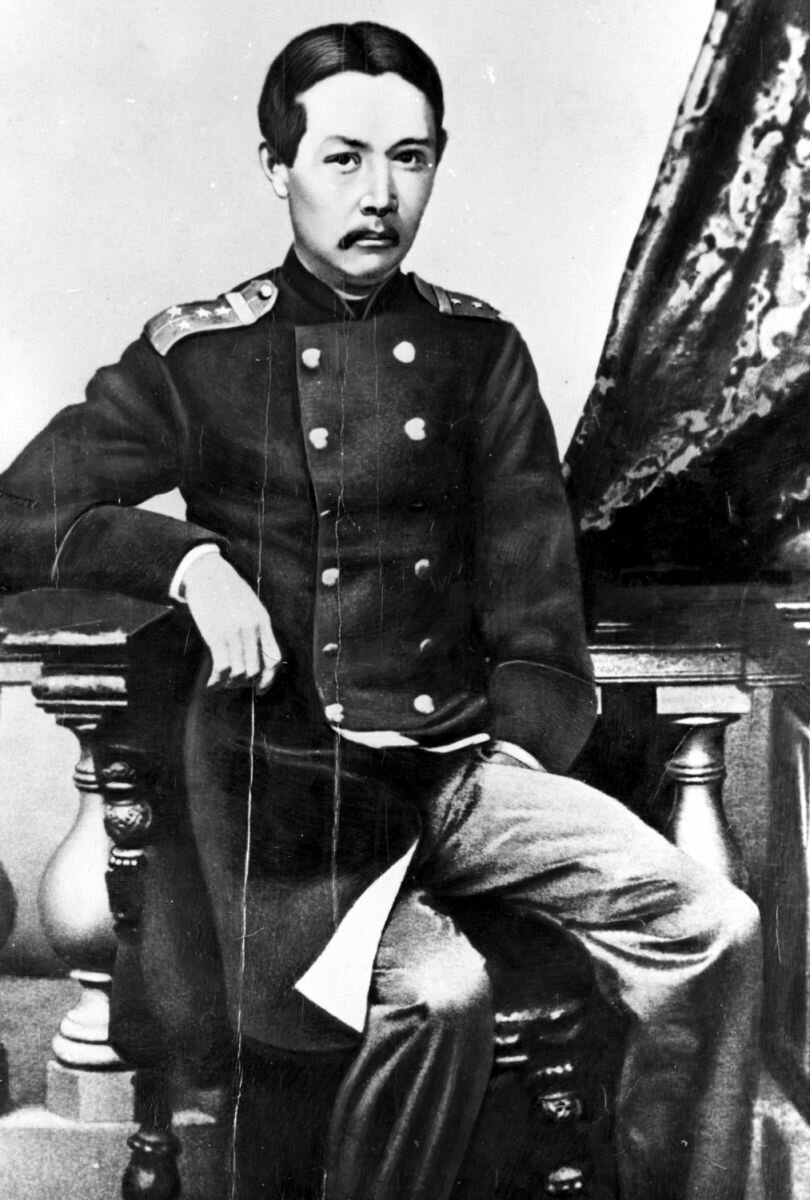
The son of Chingyz, the grandson of Valikhan – Shokhan was born in Kushmuryn (Kostanay region). The real name is Mukhammed Khanapia. Shokhan studied in private schools and learned basics of Islamic religious teaching until the age of 12. In autumn of 1847 Shokhan enters Omsk Cadet Corps. In the period of cooperative learning in the cadet corps Shokhan Valikhanov made friends with Grigoryi Potanyn, who became a famous scientist, the geographer and the researcher of Asia. Visiting Omsk, Shokhan got acquainted with Fedor Mikhailovich Dostoyevski, whom he held long-term correspondence with. In 1853 Shokhan, after graduating from the cadet corps, was directed to service in the Siberian Cossack force. Soon his capabilities were noticed by the general-governor of West Siberia – Gasfort and in 1854 Shokhan was appointed as his adjutant. In the next 1855 year, Shokhan Valikhanov escorts Gasfort in his trip from Omsk to Zailiyskiy Alatau. This trip was the beginning of Shokhan’s scientific carrier and gave him opportunity to gather and write a great deal of historical fables, legends and songs. In spring of 1856 an important event happened in Shokhan’s life, this event considerably determined his further destiny, it was an acquaintance with an outstanding scientist, famous geographer – P.P.Semenov. In the same year Shokhan Valikhanov took part in two expeditions – one from Alakul along Central Tien-Shan to river Issyk-Kul; the other in Kuldzha with diplomatic mission. In winter of 1856-57 he was busy with processing ethnographic data gathered during his expeditions and visited Omsk archives (where G.N.Potanin was working at that moment) aiming to find interesting, previously unknown materials form the Kazakh ancient history. In 1857 Shokhan made a visit to the Alatau Kyrgyz again, where, being among the nomads, he could learn better about their life and traditions, study deeper their history, ethnography and oral folk arts. He wrote down the encyclopedic poem of Kyrgyz nation – “Manas” with a keen interest. Shokhan Valikhanov’s academic carrier attracted attention of the Russian Geographic Association, which elected him as a full member in February 1857. A new stage of Shokhan’s academic carrier was his confidential trip to Kashgariya in 1858, as the result of which he wrote his famous work “About the condition of Altyshar or six east cities of Chinese province Nan-Lu (of minor Bukhara) (1858-1859)”. The work was highly estimated by the orientalists not only from Russia but also from other countries and soon it was translated and published in English. In 1860 on call of the department of the Army the researcher of Kashgarya – Shokhan Valikhanov could go to Petersburg, where he was welcomed as a brave traveler and an expert of lives of Central Asian nations and Kazakh steppes, awarded a medal and promoted. In Petersburg, Shokhan worked in several offices – military-accountable committee of the General Staff, Asian department and Geographic association. Map composition of Central Asia and East Turkestan, redaction of Ritter’s works, cooperation in publication of an encyclopedia, (where his famous article “Ablay” was firstly published), studying east manuscripts, lecturing on the history of East in the Russian Geographic association – all these took up a lot of time and had an impact on his health. In spring of 1861 he was forced to leave Saints Petersburg and return back to steppe for treatment. By that time Valikhanov’s family moved to zhailyau (summer pasture), where he spent the summer. Moving to Omsk, Valihanov participated directly in the activities of local government reorganization of the steppe and made a number of practical suggestions and recommendations. His main ideas were presented in a number of "Notes", submitted to the authorities, among them were: "On Islam in the steppe", "On the nomadic Kirghiz", "Note on judicial reform." In the spring of 1864 Valihanov participates in Chernyaev’s expedition, the purpose of which was joining of territory of southern Kazakh lands Russia. During Valikhanov’s life several Kokand fortifications, built by them in the Kazakh steppe, and Aulie-Ata were taken by Russians. Being the first lieutenant, he served as an interpreter at the major command, performing official duties, he was instrumental in establishing friendly relations between the Russian authorities and the local population, as well as a fair resolution of disputes between Kazakhs and Kyrgyz concerning pastures. But Valikhanov’s work in this field had not been long and in summer of 1864 he was forced to leave the squad because of disagreements with Chernyaev’s actions. Shokan came back to Vernyi, and then went to his relative’s aul Tezek. He died in April 1865 in the aul Tezek in Kochentogan district, at the foot of the ridge Altynemel.
1836 - 1838 - Isatay Taimnov and Makhambet Utemisov’s Revolt
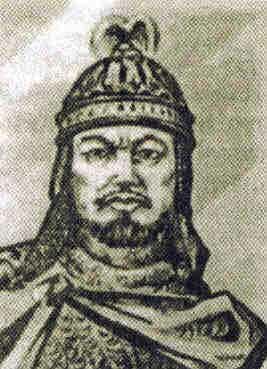
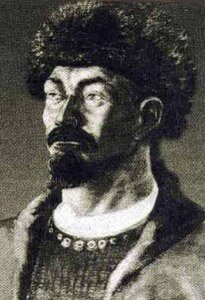
Before the revolt Makhambet Utemisov was a court poet at Zhangyr Khan’s headquarters. In 1833 Zhangyr appointed his father-in-law Karaul-Khodzha Babadjanov as the leader of clans migrating near the Caspian Sea. This was one of the reasons of the rebellion led by Makhambet Utemisov and Isatai Taimanov. The main reason for the revolt in Bukey orda was impoverishment of a large mass of Kazakhs due to insufficient quantity of pastures. Land territory of use declined steadily. In 1836 Isatay took the lead in the movement of the Kazakhs indignant with the capture of all the most fertile lands in the area between Ural and Volga by nobles of Internal (Bukeyev) orda, as well as the capture of lands nearby the river Ural by Cossack forces. During 1837 the armed rebel forces attacked the villages of rich Kazakh landowners, elders and sultans, stealing their cattle. But by the autumn of 1837 the combined troops of Jahangir Khan, Ural and Astrakhan Cossacks had inflicted a series of defeats on the insurgents, scattering them across the steppe. Issatay and Makhambet battled trough Ural, they were able to reassemble the troops under their command, but they couldn’t resist the forces battled against them from Orenburg and Ural Cossacks. Thus in November 1837 the rebels were defeated. The end of the rebellion was associated with the defeat of insurgents by forces of Colonel K.K. Geke on July 12 of 1838 on the river Akbulak and Isatai Taimanov’s death. Makhambet Utemisov with the survived rebels ran to the south, where he was subsequently killed.
1837 - 1847 – Kanesary Kasymov’s Revolt
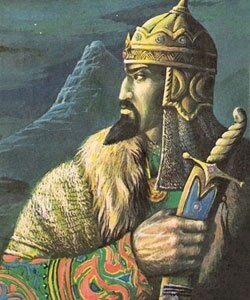
Kenesary Kassymov – Kasim’s son, Ablay’s grandson, regulated in 1841-1847. He participated in the uprising led by his brother Sarzhan Kasymov. He was captured by Tashkent. He served one year in zindan (Asian prison) until Kokand Khan Madali freed him. After Sarzhan’s death he headed the anti-Russian rebellion. Implacable opponent of Kenesary was the senior Sultan of Akmola district Konyrkuldzha Kudaymendin, a fierce struggle against the rebels were led by sultan-rulers of Junior zhuz Ahmed and Mohammed Zhantorins, sultans Ayshuakovs. After Kenesary’s transition to Zhetisu, three sons of Abylay Khan: Ali, Suuk, Adil - relatives of the leader of the liberation struggle held the uncompromising position against the rebels. Notwithstanding the opposition of a certain part of elders, biys, sultans including Middle zhuz’s, Kenesary Kasymov managed to unite under his banner a significant part of the Kazakh clans of three zhuzes. Sometimes Kenesary’s troop reached 20,000 people. The core of rebels consisted of ordinary nomads of Middle Zhuz. Military operations of Kenesary began in the spring of 1838 with the siege of Akmola order. Soon the rebels moved to the area of Torgay steppes. In letters to Orenburg officials Kenesary explains this step by his desire, being moved closer to Orenburg, to facilitate negotiations. In fact, the energetic Sultan set his mind in spreading the revolt to the expanses of Juniour Zhuz, adjacent to Russia, where in 1836-1838 the uprising led by Isatai Taimanov and Zholaman Tlenshiev took place. Zholaman Tlenshiev’s groups united with Kenesary’s forces.
1841, influential Biys, sultans of three Kazakh zhuzes elected Kenesary Kasymov as their Khan
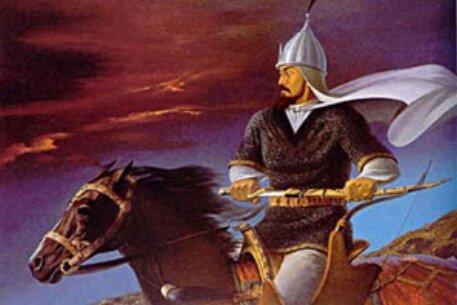
In the autumn of 1841 Kenesary’s troops besieged Suzak, Zhanakorgan, Ak-Mosque Zhulek fortresses, where substantial forces of Kokand were deployed. Taking of a few fortifications of Kokand inspired the freedom fighters. Even the clans Tortkara and Shekty, wandering away from the main centers of movement notified of their acceptance of him as the All-Kazakh Khan. Kenesary Khan was ordered to collect taxes: zyaket for pastoralists, ushur for grain farmers. At the head of Khanate Kenesary continued fighting for the liberation of the Kazakh lands more vigorously than before. Taking Kokand fortress Suzak, Kenesary intended not only to expand the war zone, but also to avenge the death of his close people. Until the year of 1843 the government has refrained from using major units of the regular army against the rebels, preferring to extinguish the main centers of anti-colonial movement by Cossack forces. By the order of Nicholay I on June 27, 1843 a large-scale military campaign against Kenesary was organized. Sergeant Lebedev’s force of 300 people was to become an advanced strike force, later the number of his force reached 1,900 people, and in August 1843 the second group led by Sultan A. Zhantorin and B. Ayshuakov was equipped. The battle of the warring parties on August 7, 1843 had not brought the desired results to the government. The armed group headed by Colonel Bizhanov, without meeting the basic forces of the rebels, returned to Orsk fortress. Kenesary, who knew the region, went on the offensive in the night from July 20 to 21 of 1844, and defeated Sultan Zhantorin’s squad. The army of captain Lebedev, for his slowness and failure to render immediate assistance, was removed from command of the military squad. Inspired by the victory, the main force of Kenesary attacked Yekaterininsky village on August 14, 1844 and burned suburbs, outer settlements, and 40 people were taken prisoner. In an effort to force Khan Kenesary out of Orenburg region, the government had built several fortifications in the area of the Aral-Syrdarya basin. Squeezed from both sides, Kenesary was forced to leave Saryarka and shift the center of the uprising to the territory of Seniour Zhuz. Siberian authorities, with the aim to define the arrival of Kenesary’s troops in the region, under the pretext of population and cattle census, significant military forces with artillery under the command of the Chairman of the Siberian Frontier Department General Vishnevsky were sent to Zhetisu. Khan Kenesary ‘s arrival to Zhetysu caused deep divisions among the population. In the summer of 1846 Kenesary took Kamal peninsula on the coast of the lake Balhash, where he intended to attract new villages to exert desperate resistance against punitive squads. The ten-thousand squad of the Khan with several instruments represented an impressive force. Having a combat experience from previous battles with punitive compounds, the rebels were well armed. Their firearms were produced by seven Khiva masters, who joined them in the active combat with Kokand khanate, but Kenesary’s geographical location was not very profitable, and he moved with his auls to the right bank of the Ili River and joined the forces of Sultan Rustem Abulfeisov. Being in Zhetysu Kenesary sent to the Kyrgyz rulers bimillenary squad to gather zyaket (tax) from the local population. But the first scuffles showed determination of Kyrgyz clans not to obey the dictates of the Kazakh Khan. Besides the main Kyrgyz rulers, having been warned of coming of the large armed forces with unclear intentions in the region, he managed to organize forces for countereffort. Out of the forces of two thousand people "almost thousands of naked and on foot came back, and declared complete defeat, and they fled". By mid-April of 1847 the Kyrgyz managed to combine core strength. Numerical advantage was clearly on the side of the opponents of the Kazakh Khan. The decisive battle took place between 17 and 25 April of 1847 in the deep gorge, nearby the modern Tokmak where the Kyrgyz managed to lure into a trap the Kazakh soldiers. Mountainous area didn’t allow the Khan to use his advantage in artillery and cavalry. Unequal fight that lasted for three days wore out Kazakhs’ strength; situation became complicated by the sudden retreat and withdrawal from the battle field of Rustem Sultan and byi Sypatay’s forces. Kenesary and more than 30 sultans were captured, others were "separated and scattered right and left". More than thousand men got captured by the Kirghiz and were put to death. On the third day after the captivity, Kenesary was executed by the governor Kaligula Alibekov, who, later for this capture, was awarded the silver medal by imperial government. Kenesary’s skull was given to the Russian authorities.
1837-1910 – Syzdyk Kenesaryuli
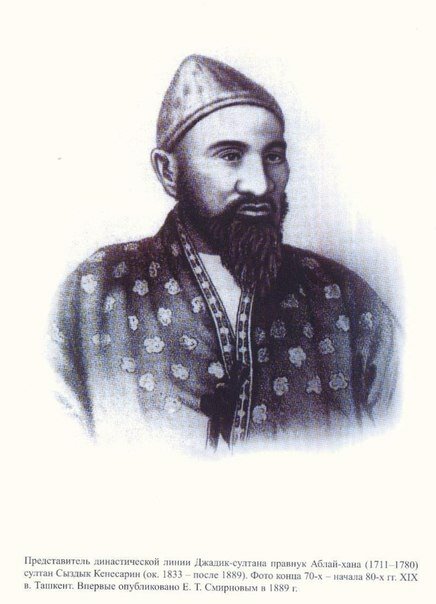
After death of their father, Kenesary’s children lived near Turkestan among Konyrats. Upon coming to maturity, Syzdyk and his brothers Ahmed and Tayshik entered military service. Kokand Khan appointed the brothers as commanders with the subordinates of 500 people under each. They participated in the Battle of Uzunagash where kokands were defeated by the Russians. After this, Ahmed and Tayshik defected to Russia and Syzdyk told them that he would keep going the path of his ancestors, and if Russian won Kokand, then he would go to Bukhara, if Bukhara was taken by Russian, then he would go to another state, because there are many other Muslim countries. Since 1863, Syzdyk sultan began to reign in Suzak. In 1864, when Colonel Veryovkin enveloped Turkestan, Syzdyk Sultan with his 120 riders (from Suzak and Chulak - Kurgan garrisons) went to Turkestan to help. Having found out about the beginning of the siege, Syzdyk returned to Tashkent. On September 21 of 1864 General Chernyaev’s force took Shymkent. From this place he moved to Tashkent, but under the walls of this city, Russian troops were defeated and forced to retreat. This event highly encouraged the Kokand ruler Alimkulov, former leader for the young Khan. Having gathered numerous armies at the Ferghana Valley, he went to meet Russian. On December 4 of 1864 the Russian force marched from Turkestan to the south. In the suburbs of the city they met a Kazakh volunteer who reported that kokands were already in Ikan. Nearby Ikan the fight between Russian and Kokand began, which ended with "Pyrrhic victory" and the retreat of Kokand. In 1865 Russian launched an offensive on Tashkent. Alimkulov was fatally wounded. The place of Tashkent chief military forces was given to the relative of Kokand Khudoyar Khan - Sultan Mir Sayyid, who even was proclaimed khan. Syzdyk took active participation in the further protection of Tashkent together with Rustam-bek from Tashkent and Kazakh Mullah Kushuk. Alimkulov ‘s death confused a number of the defenders . Kokand troops began to scatter. Tashkent was sought for 40 days. Among besieged people, there were ones who intrigued against Syzdyk. They were mostly kokands. Syzdyk asked for help from the Emir of Bukhara. Upon the arrival of help from Bukhara Syzdyk resigned as Chief of Defense of Tashkent and went to Dzhizyak. After that Cherniayev went there as well. He took him, but not for long, as Syzdyk’s 60 soldiers ambushed Russians, who were forced to retreat. In 1873, Kaufman went on a campaign against Khiva. Syzdyk led confrontation against Kaufman. After the capture of Khiva he retreats first in Balkh, then in Badakhshan, and then in Kashgar where he was directly involved in feuds of Yakupbek’s heirs, the ruler of East Turkestan. Here, for the first time, he took the fight against Chinese troops, who were already beginning their invasion of Kashgar. After fifteen years of incessant fighting, hardships, injures and frustrations, acknowledging that the fight was almost completely lost, Syzdyk decided to return home. From Ferghana Valley where he arrived in with his fellows, he sent a letter to General -Governor Kaufman: "As the saying goes - a fault confessed is half redressed - forgive my guilt, I will dwell here, and live with my brother Ahmet ..." Kaufman sent a doctor who cured his wounded arm for seven months. After recovery, Sultan was invited to Tashkent, and read out the royal command: "We forgive you. Live in our domains". Sultan Syzdyk settled near Shymkent with his younger brother Ahmet. He was given a land portion and pension. By personal instruction of Kaufman Emir of Bukhara returned back to his family.
1841-1889 – Ibragim (Ibray) Altynsarin
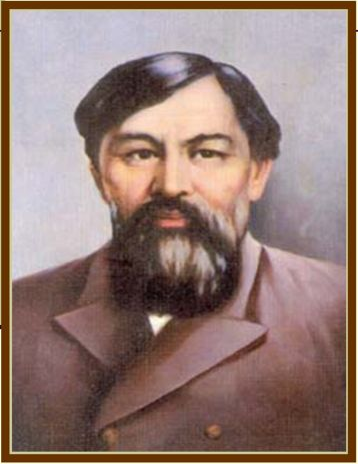
The first Kazakh teacher - educator. The author of Kazakh textbooks: "Kazakh reader" (1879, 2nd ed., 1906) and "Quick Start Guide to Learning Russian-Kazakh language" (1879), the author of fables and stories, as well as of translations of Russian writers. He opened four two-year colleges. Becoming an orphan in early ages, he was raised in the family of his grandfather, the famous byi, Balgozha Zhanburshin from Uzun – kipshak clan. In 1850, he was given to the boarding school at Orenburg Boundary Commission, and finished it in 1857. Then, for three years, he worked as a clerk under his grandfather Balgozha, force sergeant of Orenburg commission. For some time Altynsarin worked as a translator in the Orenburg regional board, where he met N.N. Ilminsky. Altynsarin also worked in Turgay provincial administration as the Clerk, acted as a senior assistant of district chief, temporarily - county judge. From 1879 to the end of his life – the Inspector of Kazakh schools in Turgay region. Ibray died on July 17 (July 29) in 1889 and was buried near his home on the bank of Tobol River, near the grave of his father.
1845 – abolition of khan’s regime in Bukey Orda
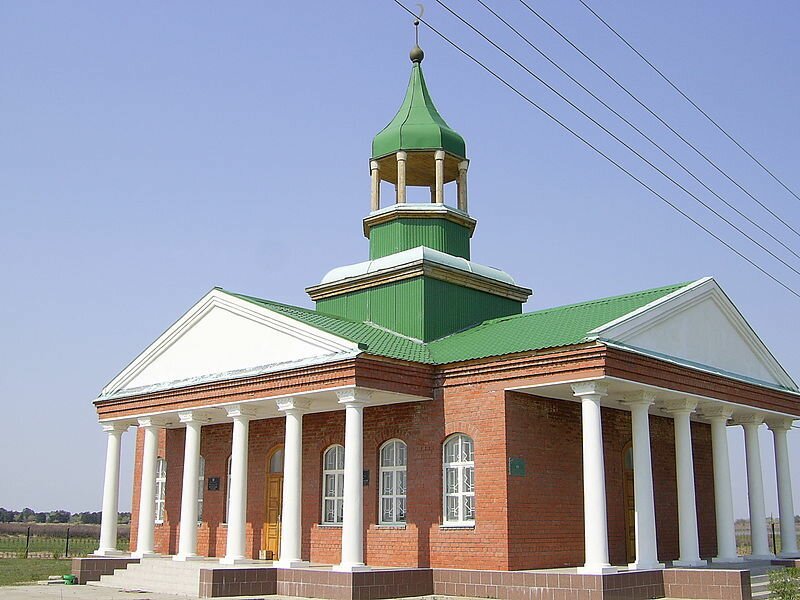
Zhangir Khan died in 1845. In government circles, it was decided to abolish the khan's authority in Internal Orda. Its management was transferred to the Provisional Council, headed by the Russian official.
1845-1852 – Elekey’s rule
.jpg)
Elekey was the son of Kasim, Bolekey’s grandson, the great-grandson of Yeraly. His real name is Ermuhammed. The Khan of Syrdarya Kazakhs was under protection of Khiva. He ruled Kazakh auls, mostly the clans of Shomekey, Kete, Karasakal and Ramadan, the generation of Alimuly of Juniour Zhuz and the part of Kerey tribes of Middle Zhuz. He migrated in the area, located in the upper reaches of the river Irgiz, near the Ural fortifications, on both sides of the Lower Syrdarya, in the interstream area of the rivers Karakum, Syrdarya and Kuvandariya. His headquarter was Khiva Khoja Niyaz fortress on Lower Syrdarya. He lost his father at his young age. In following years, due to the personal courage and exceptional organizational and military leadership abilities, he gained a lot of credibility and influence from the Kazakh tribes of Junior Zhuz. With this in mind, upon coming to maturity he received a diploma, conferring the title of Khan of Syrdarya Kazakhs upon him, from the Emir of Bukhara, Nasrullah Khan (1826 - 1860), and some time later – the diploma of the same content from the Khan of Khiva Rakhimkuli (1842-1846). With the support of the latter, the elders of the named Kazakh tribes elected him as Khan. Around 1847-1848 he made peace with the commandant of Kokand fortress Ak-Mosque Yakub Beg, having made a mutual exchange with their previously stolen by both parties from each other cattle and other property. At the beginning of 1849, at the invitation of the new Khan of Khiva Muhammed Emin (1846-1855), he went from the fortress Khoja Niyaz to the capital of the Khiva Khanate, where he was arrested by Khan's servants being suspected in dealing with the Emir of Bukhara and imprisoned in Khiva for three years. In mid January of 1852, using the negligence of prison guards, he escaped from Khiva through Kazakh nomads in Orenburg to the Russian authorities. On March 19, 1852, in the letter addressed to the chairman of Orenburg Boundary Commission M.V. Ladyzhensky, Ermuhammed, at the insistence of the royal officials, officially renounced the title of khan and expressed readiness to take an oath of allegiance to the Russian throne. From 1852 until his death he was in the Russian service and held the position of the leader of Kazakh clan Shomekey since 1853 for 10 years.
1845-1904 – Ibragim (Abay) Kunanbayev
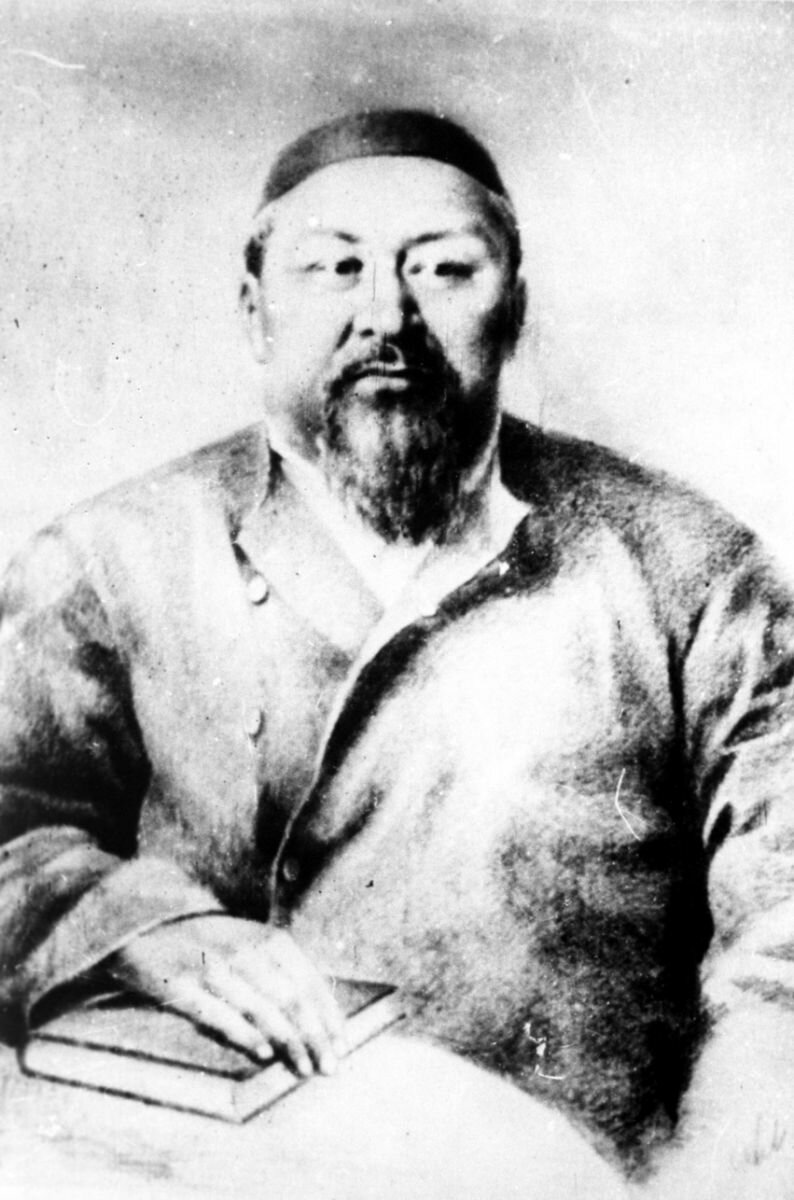
The Kazakh educator and thinker, the social activist and founder of Kazakh literature. His real name is Ibrahim, the nickname Abay was given by his grandmother. Abay Kunanbayuly was born in the mountains Chingiztau, modern Semipalatinsk region. He was descended from Tobykty, Kazakh tribe Argyn. As a child, he studied with mullah, then he studied at the medresse with Mullah Ahmed Riza in Semipalatinsk, where he studied Arabic, Persian and other Oriental languages. He simultaneously attended Russian school. By the will of his father he had to stop his study and assume his responsibilities of the tribal ruler. Abay worked as a parish steward for awhile. But in the end, he managed to get away from this position and begin to be engaged in creative activities. Crucial for Abay was his communication with political exiles as E.P. Michaelis, N. Dolgopolov, S. Gross. In shaping his worldview, Abay was influenced by the poets and scholars of the East who shared their humanistic ideas (Ferdowsi, Alisher Navoi, Nizami, Fuzuli, Ibn Sina and others), as well as the works of Russian classics, and he, in general, learned European literature through them. He translated Krylov, Lermontov, Pushkin, Goethe and Byron. Abay wrote about 170 poems and 56 translations, written poems, "Words of edification" ("Kara sөzder"). Abay was the talented and original composer as well. He created about two dozen tunes. Abay Kunanbayev had a great influence on the developing Kazakh national intelligentsia of late XIX - early XX centuries. The leaders of Alash Orda movement perceived Abay as their spiritual mentor and even spiritual leader of the revival of the Kazakh nation. Alikhan Bukeikhanov became the first Abay’s biographer. Abai Kunanbayev died at home on (June 23) July 6 of 1904.
1847-1858 – Eset Kotybarov’s revolt
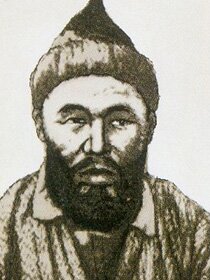
Eset Kotibarov descended from Shekty, Kazakh tribe Alimuly. He was named in honor of Eset Batyr from Tama clan, who was an active participant in dzhungarian wars. Before the uprising in 1838, Eset together with Zholaman Tlenshiev participated in the attack on Elek fortification. In 1847-1848 Eset with Zhanhodzhi Batyr participated in the struggle against Khivans as well. In 1847-1858 Eset batyr led Kazakhs of Juniour zhuz to revolt against the Russian government. On July 18 of 1847 Eset attacked on the Russian punitive expedition. 600 Kazakhs were also sent by imperial administration under the leadership of Elekey Kasymov. Eset batyr sent a force of rebels in the amount of 800 people toward punitive squad, and the punitive squad was defeated. Every year, the Russian government banished punitive squads against Eset, but they were unsuccessful. In 1854-1858 Kazakhs from Aral rebelled being dissatisfied with extortions and heavy burdens of imperial administration. At that period charges were paid in camels. Nearly 8000 camels were needed for the military campaign of Perovsky (1853) on Akmeshit (modern Kyzyl-Orda). Kazakhs revolted and migrated to the territory of the Emba River. Rebels put several conditions: to abolish the tax for smoke, to ban the movement of punitive squads on Kazakh steppes, to provide with freedom in using pasture and the possibility of free migrations on riverbanks Zhem, Mugadzhar, Elek, Kobden, Zhaiyk. V.A. Perovskiy carries a punitive campaign against the rebels and sends Wrangel with the large army. Eset was able to negotiate with the Baron, but then the warrior resumes military actions and attacks military fortifications and Cossack forces again. The newly created punitive squad under the leadership of Sultan Arslan Zhantorin was defeated by the troops of Eset Batyr. Sultan himself was killed. In 1858, Eset recieved peaceful conditions of imperial administration, which promised to fulfill all the demands of the rebels. In 1873, Eset participated in Khiva campaign and was awarded a gold medal “For diligence”.
1854 y. – Establishment of Vernyi fortification (Almaty)
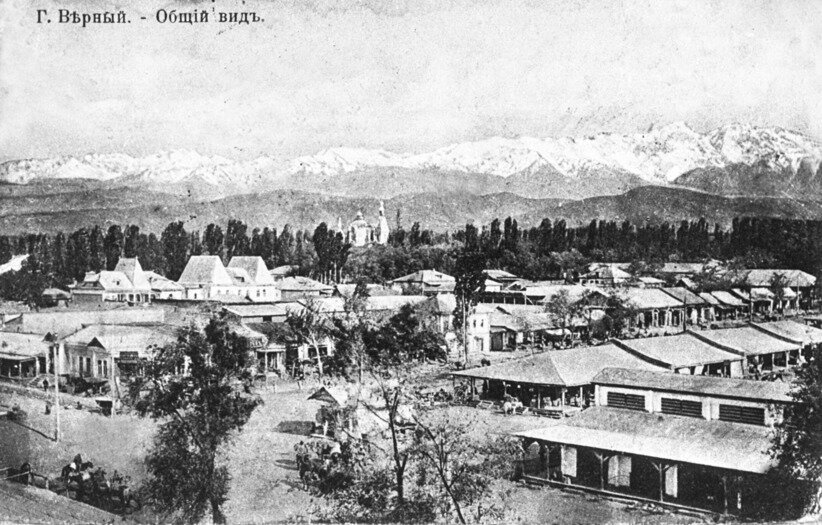
The beginning of establishment of the modern city was laid on February 4, 1854, when the Russian government decided to build a military fortification on the left bank of the Small Almaty River.
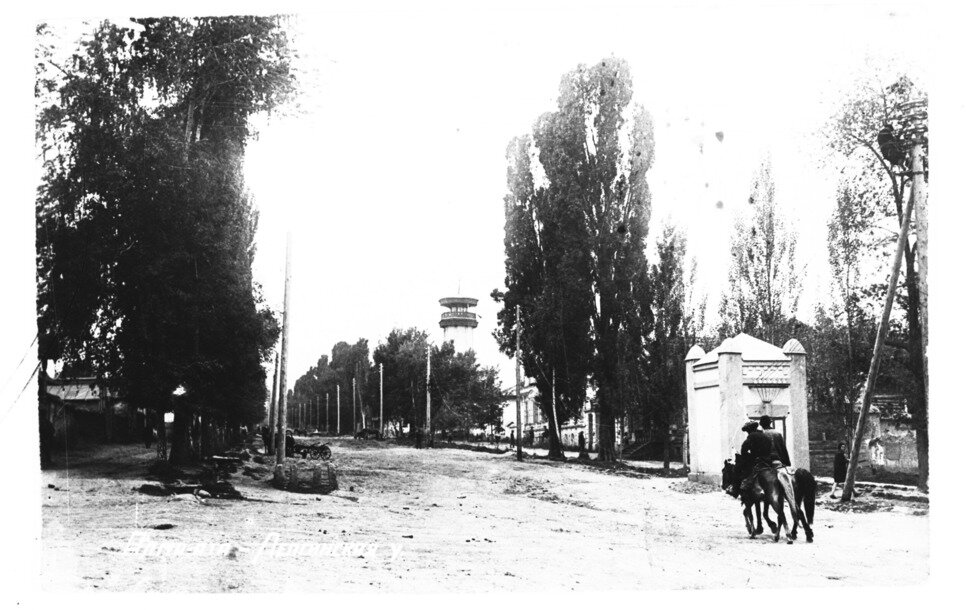
In spring of 1854 near the ruins of the ancient Almaty the construction of Zailiysky fortifications began, later on it was called Vernyi. The construction was managed by major Peremyshelsky and engineer Lieutenant Alexander.
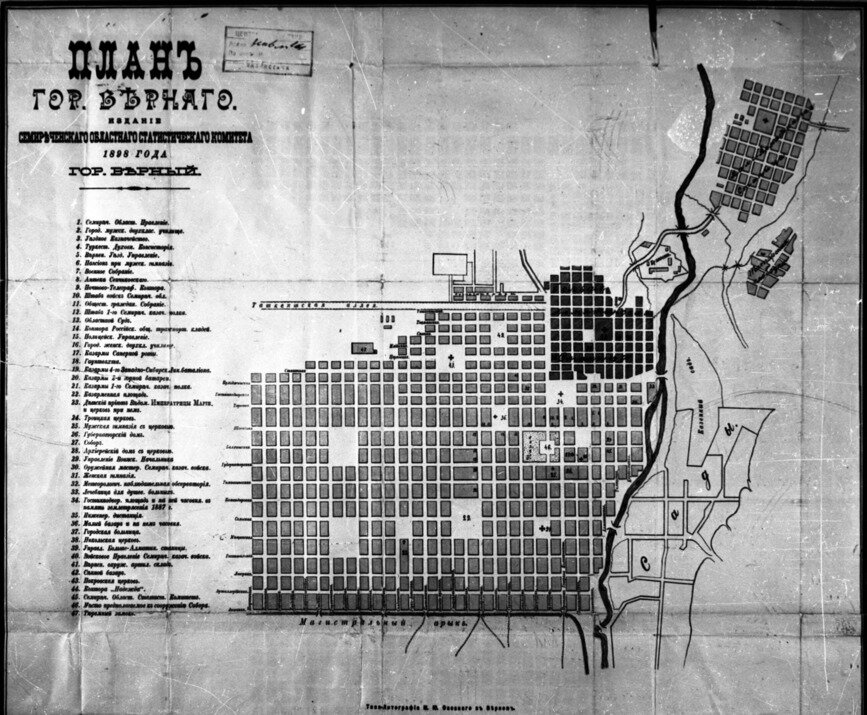
By the autumn of the same year, construction works had been completed. 470 soldiers and officers of Zailiysky squad settled in the log wooden houses and barracks.
1864 – Russian invasion of Merke, Turkestan, Aulie-ata and Shymkent
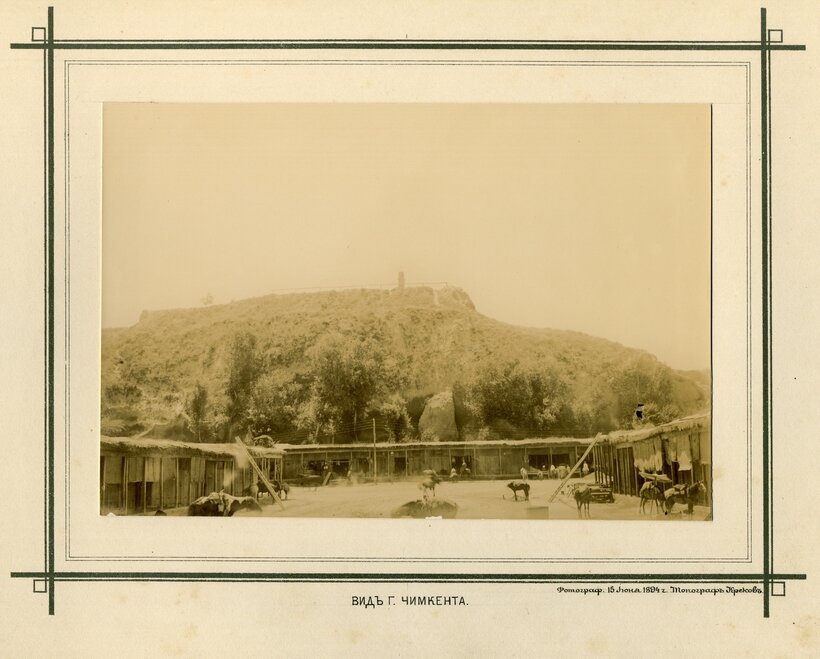
On May 22 of 1864 the troop of Colonel N.A. Verevkin with 1.5 thousand people started from Fort Perovskiy (modern Kyzyl-Orda). The troop of Colonel M. Chernyaev of about three thousand people also started from Vernyi. M.G. Cherniayev took Merka without any fight, and on June 4, after a short bombardment captured Aulie -Ata (modern Taraz). Despite the fact that during the siege only three people from the Russian squad had died, M.G. Cherniayev ordered to destruct several hundred kokands and locals. This barbaric was the reason of Shokan Valihanov’s leaving the Russian troops, as he found it unacceptable for himself to stay there any further. On June 9 the squad of N.A. Verevkin besieged Turkestan. On June 12 Turkestan surrendered. M.G. Chernyaev and N.A. Verevkin were entitled to the rank of major. M.G. Cherniayev was appointed as a chief of New-kokand line extending from Turkestan to Bishkek. On July 7 of the same year M.G Cherniayev began his campaign to Shymkent, which failed because of the numerical superiority of the Kokand troops. A few months later Cherniayev repeated his attempts to take Shymkent, this time it was successful. On September 22 the city was taken.
1865 – Taking of Tashkent by Russian forces
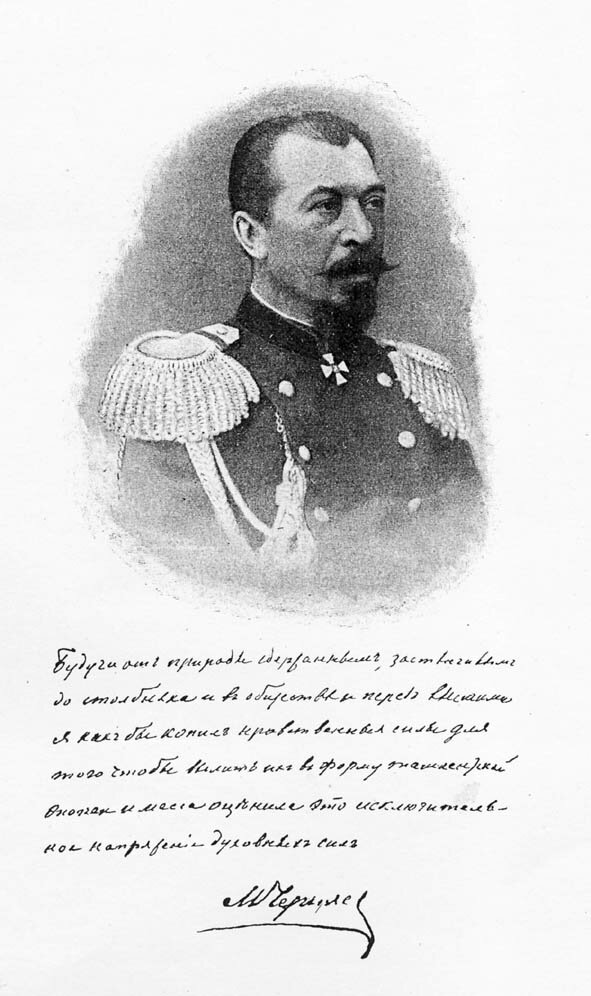
M.G. Cherniayev left Shymkent on the 23rd April of 1865 with a group of 8 foot companies, 2 hundred Cossacks, with 10 arsenals, later, during the siege of Tashkent two foot companies and two arsenals joined him. M.G. Cherniayev, not having enough strength to directly defeat the city, decided to force Tashkent to surrender by the strict blockade and starvation, cutting off the water supply. It was necessary to take the fortress Niyazbek for it. The fortress was taken on April 28. On the 9th May of 1865, M.G. Chernyaev’s forces were attacked by the troops led by Alimkulov, the ruler of Kokand khanate. Alimkulov, with his 40 thousand soldiers, among whom 10 thousand regular infantry forces with 40 arsenals were, at dawn, with barrage of all the guns, launched an attack on the Russian camp, but after two hour battle he was finally broken and how it turned out, he was fatally wounded. The news of the mullah Alimkulov’s fatal wound deranged a number of defenders of the city. After Alimkulov’s death, Syzdyk Kenesaruly became a commander, but because of disagreements with the nobility of Tashkent, he deserted the post. At night of June 6-7, a fighting reconnaissance from the south-west of the city was attempted. On June 14-17, the city was captured by Russian troops.
1866-1937 – Alikhan Bukeikhanov
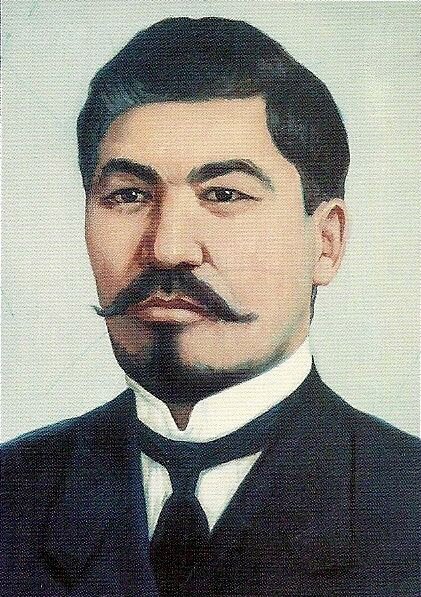
Alikhan Bokeikhanov was the son of Nurmukhamed, the grandson of Myrzatay, the great-grandson of Batyr and the great-great-grandson of Khan Bukey, one of the last khans of Middle Zhuz. He graduated from the Omsk Technical School, then the Economic Faculty of the St. Petersburg Forestry Institute. He was the member of the Cadet Party since 1905. At the end of 1905, in Uralsk congress of delegates from five areas, Alikhan was the one attempting to create a Kyrgyz (Kazakh) Constitutional Democratic Party. In January 1906 he was arrested "as the head of “Kyrgyz political movement". He was released after three months. He was the deputy of the First State Duma. He signed the Vyborg Manifesto (1906), which made a call for civil disobedience. In 1908, he was arrested again and until 1917 was in exile in Samara. He was the member of Samara Regional Committee (established in August 1915) of Party of People’s Freedom. In early 1917, he headed native department of the Western Front created on his own initiative in Minsk. After February Revolution of 1917, on March 19 he was appointed as the Provisional Government Commissioner of Turgay region. At the first Turgay Regional Congress, held on April 2-8, in favor of convening of all-kyrgyz (all-kazakh) Congress, Bukeikhanov was elected to the special staff of organizational bureau on preparation of program and convening of the congress. At the 8th Congress of the Cadet Party in May, he was elected as a member of the Central Committee. On the first all-kazakh Congress in Orenburg (July 21-26), which decided to establish an independent political party "Alash", Bukeikhanov withdrew from the Cadet Party. He was nominated a deputy to the Constituent Assembly from Semipalatinsk region. On October 31 he participated in the founding meeting of the party "Alash" in Omsk. He was the elected chairman of the Turgay regional committee "Alash". He was one of the authors of the draft program of the party "Alash". After Orenburg was occupied by the troops of Ataman A.I. Dutov on November 14, Bukeikhanov made the city the center of gathering forces of his supporters. He was the initiator of the second all-kazakh Congress in Orenburg (December 5-13), which formed All-Kazakh National Council Alash-Orda consisting of 25 people, 10 places were designated for Russian and other people living among the Kirghiz (Kazakhs). He was elected as the chairman of All-Kazakh National Council of Alash Orda out of three candidates. After Orenburg was occupied by the Soviet troops on January 23, 1918 Bukeikhanov moved to Semipalatinsk, where Soviet government won on February 17th, and Bukeikhanov established contact with Soviet institutions, but failed to agree. He joined the apparatus of the chief executive officer on "Alash" territory management, established by the government of A.V. Kolchak (end of November). In December of 1919, after the defeat of Admiral Kolchak’s army Alikhan came down to side of the Soviet government. He was the member of the first Founding Congress of Soviet Kirghiz (Kazakhs) of ASSR (October 4-12, 1920). Then he was on the Soviet and economic work, translated the works of Russian classical literature. In the 1920s and 30s was arrested three times. On September 27 of 1937 he was convicted on charges of belonging to a terrorist organization and shot on the same day by the Military Collegium of the Supreme Court of the USSR. He was rehabilitated in 1989.
1867 – establishment of Turkestani Governorate General

After taking Turkestan and Shymkent, Turkestan region was formed in 1865, which was the part of the Orenburg Governorate General, by the decree from 11 (23) July of 1867, it was transformed into an independent Turkestan Governorate General including two regions – Syrdarya region with its center in Tashkent, where the residence of the Governor-General was, and Semirechensk with the center in Verny.
1868 – establishment of Stepnoy Governorate General
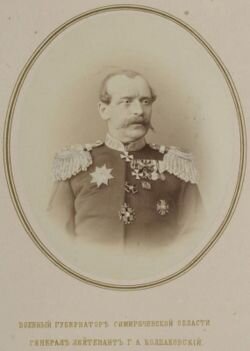
Stepnoy Governorate General was founded in 1882 on the initiative of the Minister of War P.S. Vannovsky due to the need of uniting the bordering with China territories of Russian Empire in the same Governorate General. With the formation of Stepnoy, the West Siberian Governorate General (consisting of Siberian and Kazakh territories) was abolished, from which Kazakh Akmola and Semipalatinsk regions were transferred. The third region becoming the part of the new Governorate General was Semirechensk, which before was governed by Turkestan Governorate General. The administrative center of the new military - territorial establishment became Omsk. Governor-General of Stepnoy was simultaneously the commander of Omsk Military District and the ataman of Siberian Cossack Army. In 1899 Semirechensk region was returned to the Turkestan Governorate General.
1868, November 21 – Issue of “Provisional regulation”
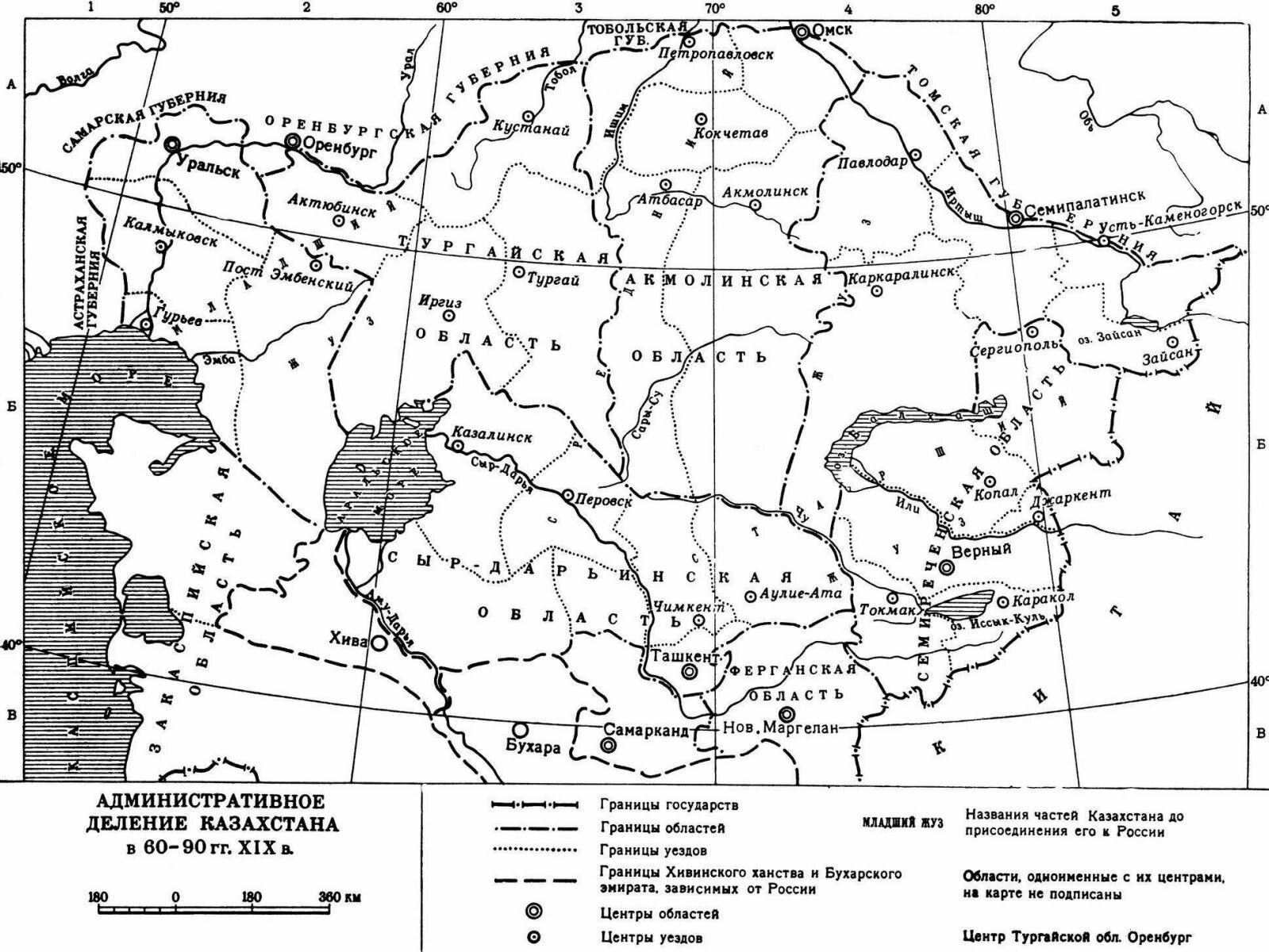
The draft of "Provisional Regulations on the Administration of the Ural, Turgay, Akmola and Semipalatinsk regions" was accepted. It went into effect on May 1 of 1869. According to this "Regulation", tax (kibitz collection) and people's discontent led to numerous rebellions of Kazakhs.
Consisting Russia
1869-1870 – revolt in Turgay and Ural regions
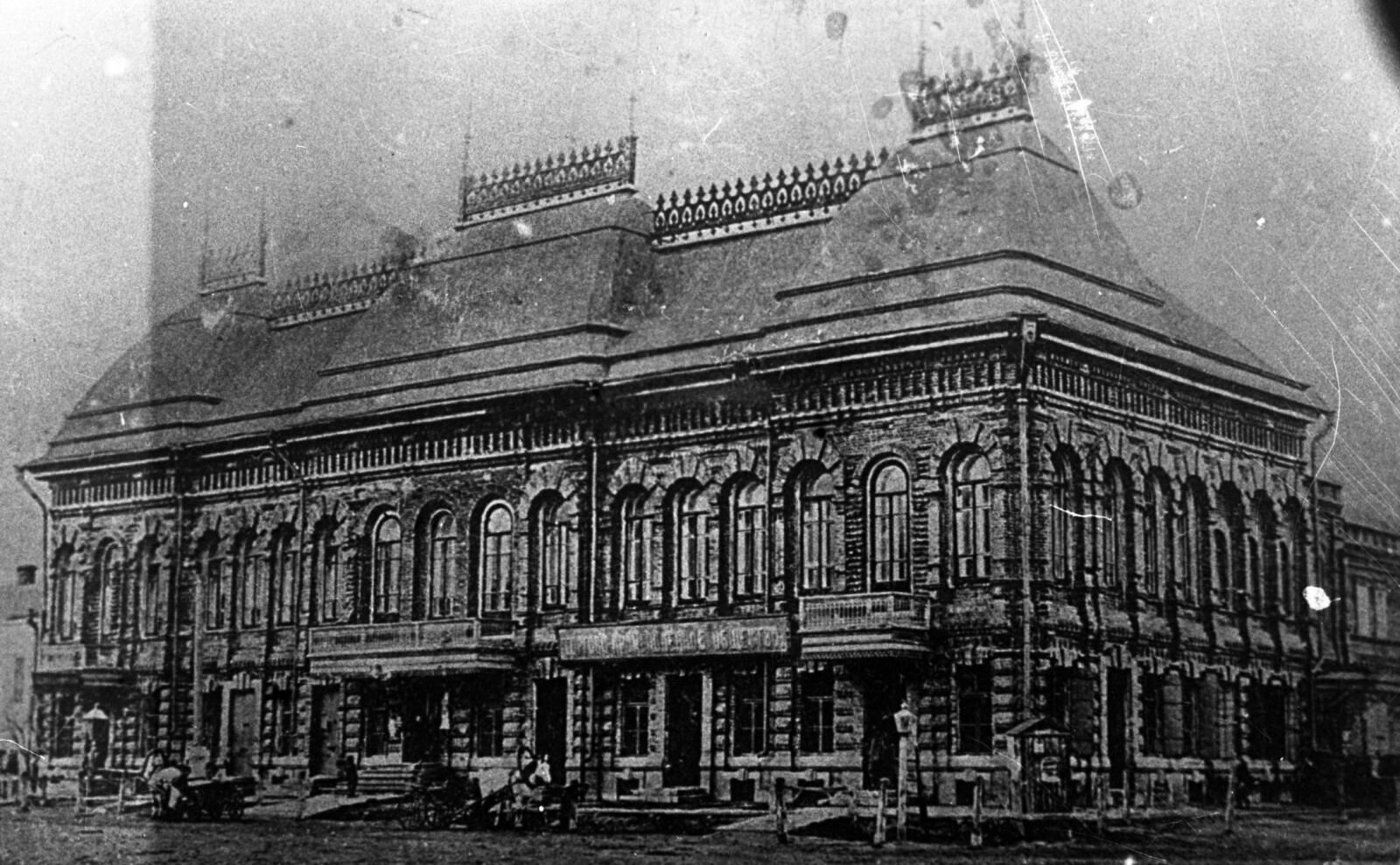
In 1868 uprising began in Turgay and Ural regions the participants of which tried to resist reforms in life. Resistance area spontaneously arose in the villages, wandering along the rivers Kobda and Ilek. At the head of the rebels stood Sultan Hangali Arslanov and ufa Mullah Ikhlas Dosov. The rebels were associated with Khiva Khanate.
1870 – Aday revolt
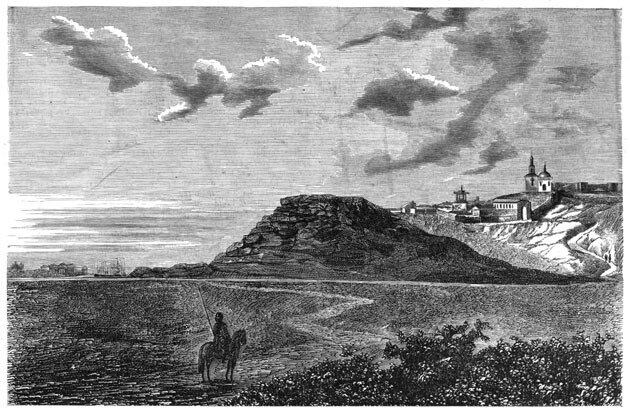
In Mangyshlak, uprising began in March 1870, as the "Provisional Regulation" was introduced here only in 1870. Because of the introduction of this provision in 1869, the land issue escalated. From 20,000 tents royal authorities wanted to receive 160,000 rubles of kibit collection. Taxation was too much for wandering Adays here, and they openly made a stand against the government. On March 21 of 1870 rebel forces led by Dosan Tazhiev and Isa Tlenbaev got to grips with the group of Mangyshlak bailiff of Rukin, who was going to subdue Adays the "Interim Provisions" by force of arms. The rebellion was actively supported by working fisheries fort of Alexandrovsk, of the village Nikolayev. The number of rebels reached 10,000 people. From 5 to 8 April, the rebels besieged Alexandrovsk Fort and burned beacons. Only the fire of artillery stopped the rebels. The suppression of the uprising lasted three months. It was violent and resulted in the physical extermination, and the imposition of damages (90,000 sheep). In December of 1870 3000 wagons headed by Dosanov and Isa went to Khiva Khanate.
1873-1938 – Akhmet Baitursynov
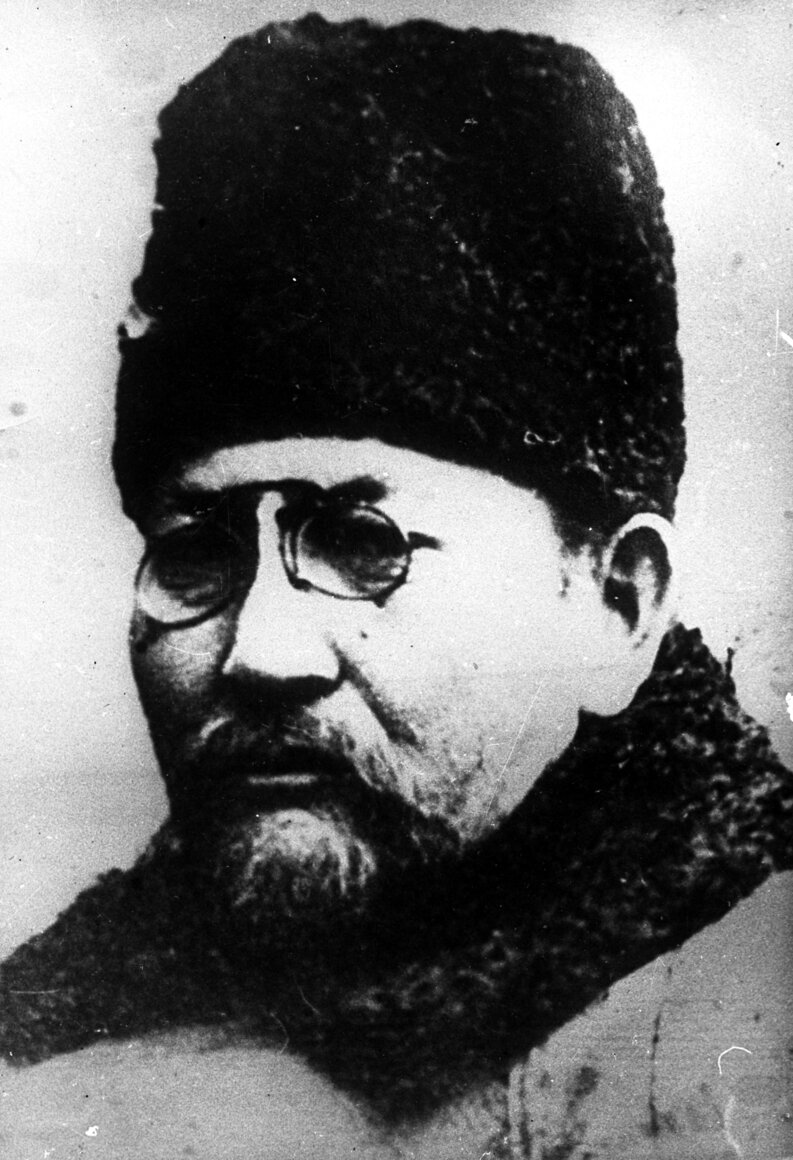
Kazakh linguist, literary critic and translator. He reformed the Kazakh script basing on the Arabic script, giving opportunity to its use by millions of Kazakhs living abroad. In 1912, Ahmet Baitursynov excluded all purely Arabic letters that were not used in the Kazakh language, and added letters specific to the Kazakh language. New alphabet, called "Zhana Emle" ("New Spelling"), is still used by Kazakhs living in China, Afghanistan, Iran. Ahmet Baitursynov studied literacy with aul mullahs. Relatives sent him to the two-year Turgay Russian-Kazakh school. Having graduated, A. Baitursynov went to Orenburg for continuing education and entered the four-year teacher school, founded by the educator Ibray Altynsarin. In Orenburg, he experienced financial difficulties, but he finished the school in 1895 despite everything. In 1895-1909 he taught at Aul volost schools. In 1905, he was actively involved in political activities. Akhmet was the one of the authors of “Karkaralinsk petition" in which the demands to stop the removal of land from the Kazakhs, the flow of migrants, to establish national zemstvo were made. In 1907, he was first imprisoned for criticizing the imperial government, and in 1909 Baitursynov was imprisoned again for 8 months without trial in Semipalatinsk. In 1913 Baitursynov along with the former deputy of the First State Duma Alikhan Bukeykhanov and the poet and writer Mirzhakip Dulatov opened the newspaper "Kazakh" in Orenburg. In 1917, he participated in two all-kirghiz congresses in Orenburg in the creation of the Kazakh party "Alash" and was one of the organizers and leaders of the "Alash Orda" government. According to the decree of the VtsIK from April 4, 1919 he was pardoned. After that he came down to side of the Soviet government, and even became a member of the Communist Party of Bolsheviks (AuCP). Since 1919 – the member of Kirrevsk, Commissar of Education, member of the VTsIK, Kazakh Central Executive Committee. In June 1929 he was reminded of his political activity in the "Alash" party, and arrested by the NKVD, put in jail in Kyzyl -Orda, again with Mirzhakip Dulatov as in Imperial period and was deported to the Arkhangelsk region. In 1934, at the request of E. Peshkova - Maxim Gorky's wife, who was then working in the Commission of the Red Cross, Ahmet Baitursynov was released. Then he and his family, having already three adopted children returned to Alma-Ata, and lived in the house, which later became his House-Museum. In October 1937, Ahmet Baitursynov was arrested again, and two months later, on December 8, executed as an "enemy of the people" by the verdict of the NKVD troika. In 1988, Ahmet Baitursynov was rehabilitated. Ahmet Baitursynov made a great contribution to the development of Kazakh literature and writing. In particular, he was mostly known for his fables included in the collections "Forty fables" and "Masa", published respectively in 1909 and 1911. Baitursynov made a great job of collecting and publishing samples of Kazakh folklore. He wrote an introductory article and comments to the poem "Ersain" published in 1923, released the book "23 lamentations" (1926) and "Literary Criticism" (1926), the latter of which is the first scientific research on the history of Kazakh literature. Theses "On the terminology in the Turkic languages" published in 1926 belonged to Baitursynov. Ahmet Baitursynov wrote several textbooks for Kazakh children learning their native language. Among them: "Tutorial" (1912), "Handbook on language" (1914), "ABC" (1924), "New ABC" (1926 - 1928), and manual “Bayanshy" (1926).
1873-1919 – Amangeldy Imanov
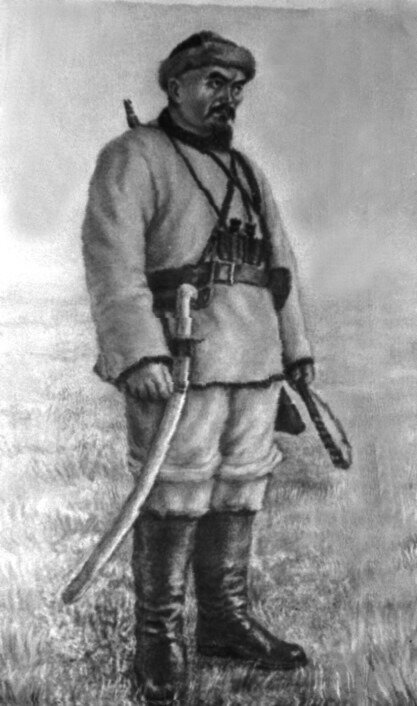
Amangeldy Imanov was born in 1873 in the aul number 3 of Kaydaulsk volost in Turgay, now Amangeldy district of Turgay region. Amangeldy lost his father when he was 8. He studied at the aul school up to 12 years, then in medersse of dulyga Imam Abdrahman. Here he studied for four years, mastered three foreign oriental languages - Turkish, Persian and Arabic. In 1910 in Terisbutak, where Amangeldi’s gen lived, the school was built on his initiative. In 1916, after the decree of Nicholas II’s draft call of the Kazakhs on the rear works, revolts began in the Kazakh steppes. Amangeldy raised a rebellion in Turgay district, and enthroned Khan Abdigappar Zhanbosynov. The uprising was hard to put down, as the most of the military forces of the imperial army fought on the Western Front in the First World War. In the midst of the uprising about 50,000 fighters were under the banner of Amangeldy. In October 1916 Amangeldy’s army besieged Turgay. When regular Russian forces approached, Amangeldy’s troops started to use guerrilla methods in fight. But there were direct clashes of forces that lasted until the mid-February of 1917. In late February, the troops were withdrawn, leaving Dougal-Urpek in rebels’ hands. After the February Revolution victory, the number of insurgent groups had dramatically increased in the steppe, and in late 1917 Amangeldy took Turgay. In October 1917 - January 1918, Amangeldi actively participated in the establishment of the Soviet government in Turgay and Turgay region, he was the military commissioner in Turgay. He joined the members of the RCP (b) under the influence of Alibi Dzhangildin and participated in the Regional Congress of Soviets (Orenburg, 1918). In July 1918, he led a group of Soviet officials holding elections of aul and county councils. During the Civil War, together with Dzhangildin he formed the first Kazakh national army units in Kazakhstan, helped the red partisans in the rear of Kolchak. In November 1918, the force led by Amangeldy Imanov and Dzhangildin took Turgay. With the transition of Kolchak's army to offensive on the Eastern Front (spring 1919) Alash Orda people raised anti-Bolshevik uprising. Amangeldy Imanov was arrested by "Alash Orda" and shot on May 18, 1919.
1876-1941 – F.I Goloshekin

Russian revolutionary, Bolshevik and Soviet leader, the chairman of the executive committee of Samara, the secretary of the Kazakh Regional Committee of the CPSU (b). The participant in the struggle for the establishment of Soviet government in Ural and Siberia. He participated in collectivization in Kazakhstan. He was the one of the initiators of the execution of the royal family. From October 1924 to 1933 served as the First Secretary of the Communist Party of Kazakhstan. He carried out violent, coercive measures on turning nomadic life to sedentary life, which led to heavy casualties. The first event in Kazakhstan was the confiscation held in autumn 1928. 700 households were under the confiscation, 150,000 head of cattle were taken. Goloshekin himself admitted, that the initial plans were twice as big, they were going to confiscate the houshold from 1500 heads (all on, according to statistics from the 1920s, in terms of cattle), and the total number of "semi-feudal byis" should have been 1500 households. But when approving the confiscation plan in the CPSU (b) and the Central Executive Committee of the USSR , Goloshchekin made the remark, and set other rules for confiscation: 400 heads - nomadic economy, 300 - semi-nomadic, 150 - settled. The total number of farms decreased to 700. 1 million 750 thousand Kazakh people (42%) became victims of the famine. Other nations also suffered significant losses: Ukrainians - 200 000 people (23%), Uzbeks - 125,000 people (54%), the Uighurs - 27 000 people (43%). All peoples in Kazakhstan suffered severely from hunger. In 1931 1 million 30 thousand people, including 616 000 permanently migrated, hundreds of thousands fled to China. Over 7 years of governing Goloshchekin never traveled outside of the capital, he was not interested in how people live. Philip Isaevich Goloshchekin was arrested on October 15, 1939 and spent two years in prison. Historian of revolution V.L. Burtsev, who knew Goloshekin, said: "He is a typical Leninist. This man will not stop the blood. This feature is especially noticeable in his nature: the executioner, cruel, with some elements of degeneration. At Party life he differed with arrogance, he was a demagogue and cynic. He regarded Kazakhs as impersonal men. Hardly had Goloshchekin appeared in Kazakhstan, as stated that there was no Soviet government and there was a need to make a "Small October"”. On October 27, 1941 F.I. Goloshchekin was shot.
1879-1937 – Mukhamedzhan Tynyshpayev
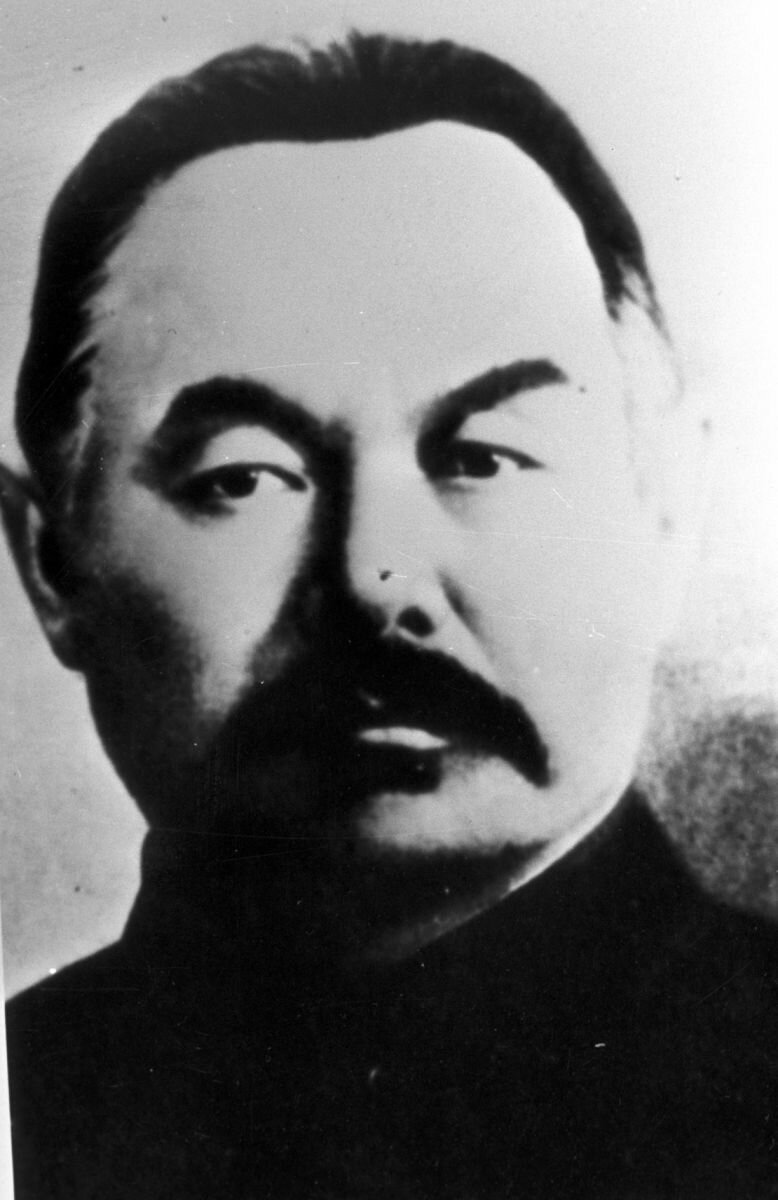
Kazakh public figure, the second deputy of the State Duma of Russia, the Prime Minister of Turkestan autonomy, a member of "Alash Orda", the first Kazakh railway engineer, an active participant in the design and construction of the Turkestan-Siberian Railway. In 1889, his father sent Mukhamedzhan to the city Vernyi for study. Mukhamedzhan successfully completed a two-year preparatory class and then began to study at the Verny gymnasium. In 1900 he finished Verny gymnasium and entered the Imperial Institute of Transportation Engineers named after Alexander I in St. Petersburg. In 1905 Tynyshpayev passed final exams, defended the course project "Construction of the Turkestan-Siberian Railway" and was awarded a railway engineer with the right to drafting and production of all kinds of construction works and the right to the rank of a collegiate secretary when joining the civil service. Thus he became the first Kazakh railway engineer. In 1906 Tynyshpayev began working as an engineer on the reconstruction of the Central Asian Railway from Krasnovodsk to Chardzhou, took an active part in the construction of the bridge made of hardware to replace the old wooden one across the river Amu Darya. On April 3, 1907 he was elected to the State Duma of II convocation of indigenous Semirechensk region. He arrived in St. Petersburg on April 26, 1907. He was the member of Muslim faction and the Siberian group, the member of the Agrarian Commission. From 1907 to 1917 he worked as an engineer in construction of various railways. In April, after the February Revolution of 1917, Turkestan Committee was established by the Provisional Government to address local management issues of Turkestan in Tashkent, to which Mukhamedzhan Tynyshpayev was elected as a former member of the second State Duma of Russia. In July of 1917 Tynyshpayev, as a delegate from Semirechensk region, participated in all-kirghiz (All-Kazakh) Congress held in Orenburg and became one of the delegates for the All-Russian Constituent Assembly. In November 1917 he was elected as the Prime Minister of Turkestan autonomy in Kokand, but due to the divergence of views with elected Foreign Minister Mustafa Chokay, he left his post and went to Tashkent, giving his place to Chokay. In 1919, when Soviet government was established in Turkestan and Stepnoy regions, Tynyshpayev moved to its side. On August 3 of 1930 Mukhamedzhan Tynyshpaev was arrested being told on, but after a long investigation no criminal evidence was found. Afraid of being arrested, Tynyshpayev sent his wife Amina with his 5 year old son Daulet to her relatives in Ufa, where, at the insistence of Tynyshpayev, she gave their son her name - Sheikh Ali. On November 21, 1937 he was arrested again, as a former member of "Alash Orda" and was shot as an "enemy of the people". On September 29, 1959 Mukhamedzhan Tynyshpayev was rehabilitated by the Supreme Court of the Kazakh SSR, and in February 1970 – by USSR Prosecutor's Office and the Military Prosecutor of the Turkestan Military District.
1881-1884 – emigration of Uighurs and Dungans to Semirechie
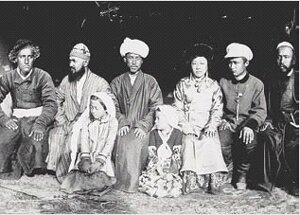
In 1864, Dungans and Uighurs revolt was the most extensive in terms of territory. It took place in East Turkestan. On February 24, 1881 Petersburg contract made the third article were the following was stated: "Residents of the Ili Valley are granted the right to remain on their current places of residence in Chinese allegiance, or to emigrate to the borders of Russia and take Russian citizenship. They will be questioned about this before the restoration of the Chinese authorities in the Ili region. And to those who wish to move to Russia will be given one year from the day of giving the areas to Chinese authorities. Chinese authorities will not pose any obstacle to their eviction and removal of their movable property". Settling Uighurs and Dungans in Semirechie, the imperial government pursued two aims: 1.to weaken economic base of China in Kuldzha; 2. to use immigrants as a military force against China. Uighurs, in turn, were interested in relocating because they were repressed by the Chinese authorities for participation in the rebellion. The bulk of Uighurs were supposed to be settled at rain-fed lands along riverbanks Chilik, Ili and Turgen. By the end of 1882, there were 5000 Uighur and Dungan families in Zhetisu. At the end of May 6549 displaced families settled here. During the summer of 1882, in connection with the harvest time, the relocation was temporarily suspended and resumed in the fall. Uighurs relocation was mainly completed in fall 1882 - spring 1883, however, some groups continued to draw to the new residence until the beginning of 1884. By that period there had been 9 572 Uighur families (45,373 people) and 1147 Dungan families (4682 persons) in Zhetisu.
1883-1939 – Khalel Dosmukhammedov
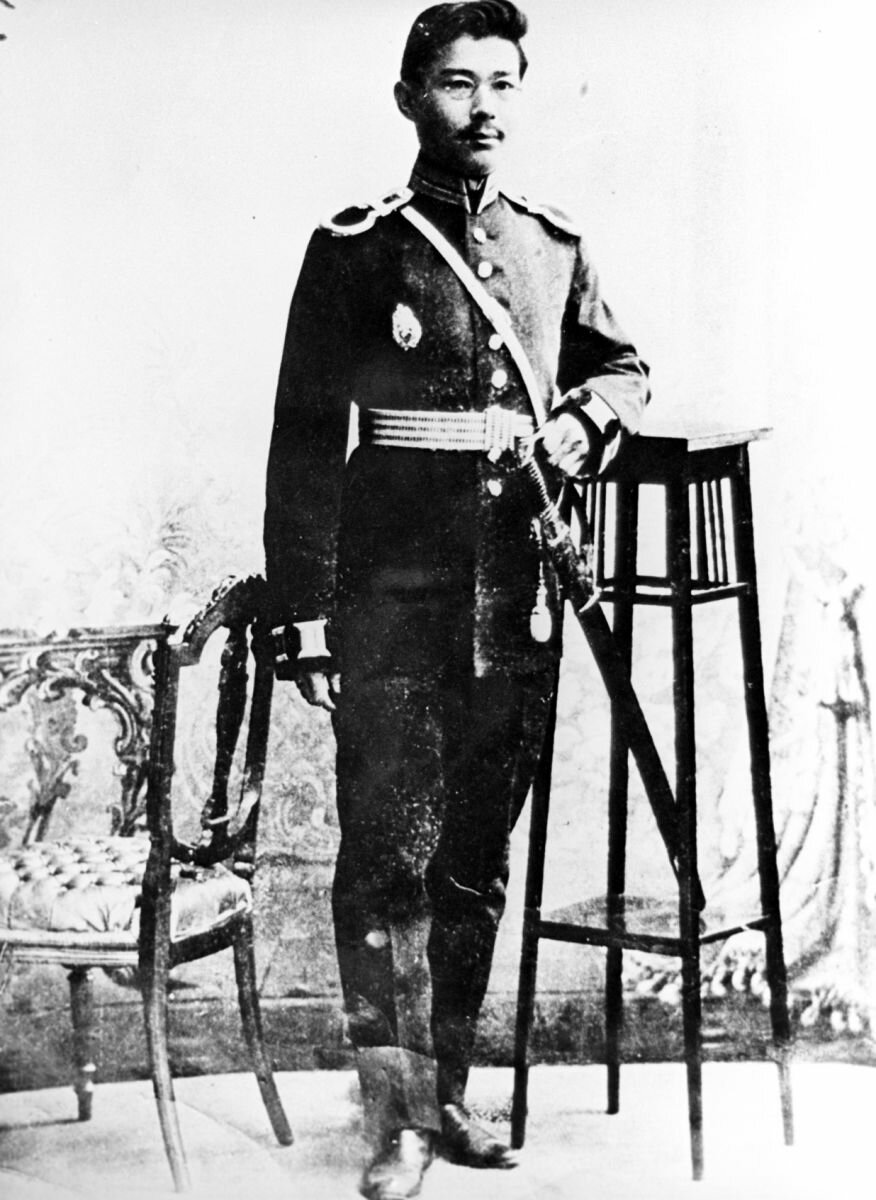
Doctor, scientist, member of Alash movement. In 1909 he graduated from the St. Petersburg Imperial Military Medical Academy with a gold medal. For his medical services, he received the Imperial bronze medal. He participated in the second Kazakh Congress in 1917. In 1918, on behalf of the Alash Orda, together with his namesake and colleague Zhahanshy (Zhansha) Dosmukhamedov created the so-called West Department of Alash Orda with its center in Dzhambeity (Zhympity) in the modern West Kazakhstan region. In 1928, at the invitation of Uraz Dzhandosov, he moved to Alma-Ata to create Kazakh State University. Despite these achievements Khalel Dosmukhamedov was exposed to repression. In 1930 he was exiled to Voronezh. In 1937 he was arrested and transported in Almaty and in 1939 died from tuberculosis in the prison hospital. He published the following books: "Natural", "Animals", "Life of a Man" (Kazakh - Russian dictionary), "Maintaining the health of students", "Stories about the human body and its function", "About beloved" etc. He also issued the following research papers: "The law of vowel harmony in the Kazakh - Kyrgyz languages", "Sherniyaz Sheshen", "What is Alash", "On the foundation of Kogiltash medresse in Bukhara", "Pedigree of Zhalantos batyr who built the Tilla - Kari and Shirdor medresse" "Last Days of Kenesary", "History of Kazakh literature". Khalel Dosmuhammedov also released compilations as "Words of Murat akyn", "Issatay - Makhambet", "Alaman".
1890-1941 – Mustafa Shokhay
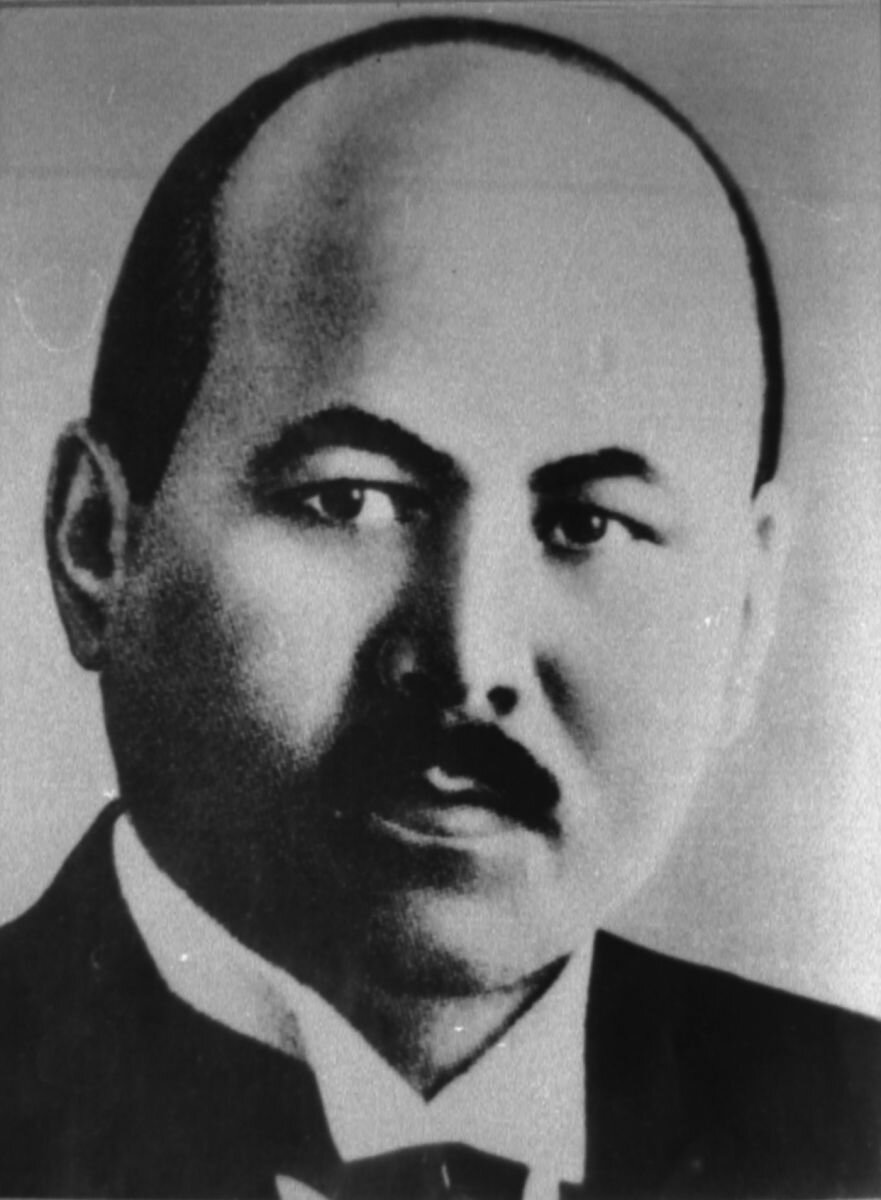
Kazakh social and political figure, writer, ideologue of the struggle for freedom and independence of the united Turkestan Mustafa Shokhay (Chokaev, Chokai) was born on December 25 of 1890 in a Kazakh village (in Soviet times the village was called sovkhoz named after the1st May) at the Syrdarya river near Perovsk (formerly Ak-mosque, now Kyzylorda). His ancestors were from Kypshak clan - Boshai. The grandfather was the governor in Syrdarya district of Khiva, and his father was a respected judge. At the behest of his father, Mustafa went to study at the Perovsk Russian school. In 1902, his father sent him to study at the Tashkent gymnasium. Upon completion of Tashkent gymnasium in 1910, Mustafa was nominated to the gold medal as the best student. In 1914 he graduated from the law faculty of St. Petersburg University. In 1912 when his father died, Mustafa Shokhay temporarily returned home and took the place of his father (as justiciary) at the request of his countrymen. In spring of 1917 Shokhay began to publish the newspaper "Birlik Tuy" (Banner of Unity) in Tashkent, which first introduced the idea of the independence of the Turkic peoples, as well as the Russian newspaper "Free Turkestan", which promoted democratic ideas. In April Mustafa participated in Turkestan Congress of NGOs in Tashkent. The issue of management of Turkestan was mainly on the agenda. The Congress created the National Council of Turkestan. 27 year-old Mustafa Shokhay was elected as the chairman of the Permanent Executive Committee. He later recalled: "I was younger than everybody, and I was embarrassed to some extent to be the chairman. But the fact itself testified the small number of people from the local intelligentsia. And the period was the most responsible". On July 21-28 of 1917 Mustafa, as a delegate from Syrdarya region, mostly populated by Kazakhs, took part in the First all-kirghiz (All-Kazakh ) Congress in Orenburg, where the form of governance, autonomy in Kyrgyz regions and painful land issues became the main problems to be solved. The Congress created the first Kazakh political party "Alash". Shokhay was elected a delegate to the Russian Constituent Assembly and to the All-Russian Congress of Muslims "Shura -Islam". In 1918 the Bolsheviks defeated the Kokand autonomy. Mustafa Shokhay hardly saved his life during the destruction and secretly fled to Tashkent. He lived here illegally for two months and then converged with the old familiar actress Maria Gorina, whom he married in April 1918. All this time Shokhay participated in the Alash Orda works. Then he found himself in the Caucasus and lived in Tbilisi in 1919 - 1921. After Soviet forces entered there, he fled to Turkey. In the summer of 1921 he arrived with his wife in Paris, which became the center of white emigration. Since 1926, Mustafa Shokhay was in the editorial board of "Prometheus", organ of National Defense of the peoples of the Caucasus, Ukraine and Turkestan. In 1927, Mustafa, with the help of an old acquaintance Ahmed - Zaki Validov, organized a magazine in Istanbul "Zhana (New) Turkestan" (1927-1931) - the political authority of the National Defense of Turkestan. Since 1929, he rectified the edition of the journal "Yash (Young) Turkestan" in Berlin and became its chief editor. The magazine lasted until the beginning of the World War II in 1939, 117 issues were released. On the day of the attack on the USSR, on June 22 of 1941, in Paris, the Nazis arrested all the prominent Russian emigrants and imprisoned them in the castle of Compiegne. Shokhay was also among them. Three weeks later he was taken to Berlin and agitated for half months, offering to lead the Turkestan Legion, which planned to be collected from captured Soviet Turks prisoners in detention camps. Mustafa Shokhay initially set his conditions to the Germans, trying to save all the Turks prisoners, but the Germans did not accept his conditions. Then Mustafa Shokhay refused to lead the Turkestan Legion. On December 22, 1941 Hitler signed a decree on the establishment of the Turkestan and other national legions. At this time Shokhay was in the hospital of Berlin "Victoria". On December 27, 1941 he was gone. By common version he was killed on the orders of Hitler.
1891-1970 – Alimkan Ermekov
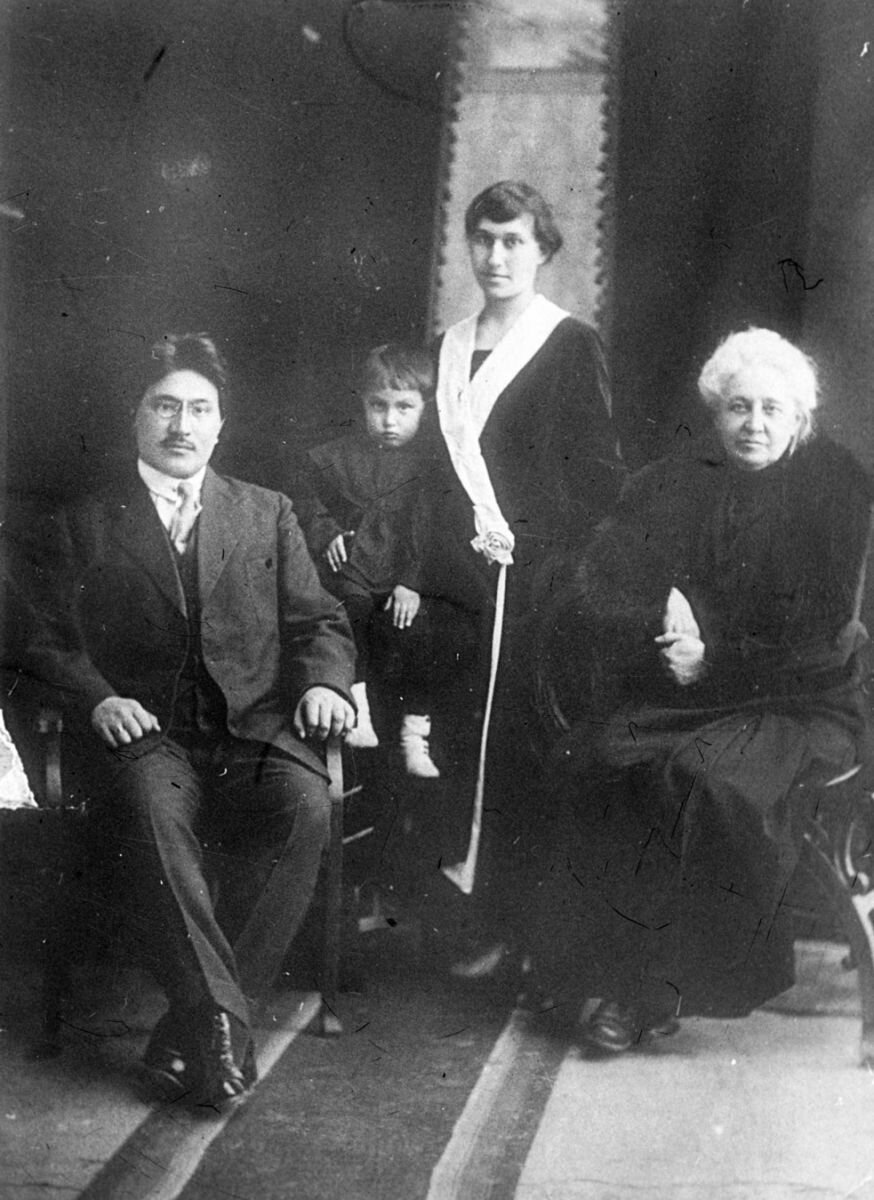
One of the founders of the party "Alash", the scientist, the first Kazakh Professor of Mathematics. He was born in the Temirshinsk volost, Karkaraly, Semipalatinsk region (now Aktogai district, Karaganda region). He finished the Karkaralinsk three-class city school in 1905. In the same year he entered the Semipalatinsk gymnasium, from which he graduated with honors in 1912. Then by the competition of diplomas he was enrolled in Tomsk Technological Institute. In 1917, cancelling his study, joined Alash Orda. In 1920 A. Ermekov, as a member of the Central Executive Committee of the Kazakh SSR, was sent to Moscow, where he made a report on the situation in Kazakhstan at the meeting chaired by Lenin. During the heated debate about the boundaries of the republic he succeeded in returning Kazakhstan’s most important areas that temporarily belonged to Russia. Among them were Korostylevsk steppe, Semipalatinsk, Akmola region and the northern coast of the Caspian Sea.
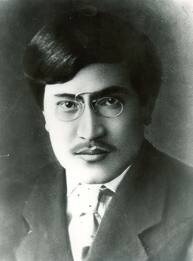
In 1925 A. Ermekov was invited to Semipalatinsk and approved as the Deputy Chairman of the State Planning Commission of Kazakhstan in Orenburg and simultaneously governed the industry section. Since 1926, as one of the few specialists, he was brought to work at the universities in Tashkent (Higher Pedagogical Institute), then at the universities of Almaty. He worked at the Kazakh Pedagogical University, Almaty Veterinary Institute, as the head of the Department of Mathematics, and had an academic title – associate professor. In 1935 the USSR VAK assigns him the title of Professor of Mathematics and Theoretical Mechanics. In Almaty Mining and Metallurgical Institute, he was the dean of general technical faculty. In the autumn of 1937 A. Ermekov went to Moscow and received direction to head the Department of Mathematics of the Kuibyshev Planning Institute, where he worked until March 1938. In the same year he was arrested and initially sentenced to ten years, then the term was reduced to six years, but due to the Great Patriotic War he was held in the camp for nine years until 1947. In 1948 he was sentenced to ten years again. In 1955 A. Ermekov released and went to his residence in Karaganda. Since 1955 he had been working in the Karaganda Polytechnic University. He was totally rehabilitated in March 7, 1955 and restored his rights. He retired in 1958.
1894-1938 – Turar Ryskulov
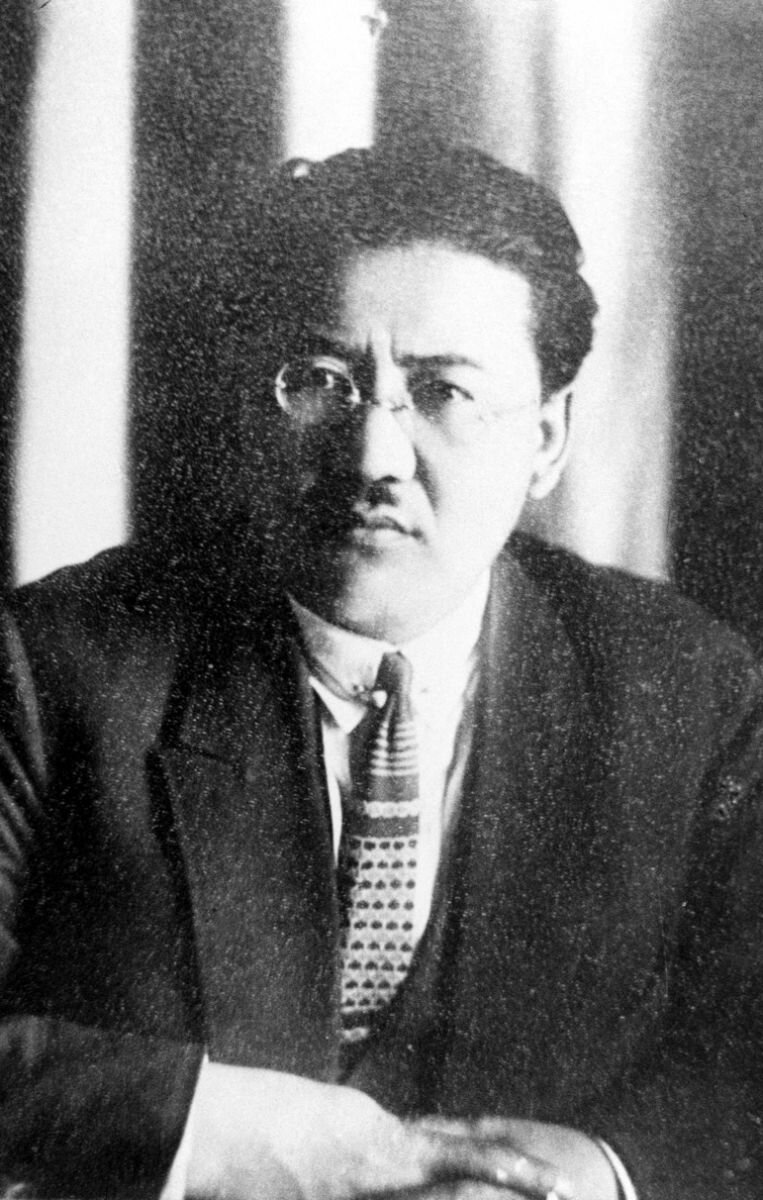
He was born in Besagash village of Talgarsk district, Almaty region. In 1907-1910 he studied at the Russian-Kazakh Merken boarding school (Merck). In 1914 he graduated from Pishpek agricultural school (Pishpek). In 1916-1917 he studied at the Tashkent State Pedagogical Institute. He was the participant of the national liberation uprising of the peoples of Central Asia in 1916. At the beginning of 1917 Riskulov organized "Revolutionary Union of Kazakh youth" in Aulie-Ata, which set as its aim the full struggle for freedom and independence. In 1918 he was the deputy chairman of Aulie-Ata Sovdep. From the very beginning of his social activities, he was closely involved in resettlement of nomadic villages. In October of 1918, T.Ryskulov was elected to the TurkTsIK at the VI Congress of Soviets, then, he was appointed as the Commissar of Health of Turk republic. Later on he was promoted to the post of the deputy chairman of the CEC of Turk republic. In 1919 Riskulov was the Chairman of the Central Commission for the fight against hunger at TurkTsIK, the chairman of the Cheka on combat Basmachis in Fergana. After Ryskulov’s statement about preservation of the unity of Turkestan, persecution stage began. In June 1923, I.V. Stalin held a meeting with senior staff of the national republics and regions. In his speech, Stalin accused Ryskulov in "pan-Turkism”. At the initiative of T.Ryskulov Turkestan - Siberian Railroad (Turksib) was built in Kazakhstan. In 1920 Riskulov participated in the First Congress of the Peoples of the East in Baku. In December 1920 he was appointed as the Deputy People's Commissar for Nationalities of the RSFSR. In 1922 he was put forward for the post of chairman of the Council of People's Commissars of Turk republic. In 1924 being the assistant of head of Middle East Department of the ECCI, he was delegated to Mongolia as a commissioner of the Comintern. In 1925 Riskulov became the head of the press department of Kazkraykom VKP (b) and executive editor of "Enbekshi Kazakh". In 1926-1937, being the deputy chairman of the Permanent cotton council, the Chairman of the organization of Turksib construction, the chief of Glavkommunhoz at SNK RSFSR, he headed the expert and catering Council, the Committee handicraft industry and trade cooperation with the ECOS RSFSR and other public authorities. In 1932-1933, Turar Riskulov wrote letters to I.V. Stalin, in which he wrote openly about the fate of his native Kazakh people suffering from unprecedented famine, which was the result of mad and thoughtless policy of F.I. Goloshekin. Mass migration of the Kazakh peasants terribly exposed to famine, during collectivization period, nomadic Kazakhs were deprived their main source of livelihood - cattle. Only after receiving T.Ryskulov’s letters, Central Committee of the CPSU (b) solved the issue of food aid to Kazakhstan. Turar Ryskulov was declared the enemy of the people and executed on 10 February 1938. In 1956 he was posthumously rehabilitated.
1897 – the first population census in Russion Empire
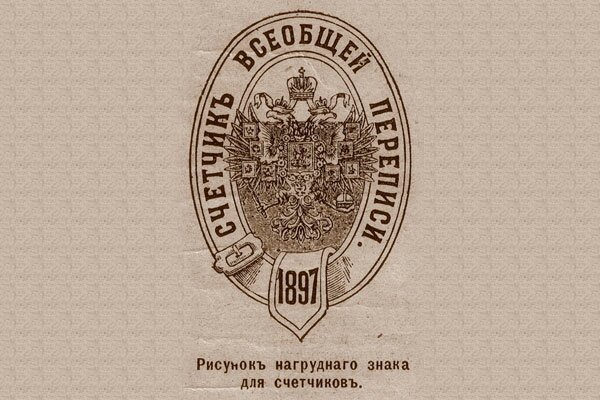
In 1897 the first census in the Russian Empire was organized. According to this census, the population of Kazakhstan was equal to 4,147,000, 3,392,000 (81.7%) of whom were Kazakhs, 454000 - Russian (10.9%), 79,000 - Ukrainians (1.9%), per 55,000 - Uighurs and Tatars (1.3%), 29,000 Uzbeks (0.6%), etc.
1897-1961 – Mukhtar Auezov
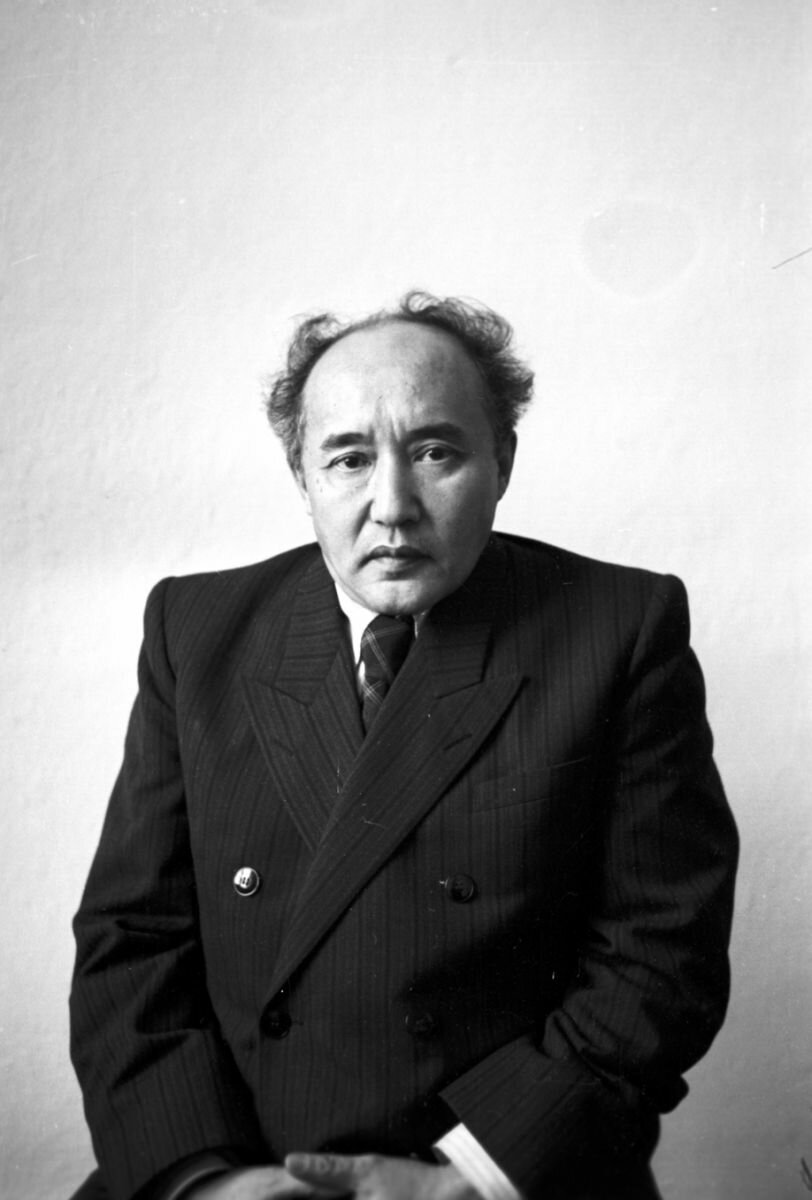
Mukhtar Auezov lost his parents very early: his father died in 1900, his mother in 1912. Small Mukhtar was brought up with his uncle, who in 1907, after a year of study at medresse gave the boy to five class city school in Semipalatinsk on Russian Zemstvo scholarship of Chingiz volost. In the school year 1912-1913, Mukhtar completed the first seminary class with honors, and finished studies at the seminary of Semipalatinsk in 1919. In 1917 he wrote the play "Enlik -Kebek". In 1918, Mukhtar Auezov and Zhusupbek Aymauytov published the journal "Abay" in Semipalatinsk, which was closed after the twelfth issues for ideological reasons. In 1919, Mukhtar Auezov joined the Bolshevik Party and subsequently moved the party line to the post of chairman of the Semipalatinsk executive committee and secretary of Kazakh Central Executive Committee in Orenburg (later the capital of Kazakhstan). In the autumn of 1922 for "violating the party discipline" and "nationalism" Auezov was expelled from the Bolshevik Party. In October 1923 he entered the philological department of Leningrad State University. But after the first year, he returned to Kazakhstan. In the autumn of 1925 he went to Leningrad again and finished his study in 1928. Upon graduation from the Leningrad University in August 1928, being married, moved to Tashkent, here he entered the Central Asian University, simultaneously working as a teacher. In 1930 Auezov was arrested on charges connected with the organization of young Kazakh writers "Alka" and spent 2.5 years in prison. Upon his release, he taught at Alma - Ata universities continuing to write plays. In 1933 Auezov released the first full collection of Abay’s poems in Latin "Abai Kunanbay-uly tolyk zhinak" in Kyzyl-Orda, prepared the first scientific meeting on Abay’s work, his plays were performed in the Kazakh musical theater in parallel. In 1945, in the year of Abay‘s centenary, Mukhtar Auezov wrote the libretto of the opera "Abay", the script for the feature film "Songs of Abay", a new version of the Abay’s biography and several articles about him. In Moscow, he was awarded the Order of the Red Banner of Labor. The next year he became a doctor of philological sciences, professor, academician of the Kazakh SSR. In 1947 he published the second book of "Abay" in the Kazakh language. In 1948 both books were republished in Russian. In 1959, in Alma-ata his scientific monograph "Kyrgyz heroic epic "Manas"” was released. In 1959, for his two volume novel "The Path of Abay", M.Auezov was awarded the Lenin Prize, he was elected to the Supreme Soviet of the Kazakh SSR of the V convocation. In the summer of 1961 he went to Moscow for treatment. On June 27 of 1961 he died during surgery.
1905 – Revolution in the Russian Empire
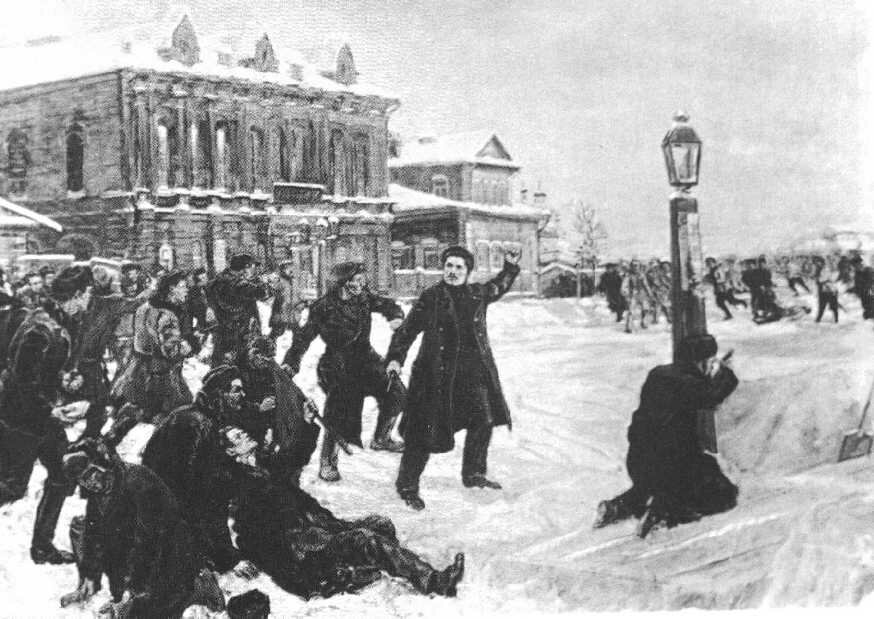
In the period from January 1905 to June 1907 the first Russian revolution occurred in the Russian Empire. This revolution of 1905 led to the growth of national consciousness throughout the Russian empire. August 6, 1905, by Manifesto of Nicholas II, the State Duma where representatives of different nationalities were able to express their views on the policies of the Russian Empire was established.
1905 – completion of Orenburg-Tashkent railway construction
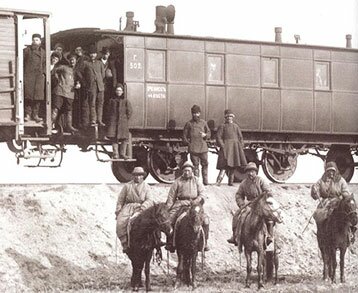
In 1905 Orenburg-Kandyagash (modern Aktobe region)-Koubek railway was completed, which merged with another railway line Koubek-Dzhusaly-Aris-Tashkent. Thus two stations Orenburg and Tashkent were connected.
1911-1915 – “Aikap” magazine
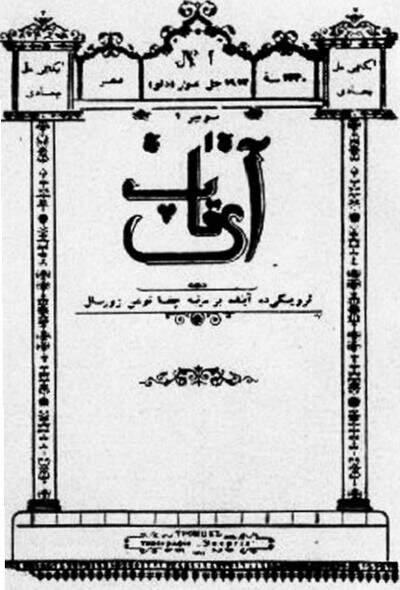
Kazakh socio-political and literary-critical journal. It was published in Troitsk from January 1911 to August 1915. 88 issues were published in total. The founder and the editor of "A." was the publicist and writer Democrat Mukhammedzhan Seralini. There were speeches of the writers as S. Toraigyrov, S. Donentaev, S.Seifullin, B.Mailinet and others. The Journal defended the interests of the Kazakh people, urged them to enlightenment and progress. It played a major role in the formation of the Kazakh prose, drama, literary criticism and literary language. It was closed for censorship reasons.
1913-1918 – “Kazakh” newspaper
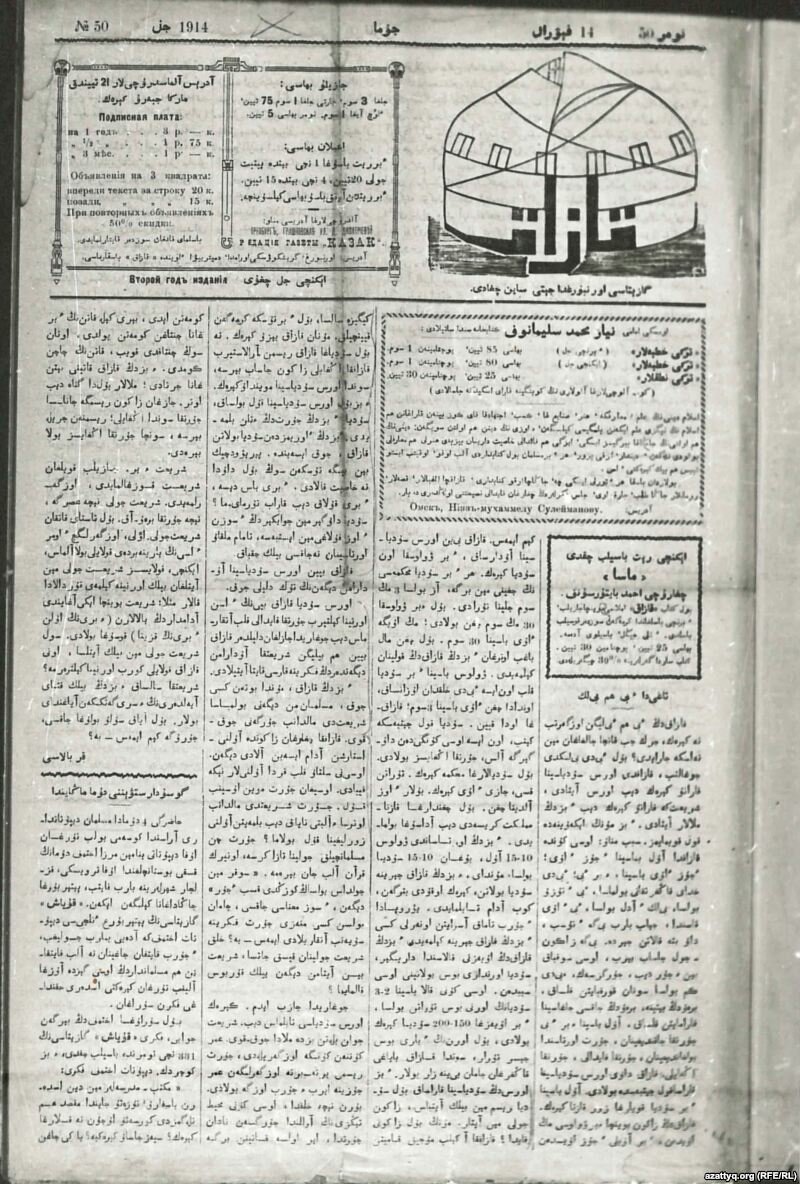
Socio-political and literary newspaper published in the period between 1913 and 1918. The first issue was published on February 2, 1913. Until 1915, the newspaper was published once a week, after - twice a week. The publisher was the Association "Azamat" ("Citizen"). At the head of those who financially supported the newspaper was Mustafa Shokhay. 265 issues were published all in all. Baitursynov Ahmet was the organizer and the editor of the publication and his authorized representative was Mirzhakip Dulatov.
1914-1918 – World War I
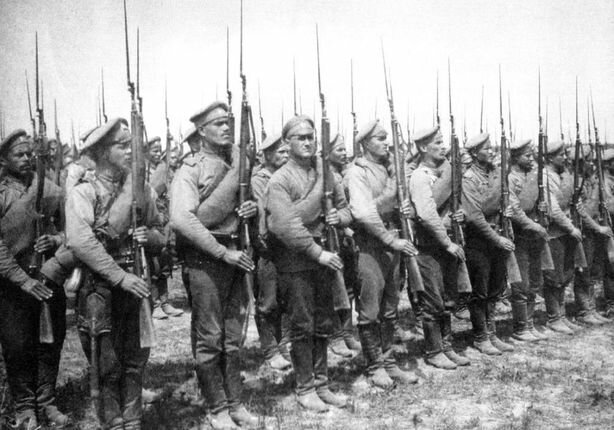
The global military conflict which affected all the major world powers. Russia was allied with Britain and France against Austria and Germany. The First World War aggravated the crisis in the Russian Empire, which led to the February and October revolutions of 1917, as well as the national liberation uprisings in Kazakhstan in 1916.
1916, June – the national-liberation movement in Kazakhstan
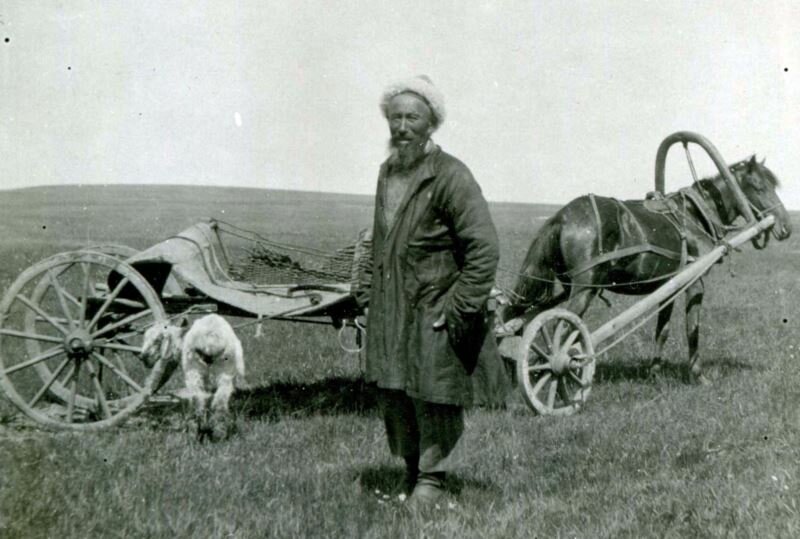
The outbreak of the First World War led to increase of the tax burden on the population of Kazakhstan, introduced a new tax on military tents. Overall, since the beginning of the war, taxes increased by 3-4 times. Also worth noting was that by mid of 1916, the imperial government had seized more than 45 million acres of land from the local population. On June 25, 1916 a decree "On the requisition of the male population in Kazakhstan, Central Asia and partially in Siberia aged 19 to 43 years old at the rear of work" issued. And the word "requisition" was always mentioned in relation to domestic animals ("requisition of cattle"), but in relation to people the phrase "mobilization” should had been used". About 240 thousand Kazakhs were planned to be called up on rear works. Following the promulgation of the Decree in July, spontaneous agitations began, which then grew into rebellion. There were two major centers of the rebellion: 1. In Turgai, headed by Abdizhappar Zhanbosynov, who was elected Khan by Amangeldy Imanov and Alibi Zhangildin. 2. In Zhetysu, headed by Bekbolat Ashekeev, Uzak Saurykov, Zhamenke Mambetov, Takash Bokin, Aubakir Zhunusov, Serikbay Kanaeva, Monay and Mukan Uzakbaevs. In general, there were three stages of the national liberation movement: 1. July - spontaneous agitations 2. August - organized armed rebellion 3. September - October - the gradual decline and defeat of the revolt. It should be noted that the storm center of the rebellion Turgay was not completely suppressed.
1917, February – February Revolution
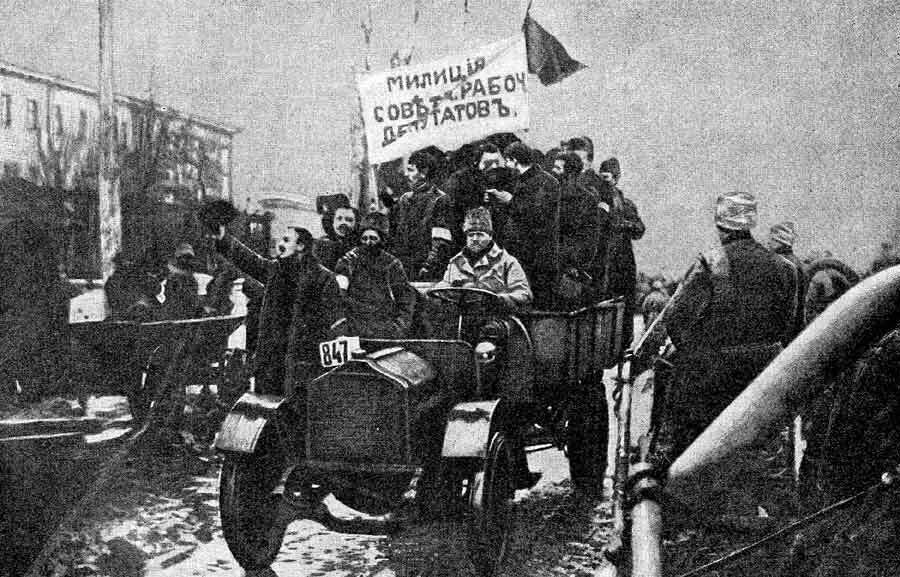
Events in Petrograd, which resulted in Emperor Nicholas II’s dethronement in Russia. Revolutionary events covered the period during the end of February - beginning of March 1917. The February Revolution began as a spontaneous impulse of the masses, but the acute political crisis on the top notch of society, discontent with the liberal-bourgeois circles with autocratic policy of the king contributed to its success. Bread riots, anti-war rallies, demonstrations, strikes at industrial enterprises of the city superimposed discontent and unrest among the thousands capital garrison, joining the revolutionary masses in the streets. On February 27 (March 12) 1917 general strike grew into an armed uprising; the forces who defected to the rebels occupied the major points in the city, government buildings. The immediate result of the February Revolution was the abdication of Emperor Nicholas II, the termination of the Romanov dynasty, which led to certain anarchy. As a result, under the chairmanship of Prince George Lvov, the first Provisional Government was formed. In Kazakhstan, in March-April of 1917, almost all the military generals of regions were removed from their posts. The colonial administration apparatus was abolished as well. In March 1917, the demobilization of "foreigners" from the rear works was announced. By May Alash Party was factually formed, it had been legally registered by December 1917.
1917, July – the first all-kazakh congress
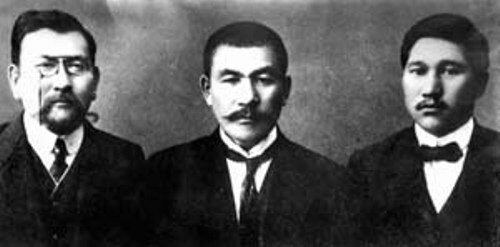
Institutionalization of the party "Alash" was carried at the First Kazakh Congress, held in Orenburg from July 21 - 28 of 1917. At the same congress, decisions were made on 14 issues: 1. System of government. 2. Kazakh autonomy areas. 3. Land Management of the Kazakh population. 4. Organization of the National Police. 5. Zemstvo. 6. National Education. 7. Court. 8. Attitude to religion, spiritual and religious issues. 9. The situation of Kazakh women. 10. Preparation of the elections to Constituent Assembly. 11. All-Russian Muslim Congress. 12. Formation of the Kazakh political party. 13. Event in Semirechensk region. 14. Kazakh participation in the all-Russian federal Council in Kiev and in the work of the Commission on Public Education in Petrograd. Draft program of the party "Alash", published before the elections to the Constituent Assembly of Russia, put as priorities the universal suffrage, proportional national delegation in the democratic Russian federal republic with a president and legislative Duma, equality of the republics of Russia, democratic freedoms, separation of church from state, equality of languages, etc. In fact, the Party "Alash" was formed in the Congress, the leader of which became Alikhan Bukeikhanov.
Kazakhstan consisting the USSR
1917 October 25– October Revolution
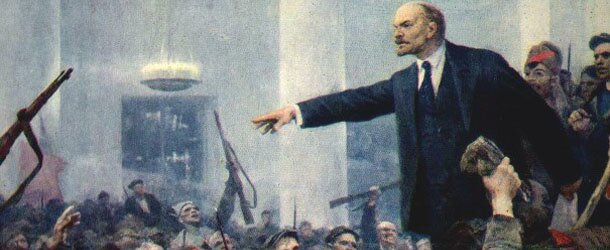
This was the one of the major political events of the XX century, which took place in Russia in October 1917 and affected the future course of the world history. As a result of the civil war in Russia, the Provisional Government was overthrown, and the government formed by the II All-Russian Congress of Soviets took the power, the absolute majority of the delegates consisted of the Bolsheviks ( RSDLP (b)) and its allies - the Left SRs, also supported by some national organizations, small part of the Menshevik-Internationalists and several anarchists. In November 1917, the new government was also supported by a majority of the Extraordinary Congress of Peasants' Deputies. The Provisional Government was overthrown during the armed uprising on October 25-26 (November 7 - 8, New Style), the main organizers of which were Lenin, Trotsky, Sverdlov and others. Direct leadership of the uprising was carried by military Revolutionary Committee of the Petrograd Soviet, in which left SRs was also included. The process of establishing Soviet government in Kazakhstan was delayed for several reasons. On the large part of the region, especially in areas adjacent to the railways and major work centers, where the counter-revolution could not organize the armed resistance to the revolution, Soviet power was established peacefully. At the same place, where the counter-revolution had a real opportunity for armed resistance (mainly in the areas of Cossack troops), Soviet power triumphed due to the defeat of the counterrevolution forces. The workers and soldiers of Perovskay (Kyzylorda) first took power into their hands on October 30, 1917, at that period of time Perovsk was the large train station, which housed a relatively large garrison. After the victory of the armed uprising of October 28, 1917 in Tashkent - the administrative center of Turkestan, headed by the Bolsheviks, Soviet power peacefully asserted in Aulie-Ata (Zhambul), Chernyayevo (Shymkent), Kazalinsk), on November 22, 1917 the power transfer to Soviets in Petropavlovsk happened, on December 27 in Akmolinsk.
1917, November 27– Declaration of Turkestan autonomy
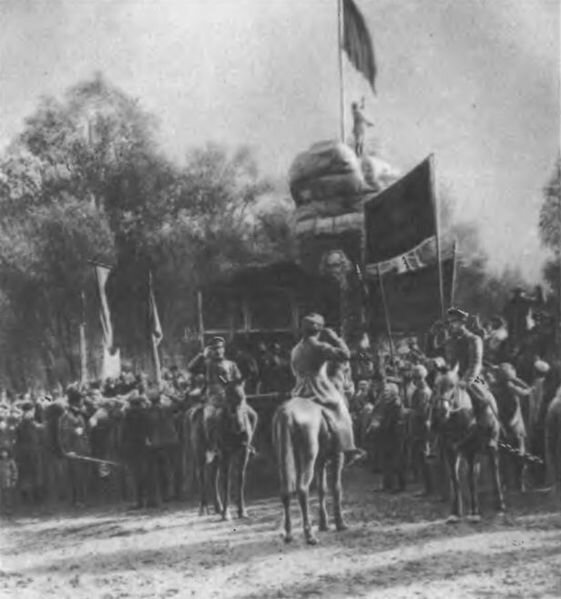
During October Revolution, anarchy in different parts of the former Russian Empire increased. On November 15, 1917 in Tashkent the III Conference of Muslims of Turkestan was opened under the leadership of "Shuro – and – Islamia". In parallel, the III Congress of Soviets of Turkestan Region was held in Tashkent. The conference was attended by representatives of Muslims and left-wing socialist Muslim organizations. At the same time, representatives of Muslim organizations "Shuro – and - Islamia" did not participate in the conference, which marked the split between conservative traditionalists and liberals. At the conference it was decided to address the delegates of the III Congress of Soviets of Turkestan with the proposal to establish a joint government. But this proposal was rejected by the Bolsheviks and Left SRs. Thus representatives of indigenous nationalities were not included in the first Council of People's Commissars of Turkestan (TRC). In response to the establishment of the CPC in Tashkent in Kokand under the leadership of the Muslim organization "Shuro – and - Islam" the IV Extraordinary boundary all-Muslim Congress was convened. It was attended by almost 200 delegates. On November 27 at the Congress Turkestan was declared "territorially autonomous in communion with the Russian federal democratic republic". Turkestan was decided to be named Turkeston muhtoriati (Turkestan autonomy). Autonomy authorities were elected. Representative and legislative body was to become the Interim National Council in the amount of 54 people, the executive - the Provisional Government, consisting of 12 people. Turkestan autonomy lasted a short time from 27 November 1917 to 22 February 1918 on the territory of modern Uzbekistan, Kazakhstan and Kyrgyzstan, within Turkestan province. Mukhamedzhan Tynyshpaev and Mustafa Shokhay (ethnic Kazakhs) and Colonel Chanyshev (ethnic Tatar) headed the government of Turkestan autonomy.
1917 December 5-12 – Declaration of “Alash” autonomy
.jpg)
In order to develop a program of action under current conditions of the October Revolution of 1917, on December 5-12 of 1917 the II general-kirghiz Congress (general Kazakh Congress) took place in Orenburg. It was attended by the delegates from all over Turkestan: from Bukeyev province (formerly Bukey Orda) formed on July 1, 1917, Ural, Turgay, Akmola, Semipalatinsk, Semirechensk, Syrdarya regions, counties from Kyrgyz Ferghana, Samarkand, Trans-Caspian areas, the Amu Darya and Kyrgyz townships, Altai province (formed on June 17, 1917). Among the guests was the Prime Minister of newly created Turkestan autonomy Mustafa Shokhay. The organizers of the congress were Alikhan Bukeikhanov, Ahmet Baitursynov, Mirzhakip Dulatov and I. Omarov, S. Kadyrbaev, S. Doschanov, B. Kulmanov were the chairmans of the Congress. The central issue of the congress was the question of autonomy. The report on autonomy was made by A. Bukeikhanov, his report on the Kazakh autonomy were submitted to a special commission. The congress unanimously decided to form Kyrgyz Autonomy regions and name it "Alash". Temporary National Council "Alash Orda" of 25 members was formed, of which 10 places were given to Russian and the representatives of other nations of the region. Semipalatinsk became the center of the political party "Alash Orda". At the head of the government - the President of all-kirghiz National Council - Alikhan Bukeikhanov (party "Alash") was elected on the alternative basis, except for him, Kulmanov B. and A. Turlubaev claimed this post.
1918-1920 – Civil War in Kazakhstan
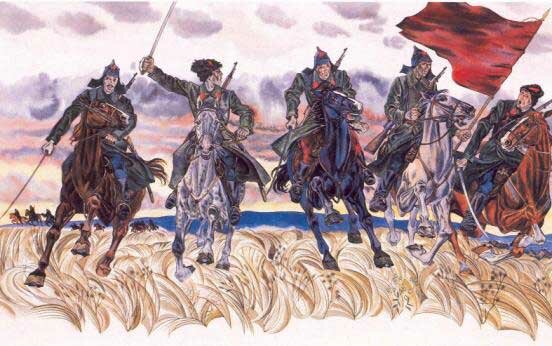
"Alash Orda" leaders collaborated with the Soviet government, Kh. and Zh. Dosmukhamedovs met with Lenin and Stalin, Kh. Gabbassov also negotiated with Stalin as the Commissar for Nationalities. At the same time, the leaders of "Alash Orda" established contacts with Ataman A. Dutov after his overthrow of the Soviet regime in Orenburg, with the Committee of the Constituent Assembly in Samara, the Provisional Siberian Government (Ufa Directory) in Omsk. From contacts and compromises with the Soviet government Alash Orda representatives passed on to alliance with Omsk to fight the Soviets. In June 1918, "Alash Orda" resolution was adopted, which said: "To invalidate all the decrees issued by the Soviet government in the territory of the autonomous "Alash"". But no one needed an independent "Alash Orda", and the interim government in Omsk by the Decree from November 4, 1918 tried to abolish it, in order to subdue "Alash", and Admiral A.Kolchak who was later elected by them as the Supreme Ruler of Russia also denied "Alash Orda" in recognition. In August, the first Alash cavalry regiment was formed at Semipalatinsk. On September 11, 1918 Western Branch of "Alash Orda" with the center Dzhambeity in Ural region was formed under the direction of Zh. Dosmukhamedov. The center of the Eastern Division moved from Semipalatinsk to Zhana Semey. In March 1919 Kolchak's troops launched a decisive attack on Samara and Kazan, in April took all the Ural and approached Volga greatly surpassing the Red Army. Seizing the moment, "Alash Orda" raised anti-Soviet revolt in Turgay steppes. In the summer of 1919, the Revolutionary Military Council of the Eastern Front first Army sent an ultimatum to the Ural group of "Alash Orda" about the possibility of negotiations. Considering its losing position "Alash Orda" was forced to obey and come down to the side of the Soviets, but it was immediately abolished by the Bolsheviks who came to power, and all its leaders, despite the amnesty, were shot in the 30s. In such a manner the way of the first autonomous political party ended ingloriously.
1920, August 26 – Establishment of the Autonomous Kyrgyz (Kazakh) Socialist Soviet Republic
.jpg)
On August 26, 1920 Executive Committee and SNK of the RSFSR adopted, the decree "On Education of the Kyrgyz Autonomous Soviet Socialist Republic" in the RSFSR, signed by M.I Kalinin and Lenin, with its capital in Orenburg. It consisted of Akmola, Semipalatinsk, Turgay, Ural and Bukeyev and some parts of the Orenburg province.
1921-1922 – widespread hunger in North and North-west regions of Kazakhstan
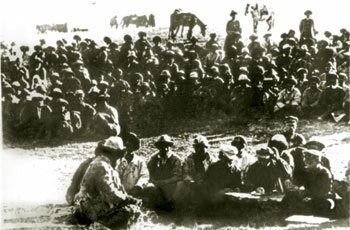
The famine in Kazakhstan, the exact number of deaths is unknown. This hunger coincided with the time of famine in Volga region, which only hardened this disaster. Autonomous power of Kirghiz (Kazakh) Soviet Socialist Republic started a massive fight against hunger, thanks to which the scale of the disaster was reduced to the possible minimum size.
1925 – transformation of the capital from Orenburg to Kyzyl-orda
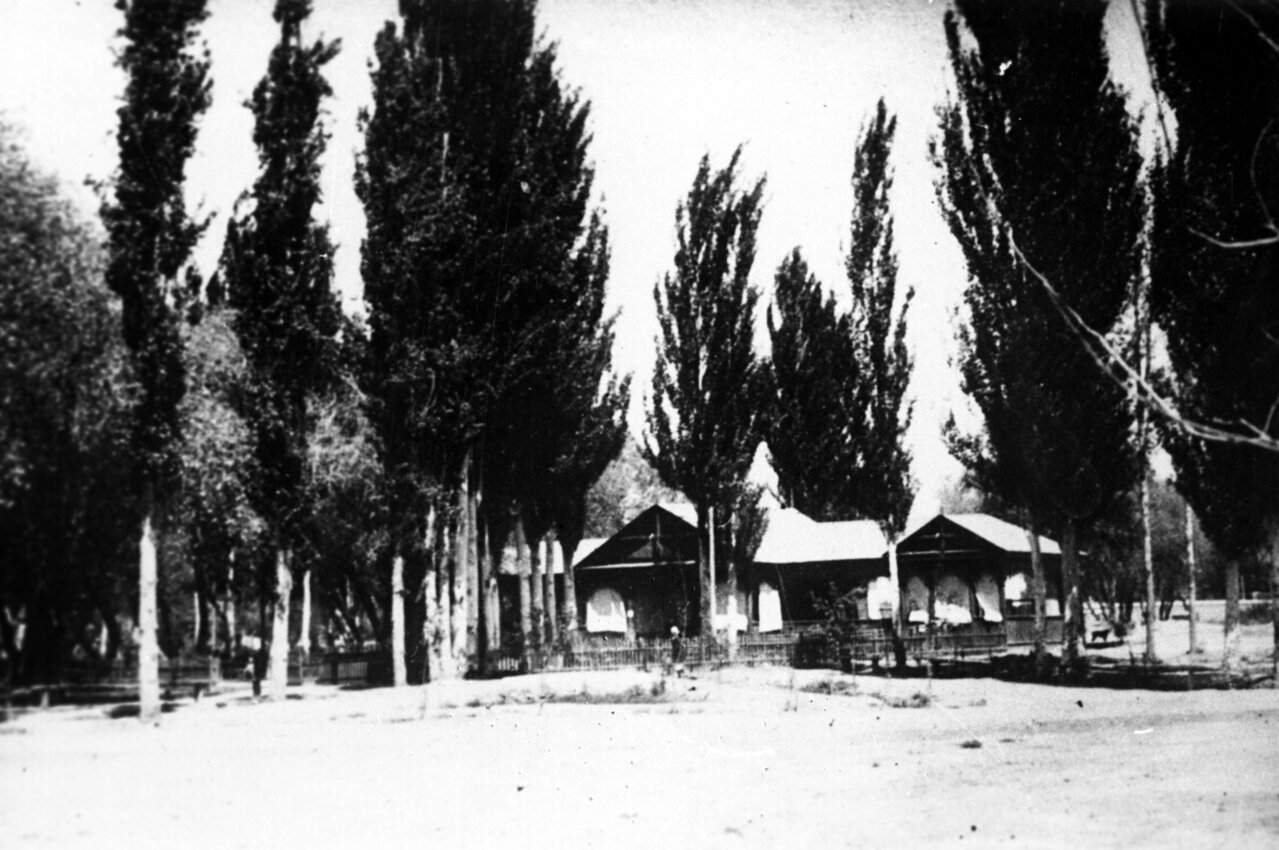
In 1925, after the national-territorial delimitation of Central Asia, the Kyrgyz ASSR was renamed as the Kazakh SSR, the capital was moved from Ural to Syrdarya in the city Perovsk (former Ak-Mosque), having received the new name Kyzyl-Orda. It included Syrdarya and Zhetysu regions of former Turkestan ASSR with the Kazakh population and Kara-Kalpak Autonomous Region. Orenburg region was returned directly under the RSFSR.
1925 – establishment of the Kara-Kalpak autonomous region in KazASSR
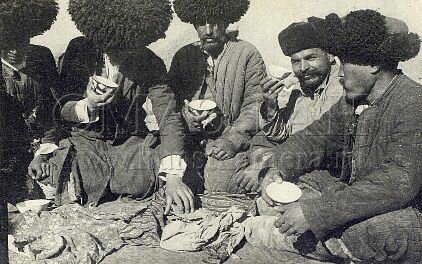
In 1924, the Kara-Kalpak Autonomous Oblast with the center in Turtkul, occupying the area of the Amu Darya of the Turkestan ASSR and Hodzhey and Kungrad regions of the Khorezm Soviet Socialist Republic. On February 12-19 of 1925 the I Constituent Congress of Agriculturs, Labourers’ and Soldiers' Deputies was held, where the Kara-Kalpak Autonomous Region within the KazASSR was officially approved on February 16 (1920-1925).
1925 April 6– withdrawal of Orenburg province from KazASSR
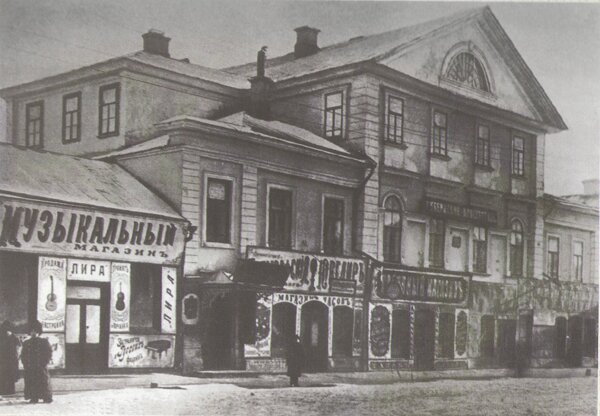
After the transfer of the capital from Orenburg in Kyzyl-Orda, on April 6, 1925 Orenburg region was directly assigned administrative territorial under the RSFSR.
1928 – Opening of the first higher education institution in Kazakhstan.
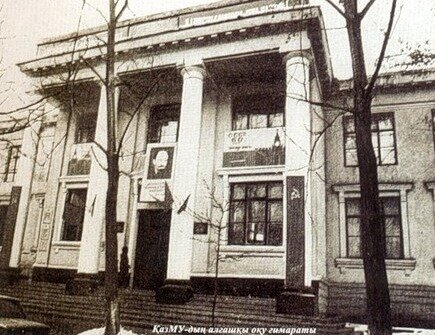
September 1, 1928 the first Kazakh University - Kazakh State University was opened, which was called the Kazakh State University.
1928 December 20– transformation of the Kazakh alphabet from Arabic script to Latin
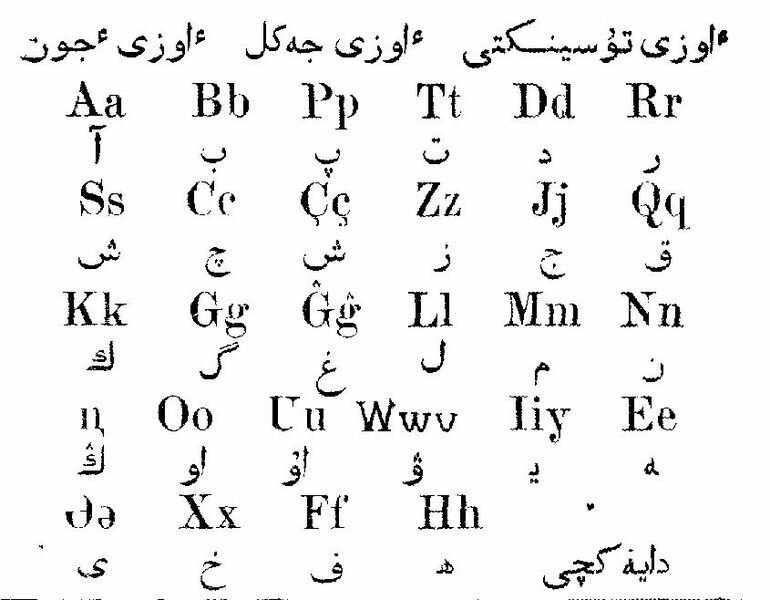
From 1928 until 1940 the Latin alphabet was used for the Kazakh alphabet. Transformation of the Kazakh alphabet from Arabic script to the Latin alphabet was of political nature, thereby forming a new socialist Kazakh nation whose cultural links with the pre-revolutionary literary heritage exploded once and for all, because everything that was published before 1929 were written in Arabic.
1929 – transformation of the capital from Kyzyl-Orda to Almaty
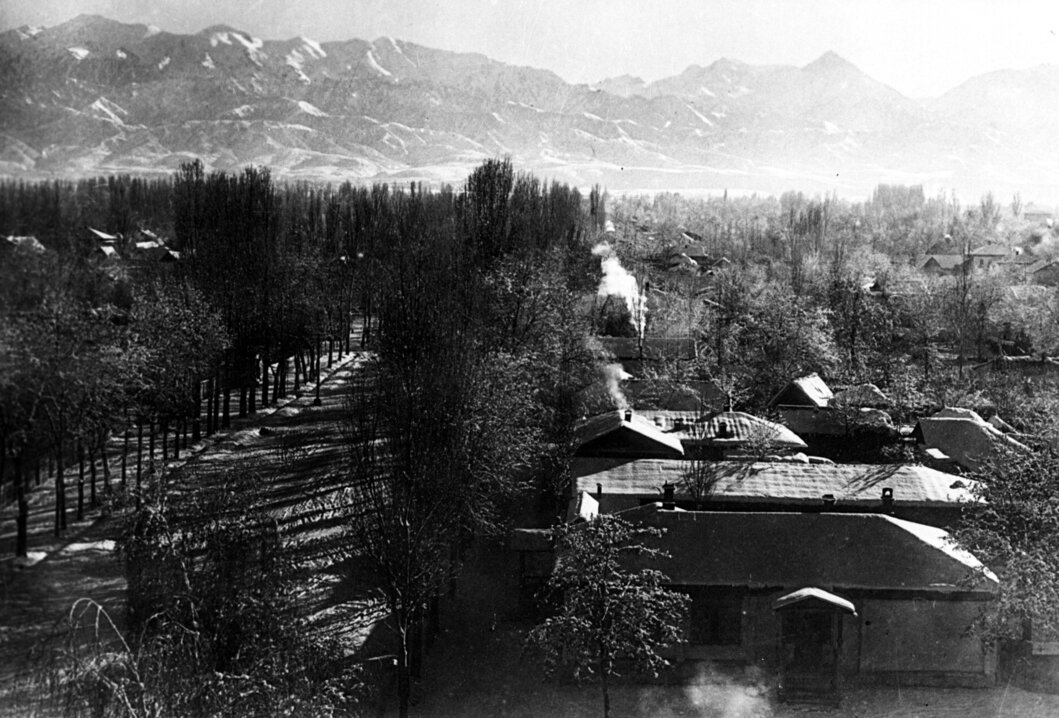
In 1929 the capital of the Kazakh ASSR was transformed from Kyzyl-Orda to Almaty.
1931-1933 – Widespread hunger in Kazakhstan.
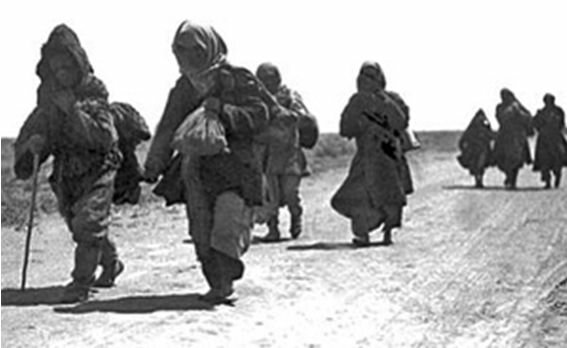
After his appointment as the Secretary of the Kazakh Regional Committee of the CPSU (B), F.I. Goloshchekin held a so-called "Small October” in the Kazakh ASSR. As the result cattle, property were robbed from people, and under the escort of police, were sent to the residence. Cattle, requisitioned for the needs of the kolkhoz, had to be butchered on the spot, as it was impossible to feed large herds in one place. By 1933, only about one - tenth remained out of 40 million heads of cattle. The Kazakhs primarily suffered from such acts, as cattle were the only source of their livelihood. As a result, during 1931-1933, from 1 million (diagnosis of Robert Konkvest) to 2 million (diagnosis of Abylhozhin, Kozybayev and Tatimov) people, no more than 1.84 million people or 47.3 % of the ethnic group (A.N. Alexeenko’s diagnosis) died. 48 % of the indigenous population died and left the Kazakh ASSR. According to A.N. Alexeenko Kazakhs from the north of the republic suffered most. In 1930 the losses here were amounted to 879.4 thousand people, or 74.5 % of the ethnic group. The most significant migration was observed in this region. People were forced to leave their homes and move to the border regions of the Russian Federation and China. More than half of the representatives of the ethnic group were lost in East Kazakhstan - 410.1 thousand people or 52.3%. West Kazakhstan lost 394.7 thousand Kazakhs or 45.0% ethnic, South Kazakhstan - 632.7 thousand or 42.9%. The smallest losses were in the Central Kazakhstan - 22.5 thousand people or 15.6 % of the region ethnicity. Such heavy losses inflicted to global hunger of the Kazakh people in 1931-1933.
1936 December 5 – Reformation of KazASSR in the Soviet Republic

On December 5 of 1936 Kazakh ASSR was given the status of the Soviet Republic with the name of Kazakh Soviet Socialist Republic.
1937 – deportation of the Koreans in Kazakhstan
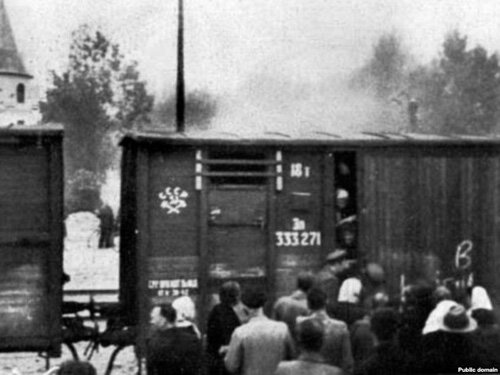
Deportation of the Koreans was the first targeted repression on ethnic grounds, and that was why it was unprepared. Koreans deportation by the NKVD’s force was carried with boxcars with no conveniences, that led to the large number of casualties on the road. In September 1937, on the basis of a joint decision of the CPC and the CPSU (b) №1428-326 «On the eviction of the Korean population from the border areas of the Far East region", signed by Stalin and Molotov, 172,000 ethnic Koreans were deported from the border areas of the Far East in uninhabited wild regions of Central Asia (mainly Uzbekistan and Kazakhstan). Deportation was motivated by the fact that on July 7, 1937 - Japanese troops invaded China, and Korea was the part of the Japanese empire at that time. Insecurity of the situation provoked the deportation of the Korean population.
1937-1938 – mass political repressions in Kazakhstan
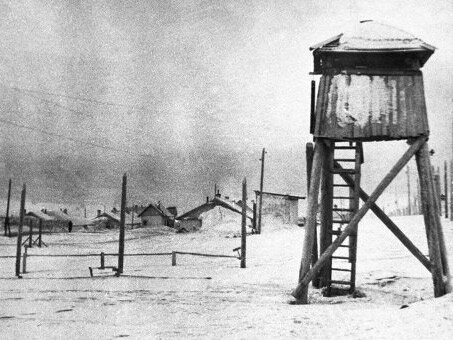
The secret letter of the CPSU (b) to all Party organizations from 29 July 1936 became the sign of mass political repressions. It drove to extremes the requirement of detection and eradication of existing shortcomings "of the part of vigilance and inability in recognizing enemies". On September 21, 1937 an article "On a string of the bourgeois nationalists" by K. Pukhov was published in the newspaper "Pravda". Its author accused the first secretary of Kazakhstan CC CP (b) L.I. Mirzoyan and some other leaders of the republic of the unwillingness to "expose the bourgeois nationalists". Kazakhstan's government responded to the article by the relevant decision. Alikhan Bukeikhanov, Mirzhakyp Dulatov, Turar Riskulov, Sultanbek Khozhanov, Saken Seifullin, Ilyas Dzhansugurov, Beimbet Mailin, Ahmet Baitursynov, Alikhan Ermekov, Mukhamedzhan Tynyshpaev, Magzhan Zhumabaev, Khalel Dosmukhamedov, Sanjar Asfandiyarov, Uraz Zhavdosov, Nygmet Nurmakov, Abdollah Asylbekov, Zhusupbek Aymautov and many others were accused of "nationalism" and then arrested one by one. Most of them were recollected of their political activities with the party "Alash". During 1937-1938 more than 100 thousand people were illegally convicted in the republic, and about 25 thousand of them were shot.
1939 September 1– The beginning of the World War II
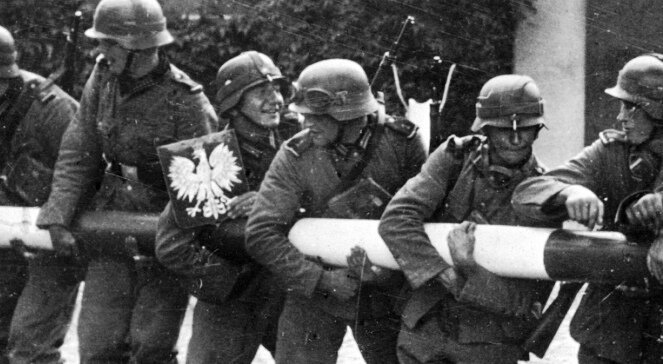
Back on November 26 of 1938 the Soviet Union and Poland signed a nonaggression pact. On April 3 of 1939, Hitler issued the guidance on the preparation of the attack on Poland. At the same time, negotiations between the USSR and Germany were carried. On August 23, 1939 the non-aggression pact was signed by the heads of departments of the Foreign Affairs of Germany and the Soviet Union. From the USSR the agreement was signed by the Chairman of the Council of People's Commissars of the USSR, People's Commissar for Foreign Affairs Vyacheslav Molotov, from Germany - Foreign Minister I. von Ribbentrop. Thereafter, on September 1 of 1939, Germany began to invade Poland, and on September 17, 1939 the territory of Poland was occupied by Soviet forces.
1940 July 6 – Nursultan Abishevich Nazarbayev was born
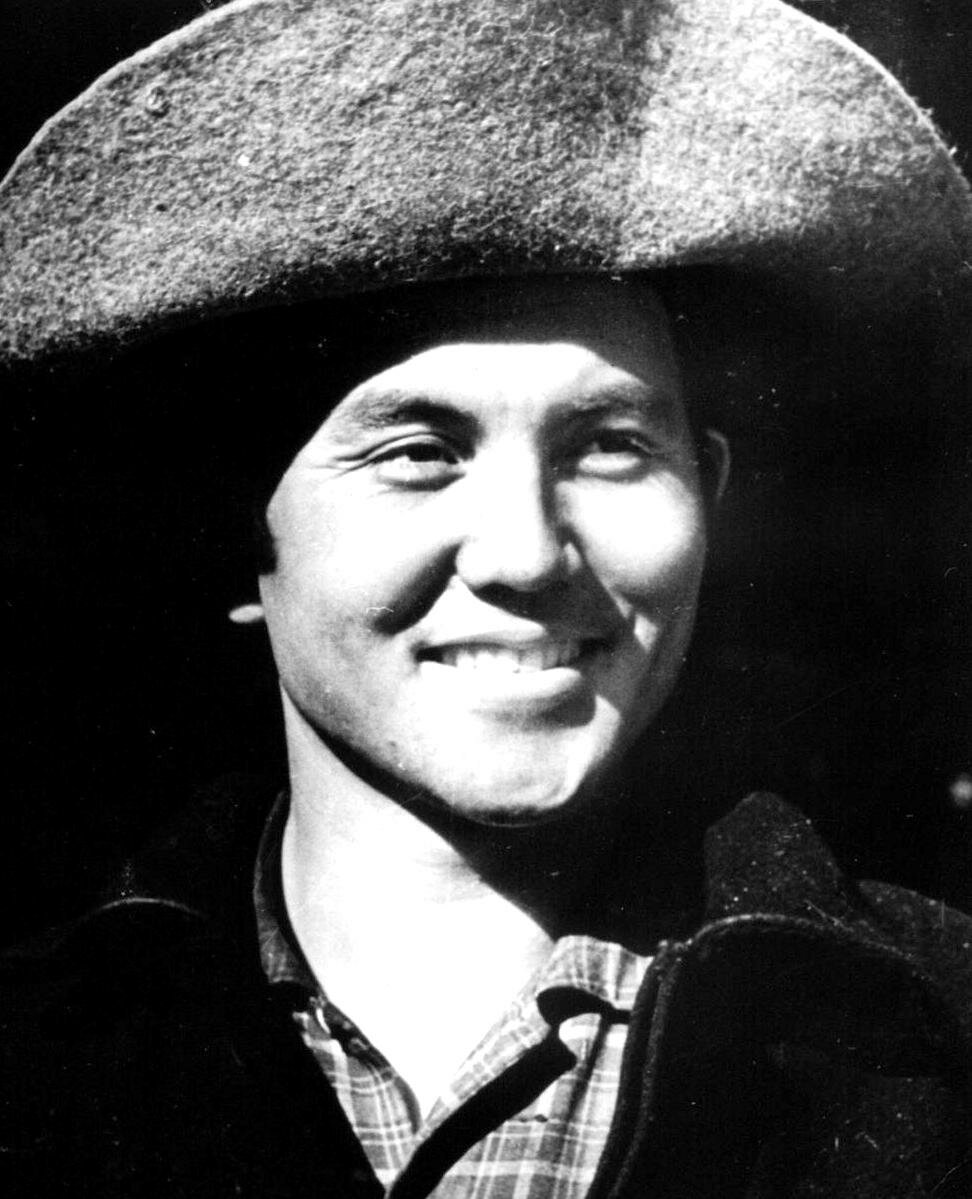
Nursultan Nazarbayev was born in a peasant family on July 6, 1940 in the village Chemolgan of Kaskelen district, Almaty region of the Kazakh SSR. In 1967 he graduated from the plant - VTUZ at the Karaganda Metallurgical Combine. He started his career in 1960 as the worker of construction administration of the treated plan fibers "Kazmetallurgstroy" in Temirtau, Karaganda region. Then he worked as a pig caster of filling machines, blast-furnace keeper at the Karaganda Metallurgical Plant. In 1965-1969 he worked at the Karaganda Metallurgical Plant again (from 1966 - Combine): manager, gasman, senior gasman of a blast-furnace department. In 1969-1973 - at the party, Komsomolsk work in Temirtau, Karaganda region. In 1973-1977 he was the party secretary of the Karaganda Metallurgical Plant. From 1977-1979 the secretary, the second secretary of the Karaganda Regional Party. In 1979-1984 - Secretary of the Central Committee of the Communist Party of Kazakhstan. In 1984-1989 he was the Chairman of the Council of Ministers of the Kazakh SSR. In 1989-1991 - the first Secretary of the Central Committee of the Communist Party of Kazakhstan. Deputy of the Supreme Soviet of the USSR of the 10th, 11th convocations. Deputy of the USSR from 1989 to January 1992. At the same time, from February 1990 to April 1990 Nazarbayev worked as the Chairman of the Supreme Soviet of the Kazakh SSR. Since April 1990, the First President of the Republic of Kazakhstan. The first nationwide election of the President of the Republic was held on December 1, 1991, during which President Nazarbayev received the support of 98.7 percent of voters. In 1995, as the result of the April 29, 1995’s referendum, presidential powers of Nursultan Nazarbayev were extended until 2000. January 10, 1999, Nursultan Nazarbayev was elected President of the Republic of Kazakhstan, 79.78 percent of voters. December 4, 2005, Nursultan Nazarbayev was reelected President of the Republic of Kazakhstan, received 91.15 % of votes. April 3, 2011 Nursultan Nazarbayev was re-elected President of the Republic of Kazakhstan on the advanced presidential elections and received 95.5 % of votes.
1941 June 22– German attack on USSR
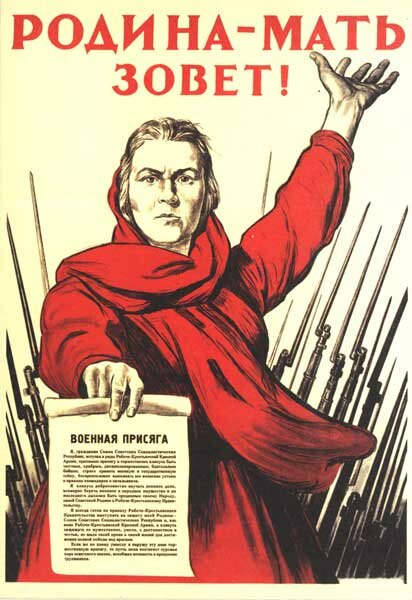
June 22, 1941, breaking the "nonaggression pact" signed in 1939, Germany invaded the Soviet Union. By June 22, three army groups (of 181 Division, including 19 tanks and 14 motorized divisions and 18 brigades) were at the borders of the USSR. Air support was carried out by three air fleets. At 4:00 the Reich Foreign Minister Ribbentrop gave the Soviet Ambassador in Berlin Dekanozov note of the declaration of war and three annexes: "Report of the Minister of Internal Affairs of Germany, Reichsführer SS and Chief of the German Police to German government about sabotage work of the USSR directed against Germany and National socialism", "Report of the Ministry of Foreign Affairs of Germany on propaganda and political agitation of the Soviet Government", "Report of the High command of the German army to the German government about the concentration of Soviet troops against Germany. Early in the morning of June 22 of 1941 after artillery and air preparations German troops crossed the Soviet border. After that, at 5:30 a.m, German Ambassador V. Schulenburg came to the People's Commissar for Foreign Affairs of the USSR V.M. Molotov and made his statement, the content of which was to ensure that the Soviet government pursued a policy of subversion in Germany and its occupied countries, conducted foreign policy aimed against Germany, and "built up forces on the German border in full combat readiness".
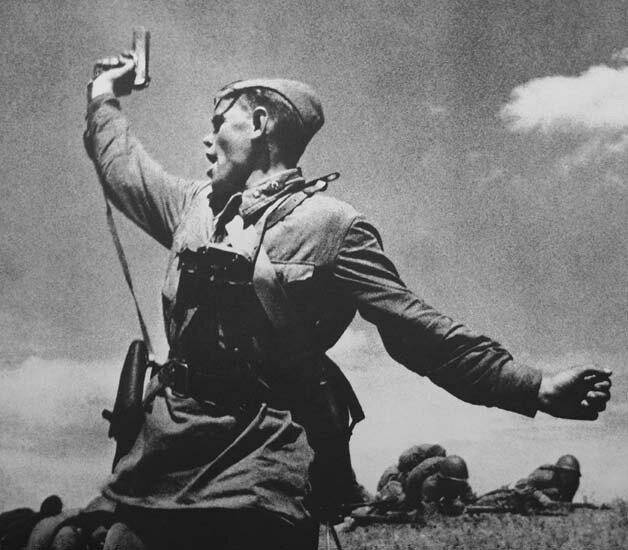
The statement ends with the following words: "therefore Fuehrer ordered the German armed forces to confront this threat by all means at their disposal". Along with the note he handed a set of documents identical to those submitted to Dekanozov by Ribbentrop. The same day, Italy and Romania declared war against the Soviet Union. On June 22 at 12 p.m Molotov made a speech on radio with the official address to the citizens of the USSR, reporting on the attack of German on the Soviet Union and announcing the beginning of World War II.
1941 – Deportation of Germans to Kazakhstan
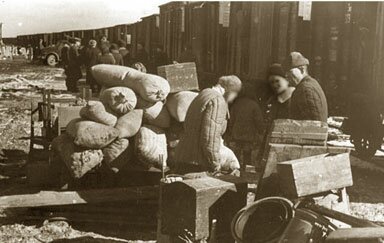
August 28, 1941 the autonomous Republic of the Volga Germans were liquidated pursuant to the decree of the Presidium of the Supreme Soviet of the USSR. 367,000 Germans were deported to the east (two days were given for gathering): to the Komi Republic, Ural, Kazakhstan, Siberia and Altay. Germans were partially withdrawn from the army. In 1942, the mobilization of the Soviet Germans aged 17 years at the rear began. Mobilized Germans built factories, worked in the lumber camps and mines. Based on the decision of the Military Council of the Leningrad Front from 20 March 1942 about 40,000 Germans were deported from the frontline in March-April 1942. Those who returned home after the war were again deported in 1947-1948.
1943-1944 – deportation of Balkars, Chechens, Ingush, Karachays to Kazakhstan
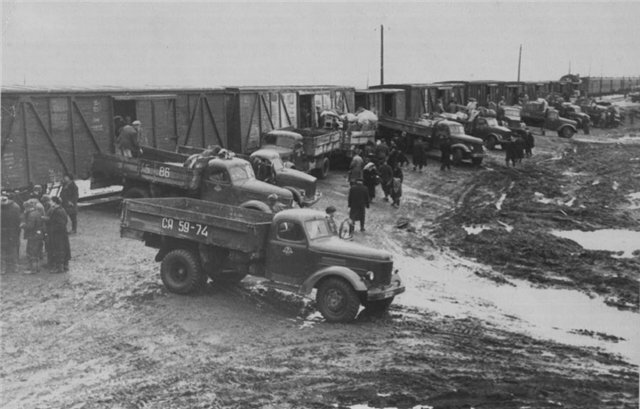
According to the census of 1939, 70301 Karachai lived in the territory of AO Karachai. Since the beginning of August 1942 and the end of January 1943, it was under German occupation. October 12, 1943 the decree of the Presidium of the Supreme Soviet of the USSR and on October 14, SNK enactment on eviction of Karachai from Karachai Autonomous Region in Kazakh and Kyrgyz SSR were issued, On February 26 J.V. Stalin issued an order for the NKVD "On measures for eviction of Balkar population from ASSR KB". On March 11, Beria reported to Stalin that "37,103 men of Balkar were evicted". On January 29, 1944 the People's Commissar of Internal Affairs Lavrentyi Beria approved "Instruction on the order of carrying deportation of Chechens and Ingush" and on January 31 the decree of the National Defense Commission about the deportation of the Chechens and Ingush to the Kazakh and Kyrgyz SSR was issued. On February 20 Beria arrived in Grozny and personally supervised the operation, which involved up to 19 thousand operatives of NKVD, and "SMERSH", as well as about 100 thousand officers and men of the NKVD, assembled from all the country to participate in the "exercises in the highlands". On February 21, he issued an order for the NKVD about deportation of the Chechen - Ingush population. The next day he met the leadership of the republic and the highest spiritual leaders, warned them about the operation and offered to undertake the necessary work among the population, and the next day in the morning the operation on eviction began. Deportation and sending trains to the destinations began on February 23, 1944 at 02:00 local time and ended on March 9, 1944. The operation began with the codeword "Panther", which was broadcasted through radio. Deportation was accompanied by numerous attempts to escape to the mountains or insubordination from the part of the local population. According to official data, during the operation 780 people were killed, 2016 "anti-Soviet elements" were arrested, more than 20 thousand firearms were extracted, including 4868 rifles, 479 machine guns and automatic rifles. 6544 people managed to hide in the mountains.
1945 May 8-9 – capitulation of Germany
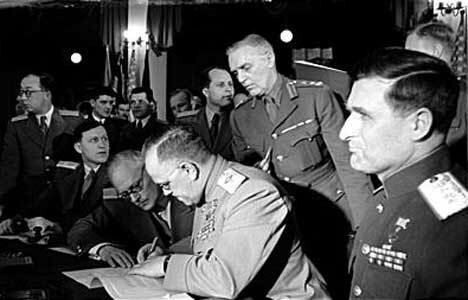
The act of unconditional surrender of the German armed forces - a legal document, which established truce on the fronts, directed against Germany of World War II, German soldiers were obliged to stop resistance, yielding of personnel prisoner and transfer of the material part of the armed forces to the enemy, in fact denoting German’s withdrawal from the war. It was signed by the representatives of the Supreme Command of the Wehrmacht, High Command of the Western Allies and the Soviet Union. Time of signature: May 7 at 02:41 (CET). The Chief of Operations Staff of the OKV Colonel-General Alfred Jodl signed the Act, as the representative of the Wehrmacht. The document was written in English, and only English text was officially recognized. However, at the request of Stalin, May 8, in the Berlin suburb of Karlshorst the ceremony of secondary signing of the surrender was held. The date of the official announcement of the signing of the surrender (May 8 - in Europe and America, May 9 - in the USSR) became celebrated as Victory Day, respectively, in Europe and in the Soviet Union .
1946-1954 - Zhumabay Shayakhmetov – the leader of Kazakhstan
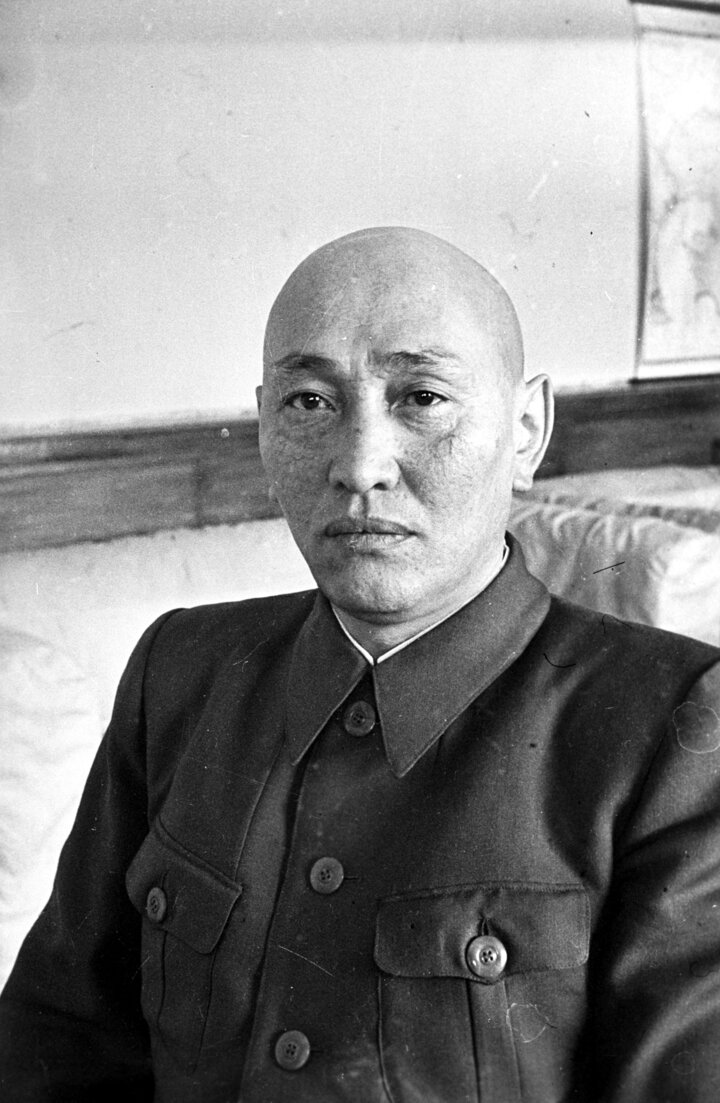
Since 1938 - the third, in 1939 - the second, in 1946-54 - the first Secretary of the Communist Party of Kazakhstan. From 1950 to 1954 - Chairman of the Council of Nationalities of the Supreme Board of the USSR. On the February Plenum of the Central Committee of the Communist Party of Kazakhstan (1954) he was removed from the post for disagreeing with the scale of the proposed program of development of mass clearing, for "shortcomings in the management of industry, agriculture, ideological and organizational-party works". Taking into account the fact that Kazakhstan must become a large-scale livestock base in the east of the USSR, under the previously adopted program, Shayakhmetov considered: the virgin lands should be reclaimed gradually, creating the necessary conditions and opportunities for it, "otherwise we may lose our lands". Zh. Shayakhmetov himself wrote: "The land in Kazakhstan is more than enough. Annually we, taking into account the opportunities and needs, reclaim new industrial areas for the cultivation of grain as planned. This work will certainly continue. But














